

What to eat in Spain: 34 Must-Try Foods!
By Author Paulina
Posted on Published: June 12, 2020 - Last updated: April 29, 2024
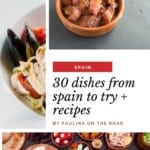
A foodie guide on the best food to eat in Spain, and about the best dishes to try in Spain
From Catalonia’s beloved paella to Seville’s iconic tapas, Spain is a foodie paradise!
Whether you’re planning an epic trip or just dreaming of one for now, there are countless dishes in the country that you simply must try during your travels.
In this post, we’ll go through some of the most delicious and unique foods from each region in Spain – from seafood delicacies to mouthwatering desserts.
Wondering what to eat in Spain? Get ready to tantalize your taste buds and experience Spanish cuisine like never before!
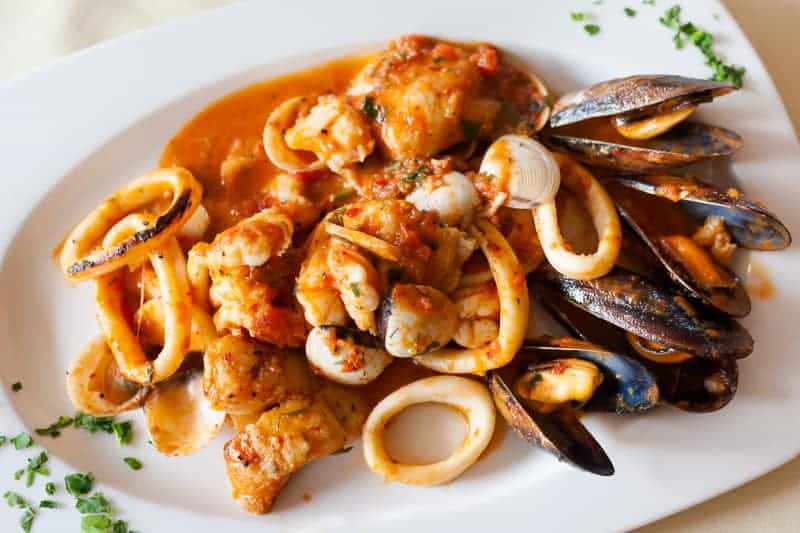
You, dear reader, support this blog. When you purchase through a link, I may earn a small commission. As an Amazon Affiliate, I earn from qualifying purchases.
Table of Contents
Top resources to travel Spain
⚘ Avoid tourist traps and get the customizable “ Spain Like a Local “ itinerary for less than 10€. – Get it here ✈ Book cheap flights to Spain with Skyscanner ✔ Book tours in Spain with Viator ➳ Find the best hotels in Spain with Trivago ❖ Rent a car with the best discounts with DiscoverCars ☘ Get the best discounted outdoor gear (outlet) with REI.com ✎ Never leave without travel insurance. I get mine at SafetyWing . It is easy to set up, cheap and reliable. $ Withdraw money without hidden fees and avoid exchange rates with Wise (you’ll get a free card on top!)
Famous Dishes from the Valencian Region
Valencia is the birthplace of some of the most famous dishes in Spain.
This coastal city is a real treasure for all of us who yearn for the full experience and locally produced ingredients.
Its fresh seafood and rich land for growing all kinds of vegetables are just some of the things you will notice on your plate.
Valencia is best known for its paellas , and it is said that the real paella can’t be made elsewhere!
If you want to get a feel of local cuisines, you can visit the best Paradores in Spain .
You should definitely try them as they serve the best cuisines with great variety.
If you are planning to visit Valencia, have a look at my 1-day Valencia itinerary or this guide on how to spend 3 days in Valencia .
In case you are planning to travel to Spain, make sure to book a guided food tour with GetYourGuide .
1. Paella
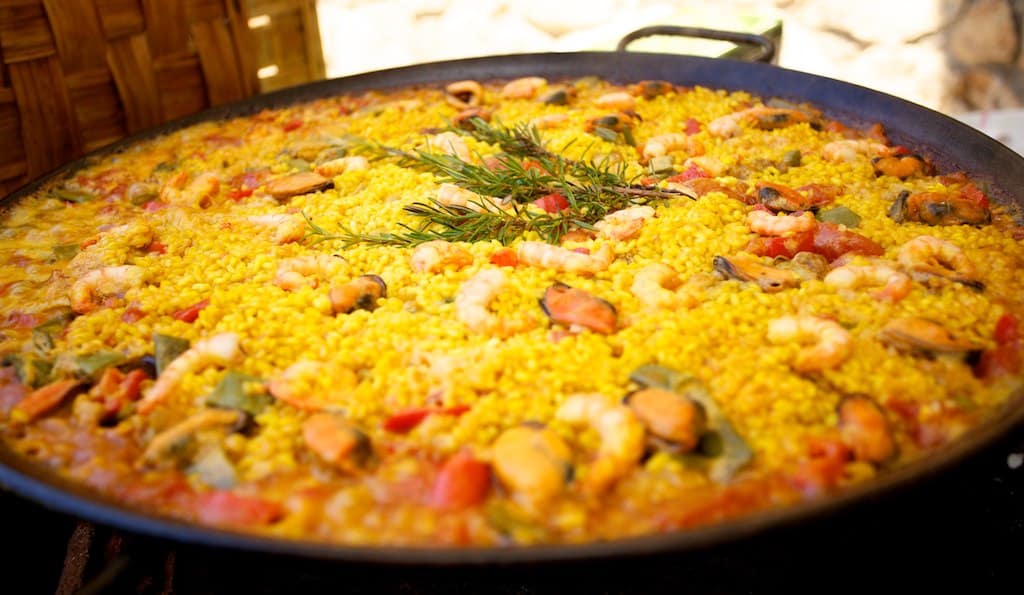
As I mentioned before, paella is a food synonymous with the Valencian region.
This tasty food of Spain is a rice dish that is usually mixed with meat and vegetables.
Traditionally, it requires a special flat pan and it is prepared over high heat, but if you don’t have one, it is possible to prepare the paella in a regular pan as long as it is for a maximum of three people.
The authenticity of enjoying these famous dishes from Spain at home is guaranteed by putting the pan in the center of the table and eating directly from it.
This dish is a must when traveling to Spain and in case you are visiting Valencia for 3 days or more, make sure to try it at least once!
If you can’t travel to Spain right now, you can get amazing Paella kits at Amazon. Making paella at home as never been easier. – Check at Amazon
2. Fideuà – Noodle Paella
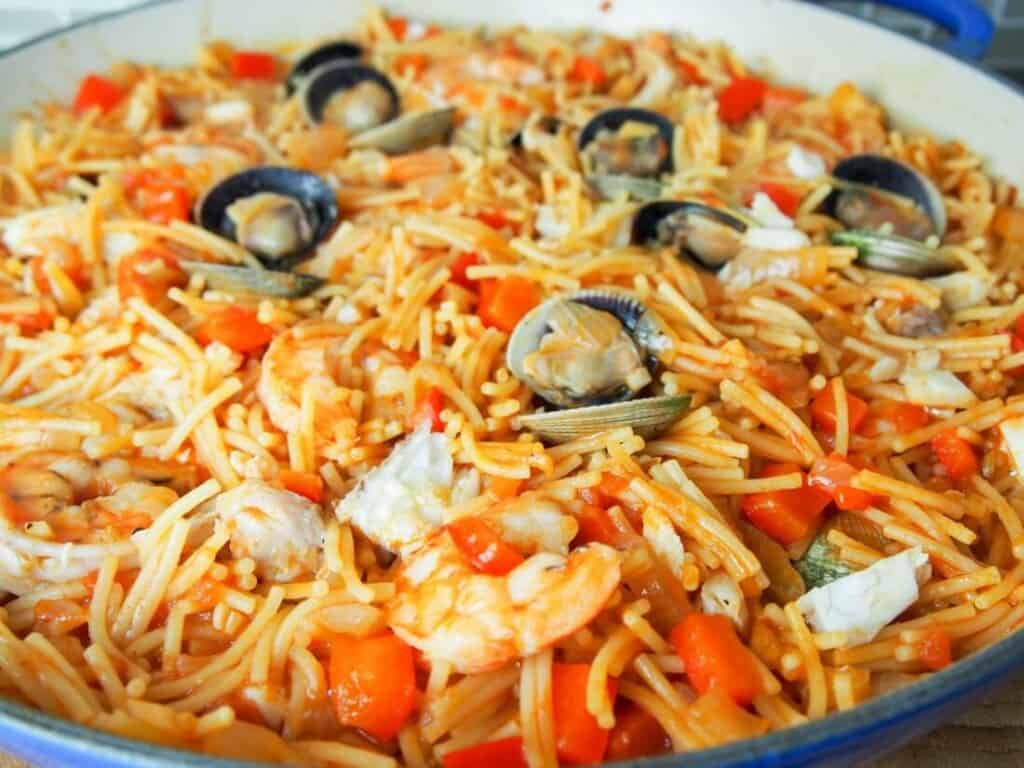
Although recently, Fideuà (noodle paella ) became popular in Barcelona, its origin is actually Valencian and it’s now one of the most popular dishes that Spain is known for .
Essentially, it is a noodle version of paella that therefore has pasta as its base rather than rice.
This means that you need a big flat pan ( paella ) to prepare it, and as with the classic paella , it is best to make it outside, on the open fire.
Fideuà is served as a common food in Spain, and there are several variations you can try.
It’s usually served with aioli (a sauce made of garlic, salt, and olive oil and found in the cuisines of the northwest Mediterranean, from Valencia to Calabria).
3. Turrón – Nougat
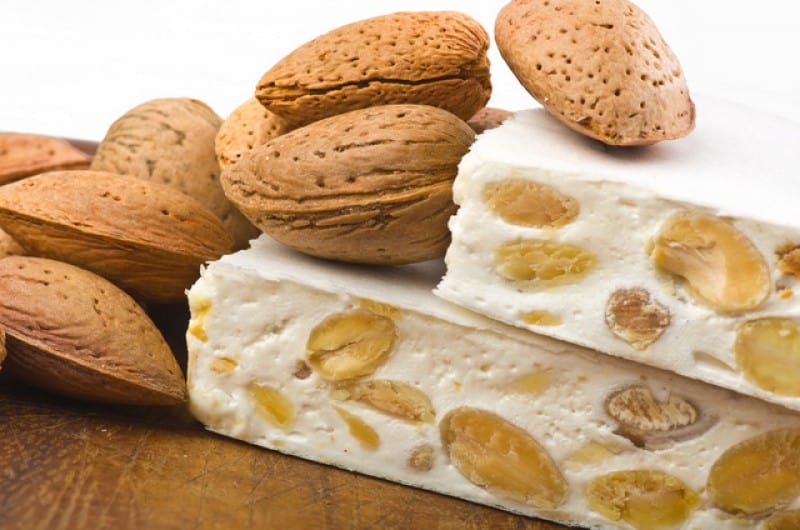
If you wonder what people eat in Spain during Christmas, turrón (nougat) will come up as one of the answers.
Turrón is difficult to classify it since it is something between a desert and a pastry.
However, if you are looking for an English word for it, the simplest translation is nougat .
The usual ingredients are almonds, honey, egg whites, and sugar, but the tricky part is knowing the right timing to mix and roll them.
If you can’t travel to Spain, you can order Turrón at Amazon ! – C heck prices here
4. Horchata – Tiger Nut Milk

If you are into trying food and drinks from Spain , horchata (tiger nut milk) should be on your top priority list!
The typical horchata is called “ horchata de chufas ” ( chufa is a tiger nut ), but there are a few variations of it.
It is a cold, milk-type beverage, known as one of the most famous after-lunch snacks from Spain.
Do you want to make Spanish horchata at home? You can order it at Amazon. – Check prices here
Valencian Horchata Drink

The most refreshing of all Spanish drinks.
It is a cold, milk-type beverage, and it is known as one of the most famous after-lunch snacks from Spain.
Ingredients
- 2 cups of tiger nuts
- 1 glass of water
- ¼ teaspoon of cinnamon powder and lemon zest
- 1-2 teaspoons of white sugar
Instructions
- You need two cups of tiger nuts. Make sure that you soak them for at least 24 hours. They need to become soft enough so you can liquidize them later.
- After you drain the chufas , blend half of them with cold water (use about half of the cup) until you get an even mixture.
- Add ¼ teaspoon of cinnamon powder into the mixture along with the lemon zest. You can also add one or two teaspoons of white sugar to make it sweeter.
- Make sure that you put the mixture into the pitcher and then fridge it for at least four hours. Remember, horchata should be served cold and preferably in tall glasses.
Nutrition Information:
Serving size:, typical food from barcelona and catalunya.
Catalunya is one of the biggest gastronomy centers in Spain, and the diversity of food offered in this region is one of its highlights.
Also, their typical menu confirms a strong regional distinction from the rest of Spain’s food.
The whole area is rich with ingredients such as seafood along with local land products, so there is a lot to choose from.
Therefore, it is not surprising why many of us consider Barcelona one of the best places in the world!
No wonder it has been the film location for several movies set in Spain .
Barcelona also falls under the category of most beautiful places in Spain you must visit .
If you want another taste of Spain, have a look at my favorite funny Spanish phrases .
5. Patatas Bravas – Fried Potatoes
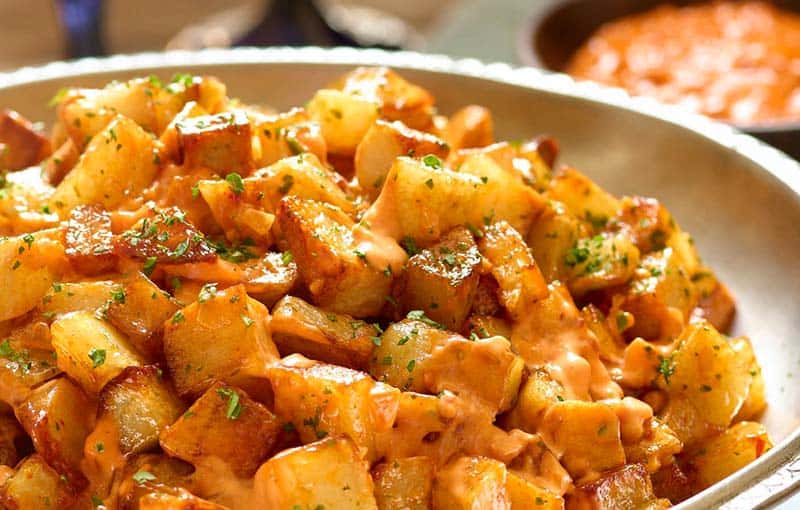
Patatas bravas (fried potatoes) is a signature dish that the Catalan region is proud of.
This famous Spanish food is easy to prepare since it consists of deep-fried potatoes and sauce.
Due to its popularity and simplicity, you will find many variations in other countries.
It is an ideal choice if you are in a hurry, or simply in need of a good Spanish snack or a quick dinner in Spain .
Patatas bravas is also one of the best traditional foods in Spain for vegans and vegetarians.
6. Pa Amb Tomàquet
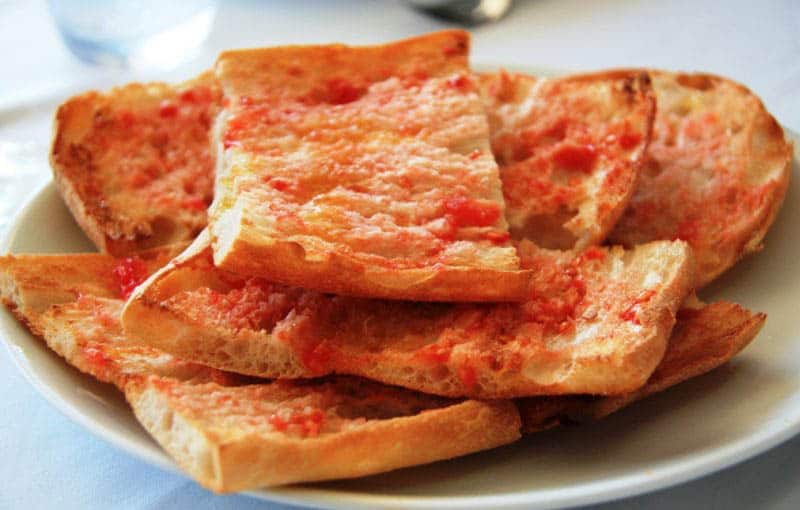
This is another classical dish from the region of Catalunya, Spain.
The dish goes by several names, but the most common ones are pa amb tomàquet, pan con tomate, and pan tumaca .
If you are wondering what to eat in Spain to start your day, look no further than this simple, tasty dish.
Because it is very easy to make and light for the stomach, it is therefore one of the main foods in Spain served for breakfast.
There are a few ways to make pa amb tomàquet , but here is the most common one:
Traditional Pan Tumaca from Barcelona
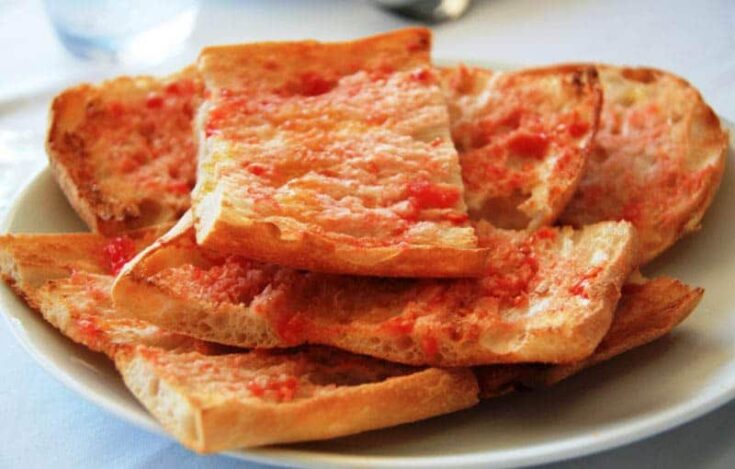
Pan Tumaca is one of the main foods in Spain served for breakfast. There are a few ways to make pan tumaca , but here is the most common one.
- Several toast bread slices
- 4 garlic cloves
- 1 tablespoon of olive oil
- Take four tomatoes (medium size), cut them in half, and discard the skin.
- Meanwhile, you should toast sliced bread until it gets a nice, brown color.
- Put the cut tomatoes into a bowl and add a tablespoon of olive oil.
- You will also need a clove of garlic. Rub the garlic into bread slices when you finish toasting them.
- Finally, put the tomato-olive oil mixture over the garlic-soaked bread and add a pinch of salt if needed
7. Cava – Sparkling Wine

When it comes to well-known food and drinks from Spain, cava is a good representative.
This popular drink is fundamentally made like champagne, but with different types of grape.
The simple, lemony flavor of this sparkling wine comes from Macabeu, which is the basic grape type used for its production.
Cava is often described as an affordable substitute for champagne, and it is served on different occasions.
There are several beautiful wineries you can visit or take a wine tour to these prettiest wineries near Barcelona .
8. Crema Catalana – Catalan Cream
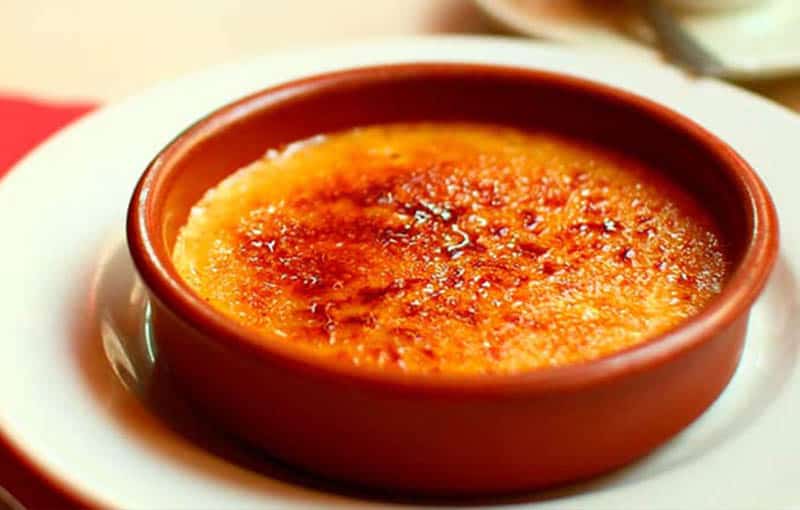
Crema Catalana (Catalan cream) became one of the favorite desserts to many of us who had the chance to try it.
This is one of the foods of Spain that is simple to make, and in terms of taste, it can be compared with crème brûlée .
People love it because the list of the things you need to make it is very short and available locally.
It is smooth, sweet, rustic, and indulgent simultaneously which is why it might become your favorite too.
You don’t have to travel to Spain to indulge in Crema Catalana ; you can easily order it online. – Check on Amazon
9. Calçots – Green Onions
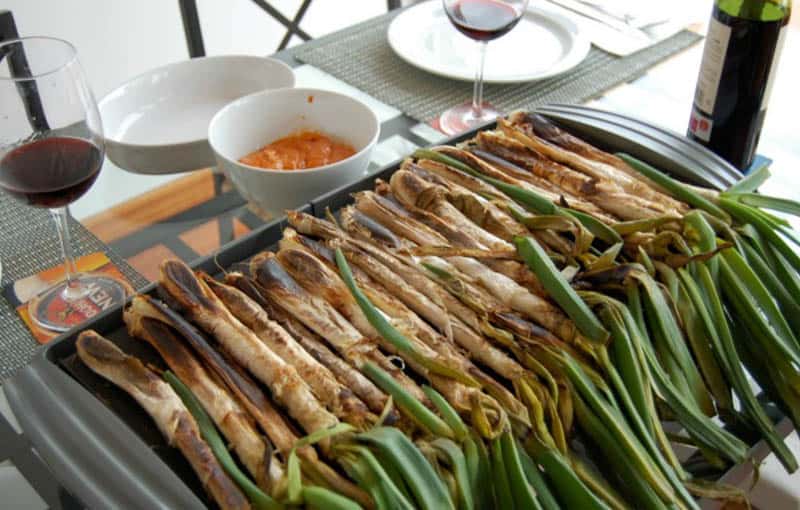
Calçots is a Catalan green onion, traditionally eaten to signal the spring, and so feels like a celebration of a sort.
Although you can find this vegetable on the restaurant menus for the whole year, the proper way to enjoy calçots is to eat it outside and while nature is blooming.
This is a typical food in Spain that most tourists overlook, but is definitely a must in the Spring.
Famous Food from Central Spain
Madrid is often considered a melting pot for many different cultures – not only in other Spanish regions but the whole world.
However, there are still plenty of authentic local cuisine to try, and fantastic restaurants to visit for traditional food in Madrid .
The climate of the region influences the food as well, so it is no wonder that meat is one of the dominant ingredients in this part of the country.
Even if you can use your time in Madrid to try all sorts of cuisines, you should really use the chance and try local dishes such as gazpacho , the famous churros , and the typical Spanish tortillas .
10. Jamón Ibérico – Iberian Ham
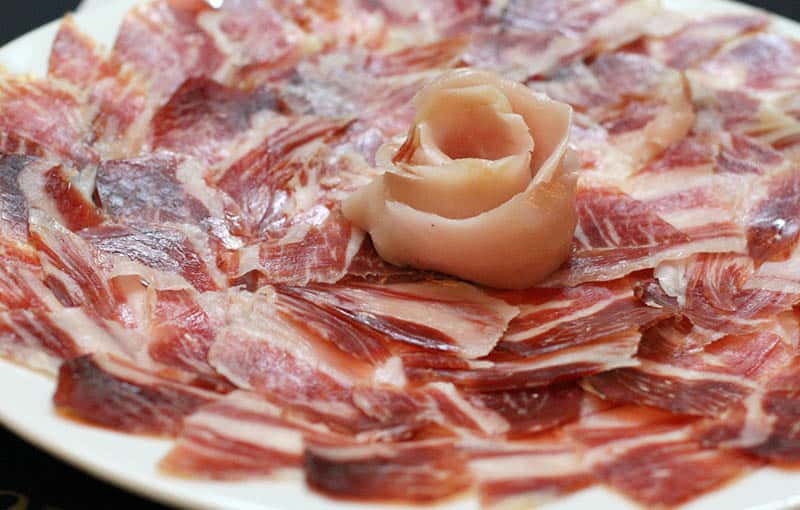
There are two kinds of ham in this world. One is Jamón Ibérico (Iberian ham), and the other is the sum of all other hams in existence.
The question ‘’What do people eat in Spain?’’ can be easily answered: only the best!
Even the back story is fascinating and includes many centuries, different rulers, and the ritual sacrifices that the pigs were used for.
Nowadays, Jamón Ibérico (Iberian ham) is one of the best-known Spanish products, and it can be found worldwide.
You’re not in Spain? No problem, you can get Jamón Iberico at Amazon too! – Check prices here
11. Tortilla Española – Spanish Omelet

This is one of the most popular foods in Spain! It is easy to whip up and has the right amount of versatility to be prepared as both breakfast and dinner.
The main reason why tortilla española (spanish omelet) the omelet is considered to be a Spanish food classic is that all the ingredients are more or less already in our households.
Essentially, you only need eggs, a few potatoes, a little bit of oil, and an onion to prepare it.
12. Churros
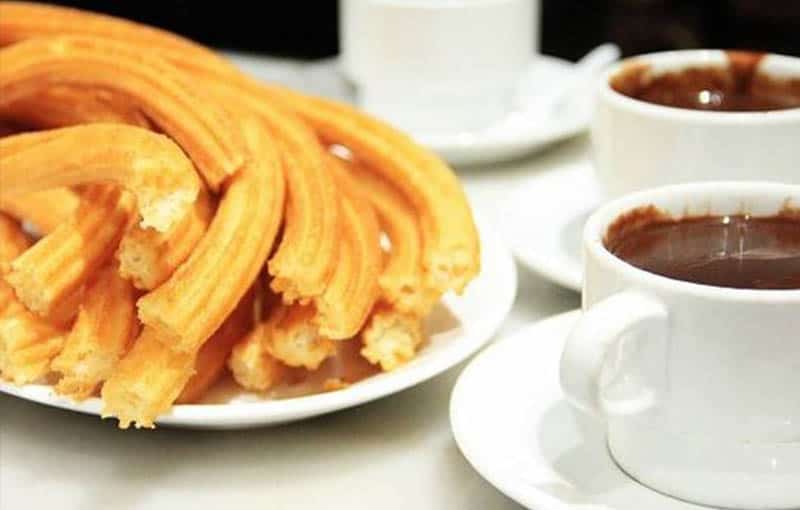
One of the best treats in the Spanish capital is well-made churros.
Churros from Madrid are practically a symbol of Spain in the world of foodies, and it is unthinkable to leave the country without having tried them!
Certain churrerías ( churro s shops) are so popular that people stand in line for hours just to taste this crispy and chocolate-dipped delicacy!
Read: Authentic churros recipe
13. Albondigas – Meatballs
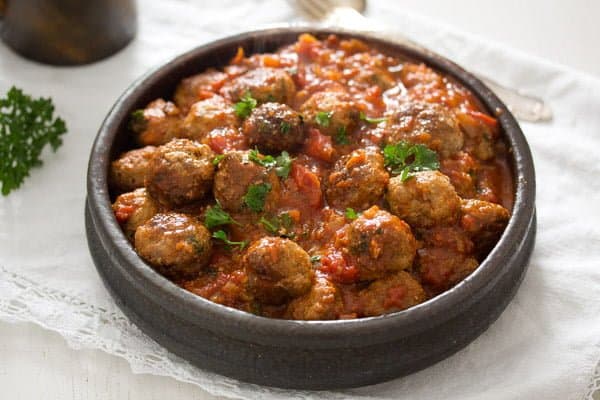
Meatballs are common in many regions that have a climate similar to Madrid .
Albondigas is the Spanish meatball version, usually made for dinner, and you must give it a try as it is one of the must-eat foods in Madrid !
The delicious thing about albondigas (meatballs) is that they are small and made with a flavorful sauce.
This is also one of their biggest distinctions from Italian meatballs.
14. Migas – Crumbs
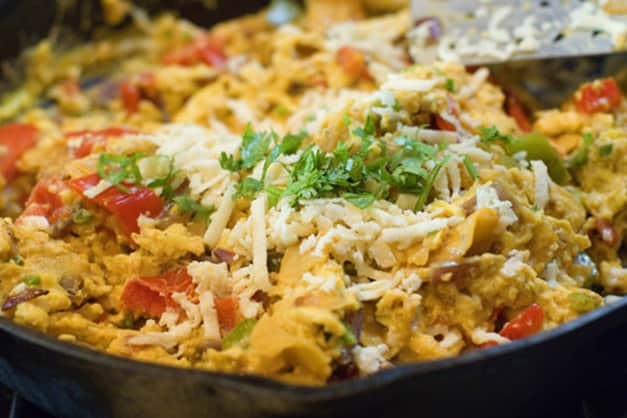
Migas (crumbs) are also a very popular snack and supper idea to try while visiting the central region of Spain.
They are principally fried bread crumbs, typically served with paprika and fried eggs or red chorizo sausage .
It is said that migas are one of the most ancient Spanish dishes!
15. Leche Frita – Fried Milk
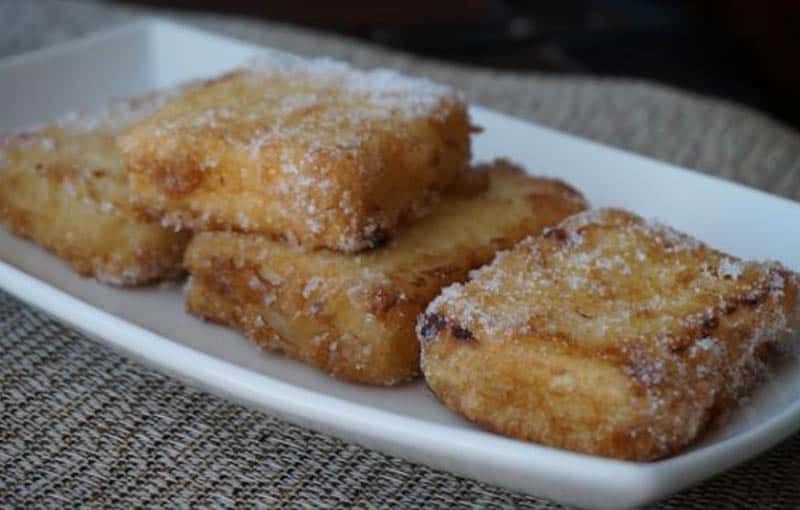
Despite being translated as ‘’fried milk’’ which doesn’t sound very tasty, Leche frita is an amazing dessert! It has two variations for serving.
One is cold, and the other hot, with a scoop of ice cream on the side.
The main ingredients are obviously milk, wonderfully mixed with flavor, eggs, butter, sugar, cornstarch, and cinnamon.
16. Pisto Manchego – Ratatouille
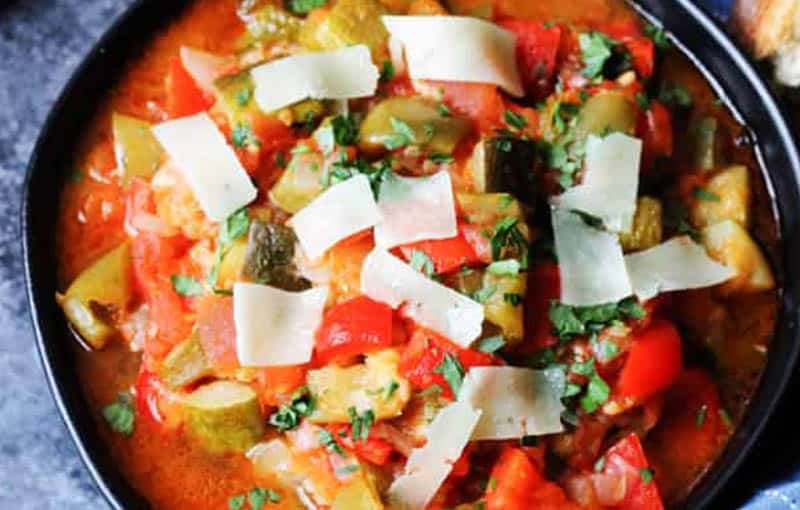
Whether you are a vegetarian or not, you will love pisto manchego (ratatouille).
It is one of the finest mixtures of stewed vegetables, and definitely a food to try in Spain!
Historically speaking, the origin of pisto manchego (ratatouille) is Arabic, however, it is one of the most popular vegetarian dishes in the region.
17. Cochinillo Asado – Roasted Suckling Pig
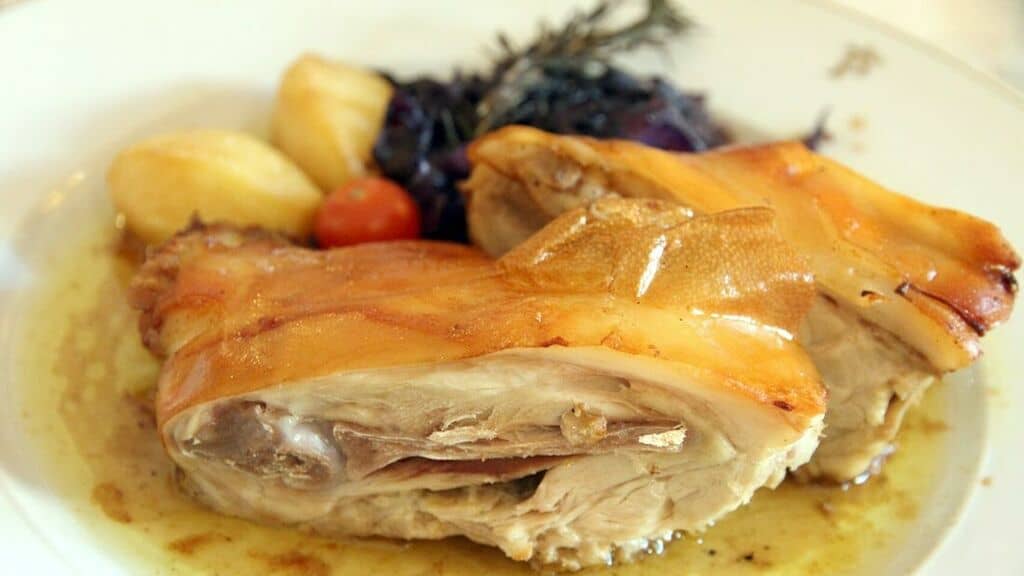
If you are a meat lover, you shouldn’t skip Cochinillo Asado , commonly known as “roasted suckling pig”.
The quality of its preparation is measured by the tenderness of the pork, and many take pride in knowing the right way of roasting and seasoning it.
This is a typical lunch food, and it is especially popular in Castilla.
The best way to enjoy this typical dish is by going on a day trip from Madrid to Segovia and try cochinillo asado (roasted suckling pig) at its birthplace, the town of Segovia.
18. Queso Manchego – Manchego Cheese
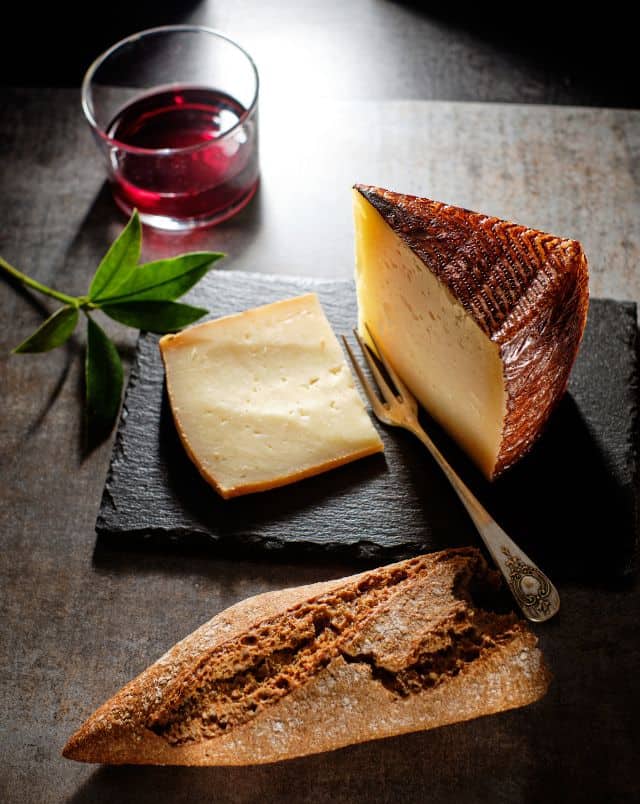
Manchego Cheese is an incredibly popular food in Spain – so much so that it is sometimes referred to as the Spanish ambassador of cheeses.
The cheese originally comes from Central Spain and is made using the region’s Manchega sheep.
This famous Spanish food is known for its sweet, zesty taste, and its lingering salty aftertaste.
As with many kinds of cheese, the longer it is aged, the more intense the flavor.
Manchego Cheese is typically served raw (as opposed to cooked and melted) with tapas.
So, if you are wondering what to eat in Spain with bread and olive, you cannot go wrong with Manchego Cheese!
Just don’t ruin some of the best food in Spain by eating the rind as it is inedible!
Traditional Dishes in Northern Spain
As a traveler, you can’t be satisfied with just visiting. It is all about the experience, and tasting food in Northern Spain is no exception!
An alternative name for this region can be ‘’eating well is a duty’’ since gastronomy makes one of the most important aspects of their daily lives.
The Basque country is a typical representative of the region famous for its tradition of pinchos , which is going from bar to bar and sampling food.
19. Pimientos de Padrón – Padrón Peppers
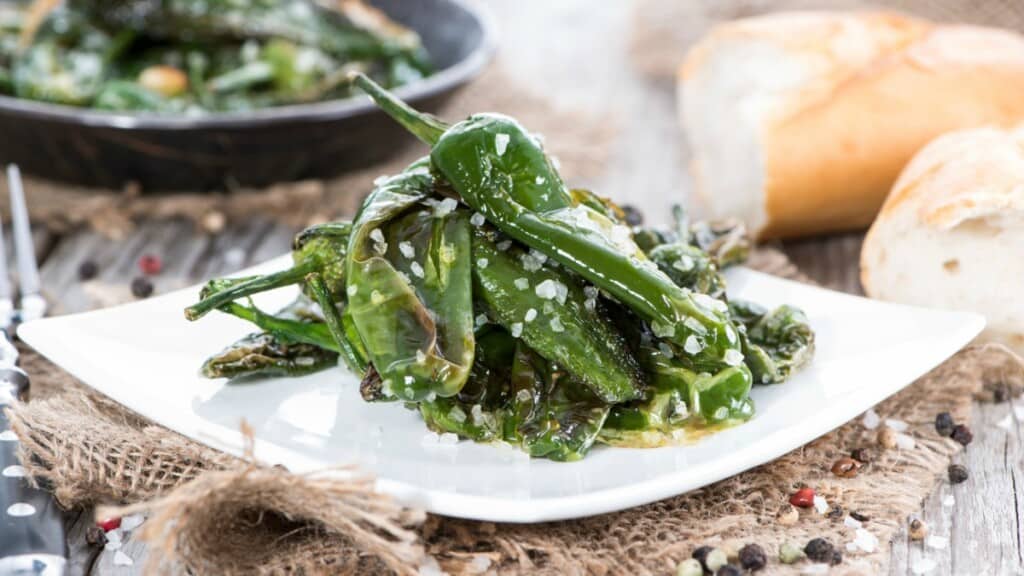
Pimientos de Padrón (padrón peppers) can be described as a rustic and traditional Spanish dish, made from a particular type of pepper that grows in Northern Spain.
It is typically served as a snack, but it is not uncommon to find it as a part of a bigger tapas (appetizers or snacks) buffet.
If you’re after some typical food in Spain that may have a little kick to it, pimientos del Padrón make for a delicious tapas dish.
Like a lot of the food of Spain, these green peppers are pack full of flavor, but they are typically mild, but there’s always the chance of finding a spicy outlier in your bowl!
There’s a Galician saying: Pimentos de Padrón – some are hot, some are not!
The Padrón pepper originates from the Padrón region in Galicia in northwestern Spain.
Traditionally they come served hot after being grilled or fried lightly in olive oil and sprinkled with a little salt.
Pimentos del Padrón are usually served still with the stalks on, and to eat this tasty food in Spanish style, hold them by the stalks and take a nice big bite.
Spanish Pimientos de Padrón
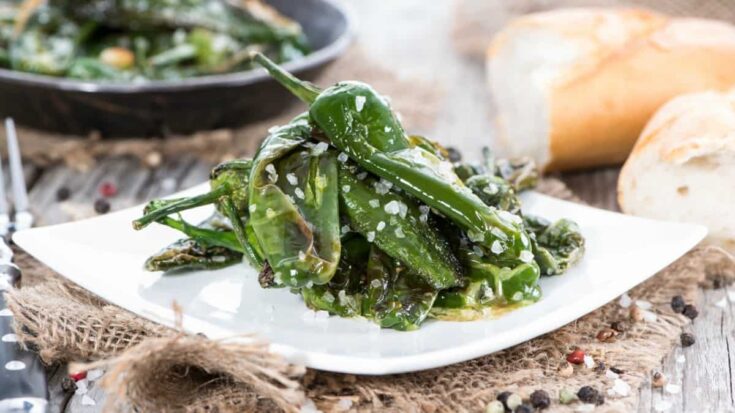
Pimientos de Padron can be described as a rustic and traditional Spanish dish, made from a particular type of pepper that grows in Northern Spain. It is typically served as a snack, but it is not uncommon to find it as a part of a bigger tapa buffet.
- 200g of Pimientos de Pardon
- 1 tablespoon of fresh pepper
- 1 tablespoon of flaky oil and sea salt
- Prepare Pimientos de Padrón along with a bit of fresh pepper, flaky sea salt, and flaky oil for frying. Make sure that you wash the vegetables properly.
- Heat the oil and fry the pimientos .
- You will know that they are fried once they get softer.
- Serve them on a plate and sprinkle salt and fresh pepper over.
It is one of the simplest snacks to recreate from the comfort of your home.
20. Pulpo a la Gallega – Polbo á Feira
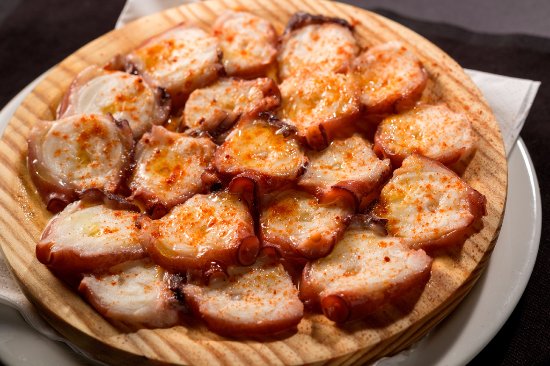
Apart from being one of the most typical foods from the Northern parts of Spain, pulpo a la gallega ( polbo á feira ) is also one of the easiest to make.
There are only four ingredients needed to recreate it in the kitchen and they are all easy to find.
This makes it a great option for making a quick and tasty dinner of food from Spain.
Pulpo a la Gallega - Spanish Recipe

There are only four ingredients needed to recreate it in the kitchen and they are all easy to find. It is a great option for making a quick and tasty dinner.
- The key here is in preparation. You need about 20 minutes to boil the octopus, and another 20 minutes to cool it down.
- The next step is to separate the head from the tentacles and cut the tentacles into small pieces (you can use scissors).
- Once you prepare the tentacles, toss them into olive oil, add paprika and salt.
21. Bacalao – Cod
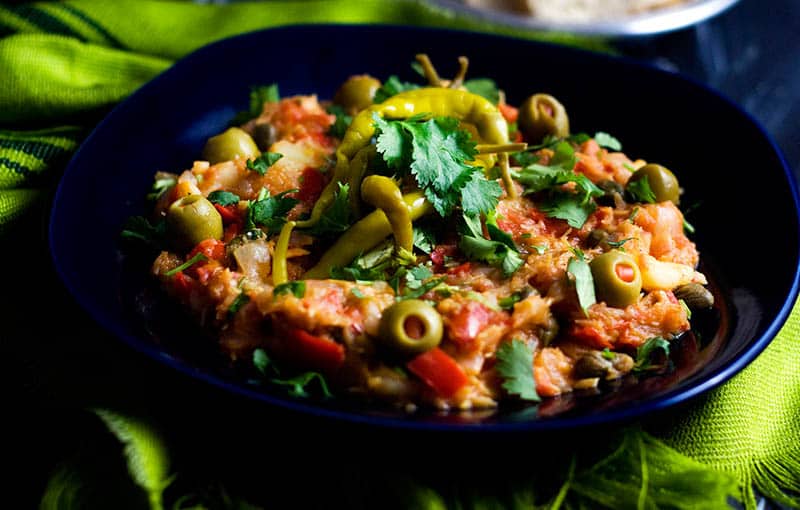
I mentioned before a typical Christmas dish in Spain , well, bacalao (cod) can be defined as a traditionally served Christmas dish.
It is basically a salt cod stew, prepared with potatoes, tomatoes, and garlic.
But please note that a good bacalao (cod) needs time to prepare, especially when it comes to the level of salinity!
Some of the best bacalao (cod) can be enjoyed in San Sebastian, northern Spain.
It is also having the countryside where you can enjoy farms which is one of the best things to see in San Sebastian and it is often seen as an off the beaten path Spain attractions .
22. Fabada asturiana – Asturian Bean Stew
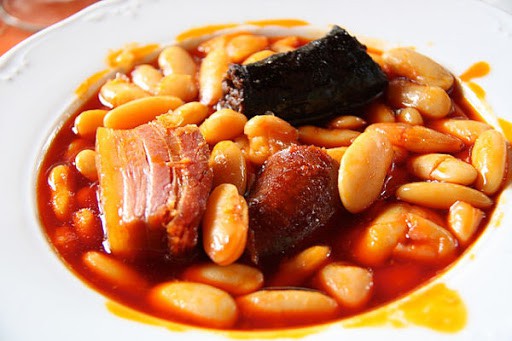
When the weather is chilly, and you really want something to warm you up and gives you energy, there is nothing better than a bean stew known as “ fabada asturiana ” (Asturian bean stew).
Despite its origin, which is Asturias, this stew can be found all over Spain and is commonly served for lunch, especially during winter.
Spanish Fabada from Asturias

Despite its origin, which is Austrias, this stew can be found all over Spain. It is commonly served for lunch, especially during winter.
- 150g of white beans
- 2 slices of bacon
- Make sure you soak the beans. Leave them overnight.
- Cook them along with the other ingredients the following day.
- You should remove the bones and cut the meat only after it is cooked with the beans first.
- Once you separate the bones, return the meat back with the beans.
- Cook for 30 min on low temperature
23. Tinned Seafood
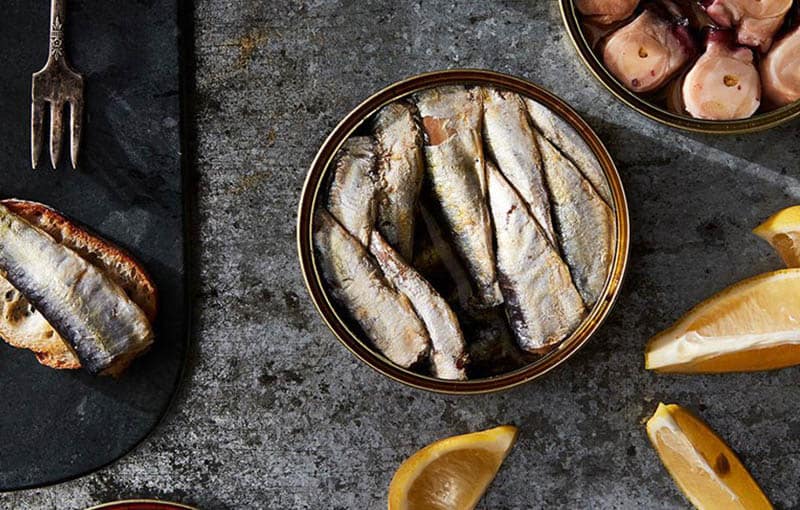
There is a long tradition of tinning seafood in Spain to keep it fresh.
Nowadays, it can be found in pretty much every place that serves food, and versatility of the fish adds to the popularity and frequency of serving.
Tinned seafood is typically eaten for dinner, or as a snack while drinking.
You don’t want to wait until your next Spain vacation to try tinned seafood? Good news, you can get it at Amazon ! – Check prices here
24. Chorizo a la Sidra – Chorizo in Cider
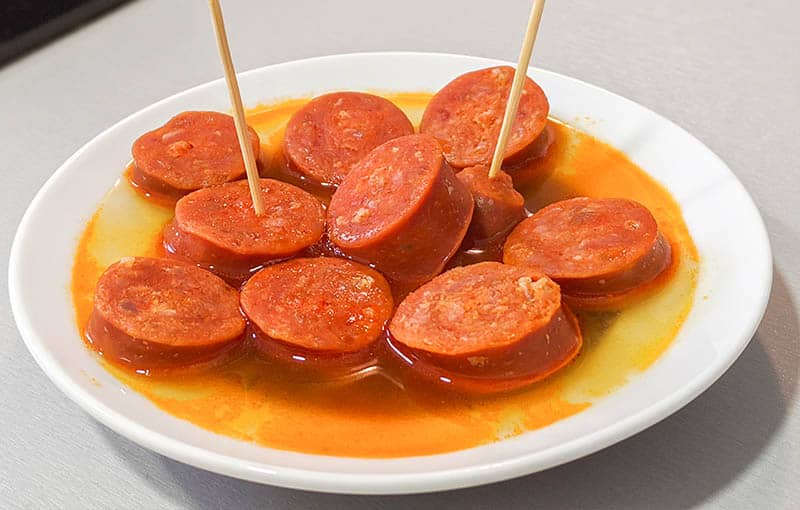
A combination of many times mentioned chorizo sausage and hard apple cider found in Asturias is among the things to eat in Spain that you don’t want to miss.
It is often prepared during barbecues but is commonly served as an appetizer.
Chorizo is not complicated to make, but the quality of the ingredients makes a huge difference!
If you can’t travel to Spain right now, you can still order Spanish chorizo online – Check it on Amazon
Cider Chorizo from Asturias
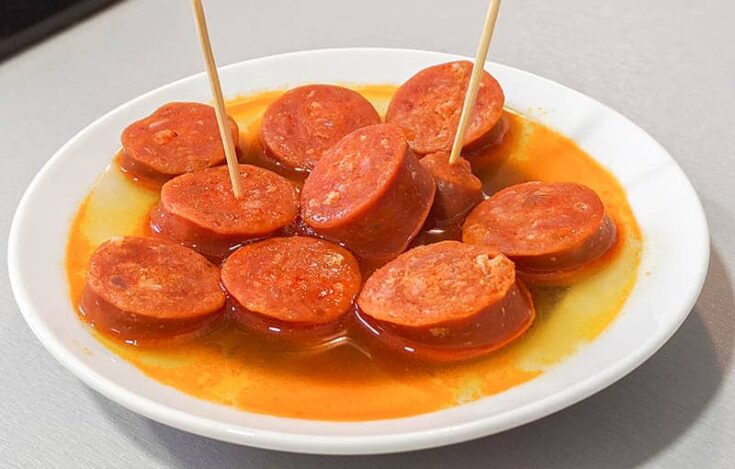
Cider Chorizo is often prepared during barbecues but commonly served as an appetizer. It is not complicated to make, but the quality of the ingredients makes a huge difference.
- ½ kg of chorizo sausage
- 1 ½ cup of apple cider (hard)
- A few bay leaves and chopped parsley
- Fry sliced chorizo in a pan.
- Add apple cider and bay leaves and simmer for approximately 10 minutes.
- The cue to stop simmering is that the cider becomes syrupy.
- Serve this appetizer in a bowl and sprinkle with chopped parsley.
Recommended Products
As an Amazon Associate and member of other affiliate programs, I earn from qualifying purchases.

Popular Food from Southern Spain
Many have written about the several attractions of Andalusia and its food.
Some people can be surprised to hear that Sevilla is not only popular because of its amazing cultural heritage, but also because it has some of the oldest tapas restaurants in Spain.
But besides Seville, there are plenty of other towns waiting for you with amazing Andalusian food .
25. Gazpacho – Cold Soup
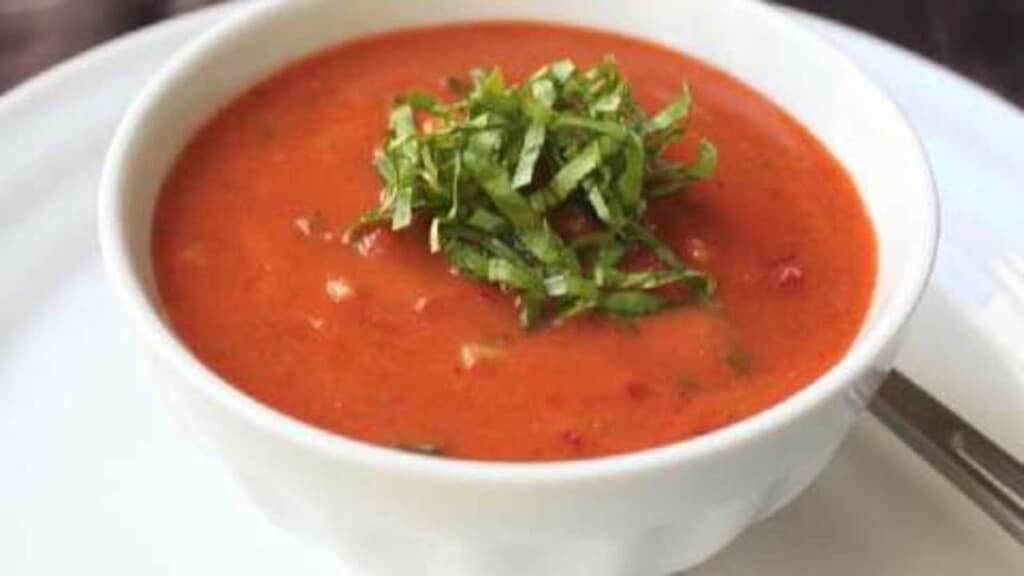
Apart from being one of the most notable seasonal soups, gazpacho (cold soup) is another perfect option for those who don’t eat meat and want to know what to eat in Spain.
It is prepared with raw ingredients and commonly served cold, and during hot summer days.
26. Salmorejo
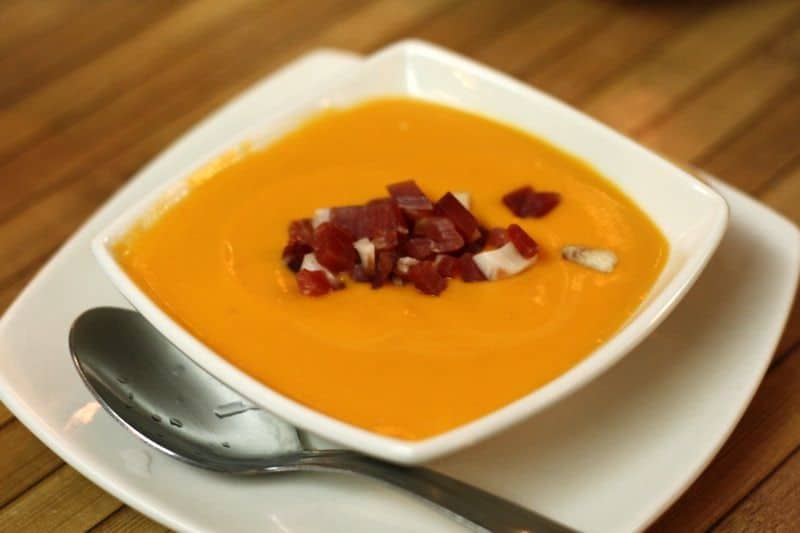
This is another cold soup that is typical for the southern Spanish region.
Although it has similarities with gazpacho (cold soup), Salmorejo is creamier and tastier, due to the ham that adds to the flavor.
Just like gazpacho (cold soup), it is also served during summer.
Spanish Salmorejo
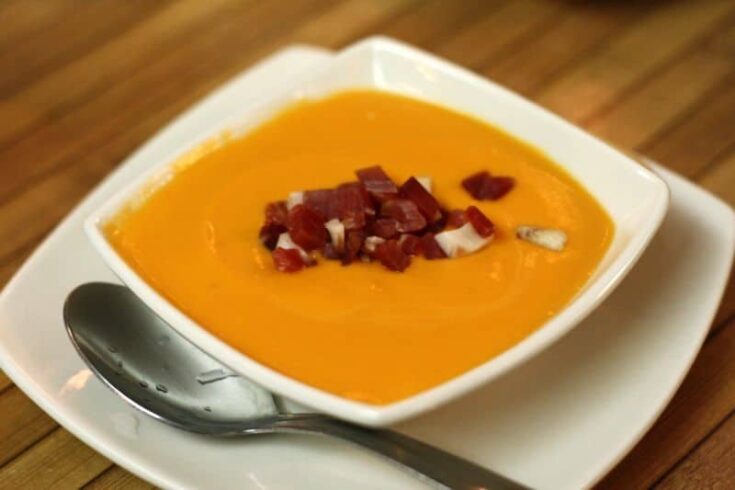
Salmoerejo is another cold soup that is typical for the southern Spanish region. Although it has similarities with gazpacho, Salmorejo is creamier and tastier, due to the ham that adds to the flavor. Just like gazpacho, it is also served during summer.
- 2 pounds of ripe tomatoes
- 3 slices of bread
- 2-3 cloves of garlic
- 1 tablespoon of cider vinegar and olive oil
- 2 tablespoons of ham
- 1 hard-boiled egg
- Blend the Salmorejo ingredients but make sure you peel the tomatoes first.
- When you get the even mixture, pour it into the bowl and garnish it.
27. Croquetas de Jamón – Ham Croquettes
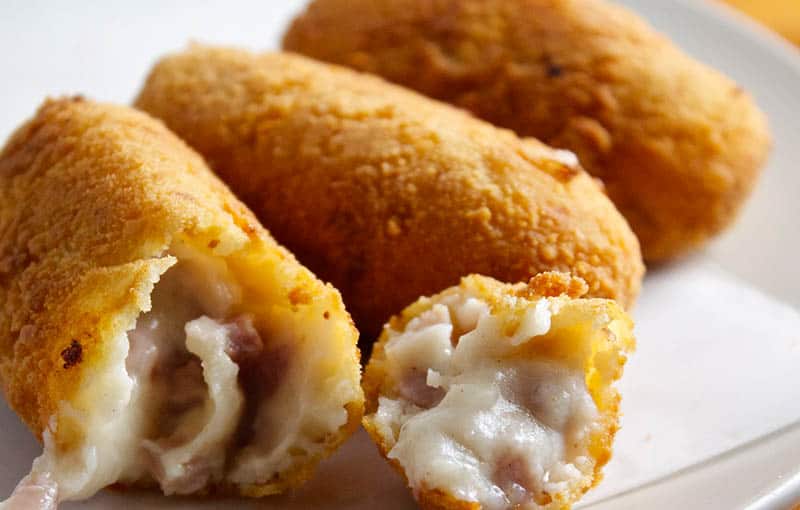
Croquetas de jamón (ham croquettes) are a frequent southern appetizer made of bread crumbs, olive oil, ham, and seasoning.
They are one of the most popular foods in Spain and one of the easiest to make at home, and you can also serve them as a light dinner.
28. Calamares a la Andaluza – Andalusian-Style Squid
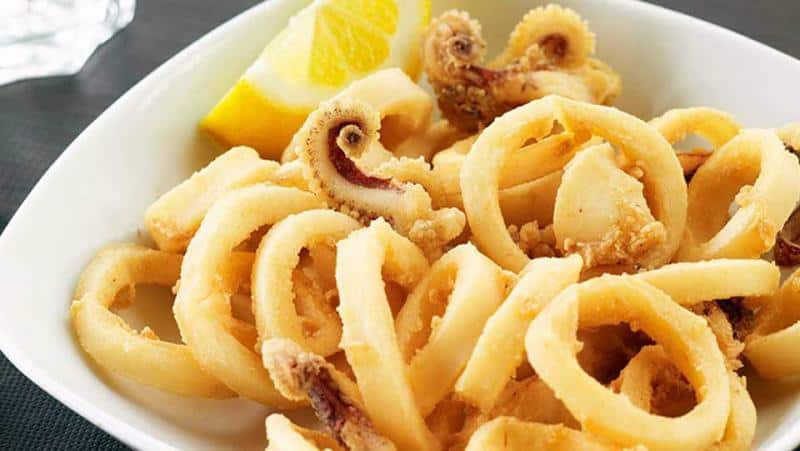
If you love seafood and want to know what to eat in Spain when trying tapas , you can’t go wrong with calamari !
Fried calamari (squid) is the best-known Andalusian flavor, and one of the most famous tapas (appetizers or snacks) made from seafood and very easy to prepare.
I would point out that the best way to enjoy calamari (squid) is to consume them with a cold beer.
29. Espetos – Sardine Skewers

When it comes to espetos (sardine skewers), Malaga has the classic ones as they are a part of a lifestyle and treated as ancestral culinary.
The whole preparation process is very unique in this region and represents one of the most authentic foods in the world.
30. Gambas al Ajillo – Garlic Shrimps
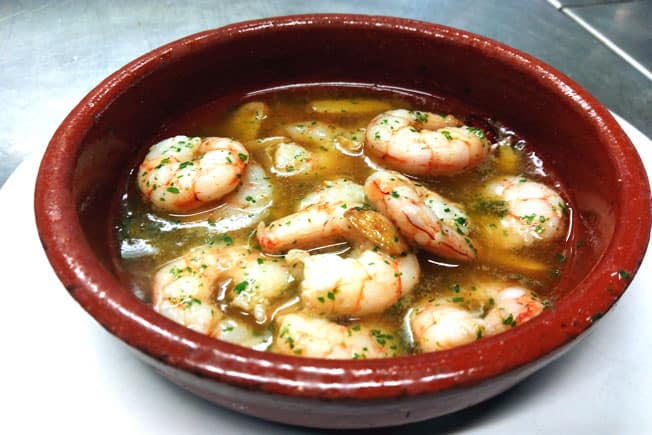
Small tapas (appetizers or snacks) are the best ones to taste and usually the most famous ones too.
Gambas al ajillo (garlic shrimps) are the best examples.
This is a truly Spanish dish, and involves a lot of garlic and paprika, with slight variations in additional ingredients from place to place.
31. Boquerones en Vinagre – Anchovies in Vinegar
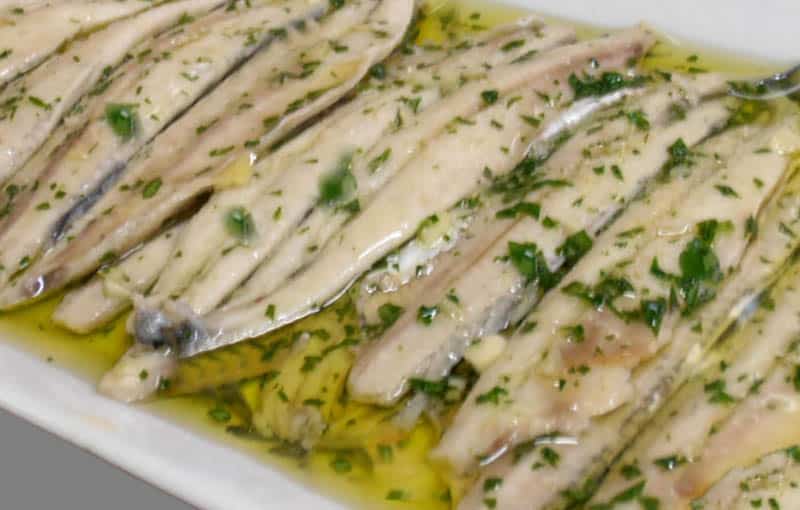
The summers in southern Spain are always better with a plate of boquerones en vinegar (anchovies in vinegar), an awesome appetizer made from small blue-colored, marinated fish.
The best time to eat this tapa (appetizer or snack) is between April and September when there is plenty of fish.
Still, it has to be carefully prepared to avoid possible diseases from the parasites that inhabit it!
It’s one of my favorite foods from Spain, especially on hangover days!
32. Pollo al Ajillo – Garlic Chicken

When I’m asked what Spain foods you can easily make at home, pollo al ajillo often comes to mind.
If you know Spanish or are familiar with other spanish food names, you can probably guess that this is Spanish “garlic chicken.”
One of the most popular Spanish foods with locals and visitors alike, pollo al ajillo is made with chicken pieces, white wine, parsley and a generous helping of garlic.
So while this might not be what to eat in Spain on a first date, it is definitely a tasty choice!
If you don’t like spice, check with your server before ordering as ajillo sauce traditionally has lots of paprika in it.
However, I have found it isn’t always included with this particular famous food in Spain.
Famous Spanish Foods Found All Over Spain
Of course, aside from the regional food of Spain, there are some famous foods in Spain that can be found everywhere in the country.
The foods below don’t have a specific origin – though there may be a regional way of making them – and you can find them everywhere in Spain at good quality.
33. Sangria

When it comes to famous Spanish foods, lots of people also start thinking about what they want to drink with them.
Many of them opt for sangria, one of the staples of Spain food culture.
This formidable fruity punch-like drink can be traced back to the 18th century, although the exact origin is unknown.
Spain and Portugal are the only Iberian countries that are allowed to use the name “sangria”, which means “bloodletting”, possibly due to the rich red color of the drink.
Red wine is used as a base, which is then augmented with fruit and other sweeteners, and sometimes even other alcoholic extras.
Just as there are multitudes of different foods of Spain, there are also plenty of different sangria recipes.
More recently, the “sangria blanca” has emerged as a popular variation of this delicious drink, which uses white wine as a base instead of red.
34. Aceitunas – Spanish Olives
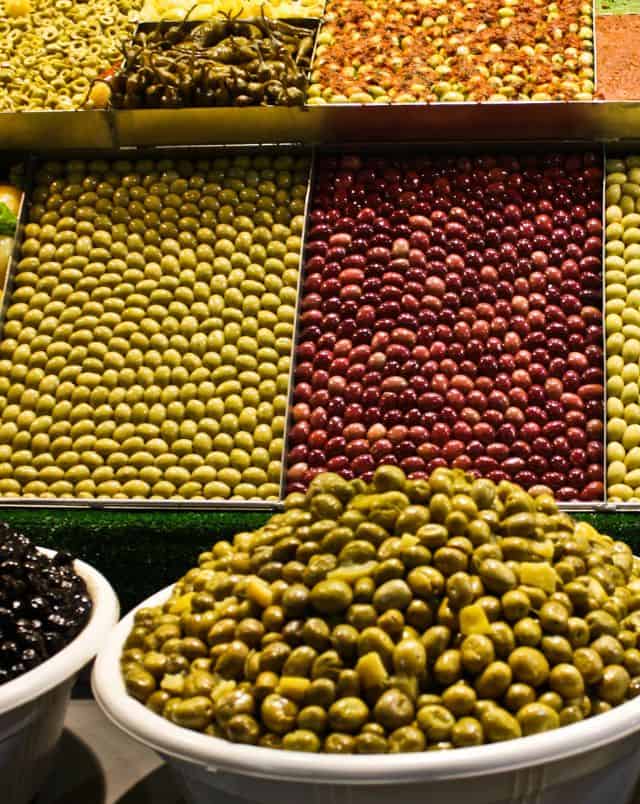
You can’t really try Spain’s food without encountering aceitunas (olives), even if it’s just as a side or appetizer.
In fact, Spain is the world’s largest producer of both olives and olive oil!
As you can imagine, there are many different varieties of olives available in Spain and they can be found in many traditional foods in Spain.
This Spain famous food comes in a range of flavors, from salty to nutty and bitter to sweet, as well as all shades of green and black.
With over 200 varieties to choose from, you will often find every region – and sometimes every restaurant – offers a different type.
So try some olives, find your favorite, and then bring some food from Spain home as a gift (for yourself or someone else)! – Buy here on Amazon
Short FAQ about Things to eat in Spain:
What time do people eat dinner in spain.
Dinner in Spain is eaten late, usually after 10pm.
What food do you have to eat in Spain?
Naming a few from the list: paella , fideua , patatas bravas , etc.
Is it expensive to eat in Spain?
Meal prices in Spain can vary, but breakfast prices are usually a little cheaper than lunch or dinner. You can get a good breakfast for 5 €.
What to eat in Spain for breakfast
Some of the best traditional food in Spain to eat for breakfast is either pa amb tomàquet , or tortilla Española .
What time to eat in spain?
The three main meals are typically eaten around the following – Breakfast: 8-9 am; Lunch: 1:30-2:30 pm; Dinner: 9-11 pm. But keep in mind that Spaniards often indulge in several snacks throughout the day.
What not to eat in Spain?
It’s not so much about specific foods, but where you eat them! If you want to try a Valencian dish, eat it in Valencia, otherwise, you will not get the full experience!
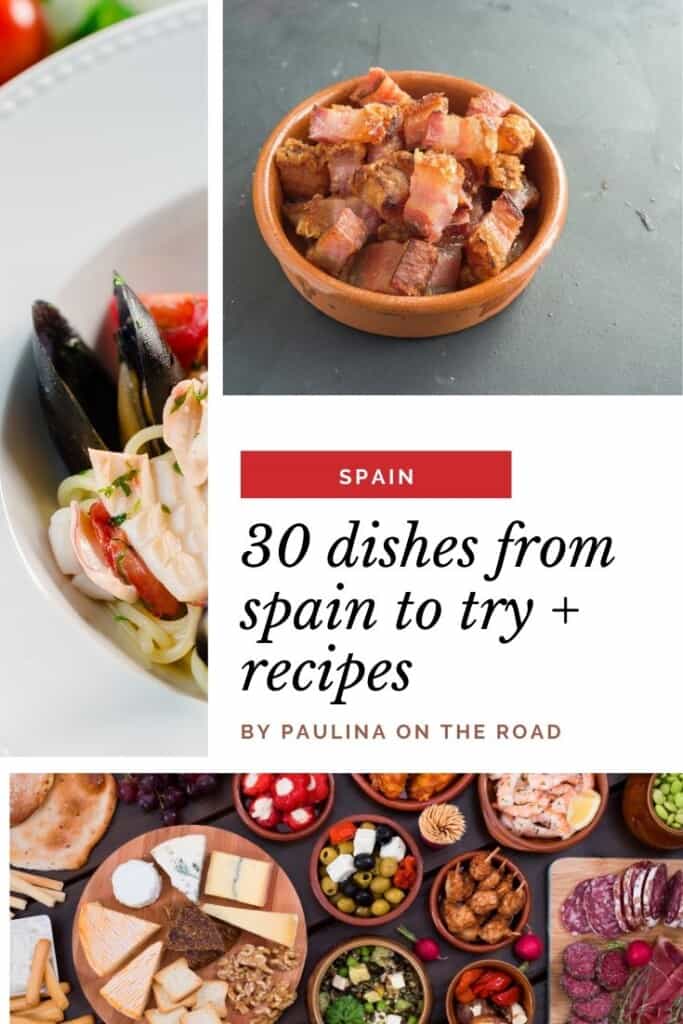
Hola! I’m Paulina, a seasoned travelette who crossed the Atlantic Ocean by Boat HitchHiking. On my blog, find expert insights for an extraordinary holiday through outdoor and sustainable travel like hiking, cycling, and sailing. Let’s embark on unforgettable journeys together! 🌍🚀
Tuesday 19th of July 2022
I would want to be getting notifications from your food recipes
Tuesday 2nd of August 2022
Hi dear, here you can find many more Spanish recipes and if you subscribe to the newsletter you'll get weekly Spanish recipes in your inbox: https://visitsouthernspain.com/category/food/recipes/

- Destinations
- Travel Guides
- For The Home
- Privacy Policy
Food , Spain
Spain food guide – what to eat in spain.
During our 3 years living in Spain, we fell in love with Spanish food. Spanish cuisine is regional, which means there are unique dishes to try in each region. These are some of our favorite food destinations in Spain, with must-visit cities, regions, and islands for food lovers. This Spain food guide focuses on what to eat in Spain, as soon as it is ready to welcome visitors once again.
**This post contains compensated links. Find more info in my DISCLAIMER . As an Amazon Associate, I earn from qualifying purchases.
Why Travel To Spain For Food
There’s one thing I can guarantee if you visit Spain, you are going to eat really well. It’s one of the reasons why we moved there and spent three years exploring its many foodie cities. For us, Spanish food is unmatched in terms of creativity, diversity, and regionality.
When answering the question, what is Spain famous for, in my eyes, there can only be one answer, its food.
From San Sebastian in the north to Seville and Malaga in the south, the range of dishes to eat is mind-blowing. While Spain has its fair share of Michelin-starred restaurants, it is the traditional dishes that have us missing Spain and counting down until our next visit.
It’s not just the actual food and drink in Spain that we look forward to experiencing again, but the passion the Spanish have for food.
Walk into any tapas bar or restaurant in Spain and you automatically feel a part of a small community. A community despite any language barrier shares in the common enjoyment of Spanish food.
How To Book Hotels In Spain
Since leaving the US over a decade ago, we’ve traveled to Spain numerous times. We’ve even lived in Spain for over three years. During these trips to Spain, we learned a few things about booking hotels in Spain. We’ve stayed at stunning luxury hotels like the Hotel Alfonso XIII in Seville and the W Barcelona . And sadly we have stayed in our fair share of not-so-great hotels in Spain.
When planning our trips to Spain, we use Booking.com for hotels in Spain. In addition to booking hotels, we’ve used them to book apartments in Spain for longer stays. When we’ve wanted something special, we’ve used Booking to find stunning villas in Spain . We’ve even found some charming and less expensive guest houses in Spain on Booking.com.
Best Foods In Spain

When it comes to what to eat in Spain, there are certain dishes in each city or region that are must-try dishes. While new travelers to Spain might think the entire country is filled with paella, sangria, and Jamon, that couldn’t be further from the truth.
Okay, you will find Jamon, the famous Spanish cured ham, pretty much everywhere.
But paella, for example, is a regional dish from Valencia, and not something that should be eaten in the north in the Basque Country, or in the Canary Islands. Paella is the most famous of Spanish rice dishes, but there’s so much more to eat in Spain than paella!
Here, we’ve come up with our list of famous foods in Spain, by region. It’s not likely you can plan a single trip to Spain to visit all of these regions.
That’s why repeat trips to explore the full country are necessary! That’s the only way to find all of the best food to eat in Spain.
Looking for more destinations for food lovers? Check out our roundup of the Best Destinations For Food Travelers .
Recipes For Famous Foods From Spain
While we’ve been away from Spain, we’ve had to satisfy our cravings for Spanish food by cooking our favorite dishes at home.
Included in our list below are some of our recipes for our favorite regional dishes, tapas, and desserts. This is the perfect way to keep Spain on your mind at home!
Check out our list of 14 of our favorite Spanish tapas recipes .
Papas Arrugadas From Gran Canaria

While Gran Canaria might be known for sun, sand, and surf, it’s also one of Spain’s best culinary destinations. Located off the coast of Africa, the food of Gran Canaria has been greatly affected by outside influences for centuries.
One of the traditional Spanish dishes we discovered during our trip to Gran Canaria was papas arrugadas, often referred to as, “wrinkled potatoes.”
A mainstay in Gran Canaria cuisine, papas arrugadas can be found on nearly every restaurant menu and should definitely be ordered.
Unlike their more famous cousins, patatas bravas, papas arrugadas are boiled in salt water, not fried. They are traditionally served with Mojo Picon Rojo, a tangy red salsa made using peppers, garlic, and vinegar.
As with most Spanish dishes, the balance between the salty potatoes and tangy sauce is perfect.
Learn more and Spanish food in Gran Canaria:
Gran Canaria Food Guide
Recipe for Papas Arrugadas – Canarian Wrinkled Potatoes
Recipes for Mojo Picon Rojo
Gran Canaria Wine Guide
Cochino Negro – Canarian Black Pig From Tenerife

Easily one of the most famous foods from Spain is pork.
One of the reasons why we love Spain so much and lived there for three years was because of the Spanish love (obsession) for pork. From Jamon Iberico to chorizo, the Spanish easily produce some of the best pork in the world.
On Tenerife in the Canary Islands, the tradition of producing amazing pork continues with cochino negro or black pig. If you are making a must-eat Spanish food list, cochino negro has to be on it.
Cochino negro is a protected special breed pig only found in the Canary Islands.
So much so, that only specific breeders can raise the pig and specific restaurants can offer it. To say it is juicy, tender, and delicious would be an understatement.
Learn more and Spanish food in Tenerife:
Tenerife Food Guide
Tenerife Wine Guide
Flamenquines From Córdoba

Traditional foods in Spain come in all shapes and sizes. One of the most eye-opening can be found in Córdoba down in Andalusia. Now, this isn’t exactly a healthy dish, but if you enjoy pork and love things deep-fried, then you are going to want to eat a flamenquín.
A regional dish, you will be hard-pressed to find a flamenquín outside of Córdoba. The dish itself consists of sliced pork loin, Jamon, and cheese.
Sliced thin, all three are rolled together, breaded, and deep-fried. Served alongside pickled vegetables and some salmorejo you’ll want to go for a short walk afterward.
Learn more and Spanish food in Cordoba:
Cordoba Food Guide
Caracoles From Granada

Before traveling to and eventually calling Spain home, you wouldn’t get me within 100 miles of eating snails. Now, I long for them. I think that’s a compliment to Spanish cuisine and cooking. The ability to take an ingredient that might be off-putting and making it delicious.
Not the most famous Spanish food, snails are eaten everywhere in Spain. In Catalonia, we’d eat them in a black pepper sauce. Authentic Valencian paella includes snails. But for me, the best is found in Granada.
Typically eaten using a toothpick the snails are cooked in a simple sauce of almonds, olive oil, garlic, and other seasonings. They are easily one of the best Spanish tapas we’ve ever eaten. So simple. So good. And why I can’t wait to visit Granada again.
Learn more and Spanish food in Granada:
Granada Food Guide – The last city that still offers free tapas with drinks.
Anchovies And Boquerones From Catalonia

Catalonia, Girona, was our home for three years. In that time we ate A LOT of great food. While Spain has miles and miles of coastline, if you ask us, the best for food is in Catalonia. Its cold deep waters produce outstanding seafood, especially fish.
For many travelers to Spain especially Americans, eating anchovies isn’t common. But if you go to Spain, you must try them. Anchovies and boquerones are some of the most popular foods in Spain to eat.
Visit any tapas bar in Spain and you’ll find them. Caught in the waters just off Spain, they are always fresh and best enjoyed with a cold caña (beer) or glass of vermouth.
In addition to eating them fresh, whole anchovies are eaten fried as well as in a simple preparation of vinegar and Spanish lemon . It still amazes me how many Spanish dishes incorporate only a couple of ingredients yet the flavors are so big.
Learn more and Spanish food in Catalonia:
Catalan Food Guide
Barcelona Craft Beer Guide
Girona Travel Guide
What To Expect From El Celler De Can Roca In Girona
Albóndigas En Salsa De Almendras – From Malaga

This is a dish I have on my personal best tapas list. Albondigas Almendras, or meatballs with almond sauce, is a popular dish in Malaga and other parts of Andalucia. Why I have this on my list is not the meatballs, which are tender and juicy. It’s the sauce.
There are a lot of delicious sauces in Spanish cooking. One of our favorites is a Catalan salsa romesco . That said, there is just something about using almonds that sets this sauce apart. Almonds are extremely popular across Andalucia so it makes sense to use them in the sauce.
This particular sauce includes almonds, olive oil, garlic, bread, and white wine. The resulting sauce is mild yet flavorful. It seems to have a creamy, silky texture that is simply divine.
Learn more and Spanish food in Malaga:
Malaga Food Guide
Malaga Travel Guide
Setas – Grilled Mushrooms From Logrono

Leave it to Spain to not only have incredible meats and fish but also vegetables. The northern city of Navarro is world-renowned for peppers as well as the Galician city of Padron. If mushrooms are your thing, then it’s time to head to La Rioja and its capital Logrono.
Toughed away on Calle Laurel, the main street for pintxos bars, you’ll find the juiciest and most amazing mushrooms ever.
Drizzled with olive oil, sprinkled with a pinch of salt, and topped with a small prawn, these mushrooms are arguably the best in Spain. And like most typical foods in Spain, so simple. A word of caution, they can be messy so watch out when you bite in.
Learn more and Spanish fo od in Logroño :
Logroño Food Guide – How to explore Calle Laurel for pinchos.
Best Rioja Wineries
Montadito de Pringa From Sevilla

In the nine years, we’ve traveled for food, we’ve learned the best food discoveries have been accidental. And that’s the case with the Montadito de Pringa we discovered in Sevilla. A tapas we discovered when killing time and one that’s in my top 3 best tapas list.
Much like other typical Spanish food, the pringa is made using simple ingredients. In this case, it’s often made using leftover stew meat or blood sausage.
The meat which is already tender is heated and put on a small, fresh roll. Served with some potato chips and a cold beer, and you are set. It might not be glamorous but I assure you once you’ve eaten your first pringa, you’ll want another and another.
Learn more and Spanish fo od in Sevilla:
Sevilla Food Guide
Sevilla Travel Guide
Authentic Rabo de Toro Recipe
The Original Pintxo – The Gilda From San Sebastian

Who would have thought that an olive, pickled pepper, and anchovy all on one stick, would start a food revolution? Well, it did and we have Bar Txepetxa in San Sebastian to thank.
Legend has it that a patron at Bar Txepetxa enjoyed the individual flavors of these three so he decided to put them together to see what they tasted like. As they say, the rest is history, and traveling to San Sebastian to go pintxos bar hopping is a right of passage for any true foodie.
Learn more and Spanish fo od in San Sebastian:
San Sebastian Pintxos Guide
San Sebastian Travel Guide
San Sebastian Burnt Cheesecake Recipe
Recipe for Tuna Stuffed Peppers – We ate this for the first time in San Sebastian
Horchata And Fartons From Valencia

Of course, every traveler to Valencia should eat paella. It’s the home of this famous dish. But, there’s something else to try that is uniquely Valencian.
When we first heard of horchata and fartons I have to admit, I was skeptical about drinking something made with tiger nuts.
After all, I’d never heard of tiger nuts and had no idea what they tasted like. But, living by my motto of, “try everything twice” I gave it a try, and much to my surprise, I really like it.
Horchata is a milk-like substance that has a slight chalkiness to it. While sweet, it isn’t overly sweet. Originating in Valencia, it dates back to the 13th Century which tells me, people, in Valencia, really enjoy it. Horchata is best enjoyed with a farton, a long, thin bread covered in sugar or frosting.
Learn more and Spanish fo od in Valencia:
Valencia Food Guide
Valencia Travel Guide
Bocadillo de Calamares From Madrid

It’s strange recommending a seafood dish in a landlocked city, but a bocadillo de calamares, calamari sandwich, is too good not to.
We first enjoyed a bocadillo de calamares in San Sebastian and while we love everything about San Sebastian, the bocadillo de calamares we had in Madrid were better.
There’s no mistaking what goes into a bocadillo de calamares. Piles of freshly fried calamari are crammed into an equally fresh roll. Add on a spicy red sauce , similar to the sauce used with patatas brava and you are set.
If you don’t like spicy sauces, you can opt for a fresh aioli made with garlic and olive oil. You’ll find the best shops for bocadillo de calamares have a line. Don’t worry, just get in line and get ready to enjoy a classic Spanish sandwich.
Learn more and Spanish fo od in Madrid:
Madrid Food Guide
Recipe for Padron Peppers – Spanish Blistered Peppers
FAQs – What To Eat In Spain
Lunch is the main meal of the day in Spain. A typical Spanish lunch typically consists of multiple courses including an appetizer, main course, and dessert. Lunch can last over an hour and often includes wine or beer. A typical lunch will cost between $10-15.
Breakfast isn’t the most important meal of the day in Spain. A typical breakfast in Spain consists of coffee, juice, and a light pastry or sandwich. You will not find bacon, eggs, or pancakes for breakfast in Spain.
This is a tough one. Paella? Jamon? Wine? Tapas? These could all be the most famous Spanish food or drink. That’s one of the best things about Spain.
** This post was brought to you as a result of the #SpainOnMyMind campaign, created and managed by iambassador in partnership with the Spain Tourist Office. Food and Drink Destinations maintains full editorial control of the content published on this site. Click here to find out more information about traveling to Spain .
Eric Hoffman
Eric Hoffman is the co-founder of Food And Drink Destinations. Eric is a lifelong traveler who is passionate about helping people learn how to travel for food. He lives with his wife, Amber, in Limerick, Ireland, after spending 3 years living in Spain. Over the last 20 years, they've traveled to over 70 countries together, always in search of great food travel experiences. Eric also loves cooking at home, always looking to perfect his Italian recipes.
One thought on “ Spain Food Guide – What To Eat In Spain ”
Spain has given the world iconic dishes such as paella and tapas. There is wide variety of flavors to savour for food enthusiasts. I have tried gazpacho, pincho, and Manchego and Cabrales, which are favorite cheese in Spain. The photos of yummy dishes are very tempting.
Leave a Reply Cancel reply
Your email address will not be published. Required fields are marked *
Save my name, email, and website in this browser for the next time I comment.

A Traveler's Guide to Eating In Spain and Staying Healthy
- May 26, 2021
- Sabrina Bucknole

For those traveling to Spain, understanding the cuisine, food culture, and following a few key Spain food travel tips makes it actually quite simple to enjoy the miraculous food and stay healthy.
Popular types of food and drink
Spain’s national dish is seafood paella, a healthy option that is available at most eateries across the country. The dish is usually made from beans, vegetables, spices, fish, and shellfish, though it is common for pork or chicken to be used instead of fish.
There are also a few traditional tapas favorites that travelers can enjoy as part of a healthy diet, such as Spanish omelet, chilled tomato soup (gazpacho) and ratatouille.
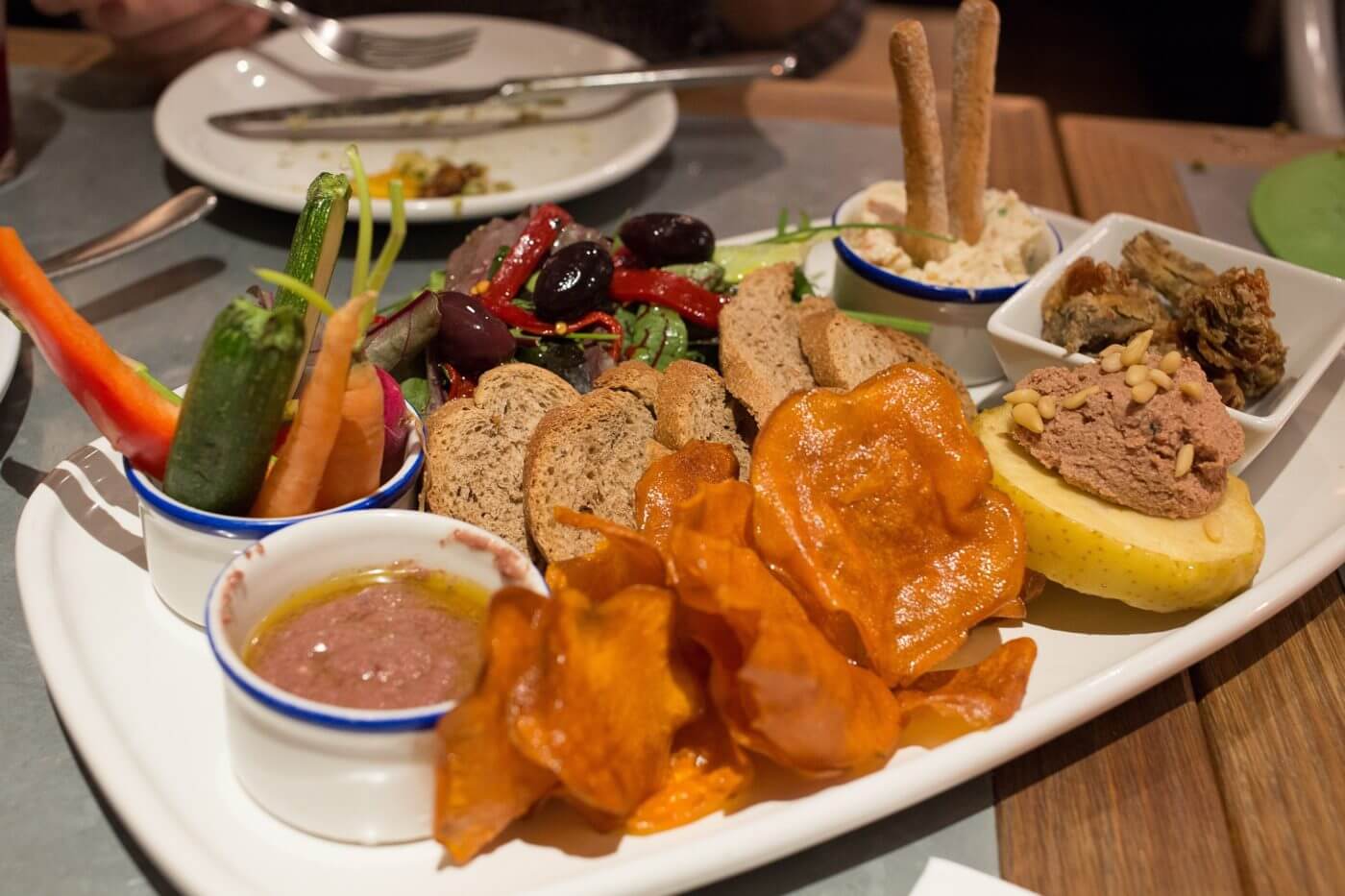
In Spain, alcohol is often consumed with each meal – whether it’s a breakfast coffee and brandy, a glass of “tinto de verano” (literally “summer red wine” made with red wine and lemonade), or some “rebujito” (white sangria).
Whilst such customs are something that health conscious travelers will want to be aware of, it is generally agreed that alcohol can be part of a healthy diet when consumed in moderation.
—> Read More: Journey Through the South of Spain: Top Things To Do In Andalusia
Spanish eating customs and habits
For Spaniards, a large part of eating is about spending time with loved ones and sharing delicious food. They tend to snack or graze, rather than sit down to eat a large meal.
This is why tapas is popular and widely available – people can order a variety of small dishes of a bar or restaurant’s specialties to share with friends and family over good conversation (the custom of chatting after a meal is called “sobremesa”, which literally means “over-table or after-table”).
Perhaps the most significant Spanish custom you might need to be aware of is the siesta – two hours in the middle of the day when some workers go home to rest and eat lunch with their families.
This usually takes place between about 2pm and 4pm, during which time most shops and eateries will be closed, although this is more often observed in rural Spain than cities these days.
Tip: Lunch is also the biggest meal of the day, with most Spaniards just having an evening snack, so travelers might want to plan ahead to make sure they have lunch before the shops close.
Note: In recent years, there have been changes to the law and calls to end the custom, or at least reduce the length of the official working day, which might in some sectors bring an end to the two-hour lunch.
Food and drink events or festivals
Spain hosts a variety of food festivals each year, many of which are usually based around the harvest of a particular crop.
For example, there is the Saffron Rose Festival in La Mancha, where stigmas of saffron are collected from fields of crocus flowers, and travelers can try local foods and enjoy traditional Spanish dances and parades.

Tip: These events can be a great opportunity to taste local dishes, learn more about their ingredients, and really experience Spanish cuisine at its best.
Spanish cooking styles and ingredients
Most Spanish food is simple in style, which highlights the freshness and flavor of the produce. It is common to cook with olive oil, rather than using butter. Olive oil is sometimes served raw for dipping bread or drizzling over salads.
The Guidester Difference: If you’re a “foodie”, consider taking a cooking class while in Spain. Your personal travel guide will provide information on it and direct access to book – all in one place.
You can expect to eat a lot of salads containing ingredients like olives, Manchego cheese, beans, lentils and peas – ingredients often cited as being healthy food options – as well as other healthy dishes such as stews and paellas.
Depending on their specific food preferences, travelers may find that the Spanish diet is fresher, and lower in fat and calories when compared to the diet prevalent in their home country.
However, Western-style dishes and fast food is common in some of the coastal resorts and tourist areas.
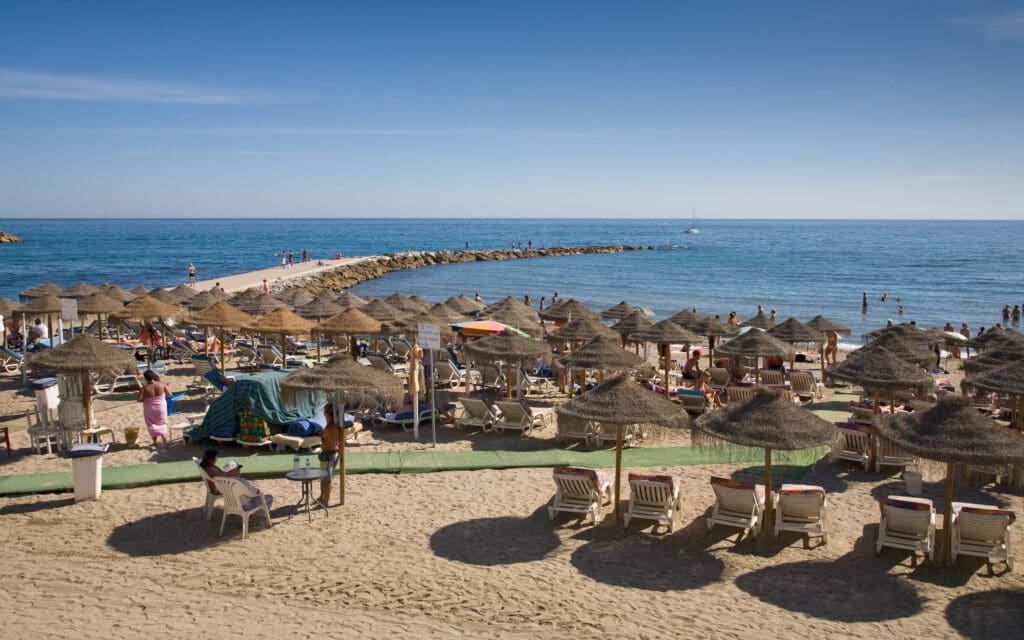
Planning a Trip to Spain?
We can help create your perfect itinerary!
- Worried you'll miss the hidden gems?
- How long should you stay in each place?
- Should you rent a car, train it, or both?
Practical considerations of eating and drinking
The main aspect of Spanish cuisine that may initially confuse travelers is meal times.
Lunch is usually eaten between 2pm and 4pm, and dinner between 9pm and 11pm, which is significantly later than people would generally eat in countries such as the UK and US.
Tip: Some travelers may find that it takes a while to get used to restaurant opening and closing times. This can cause problems if you do not plan in advance, particular for those with young families or people who suffer from low blood sugar and health conditions such as diabetes.
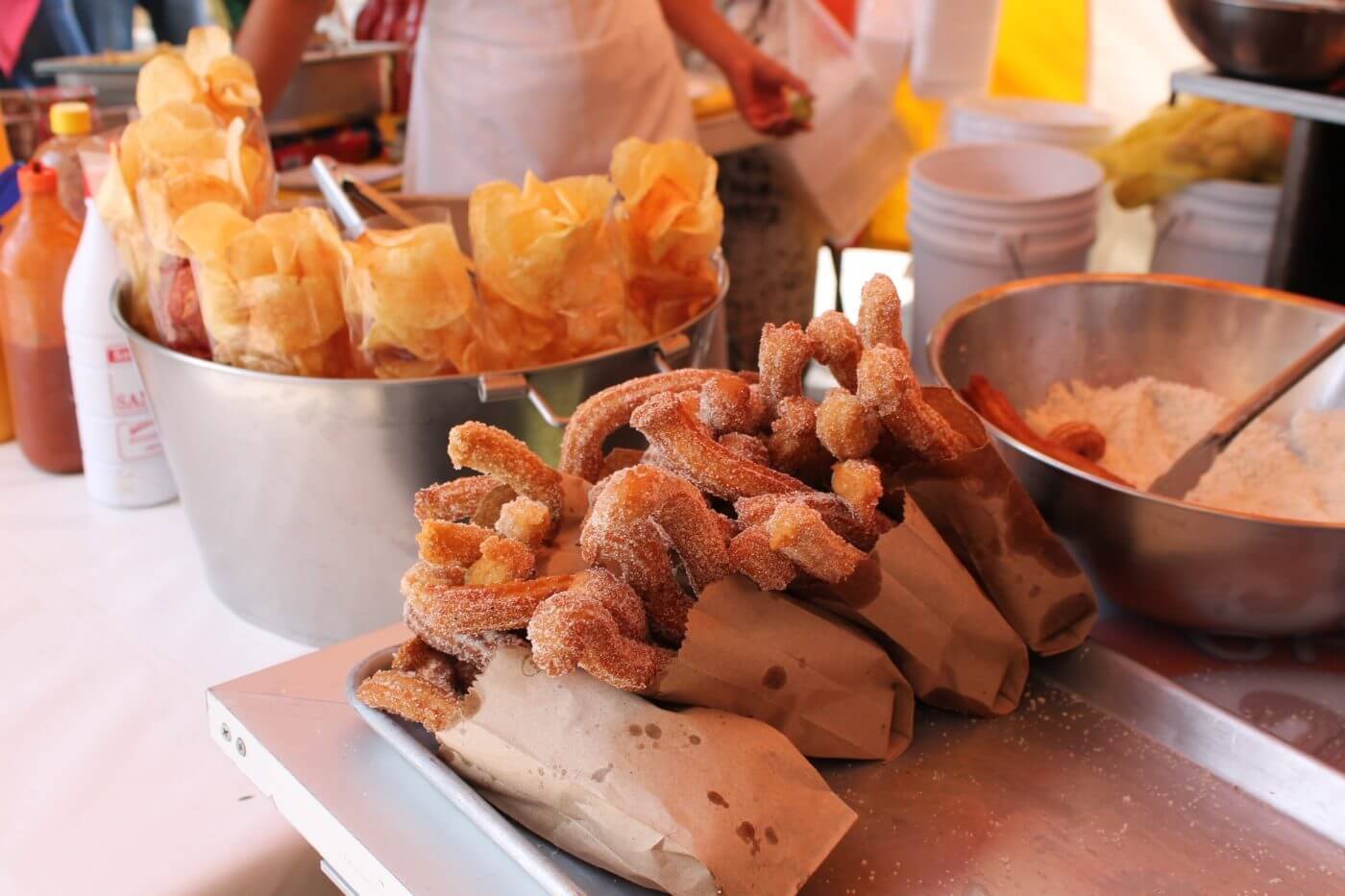
Common issues travelers face with food and drink
In many parts of Spain, locals may not speak English, making it difficult for travelers to order and buy food and drink without a basic command of the language.
It is also worth remembering that in cities like Barcelona – which is in Catalonia, northeast Spain – Catalan is the primary spoken language (as opposed to Castilian Spanish spoken in Madrid).
Spanish is also widely spoken, but it is often considered polite in the region to learn a few Catalan words to start a conversation before speaking in English or Spanish.
Tip: Travelers who do not speak Spanish may need to rely on a Spanish-speaking friend (or a translation book or app) to help them to read menus and food packets, and order in restaurants.
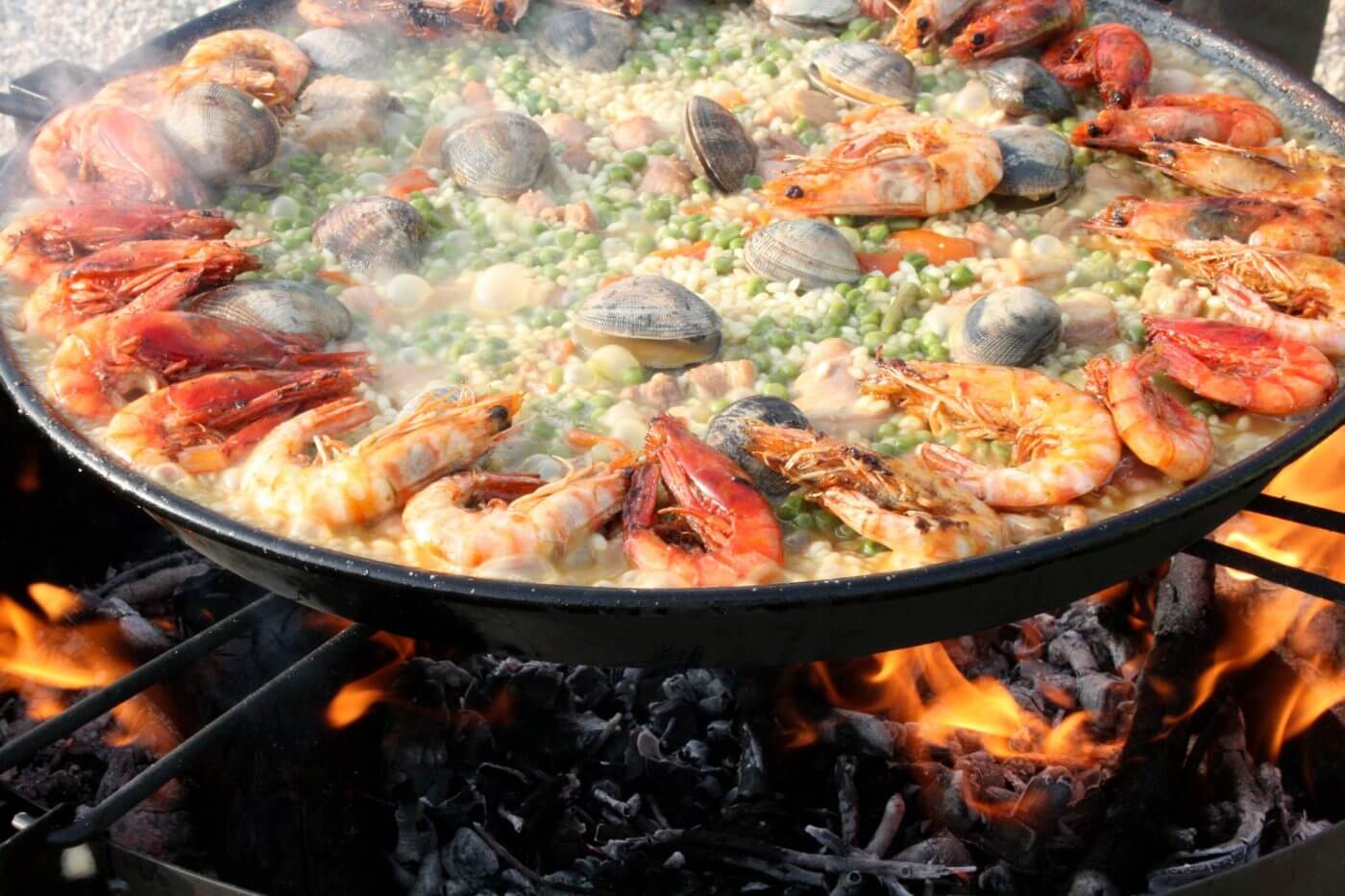
Food and drink for travelers with health conditions
A lot of Spanish food contains nuts, dairy and shellfish, so travelers with food allergies and intolerance may want to carry translation cards, learn some Spanish, or travel with a Spanish-speaking friend who can communicate this on their behalf.
Travelers should find it easy to maintain a healthy and balanced diet in Spain. In many parts of the country, the dishes are prepared using fresh and healthy ingredients. In general, this can lead to a delicious diet that is lower in fat and calories than many Western dishes.
However, you may be sometimes caught out at lunchtime when some stores and restaurants close for a siesta. It can also be very useful to learn some basic Spanish (or Catalan) before traveling to Spain, to help integrate and explore new dishes with confidence and make the most of the local cuisine.
The Ultimate Pre-Travel Checklist
Download ‘ 10 Crucial Things To Do Before Traveling Abroad’ to avoid mistakes and ensure a smooth trip; adapters and electronics, packing tips, foreign currency, phone plans, and more!

Each trip is a unique experience. Guidester personalizes your adventure, guiding you to those breathtaking sites, authentic local eateries, and hidden gems!
Recent Articles

Discover the Best Places to Visit in Romania

Exploring Bruges: A Journey Through Time and Beauty

European Delights: 10 Must-Try European Dishes

Best Wild Swimming Beaches in Europe

7 Best Places To Visit In Normandy: From D-Day Beaches to Coastal Towns

Best Castle Hotels in Europe

Travel tips and unforgettable adventures with Travelin Jack
Popular Posts

There are many places you must see when visiting Italy, but your personal interests, timeframe, and budget will dictate how

While it is normally easy to acquire or renew a passport, the State Department says there’s about to be a

With beauty around every corner, deciding on places to visit in Ireland can prove difficult. In my opinion, it’s all
Recent Posts
Leave a comment cancel reply.
Your email address will not be published. Required fields are marked *
Where to eat and drink in Spain

Oct 16, 2022 • 7 min read

In Spain, food is not just nourishment it's an experience © Hillary Fox / Stocksy United
Bountiful seafood and rich produce from the interior of Spain combine to create one of the world’s great cuisines. Inventive chefs and a wealth of regional variety add to the allure, all of which make eating here a memorable part of the Spanish travel experience.
Meals come in many varieties, from bite-sized morsels of perfection at a tapas or pintxos bar to multi-course feasts overlooking the seaside. You’ll also find great wines, sprawling food markets and plenty of unique snacks to tide you over between the big meals. The convivial atmosphere also plays a role: Spaniards love to dine out, and it’s impossible not to feel the buzz when delving into the country’s gloriously diverse dining scene.
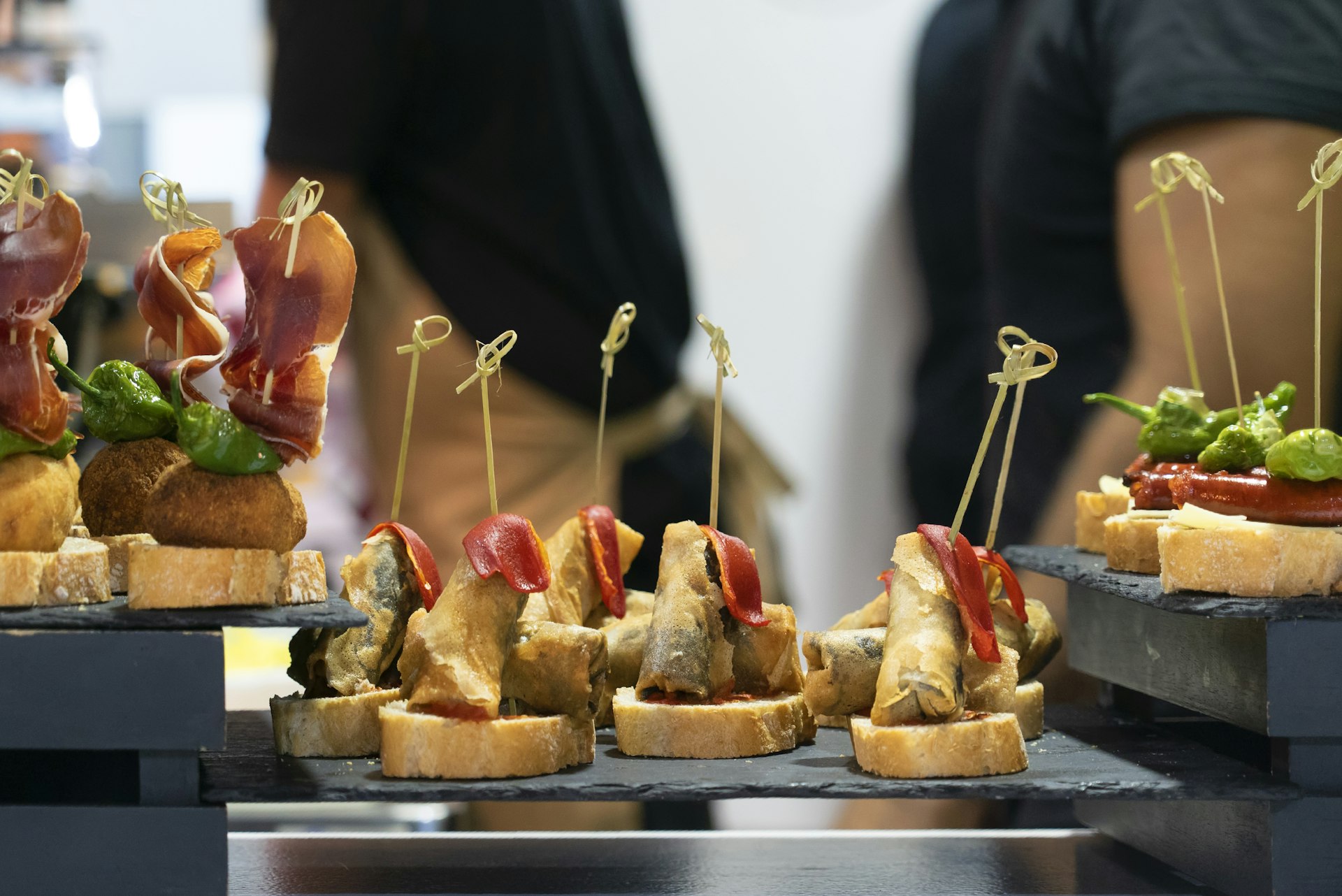
Go on a tapas (or pintxos ) tasting
One of the world's most enjoyable dining experiences, eating tapas – small snack plates – is a way of life in Spain. For the uninitiated, these bite-sized snacks are typically delivered in waves, often in noisy bars, where they are washed down with glasses of local vino in marathon sessions that can last for hours.
The dishes served as tapas vary widely depending on where you are in the country. In the white villages and historic towns of Andalucía , expect the best jamón (ham) and fine Spanish olives – Moorish-influenced Granada is famed for its pinchos morunos (spiced pork skewers) and montaditos (stacked open sandwiches secured with a toothpick).
In San Sebastián and elsewhere in the Basque Country, the most popular small bites are pintxos , named for the "spike" that often holds them together. Here, the snack is elevated to high culinary art, with treats such as txuleta (aged beef steak), txangurro (spider crab) tartlets and wild mushroom croquettes with Idiazabal cheese.
Where to try it: In Madrid, you can munch on a wide range of delicacies all in one compact area at the historic Mercado de San Miguel . A chalkboard menu showcases changing daily dishes (like slow-roasted duck or terrines of foie gras) at San Sebastián’s Bar Borda Berri .
Sip a glass of Rioja in Spain's wine-making heartland
La Rioja is the sort of place where you can spend weeks meandering along quiet country roads and ducking into small vineyards in search of the finest drop. The mainstays for oenophiles in this region are small bodegas (wine cellars) offering wine tastings and picturesque villages with excellent wine museums and wine-centric festivals.
Where to try it: At the Frank Gehry-designed Hotel Marqués de Riscal , you can take a tour of the famous winery, then sip outstanding reds in the tasting room afterward. There are great wine bars all over the region. Sample excellent Riojas (and munch on tapas) at La Tavina in Logroño.
Have a seafood feast on the coast
Seafood is a consistent presence along both the Atlantic and Mediterranean coasts. You’ll find a wide range of specialties, which vary from region to region. The region of Galicia has some of Spain’s best seafood, particularly when it comes to pulpo (octopus). The star is pulpo á feira (spicy boiled octopus). You'll see it branded as pulpo a la gallega or pulpo gallego in other parts of Spain. The constituent elements (octopus, oil, paprika and garlic) are simple but the execution is devilishly difficult.
Further south, Andalucia has a dizzying variety of fresh fish and shellfish, with snack food favorites like pescaíto frito (fried fish) and regional treats such as Bay of Cádiz shrimp and baby squid. A particular specialty of Cádiz , Andalucian-style "fried fish" can be prepared with just about anything that emerges from the sea, rolled in chickpea and wheat flour, then deep-fried ever so briefly in olive oil, just long enough to form a light, golden crust that seals the essential goodness of the fish or seafood within.
Where to try it: Near the seaside in the Costa Brava town of Calella de Palafrugell, the much-loved La Blava serves Mediterranean seafood with Catalan accents. In Malaga, La Pelegrina Centro specializes in small plates so you can try a wide range of seafood delicacies.
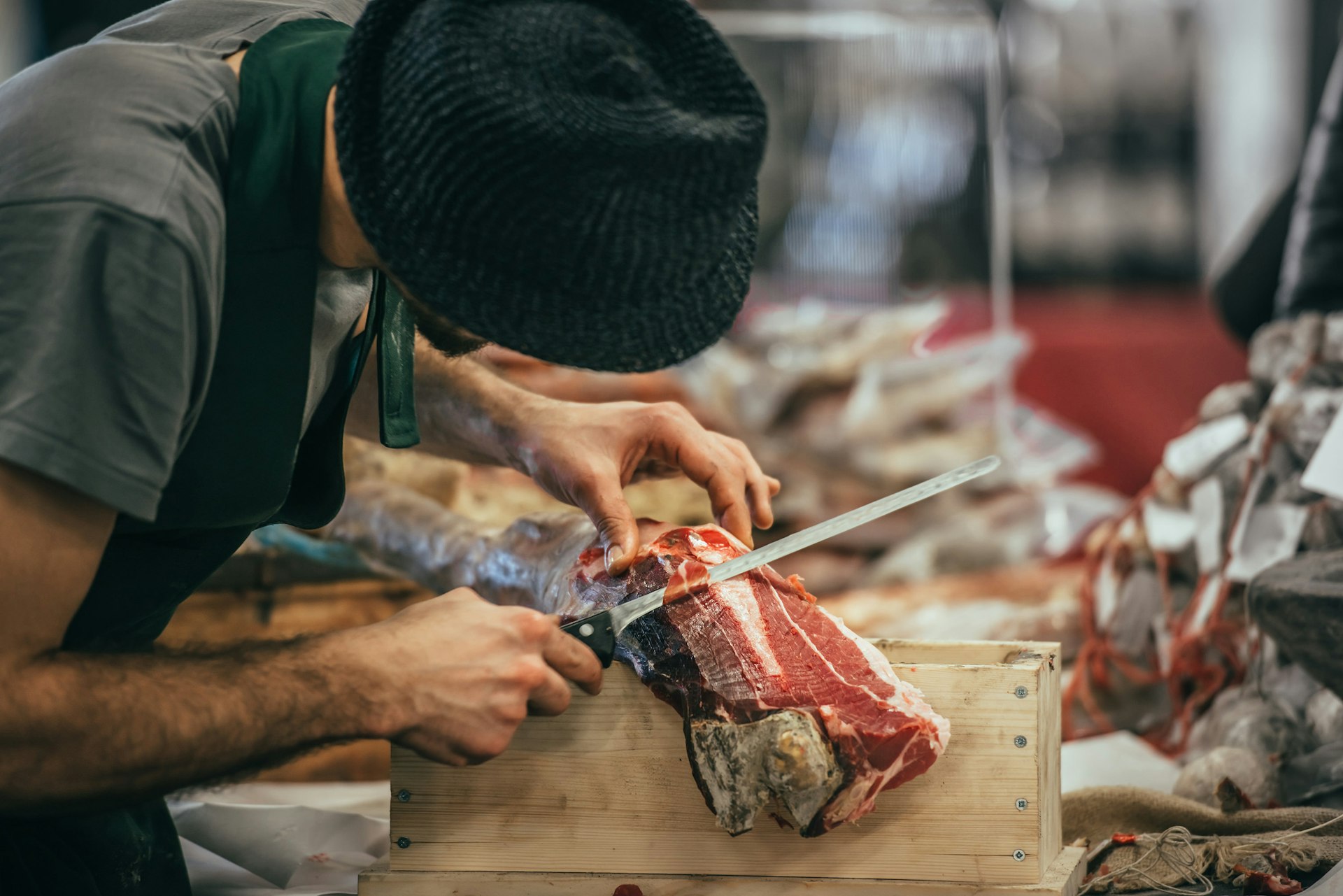
Bite into a tender serving of jamón
There's no more iconic presence on the Spanish table than cured ham from the high plateau – the sight of jamónes hanging from the ceiling of a local deli is one of Spain's most enduring images. Unlike Italian prosciutto, Spanish jamón is a bold, deep red and well-marbled with buttery fat. At its best, it smells like meat, the forest and the field.
The best-quality jamón is most commonly eaten as a starter or a ración (large tapa ). On menus, it's usually called a tabla de jamón ibérico (or ibérico de bellota ). Spaniards almost always eat it with bread, and it goes amazingly well with Spanish cheeses such as manchego .
Where to try it: You can find quality jamón all over the country, with specialty purveyors like Claudio: La Feria del Jamón Bar in Bilbao and Alma de Julián Becerro in Madrid serving rich, wafer-thin slices.
Enjoy an anytime snack of tortilla de patatas
Great for vegetarians and carnivores alike, the tortilla de patatas (often called simply " tortilla ") is a Spanish egg-and-potato omelet that’s especially good when the eggs are still creamy. You'll often find tortilla served as an in-between-meals snack or offered up at room temperature as a tapas dish although it can be a meal in itself.
Where to try it: This Spanish staple crops up almost everywhere, but it was first recorded in the region of Navarra , which is still a fine place to sample it. Bar La Navarra in Pamplona serves a creamy, rich tortilla that embodies perfection.
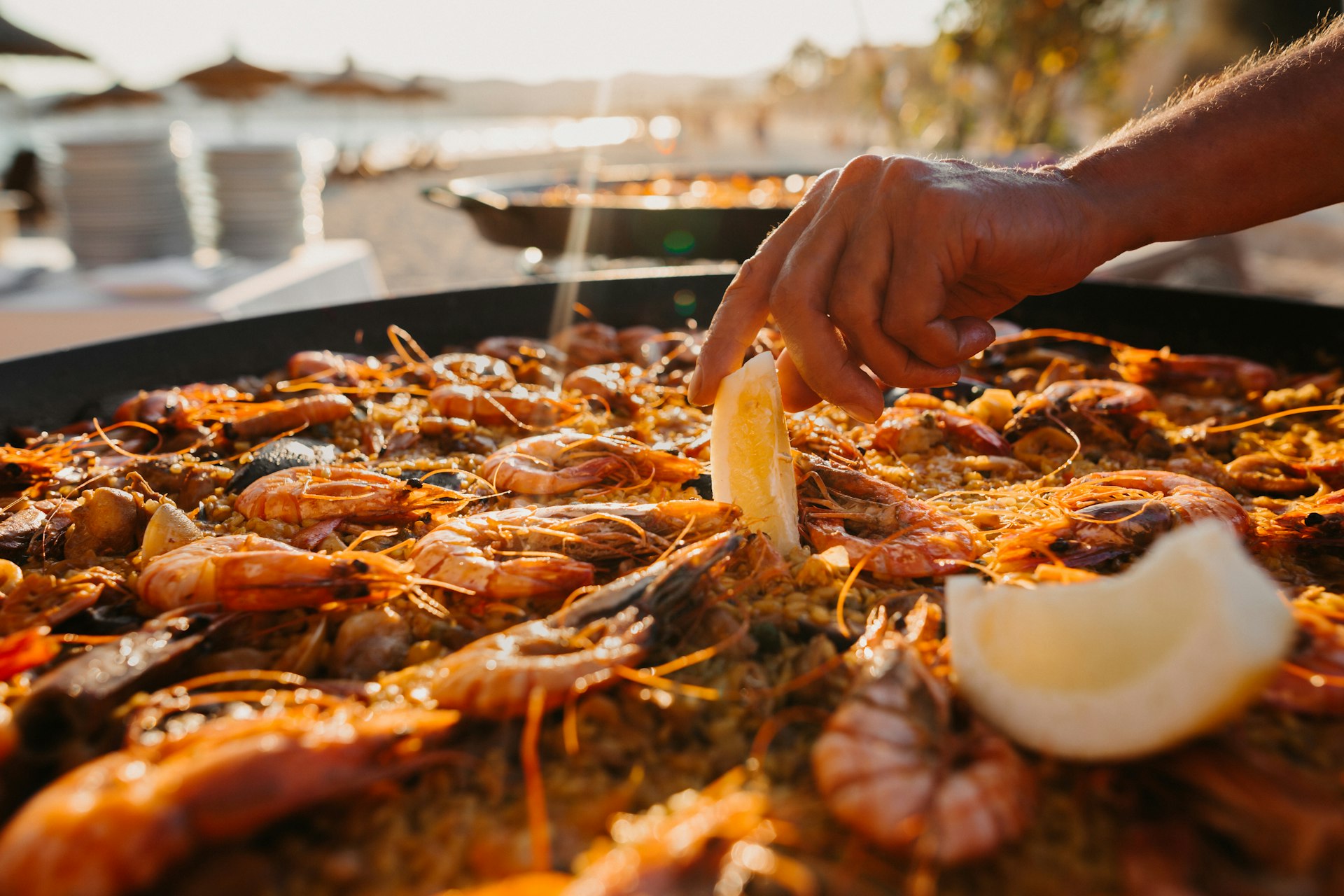
Linger over a decadent paella
There's something life-affirming about a proper Spanish paella , warmly yellow like the sun and bursting with intriguing morsels. An inspired combination of vegetables, meat (or seafood), rice and saffron, cooked with stock in a single pan, paella is full of the promise of warm days and good company. It’s also one of the best-loved dishes of traditional Spanish cuisine.
Where to try it: Track down an authentic paella a la valenciana (cooked with beans, chicken and rabbit) in Valencia restaurants like the long-running Navarro .
Treat yourself to chocolate con churros
These deep-fried doughnut strips dipped in thick hot chocolate are a Spanish favorite for breakfast, afternoon tea or at dawn on your way home from a night out. They're rich, sinfully filling and dusted in cinnamon sugar, so don't go overboard!
Where to try it: Madrid's Chocolatería de San Ginés is the most famous purveyor; open 24 hours, it's a popular spot at the end of a big night out in the capital. Barcelona’s Gothic quarter has a narrow lane (Carrer de Petritxol) that’s famous for its chocolate shops, including Granja La Pallaresa .
Vegans and vegetarians
Some Spaniards, especially the older generation, don't really understand vegetarianism or veganism: some would even include ham in cooked vegetable dishes. However, things are changing, with a growing number of vegetarian restaurants popping up in less urban places in addition to the many earth-friendly plant-based establishments in places like Madrid and Barcelona.
Menu items to seek out in traditional settings include verduras a la plancha (grilled vegetables); garbanzos con espinacas (chickpeas and spinach); and potato dishes, such as patatas bravas (potato chunks bathed in a slightly spicy tomato sauce) and tortilla de patatas (egg, potato and onion omelette).
The prevalence of legumes ensures that lentejas (lentils) and judías (beans) are also easy to track down, while pan (bread), quesos (cheeses), alcachofas (artichokes) and aceitunas (olives) are always easy to find. Tascas (tapas bars) usually offer more vegetarian choices than sit-down restaurants.
Where to try it: You can indulge in a changing selection of plant-based Andalucían tapas at Vegan Rock in Seville. Barcelona has a wealth of plant-based restaurants including the top-notch Sésamo in El Raval.
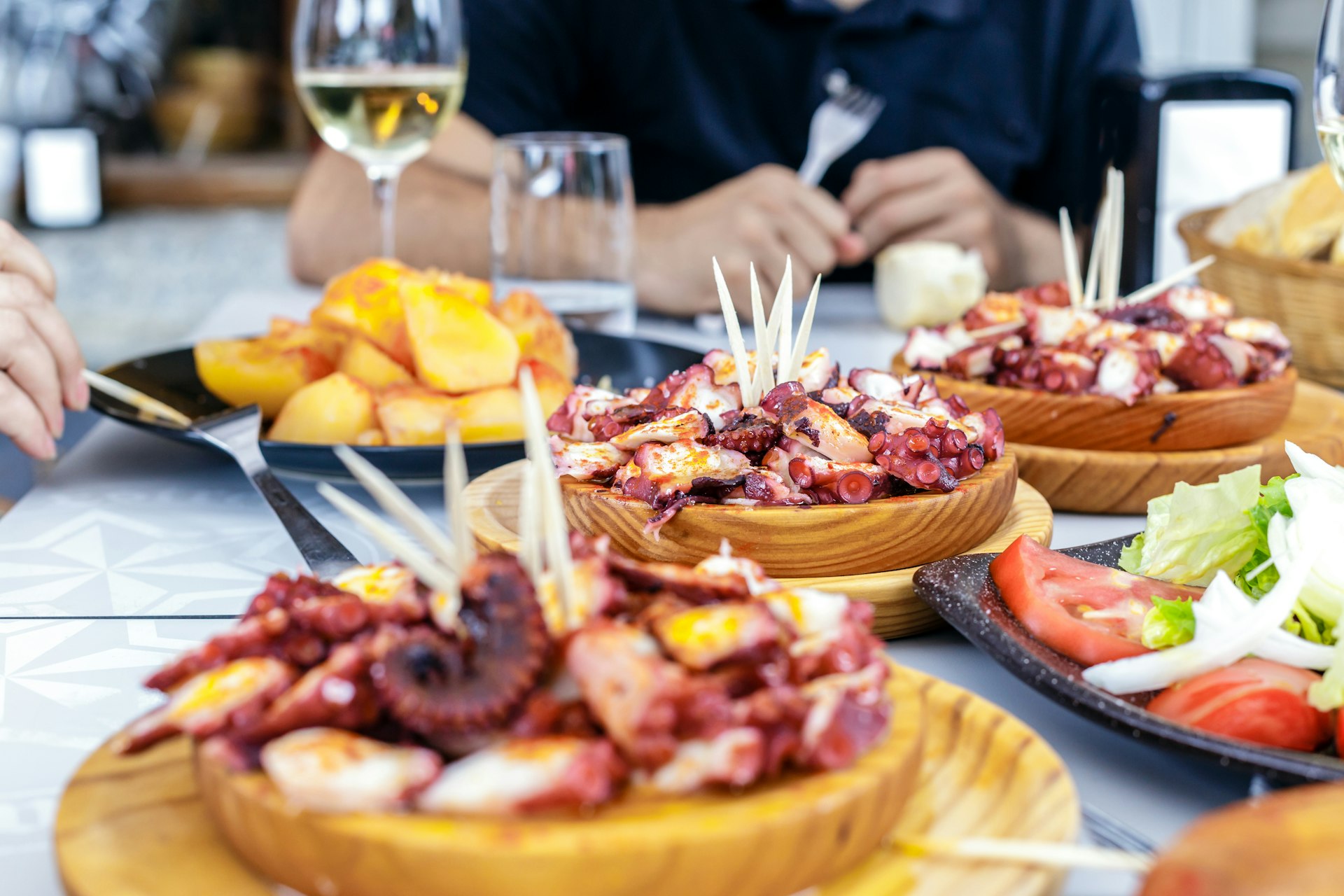
A year in food
Countless food festivals and a year-round growing season ensure there’s never a bad time to visit Spain when it comes to finding a memorable meal. Some dishes, however, are available at only certain times of the year.
November to February
Across inland Spain, winter is the time for fortifying stews (such as cocido or fabada ) and roasted meats, especially cochinillo (suckling pig) and cordero (spring lamb). Catalans salivate over calçots , those large spring onions that are eaten with your hands and a bib, and romesco (a rich sauce of red peppers and ground almond).
March to May
Springtime brings delicacies associated with Easter, such as torrijas (sweet fried bread). This is also the prime season for asparagus (green and white) and atún (tuna).
June to August
The cold soups gazpacho and salmorejo , both specialties of Andalucía, only appear in summer. Rice dishes by the Mediterranean are another key ingredient of the Spanish summer.
September to November
La Rioja's grape harvest gets underway in September. It’s well worth planning your trip around Logroño's lively Fiesta de San Mateo.
This article was first published Oct 18, 2020 and updated Oct 16, 2022.
Explore related stories

Nov 14, 2022 • 10 min read
With its cliffs, waves, landscapes, and recipes, northern Spain is a gorgeously green gem overlooked by many travelers
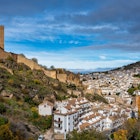
Apr 19, 2021 • 7 min read
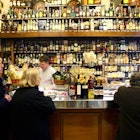
Nov 10, 2020 • 2 min read

Sep 24, 2020 • 6 min read

Jul 24, 2020 • 2 min read

Jan 23, 2020 • 5 min read

May 3, 2024 • 6 min read

Mar 22, 2024 • 5 min read
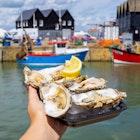
Mar 2, 2024 • 7 min read

Mar 1, 2024 • 12 min read

Spanish Food – 61 Tasty Dishes To Try

Spanish food takes you on a journey to a special place full of delightful flavours, colours, and textures that are as diverse as the amazing regions they originate from.
From the bustling streets of Barcelona to the sun-soaked coasts of Andalusia , and the rustic heartlands of Castilla y Leon , Spanish food is as captivating as its history.
Spanning from iconic tapas to hearty stews, fresh seafood to sizzling grilled meats, and sweet delights to fine wines, Spanish cuisine is a true celebration of the senses.
Each dish has often been influenced by centuries of tradition.
Whether you're a seasoned foodie or a curious traveller, this compilation is a gateway to discovering the spectrum of flavours that make Spain's culinary scene a world-renowned treasure.
So, prepare to embark on a delectable journey, one bite at a time, through the many tempting tastes of Spanish food.
Without further ado, here is our list of the top 61 delicious Spanish dishes that you should try.
1. Jamon Iberico

Jamon Iberico, or the coveted "pata negra" cured ham is a masterpiece born from the ancient traditions of the Iberian Peninsula and the undisputed king of Spanish food offerings.
Picture thin, velvety slices of delicious cured ham that practically melt on your tongue, releasing an explosion of flavours that range from nutty to buttery.
The marbled texture, thanks to acorn-fed Iberian pigs, imparts an unrivalled richness that lingers long after each bite.
2. Paella Valenciana
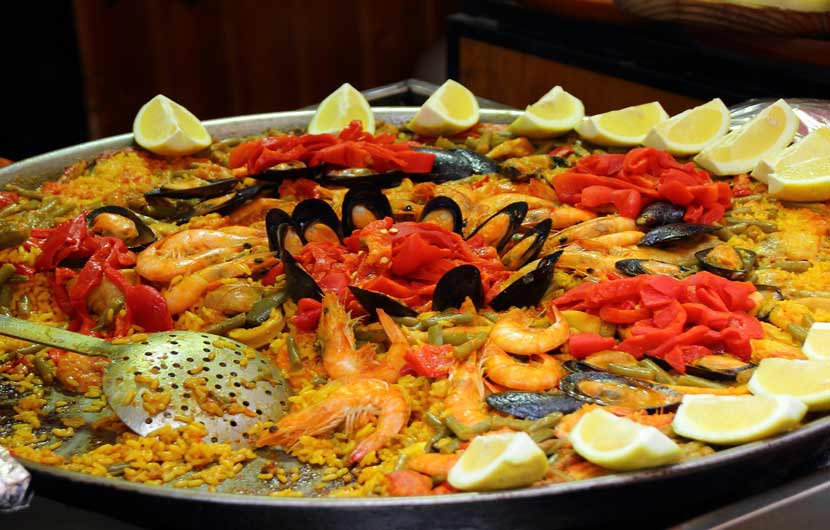
The iconic Paella Valenciana is probably one of the best-known Spanish foods known around the world.
This classic dish originates from the Valencia Region of Eastern Spain and is made of succulent chicken, tender rabbit, fresh vegetables, Spanish Paprika ( Pimenton ) and the finest Bomba short grain rice.
But what really steals the show is the saffron-infused rice, soaking up all the savoury goodness from the broth.
3. Pescaito Frito

Pescaito Frito is a Spanish fried fish sensation!
Fresh fish fillets are coated in a delicate batter and plunged into sizzling hot oil, creating a golden and crunchy exterior that's simply irresistible.
With every bite, you're met with a burst of flavours that transports you to the sunny shores of Southern Spain.
Squeeze a bit of lemon for that zesty kick, and you've got a perfect match made in culinary heaven.
Pescaito Frito is the ultimate beach bar snack food and one of the all-time most popular dishes from the Andalucia region of Spain.
4. Gambas al Ajillo

Gambas al Ajillo is another popular Spanish food dish that's a must-try for seafood lovers!
Juicy plump prawns are sizzled in a heavenly blend of extra virgin olive oil, garlic, and a sprinkle of hot paprika ( pimenton picante ) and chilli flakes for an extra touch of heat.
With each succulent bite, the prawns absorb the rich garlic essence, creating a symphony of taste that dances on your palate.
Pair this dish with a slice of fresh crusty bread to soak up every drop of the savoury sauce.
5. Tortilla Española

Tortilla Española is the iconic Spanish omelette and a staple Spanish food in every household in Spain.
This simple yet delectable dish is a delightful marriage of tender potatoes and eggs, creating a tasty blend of flavours and textures.
Served hot or cold, each slice unveils a golden, satisfying delight. Whether enjoyed as a tapa or as part of a main meal, its clever simplicity speaks volumes.
With just a few humble ingredients, Tortilla Española captures the essence of Spanish cuisine – rustic, comforting, and utterly delicious.
6. Gazpacho

Gazpacho is the Spanish food answer to refreshing soups. This delicious tomato-based soup is blended with peppers, cucumbers, onions, and a good amount of garlic.
A splash of extra virgin olive oil and vinegar elevates its tangy goodness.
Served ice-cold. Gazpacho is the ultimate cool companion on scorching days.
7. Patatas Bravas

Patatas Bravas are deep-fried golden potato chunks drizzled with a hot tomato-based sauce, it's got just the right kick of spice.
Whether you're out with amigos at your local tapas bar or simply craving a solo snack, Patatas Bravas is a favourite among locals and visitors to Spain.

Churros are a true Spanish comfort food captivates taste buds around the world.
These golden-brown, crispy treats are created from a choux dough mixture of flour, water, and salt, piped into hot oil in long, star-shaped forms before being fried to perfection.
Churros are particularly popular in Andalusia where they are mostly eaten for breakfast.
Served piping hot, dusted with sugar, and often accompanied by a rich chocolate sauce for dipping, churros offer a delectable combination of crunchy exteriors and soft interiors.
9. Albondigas

Albondigas, is a classic Spanish dish of savoury balls of meat that have captured the hearts of foodies worldwide.
Made by combining minced meat (usually a mix of beef and pork) with breadcrumbs, eggs, garlic, herbs, and spices, these tasty meatball bites are gently simmered in a rich tomato-based sauce.
With origins dating back centuries, Albondigas has evolved into a beloved comfort food found across Spain and beyond.
10. Croquetas

Croquetas are small, crispy bites consisting of a creamy mixture typically made from ingredients like cooked ham, chicken, or cod, blended with a thick bechamel sauce and seasoned.
The mixture is then shaped, coated in breadcrumbs, and deep-fried until golden brown.
Hailing from various regions across Spain, croquetas have become a staple in Spanish cuisine , popular as tapas.
11. Pulpo a La Gallega

Pulpo a la Gallega, or Galician-style octopus, is a mouthwatering Spanish dish known for its simple yet delightful flavours.
Originating from the Galicia region in northwestern Spain , this dish features tender octopus slices seasoned with paprika, olive oil, and coarse salt.
The octopus is traditionally boiled until tender, then sliced and drizzled with olive oil and sprinkled with paprika.
Served on a wooden plate, Pulpo a la Gallega captures the essence of Galician coastal cuisine, highlighting the ocean's bounty with its tender, flavourful octopus and rustic seasonings.

Migas, a beloved Spanish dish, is a rustic creation that transforms humble ingredients into a simple but tasty dish.
Originating from the Extremadura and Castilla-La Mancha regions , this dish repurposes day-old bread into a hearty meal.
The bread is crumbled and sauteed with ingredients like garlic, chorizo, bacon, and olive oil.
The result is a satisfying medley of flavours and textures, often accompanied by grapes, melon, or fried eggs.
With its origins rooted in rural traditions, migas showcase the resourcefulness of Spanish cuisine, turning basic staples into a delightful culinary experience that embodies the spirit of the countryside community.
13. Bacalao a la Riojana

Bacalao a la Riojana, a renowned Spanish dish, showcases the rich flavours of the La Rioja region .
This traditional recipe features cod fish prepared in a hearty stew with a tomato-based sauce, red peppers, onions, and spicy chorizo sausage.
Originating in the northern part of Spain, Bacalao a la Riojana reflects the area's agricultural heritage and skilful use of local ingredients, creating a delightful blend of tastes that represent the essence of this picturesque region.

Callos, a Spanish delicacy, is a hearty stew known for its unique combination of flavours and textures.
This dish primarily consists of tripe, chorizo sausage, and morcilla (blood sausage), simmered with a medley of vegetables and aromatic spices.
Hailing from the Castilla y Leon region , Callos is particularly popular in Madrid .
This savoury dish is a testament to the rich gastronomic history of Spain and its ability to transform simple ingredients into a culinary masterpiece.
15. Tarta de Santiago

Tarta de Santiago is a renowned Spanish dessert, a delectable almond cake hailing from the Galicia region in northwest Spain .
The cake features a moist almond base, typically adorned with the iconic cross of St. James powdered with sugar.
It originated in the medieval town of Santiago de Compostela , a significant pilgrimage site for centuries.
The cake's main ingredients include ground almonds, eggs, sugar, and lemon zest.
Tarta de Santiago pays homage to Galicia's rich culinary heritage and is a sweet symbol of the region's history and traditions.
16. Manchego Cheese

Manchego Cheese is a beloved Spanish delicacy hailing from the La Mancha region , known for its vast plains and iconic windmills.
Crafted from the milk of Manchega sheep, this cheese boasts a distinct crisscross pattern on its rind, reflecting the moulds used during production.
Its taste varies, with young Manchego offering a mild, nutty flavour, while aged varieties develop deeper complexities and sharpness.
With a rich history dating back to ancient times, Manchego Cheese is a culinary gem often enjoyed alongside quince paste and quality red wine.
17. Pimientos de Padron

Pimientos de Padron are small green peppers known for their surprise factor.
Popular in Galicia , these peppers are typically mild in flavour, but every now and then, you'll encounter a spicy one that adds a playful twist to the dish.
They're often fried until blistered and sprinkled with sea salt, making them a delicious tapa.
Originating in the town of Padron in Galicia, these peppers have become a beloved tradition in Spanish cuisine.

Tapas hold a very special place within the Spanish culinary tradition.
Consisting of small, flavourful dishes that are perfect for sharing with friends at the local tapas bar.
Originating in the Andalusian region of Spain, These bite-sized delights can range from simple olives and cheese to more elaborate dishes like patatas bravas, croquetas, and grilled seafood.
The social ritual of enjoying tapas with friends and family is common across Spain, where bars and restaurants offer an array of these delectable creations.
19. Salmorejo

Salmorejo is a creamy and refreshing cold soup originating from the Andalusian region of Spain.
A close relative of gazpacho, it's a blend of tomatoes, bread, olive oil, garlic, and vinegar, resulting in a rich and velvety texture.
Hailing from the city of Cordoba , salmorejo is a popular dish during the hot summer months.
It's often garnished with hard-boiled eggs and jamon serrano.
20. Arroz Con Leche

Arroz con Leche is a classic Spanish dessert beloved for its comforting simplicity.
Hailing from the northern regions like Asturias and Galicia, this dish translates to "rice with milk."
The dessert features rice cooked in milk, infused with aromatic cinnamon and lemon zest. It's sweetened with sugar and simmered until the rice becomes tender and creamy.
Popular throughout Spain, Arroz con Leche reflects the country's penchant for turning humble ingredients into indulgent treats.
21. Pintxos

Pintxos are a culinary delight originating from the Basque Country in northern Spain .
These bite-sized delights are similar to tapas but uniquely served on small pieces of bread, often held together with a toothpick or skewer.
Popular toppings range from cured ham and cheese to seafood, olives, and even marinated vegetables.
Pintxos are an integral part of Basque culture, often enjoyed as a social activity at bars and taverns.
Their varied and creative combinations make them a highlight of Spanish cuisine, enticing locals and visitors alike to explore the vibrant flavours of the region.
22. Magdalenas

Magdalenas are traditional Spanish muffin-like cakes, known for their fluffy texture and slightly sweet flavour.
They are a beloved treat often enjoyed for breakfast or as a snack with coffee or tea.
Made from simple ingredients like flour, sugar, eggs, and baking powder, these cakes are typically baked in distinctive scallop-shaped molds.
Magdalenas are popular throughout Spain, but they have a strong association with the region of Asturias.
These delightful pastries hold a special place in Spanish households, offering a taste of comfort and nostalgia.
23. Rabo de Toro

Rabo de Toro, or "Bull's Tail," is a hearty Spanish dish renowned for its rich and tender meaty sauce.
Originating in Andalusia, particularly in the city of Cordoba, this dish utilises oxtail slow-cooked to perfection.
The meat is marinated with wine, herbs, and spices, then braised until it becomes incredibly tender then served with a rich sauce made from its own cooking juices, vegetables, and wine.
This dish is a speciality found in many traditional Andalusian restaurants, showcasing the region's love for robust and comforting flavours.

Fideua is a delightful Spanish dish that shares similarities with paella but uses short, thin pasta instead of rice.
Originating in the coastal region of Valencia , it has become a beloved staple of Spanish cuisine.
Cooked in a similar style to paella, Fideua features a variety of ingredients such as seafood, meats, and vegetables, all simmered together in a tasty broth infused with saffron and paprika.
The pasta soaks up the delicious juices, creating a delightful mix of tastes and textures.

Pisto is a traditional Spanish dish known for its simplicity and rich flavours.
Originating in the region of Castilla La Mancha , it is now eaten throughout Spain.
Pisto is essentially a vegetable stew made from sauteed tomatoes, bell peppers, onions, and courgettes, all simmered together to create a harmonious blend of flavours.
Often enjoyed as a main course or side dish, it can be customised with ingredients like eggs, ham, or chorizo.
26. Gambas a la Plancha

Gambas a la Plancha, meaning "grilled prawns" in Spanish, is a mouthwatering seafood dish celebrated for its simplicity and natural flavours.
Originating in coastal regions like Andalusia, it's a popular choice in Spain's culinary scene.
Fresh prawns are grilled on a hot iron plate or griddle often drizzled with olive oil and seasoned lightly with salt. This preparation method ensures the shrimp's succulent texture is preserved, allowing their natural sweetness to shine through.
27. Crema Catalana

Crema Catalana is a popular Spanish dessert hailing from Catalonia , particularly associated with Barcelona.
Resembling creme brulee, it's a creamy custard dessert infused with lemon or cinnamon zest and vanilla.
The key distinction lies in the caramelised sugar topping, traditionally achieved by using a red-hot iron rod.
The result is a delightful contrast between the silky custard and the crisp layer of burnt sugar.
With its origins tracing back to the 18th century, Crema Catalana is a beloved treat served during festivals like Saint Joseph's Day, celebrating the culinary heritage of Catalonia.
28. Pan Con Tomate

Pan con Tomate, or Bread with tomato, is a simple yet incredibly tasty Spanish dish.
Originating from Catalonia, it has become a staple throughout Spain. It consists of toasted bread rubbed with ripe tomatoes, garlic, olive oil, and a pinch of salt.
The result is a harmonious blend of textures and flavours – the crispy bread with the juicy tomatoes and the aromatic garlic.
Often enjoyed as a tapa, Pan con Tomate is often served with Jamon Serrano.
29. Bocadillos

Bocadillos are a quintessential Spanish sandwich, loved for their convenience and diverse fillings.
These sandwiches are typically made by placing various ingredients between a crusty baguette or bread roll.
The fillings can range from cured ham, cheese, chorizo, tortilla, or any combination of savoury delights.
Popular across Spain, bocadillos are enjoyed as a quick snack, lunch, or even as a light dinner.
Bocadillos embody the essence of Spanish street food culture, offering a tasty and satisfying on-the-go treat.
30. Montaditos
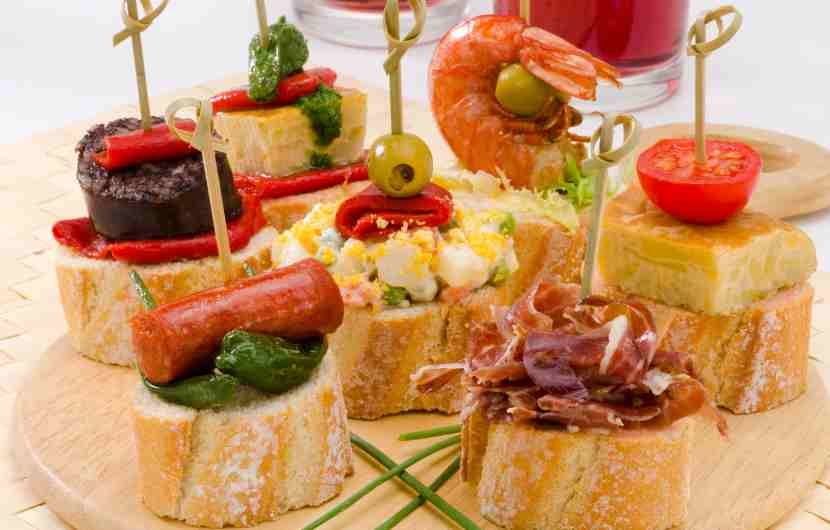
Montaditos are small, traditional Spanish open-top small sandwiches.
The term "montadito" derives from the verb "montar," meaning "to mount" or "to assemble," which describes the construction of these bite-sized delights.
Originating from Andalusia in southern Spain, montaditos have become popular throughout the country and beyond.
These miniature sandwiches are typically made with a slice of baguette-style bread and can be topped with a variety of ingredients, ranging from Spanish ham (jamon), chorizo, and cheese to seafood, vegetables, and even sweet fillings.
31. Mejillones Rellenos

Mejillones Rellenos, commonly known as "Tigres" in Spain, are stuffed mussels, a delectable tapa that showcases the country's love for seafood.
Originating from the northern regions, especially the Basque Country and Asturias , this dish has become popular throughout Spain.
The mussels are steamed open, and their juicy flesh is mixed with a spicy bechamel sauce, often combined with other ingredients like green peppers and onions.
This mixture is then packed back into the mussel shells, breaded, and deep-fried to perfection.
Crispy on the outside and creamy on the inside, Mejillones Rellenos are a gastronomic delight that captures the essence of coastal Spanish cuisine.
32. Empanada a la Gallega

Empanada a La Gallega is a traditional savoury pie hailing from the Galicia region in northwestern Spain.
Unlike the smaller, crescent-shaped empanadas found in Latin America, the Galician version is typically larger and round or rectangular.
The dough is made from wheat flour and is filled with various ingredients, the most traditional being tuna, sardines, or pork, combined with peppers, onions, and seasonings.
The filling is encased in the dough, baked until golden, and then sliced into portions.
33. Caracoles

Caracoles, or snails in English, are a traditional delicacy in various parts of Spain.
Particularly popular in regions like Andalusia, Catalonia, and Murcia, caracoles are typically stewed in a spiced broth made with ingredients like garlic, tomato, chorizo, and various aromatic herbs.
Depending on the region, the preparation and flavours can vary. In some areas, they are enjoyed in a spicy sauce, while in others, a more herby-style broth is preferred.
34. Mariscada
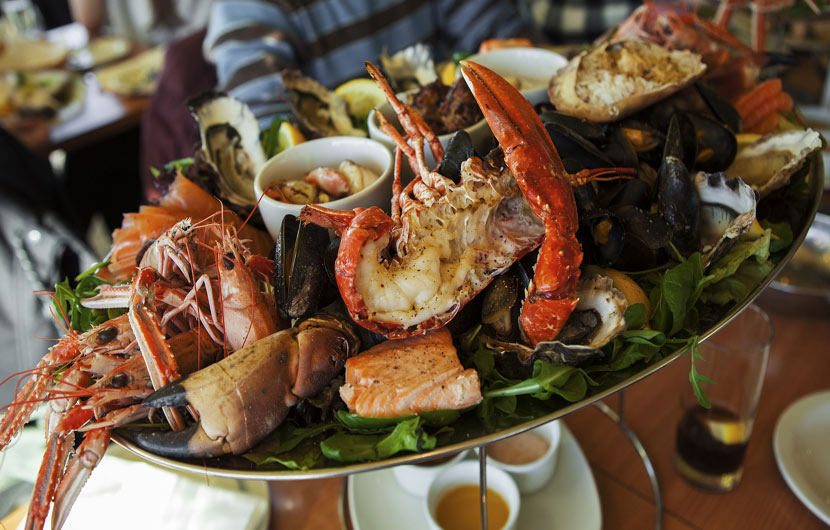
Mariscada is a sumptuous seafood feast that epitomises Spain's coastal culinary prowess.
Predominantly popular in the northern regions like Galicia and Asturias, a mariscada brings together an assortment of the freshest marine delicacies.
This platter can include langoustines, clams, mussels, crabs, and other shellfish, typically steamed or grilled to retain their natural flavours.
Often, it's accompanied by a light sauce or a squeeze of lemon.
Mariscada not only celebrates the abundant seafood offerings of Spain's extensive coastline but also the communal nature of Spanish dining.
35. Chorizo

Chorizo is a distinctive Spanish sausage known for its deep red colour and smoky, spicy flavour.
Made primarily from coarsely chopped pork and seasoned with garlic, pimenton (smoked paprika), and salt, its bold taste has made it a staple in Spanish cuisine.
While popular throughout Spain, and well known around the world, each region boasts its own variation, with differences in spiciness and preparation techniques.
Chorizo can be consumed fresh, fried, or simmered, but it's also commonly dried and cured, allowing it to be sliced and eaten like salami.
36. Cochinillo Asado

Cochinillo Asado is Spain's renowned roasted suckling pig, celebrated for its tender meat and crispy skin.
Hailing from the city of Segovia in the Castilla y Leon region , this dish is a testament to the culinary traditions of central Spain.
The young piglets, fed solely on their mother's milk, are seasoned simply with salt and sometimes herbs, ensuring the natural flavours shine through.
Slow-roasted in wood-fired ovens, the result is succulent meat with a perfectly crisped exterior. Cochinillo Asado is often reserved for special occasions and gatherings, and its presence signifies a grand culinary celebration in the Spanish heartland.
37. Pinchitos Morunos

Pinchitos, often known as "pinchos morunos," are skewered and grilled meat delicacies inspired by Spain's Moorish past.
Predominantly popular in the southern region of Andalusia, these skewers traditionally feature marinated lamb or chicken.
The marinade is a fragrant blend of spices like cumin, garlic, paprika, and sometimes saffron, echoing the flavours introduced by the Moors during their rule.
Once marinated, the meat is threaded onto skewers and grilled to perfection.
Served hot, often with a slice of bread or salad, pinchitos are a common sight in Spanish ferias (festivals) and tapas bars, offering a welcoming bite-sized spicey taste
38. Fabada Asturiana

Fabada Asturiana is a hearty bean stew that's emblematic of the Asturias region in northern Spain.
Centered around large white beans known as "fabes," this dish is complemented with a rich mix of meats, including chorizo, morcilla (blood sausage), and bacon.
The beans are slow-cooked with these meats, garlic, and sometimes saffron, resulting in a flavourful, comforting stew.
Fabada has its roots in Asturian rural tradition , serving as a filling meal to sustain farmers and workers.
Today, it's celebrated throughout Spain and beyond, symbolising the rich, rustic flavours of Asturian cuisine.
39. Zarajos

Zarajos are a unique delicacy originating from the province of Cuenca in the Castilla-La Mancha region of Spain.
This dish consists of lamb intestines, which are thoroughly cleaned, marinated in a mixture of garlic, vinegar, and spices, then wrapped around a grapevine shoot or a wooden stick in a spiral manner and grilled or fried.
When cooked, they achieve a crispy texture on the outside with a tender inside.
Zarajos might seem exotic to many but they're a prized treat in Cuenca, representing the city's tradition of utilising all parts of the animal to create tasty rustic dishes.
40. Chopitos

Chopitos are small, baby squid that are often lightly battered and deep-fried to crispy perfection.
commonly found in coastal regions of Spain, especially in tapas bars of Andalusia and Valencia, these bite-sized delights are a popular seafood snack.
When fried, their tender flesh contrasts beautifully with the crunchy exterior, making them irresistibly moreish.
Typically served with a slice of lemon and occasionally a light drizzle of aioli, chopitos celebrate the simplicity and freshness of Spanish coastal cuisine.
41. Boquerones Fritos

Boquerones Fritos are fried fresh anchovies, a beloved treat in Spain's coastal regions.
Cleaned, lightly floured or battered, and then fried in hot olive oil, these small fish become irresistibly crispy and golden.
Predominantly popular along the Mediterranean coast, especially in Andalusia and Malaga , Boquerones Fritos are often enjoyed as tapas, accompanied by a cold drink.
The simplicity of the dish highlights the anchovy's natural flavour.
Served with a wedge of lemon for a zesty kick, these fried anchovies encapsulate the essence of Spanish seaside dining, with traditions that date back to ancient fishing communities.
42. Mero a la Plancha

Mero a la Plancha translates to "grilled grouper," a simple yet tasty dish that emphasizes the freshness of the fish.
Grouper, known for its mild, sweet flavour and firm texture, is seasoned lightly, typically with salt, garlic, and olive oil, and then grilled on a flat iron plate or griddle.
Predominantly eaten in Spain's coastal regions, especially in areas bordering the Mediterranean and Atlantic, this dish champions the essence of Mediterranean cuisine.
43. Botifarra Sausage

Botifarra is a traditional Catalan sausage, deeply rooted in the culinary heritage of Catalonia .
Made primarily from finely minced pork, it is seasoned with salt, black pepper, and sometimes other spices and herbs, depending on the variant.
There are many types of Botifarra, including raw, cooked, and blood sausage.
While it can be eaten grilled or fried, it's also commonly used in regional dishes like "Botifarra amb mongetes," where it's paired with white beans.
Originating from ancient Roman times, Botifarra has been a staple in Catalan cuisine, representing the flavours and traditions of the region.
44. Torrijas

Torrijas are Spain's answer to French toast, a beloved treat especially popular during the Holy Week (Semana Santa) celebrations.
Made from slices of stale bread soaked in milk or wine, they're then dipped in egg, fried in olive oil or butter, and often sweetened with sugar and cinnamon or honey.
The result is a deliciously soft center with a crispy exterior.
Torrijas are a comforting dessert or breakfast, they capture the essence of Spanish traditional sweets.
45. Ensaimada

Ensaimada is a delicate, spiral-shaped pastry hailing from the Balearic Islands , especially Majorca.
Characterised by its airy layers and dusting of powdered sugar, its main ingredients are flour, water, sugar, eggs, and pork lard, which gives it its distinctive flakiness and name ("saim" means lard in Catalan).
Ensaimada can be enjoyed plain or filled with various ingredients, like custard, chocolate, or sweet pumpkin strands.
Its origins are believed to date back to Roman times, but the Moors' influence is also evident.
A symbol of Mallorcan identity, Ensaimada has become a sought-after treat beyond the Balearic Islands.
46. Caldereta de Langosta

Caldereta de Langosta is a sumptuous lobster stew, a culinary gem from the Balearic Islands, especially Menorca .
This dish showcases the fresh, vibrant flavours of the Mediterranean, combining lobster with ingredients like tomatoes, onions, peppers, and garlic, all simmered in a rich broth often flavoured with a dash of brandy or white wine.
Historically a fishermen's meal, Caldereta de Langosta has evolved into a delicacy enjoyed by locals and visitors alike.
47. San Sebastian Cheesecake

San Sebastian Cheesecake, also known as "La Viña Cheesecake," is a delectably creamy and rustic dessert originating from La Viña, a restaurant in the city of San Sebastian.
Differing from traditional cheesecakes, its unique burnt top and jiggly center are its signatures.
Made with minimal ingredients such as cream cheese, sugar, eggs, heavy cream, and flour, its simplicity is its strength.
The rich, creamy filling contrasts beautifully with the slightly bitter caramelised crust, offering a melt-in-the-mouth experience.
48. Chuleton de Tenera

Txuleta de Tenera is a renowned Basque steak, a culinary highlight of Spain's Basque Country .
The term "Txuleta" refers to the bone-in rib steak or chop, typically sourced from mature, grass-fed cows.
This beef cut is celebrated for its deep flavour and marbled fat.
Seasoned with just salt, it's grilled over open flames, achieving a charred exterior while preserving a tender, juicy inside.
Served in traditional "asadores" (steakhouses) and "sidrerías" (cider houses) throughout the region, Txuleta embodies the Basque people's passion for quality ingredients and simplistic yet masterful cooking techniques.
49. Bunuelos de Bacalao

Bunuelos de Bacalao is savoury cod fritters, a delightful combination of flaked codfish, flour, eggs, parsley, and sometimes garlic or onion.
They're mixed into a thick batter, shaped into small portions, and then deep-fried to golden perfection.
These tasty fritters are especially popular throughout the Iberian Peninsula.
Traditionally associated with Lent, Bunuelos de Bacalao have become a year-round treat, often enjoyed as tapas with a squeeze of lemon or aioli.

Xato is a traditional Catalan salad, most popular in the coastal regions of Catalonia, especially around Sitges and Vilanova i la Geltru.
The dish combines endive lettuce, desalted cod, tuna, anchovies, and arbequina olives.
But what truly defines Xato is its namesake sauce, made from roasted almonds, hazelnuts, stale bread, ripe tomatoes, garlic, vinegar, olive oil, and peppers.
The ingredients are ground into a rich, nutty paste which is drizzled over the salad.
Its origins are debated, with some attributing it to regional festivals, while others connect it to historic trading routes.
51. Sobrasada

Sobrassada is a spreadable sausage native to the Balearic Islands, particularly Mallorca.
Recognised by its vibrant red colour, it's primarily made from ground pork, paprika, and other spices, then cured for several weeks.
The paprika not only provides its distinct hue but also acts as a preservative. The result is a soft, spicy, and tasty delicacy that can be spread on bread, added to dishes, or even enjoyed on its own.
Sobrassada reflects the agricultural and culinary traditions of the Balearics, being an integral part of their gastronomic identity.
52. Sardines
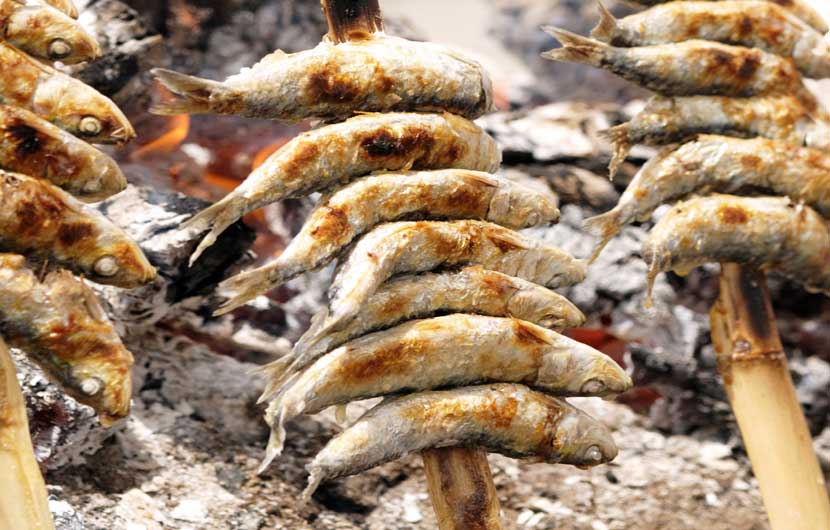
Sardinas, or sardines, are small, oily fish that play a significant role in Mediterranean cuisine.
Especially popular in coastal regions of Spain, these fish are often grilled, fried, or preserved in oil or vinegar.
During the summer, "sardinas al espeto" (sardines skewered and grilled over open fires) is a beloved tradition along the Andalusian coast.
Rich in omega-3 fatty acids, sardines are not only delicious but also nutritious.
53. Orejas de Cerdo
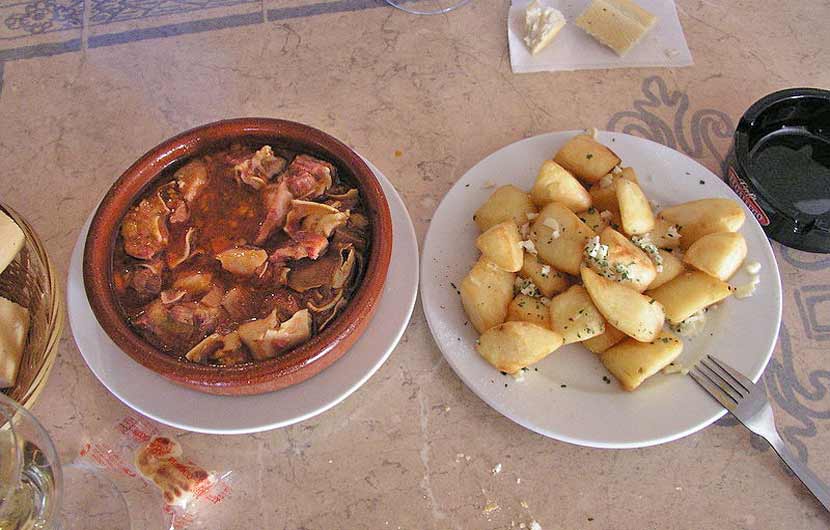
Pigs Ears in Sauce, often termed "orejas de cerdo en salsa," is a dish revered in various parts of Spain, particularly in regions with a strong emphasis on nose-to-tail eating.
As the name suggests, it features pig's ears that have been cleaned, boiled, and then stewed in a tasty sauce made from ingredients such as garlic, onion, paprika, tomatoes, and sometimes spicy peppers.
The ears, having both cartilage and skin, achieve a gelatinous and unique texture.
Over time, this dish has become an appreciated delicacy for its rich taste and texture.
54. Almejas

Almejas, the Spanish term for clams, are a highly valued ingredient in many coastal regions of Spain.
Particularly loved in the north, especially in Galicia and Asturias, and the southern coastlines of Andalusia, these bivalves are typically prepared in a minimalist fashion to highlight their fresh, briny flavour.
One popular preparation is "almejas a la marinera," where clams are simmered in a sauce of white wine, garlic, onion, parsley, and sometimes tomato.
55. Calamar Frito

Calamar Frito, or fried squid, is a beloved delicacy across Spain's coastal regions, particularly in Andalusia.
These are typically rings of squid coated in a light batter and then deep-fried until golden and crispy.
The result is a tender interior encased in a crunchy shell, often served with a squeeze of lemon and occasionally a side of aioli or marinara sauce.
Whether enjoyed as tapas in bustling bars or as main dishes in seaside restaurants, Calamar Frito epitomises the essence of Spanish seafood cuisine.
56. Spanish Olives

Aceitunas, the Spanish word for olives, are an intrinsic part of Spain's culinary and cultural fabric.
Grown extensively across the country, from Andalusia's sun-kissed groves to Catalonia's fertile landscapes, these fruits are consumed both as table olives and pressed for their precious oil.
Varieties range from the small, green "Manzanilla" to the larger, black "Hojiblanca."
Historically, the Iberian Peninsula has been cultivating olives since Phoenician and Roman times.
Whether marinated with herbs and garlic, stuffed with anchovies or peppers, or simply enjoyed on their own, aceitunas represent Spain's age-old love affair with the olive tree and its cherished fruit.
57. Percedes
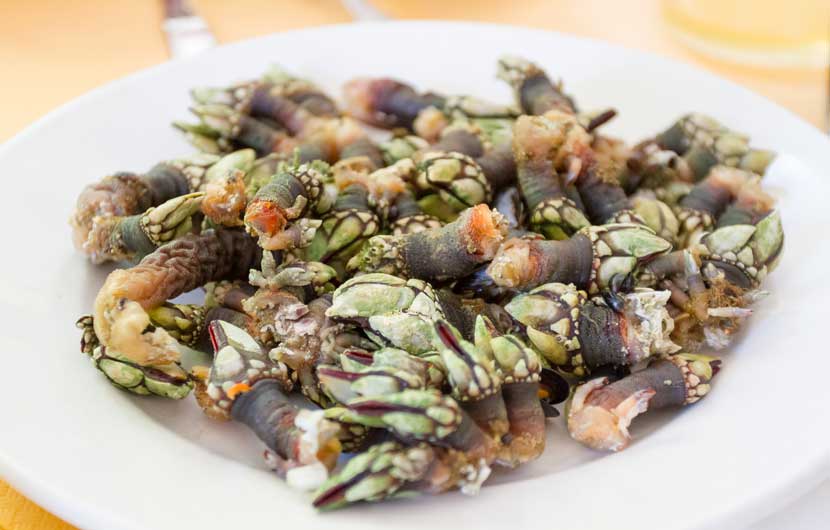
Percebes, known as goose barnacles in English, are a marine delicacy highly prized in the northern regions of Spain, especially Galicia.
These crustaceans, resembling dinosaur claws, cling to rocks in intertidal zones, making their harvest dangerous but lucrative.
Consumed fresh, percebes are typically boiled briefly in salted water, releasing a briny, tender flesh that captures the essence of the sea.
Their unique taste is a blend of lobster and crab with a seaweed undertone.
Originating from the rugged, wave-battered coasts of the Atlantic, percebes have become a symbol of Galician gastronomy.
58. Bocadillo de Calamares

Bocadillo de Calamares is a quintessential Madrid snack, comprising of a crusty bread roll filled with deep-fried squid rings.
Despite Madrid's landlocked location, this sandwich has become a symbol of the city's vibrant culinary scene.
The tender squid rings, coated in a light batter, are fried to crispy perfection and often accompanied by a dab of aioli or a squeeze of lemon.
Found predominantly in Madrid's bustling bars, it exemplifies the city's unique gastronomic identity.
59. Cachopo

Cachopo is a dish that originating from the Asturias region in northern Spain.
It consists of two large veal or beef steaks sandwiching a filling of ham and cheese, then breaded and deep-fried to a golden finish.
The result is a crispy exterior with a molten center, often served alongside fries, peppers, or salad.
Its resemblance to the Wiener Schnitzel hints at potential culinary influences, but Cachopo is uniquely Asturian in its preparation and taste.
Over time, variations have emerged with different fillings, but the traditional ham and cheese combination remains a favourite.
60. Navajas

Navajas, or razor clams, are elongated, thin-shelled molluscs loved for their tender and flavourful meat.
Found along Spain's coastline, they're particularly esteemed in Galicia and the northwest regions.
Often simply prepared to maintain their natural brininess, a popular method is grilling them with a drizzle of olive oil and a sprinkle of parsley and garlic.
Alternatively, they can be steamed with white wine and seasonings.
The name "navaja" draws from their resemblance to a straight razor.
61. Morcilla

Morcilla is Spain's version of blood sausage, a rich and tasty delicacy appreciated across various regions.
While its preparation differs slightly depending on the region, common ingredients include pork blood, rice or breadcrumbs, onions, and spices.
In Burgos, the sausage prominently features rice, while in Leon, onions are dominant. Asturias and Extremadura also have their distinct variations.
Morcilla was created in part as a way to utilise every part of the pig, minimising waste.
It is highly versatile and can be eaten cold, grilled, fried, or incorporated into stews such as "fabada."
- About Author
- Latest Posts

Hey there! I'm Matt, your friendly neighbourhood explorer extraordinaire! For the past 15 years, I've been gallivanting around Spain, soaking up all its wonders and uncovering hidden gems like a modern-day Indiana Jones (minus the hat and whip, unfortunately). So, buckle up, amigos! It's time to dive straight into the heart and soul of Spain. Welcome to my world of Spanish wonders!
Latest posts from Matt
- 4 Days in Valencia – The Ultimate Bucket List Itinerary - March 17, 2024
- Luxury Spain Holidays – The Ultimate Bucket List Travel Guide - March 9, 2024
- Easter in Spain – Semana Santa Holy Week Traditions - March 7, 2024
Recent Posts

4 Days in Valencia – The Ultimate Bucket List Itinerary

Luxury Spain Holidays – The Ultimate Bucket List Travel Guide
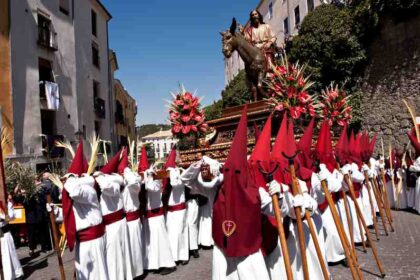
Easter in Spain – Semana Santa Holy Week Traditions

Barcelona Nightlife – Best Discos & Nightclubs Not To Be Missed

Making The Most Of Shore Sightseeing Excursions In Spain Whilst Cruising The Med

The Ultimate Spain Bucket List – 300+ Spanish Experiences

9 Great Cultural Sites to Visit in Madrid

16 Christmas Traditions in Spain You Should Know About
Leave a reply cancel reply.
Your email address will not be published. Required fields are marked *
This site uses Akismet to reduce spam. Learn how your comment data is processed .
Disclosure: Please note that some of the links included in the above content may be affiliate links. We may earn a commission if you make a purchase at no extra cost to you. Rest assured, we only recommend products and services that we personally use or have used and are happy to recommend. Any commission we earn helps toward the site's running costs.

Travel Smarter - Not Harder
Download free e-guides and travel tips.
Start your Journey today and get access to exclusive FREE content.
Username or Email Address
Remember Me
- WHY VISIT SPAIN?
- TRAVELLING TO SPAIN
- SPAIN ON A BUDGET
- TRAVEL REQUIREMENTS – ETIAS
- SPAIN ENTRY REQUIREMENTS
- SPANISH CUISINE
- SPANISH FOOD
- HOLIDAY IDEAS
- PUBLIC HOLIDAYS
- TOURISM BOARDS
- AIRPORT GUIDE
- DRIVING IN SPAIN
- WEATHER IN SPAIN
- FREE WEB CAMS
- BEST BEACHES SPAIN
- FESTIVALS & FIESTAS
- MUSEUMS IN SPAIN
- CAMPING IN SPAIN
- MARINAS IN SPAIN
- SKIING IN SPAIN
- WATER PARKS
- UNESCO WORLD HERITAGE SITES
- 80 BEST ATTRACTIONS
- 71 BEST PLACES TO VISIT
- REGIONS OF SPAIN
- COSTA DEL SOL
- CANARY ISLANDS
- SAN SEBASTIAN
- Complete List:
- SAGRADA FAMILIA BARCELONA
- BARCELONA FC STADIUM TOUR
- BARCELONA FLAMENCO SHOW
- SEVILLE FLAMENCO SHOW
- SEVILLE CATHEDRAL
- GAUDI`S CASA BATLLO
- THE ALHAMBRA GRANADA
- SANTIAGO CATHEDRAL
- CITY OF ARTS & SCIENCE VALENCIA
- MOSQUE-CATHEDRAL CORDOBA
- CAMINITO DEL REY
- PRADO MUSEUM MADRID
- REINA SOFIA ART MUSEUM
- SCUBA DIVING
- BEST TAPAS TOURS
- BEST WINE TASTING TOURS
- TOUR GUIDES
- HOTELS IN SPAIN
- LUXURY HOTELS
- LUXURY BEACH HOTELS
- HOLIDAY RENTALS
- PARADOR HOTELS
- CHEAP FLIGHTS
- TRAVEL INSURANCE
- FREE TRAVEL BROCHURES
- WIN FREE HOLIDAYS

What to eat in Spain

We think one of the best ways to experience a country and connect with the locals is by eating! From Padron peppers to patatas bravas, and turrón to tapas, Spain knows how to pull out the stops when it comes to delicious food. Spanish food is simple and uses fresh, local ingredients, so it's no wonder dishes like paella and tapas have rightfully put the country on the world foodie map. Here's our guide to some traditional foods to try on your trip to Spain.
Tapas is woven into the fabric of Spanish culture, and it's also one of the main reasons why Spanish cuisine is so famous around the world. But what is it exactly? Tapas are small share plates of food eaten as a snack or appetiser. It could be anything from a board of olives, cured meats and bread to garlic prawns and fried octopus. Socialising starts and ends late in Spain, so locals often order a few tapas dishes to keep going until the main meal. Sharing tapas and a few drinks with friends is also a popular way to socialise. We encourage you to order lots of tapas in Spain, as it's a fantastic way to sample as many Spanish dishes as possible thanks to the small portion size.
Paella is probably Spain's most well-known food. This delectable, saffron-flavoured rice dish originated in Valencia hundreds of years ago when hungry servants would combine rice with leftovers from Moorish kings' lavish banquets. There are different takes on the dish throughout Spain, but the mixed version with chorizo, mussels and prawns is the most popular internationally. But, if we had to recommend just one type, it’s got to be the original Valencian version with rabbit, chicken and butter beans.
Tortilla, or Spanish omelette, is one of the simplest and most authentic Spanish foods. It's similar to a regular omelette made with eggs, except it also has potato and extra virgin olive oil. A plain tortilla is delicious, but you may also like to add chorizo, cherry tomatoes, peppers or other vegetables. Tortilla is often served as part of a tapas spread and is a great option for vegetarians wanting something hearty.
Every country seems to have a signature potato dish of some kind, and Spain's is patatas bravas. This crowd-pleasing tapas dish consists of crispy, shallow fried potatoes topped with a spicy sauce made from olive oil, garlic, tomato and smoked paprika. You may also like to top it with chorizo, fried fish or aioli, because why not?
Spain's jamón, or cured ham, is pretty legendary. Much like how prosciutto is ubiquitous when you travel to Italy , you’ll see legs of salty jamón hanging at market stalls and on restaurant and bar menus all across Spain. There are two types of jamón –serrano from white mountain pigs and Ibérico (the finest and most expensive ham) from black Iberian pigs. You can eat slices of plain jamón on fresh bread as a snack or as part of a cheese board washed down with a glass of sherry .
Croquettes are another tapas favourite, and this time vegetarians can easily get involved. These delightful fried balls of bechamel sauce enclosed in breadcrumbs come with several fillings from beef, salted cod and ham to broccoli and goat’s cheese. They’re best enjoyed as finger food with a cold cerveza (beer).
This comforting dish of meatballs swimming in a spicy tomato sauce always goes down a treat. Typically made from veal and pork mince, albondigas is simple to make and even easier to eat, particularly when accompanied by a glass of Rioja.
There's nothing better than picking at a bowl of calamari at a beach-side bar. Made by frying tender squid rings in batter which are then seasoned with salt, pepper and a splash of lemon juice, it's a great dish to eat on its own or in a tapas mix.
If you can't get on board with the idea of chilled soup, just wait until you've tried gazpacho. A bowl of gazpacho is a cool solution to Spain’s intense summer heat, made by blending raw tomatoes, cucumber, peppers, onions, garlic, and olive oil. Mop it up with some crusty bread drizzled in more olive oil.
Churros are Spain’s answer to doughnuts. If you need a sugar hit, you can’t go wrong with these deep-fried dough sticks dipped in chocolate for good measure! They're usually eaten for breakfast or as a sweet afternoon snack. Find them at open-air food stalls, bars and cafes – don’t worry about using Google Maps, the sweet aroma of fried dough will guide you in the right direction.
This delightful treat is famous throughout Spain, especially during the festive season. Each region has their spin, but the basic turrón recipe includes toasted nuts (usually almonds, but pistachios are also common), sugar (lots of it!), honey and eggs. It can either be squishy and chewy, or firm and brittle.
Vegetarians certainly won’t go hungry in Spain. And while vegans might need to do a little detective work in small towns and villages, there’s still a lot on offer if you know where to look.
You'll find vegetarian food in most bars, restaurants, cafes and markets. Major cities like Madrid and Barcelona are packed with vegan-friendly (and just straight-up vegan) restaurants. It can be a bit trickier to find vegan options outside of the big cities, so the safest option is to make the local market your first port of call in each place you visit to stock up on fresh fruit, vegetables and bread. Your local leader will be happy to help you navigate menus and find the best plant-based dining options.
When looking at local menus, keep an eye out for gazpacho, crema de verduras (vegetable soup) and basic ensaladas (salads), which are likely to be vegan. To be sure they won’t come served with meat on top (which can happen even when it isn’t listed as an ingredient), tell the waiter you want to order your dish ‘sin jamon y sin huevo’ – with no ham or eggs.
Let's create an exclusive trip for your group.
National Geographic content straight to your inbox—sign up for our popular newsletters here

15 of the best Spanish food experiences
From edible art in Madrid and truffle hunting in Aragon to Valencia's oranges and Alicante's rice dishes, here's how to get a true taste of Spain.
Crisp croquetas filled with gooey bechamel; succulent squid, charred and glistening under a coat of olive oil; a slice of lightly browned tortilla, packed with perfectly cooked potato. Spanish cuisine is mouthwatering wherever you eat it, but it’s at its best in context and on location.
The country’s flavours and traditions come to life when you’re hopping from tapas bar to tapas bar in Granada, sitting among new friends in a Galician home that doubles as a restaurant, or sipping something dry and delicious in the sunshine: cider in the Basque Country, sparkling wine in Catalonia.
These are Spain’s essential culinary experiences, and while you’re there, you can learn the tricks of the trade to continue the feast — and the fiesta — back home.
1. Take a tapas crawl in Granada
Tapas has become synonymous with Spain as a whole, but few places do it better than the Andalucian city of Granada, where every drink — be it vermouth or a tinto de verano — comes with free bites to eat. The best way to experience Granada’s tapas scene is to hop from one bar to the next along Plaza Nueva and Plaza Bib-Rambla. Try Bodegas Castañeda for broad beans with cured ham or blue cheese croquetas, served at the bar or on wooden barrels, and seafood restaurant Cunini for steamed mussels and fried anchovies — all for no more than the price of your drink.
2. Try ‘gastroarcheology’ in Cordoba
During Spain’s Islamic rule, Cordoba was one of the country’s most ethnically diverse settlements, a city where Muslims, Jews and Christians lived side by side. But after the Christian conquest of Spain, much of Al-Andalus culture, including its cuisine, was forgotten. Through the meticulous study of ancient manuscripts and cookbooks, chef Paco Morales is reviving Al-Andalus recipes in his two-Michelin-star restaurant, Noor , where ingredients like wild coriander, dates and almonds take you on a sensory journey through Islamic Spain. Also inspired by Al-Andalus architecture, Morales often includes decorative motifs found on Cordoba’s Mosque-Cathedral and other Islamic buildings across the city.
3. Enjoy edible art in Madrid
Snagging a reservation at Madrid’s only three-Michelin-star restaurant, where none other than David Muñoz is at the helm, is a golden ticket to one of Spain’s most exciting dining experiences. Inspired by Spanish, Chinese and Japanese flavours, DiverXO ’s avant-garde tasting menus — served on large white canvases made of porcelain — are presented as edible works of art. Roasted duck hearts come splattered with tabasco and tomatillo ketchup like an abstract painting, and miso asparagus and naan ‘orbs’ come with smoking dry ice towers. Muñoz’s love for the avant-garde doesn’t stop at the food: flying pigs hang from the ceiling, and an all-white, bright-light decor feels like stepping into a sci-fi film.
4. Hunt for truffles in Aragon
In Aragon — a landlocked region in Spain’s mountainous northwest — 80 tonnes of truffles are harvested every year, making it one of the largest truffle-producing regions in the world. Across region, but particularly in the provinces of Teruel and Zaragoza, from around November/December to March, you can join truffle farmers and their dogs, whose keen sense of smell helps sniff out the prized fungus that’s ripe and ready to be eaten. You can book truffle-hunting experiences through the Aragon tourist board or a multi-day truffle-themed trip through companies including Gourmet & Chic and The Spanish Touch . Most truffle-hunting experiences end with a tasting and a truffle-centred menu at one of the region’s Michelin-starred restaurants, such as La Prensa and Restaurante Cancook .

5. Dine out in Galicia’s unofficial restaurants
For just three months of the year, winemakers across Galicia’s coastal Rías Baixas area open their homes as pop-up restaurants. Known as furanchos or loureiros, these date back to when medieval winemakers sold surplus wine after the harvest, and today families adapt their garages and front rooms to sell homemade albariño wine and plates of padron peppers, flambéed chorizo and empanadas filled with baby scallops. Part of the fun is finding the furanchos — a bay branch hanging on the door is all that distinguishes them from any other country home.
6. Join the tuna fishermen in Cadiz
Every spring, shoals of bluefin tuna weighing up to 250kg migrate from the Atlantic to the Mediterranean, making it prime fishing season on the Andalucian coast off Cadiz. Fishermen here still use a show-stopping technique that dates back to the Phoenicians called the almadraba, where a net more than a kilometre long is cast along the migratory route and, once filled with tuna, pulled up to the surface for fishermen to dive in and finish the catch. And it’s one of the more sustainable fishing methods, too — the nets don’t harm dolphins or whales and the process generates a minimal amount of biological waste or discarded bycatch. Companies including Annie B’s Spanish Kitchen and Epicurean Ways will take you out with the fishermen to see the spectacle up close, before a tuna-cooking lesson and a tasting of mojama (salt-cured tuna loin).
7. Sip wine underground in Aranda del Duero
Below the streets of Aranda del Duero , the capital of the Ribera del Duero wine region in Castile y Leon, lies a five-mile network of hundreds of interconnected bodegas. Built during the medieval period, many of these historic wineries remain closed to the public, but a new generation of winemakers are beginning to open them up for subterranean tastings. At Bodega Don Carlos — a 15th-century wine cellar 45ft below Aranda del Duero’s main drag — tempranillo and albillo wine tastings come with morcilla de Burgos (blood sausage), roasted red peppers and mollejitas de lechazo, suckling lamb gizzards coated in breadcrumbs and deep-fried.
8. Cycle Jaen’s Olive Oil Greenway
Introduced by the Phoenicians and Greeks, the production of olive oil has shaped the Andalucian city of Jaen for millennia. One way to explore the groves is on the Olive Oil Greenway , an 80-mile cycling and hiking trail along an abandoned 19th-century railway that once transported olive oil from Jaen to Malaga. Plus, many of Jaen’s almazaras (olive oil mills) offer guided tours and tastings, where you can learn about the region’s different olive varieties (picual and lucio being the most popular) and enjoy a traditional farmer's breakfast of olive oil bread with cheese. During the harvest season (October to early January), you can join farmers as they collect and process the olives.

9. Take part in a Basque cider ritual
Cider has been produced in northern Spain’s Basque region for more than 1,000 years. Despite a crash in the 18th century, 80 cider houses, or sagardotegi, remain, and more than 500 apple varieties still grow here. Astigarraga, a town on the outskirts of San Sebastian where cider is cheaper than water, is famed for its txotx rituals, where enormous cider barrels are tapped surrounded by a crowd of thirsty punters. Often draining hundreds of litres in one sitting, these boozy cider-drinking rituals come with chistorra (paprika-spiced pork sausage), T-bone steak and salted cod tortilla to soak up the alcohol.
10. Follow Extremadura’s Iberico Route
Spain’s wildest region is home to almost a million hectares of dehesa, natural farmland dotted with oak trees and hundreds of free-roaming Iberian pigs. It’s here that the country’s best jamón ibérico, including the prized ibérico de bellota — made from 100% ibérico breed pigs fed exclusively on acorns — is produced. The Dehesa de Extremadura Ibérico Route runs from the north of the dehesa to the south, where producers explain the jamón production process, from salting and washing to drying and maturation. Once you’ve had your fill of jamón, make a stop at any restaurant along the route for Iberico pancetta, Iberico blood sausage and morcones, an Iberico chorizo made with locally produced La Vera paprika.
11. Sample Alicante’s array of arroz
Valencia gets all the fame when it comes to Spain’s most famous rice dish, but the province of Alicante has more than 300 recorded rice-based recipes. From arroces secos (dry rice) like arroz al senyoret to arroz meloso (creamy rice) and arroz caldoso (brothy rice) with octopus and artichokes, Alicante’s historic rice dishes are as varied as they’re delicious. Recent efforts have been made by local chefs to promote local rice recipes, with restaurants such as Pocardy and Dársena serving creative flavour combinations like squid rice with prawn head emulsion, and red mullet rice with Iberico pork and artichokes.
12. Taste Catalonia’s sparkling wines
Family winemakers have been producing sparkling wines in Penedès, Catalonia, since 1872. But despite the region’s rich winemaking history, Spanish cava has struggled to gain the same recognition as French champagne. Yet, thanks to pioneering winemakers like Jesi Llopart, cava — or, simply, sparkling wine, as the Llopart family prefer to call it — is reinventing itself as a luxury product. Llopart and other wineries that are part of the newly established Corpinnat — a collective of Penedès winemakers whose grapes are 100% organic and harvested entirely by hand — offer vineyard tours and tastings just 35 minutes from Barcelona. You’ll learn traditional sparkling wine methods and sample a selection of fine wines paired with local cheese and cold cuts.
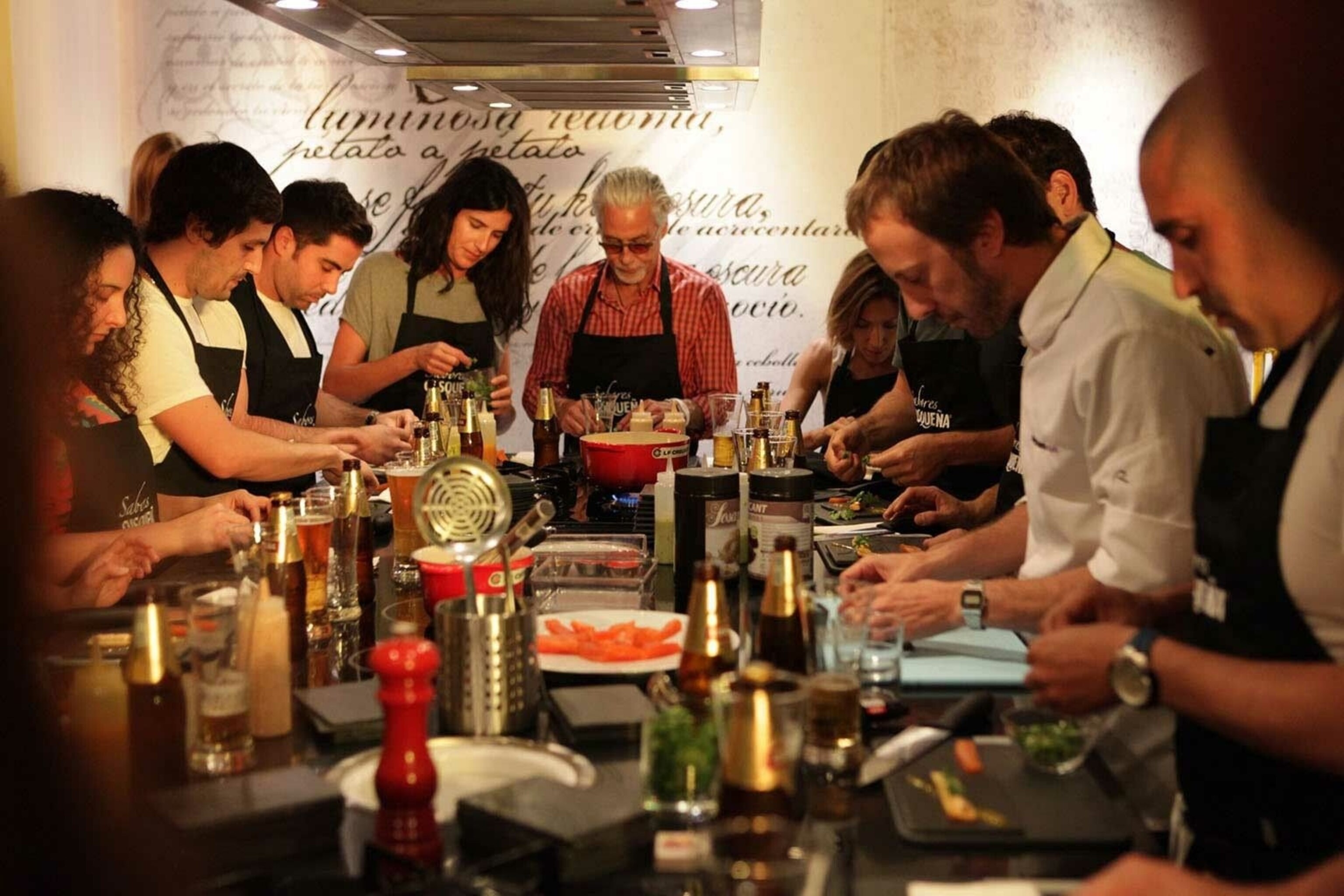
13. Learn to cook the Spanish way
Whether it’s recreating Michelin dishes or cooking paella over an open fire, a cooking class in Spain won’t disappoint. In Madrid, cookery schools like the Kitchen Club teach the classics such as tortilla and Basque cheesecake, while chefs in Seville and Galicia champion regional specialities such as Andalucian salmorejo and Galician razor clams. Serious cooks should head to Spain’s Michelin hubs, San Sebastián and Barcelona, where multi-day courses are spent making foams and liquid nitrogen spheres.
14. Check out Valencian oranges
A region scented with citrus since the Moors brought them across the Mediterranean in the eighth century, Valencia is home to some of the most flavoursome oranges you’ll ever taste. They come in all shapes and sizes, depending on the season: there’s the navel chocolate orange, a brown-skinned variety that’s low in acid; the sweet, pear-shaped navelina used in salads and smoothies; and the Sanguinelli blood orange blended into marinades, marmalades and vinaigrettes. For Valencian chefs like Vicky Sevilla of Michelin-starred Arrels , oranges are the star ingredient in dishes like orange-marinated fish and orange blossom crème brulee.
15. Try Castilla-La Mancha’s saffron and cheese
Castilla-La Mancha is world-famous for Don Quixote, but its cheese and saffron are just as legendary among Spaniards. Made exclusively from the milk of manchega sheep and aged for up to two years, manchego is considered one of Spain’s best cheeses, while La Mancha saffron is sought after by chefs worldwide. If you visit during the saffron harvest in October, you can join farmers in both plucking and toasting the spice by hand on guided tours with A Taste of Spain or The Spanish Touch , which also include visits to artisanal manchego cheese farms.
Published in Issue 16 (summer 2022) of Food by National Geographic Traveller (UK)
Follow us on social media
Facebook | Twitter | Instagram
Related Topics
- FOOD TOURISM
- FOOD CULTURE
You May Also Like

4 of the best food experiences in Corsica

4 of the best food experiences in Savoy, France
For hungry minds.

A food guide to Prague

4 of the best food experiences in Tromsø

Is Manchester the UK’s best beer city?


A food guide to Berlin, from fine dining to kebabs

How to plan a springtime food weekend in the Cotswolds, UK
- Environment
History & Culture
- History & Culture
- History Magazine
- Gory Details
- Mind, Body, Wonder
- Paid Content
- Terms of Use
- Privacy Policy
- Your US State Privacy Rights
- Children's Online Privacy Policy
- Interest-Based Ads
- About Nielsen Measurement
- Do Not Sell or Share My Personal Information
- Nat Geo Home
- Attend a Live Event
- Book a Trip
- Inspire Your Kids
- Shop Nat Geo
- Visit the D.C. Museum
- Learn About Our Impact
- Support Our Mission
- Advertise With Us
- Customer Service
- Renew Subscription
- Manage Your Subscription
- Work at Nat Geo
- Sign Up for Our Newsletters
- Contribute to Protect the Planet
Copyright © 1996-2015 National Geographic Society Copyright © 2015-2024 National Geographic Partners, LLC. All rights reserved

21 Best Traditional Spanish Foods You Must Eat In Spain
This post may contain affiliate links. Disclosure
Wondering what to eat in Spain on your next visit? Discover the best of Spanish cuisine as I take you on a culinary journey in 21 must-try traditional Spanish dishes . This is the most popular food in Spain .
Hearty and comforting, food in Spain draws on the proximity to the sea, an abundance of locally produced fruits and vegetables, and animals that still roam freely and feed naturally.
As if that wouldn’t be enough, each Spanish city and region has its own unique cuisine. So no matter where you go, you’re guaranteed to find new and delicious foods to try in Spain.
Over the years, I’ve eaten my way around Spain and discovered more tasty dishes than I could count. These are just some of my favorites.
Also read: Spanish Mealtimes and Eating Habits: What to Eat When
What to eat in Spain – must try traditional Spanish food
In this guide to Spanish food, I’ve included traditional dishes from all over the country.
I’m well aware that there are plenty of other things to eat in Spain and this list of the best food to eat in Spain is by no means exhaustive. My aim here was to create a shortlist of must try Spanish foods popular in Spain, without overwhelming you.
Whether this is your first time visiting Don Quixote’s country or not, here’s what to eat in Spain – from region-specific traditional dishes to some of the most common foods in Spain .
1. Paella Valenciana – famous traditional Spanish food
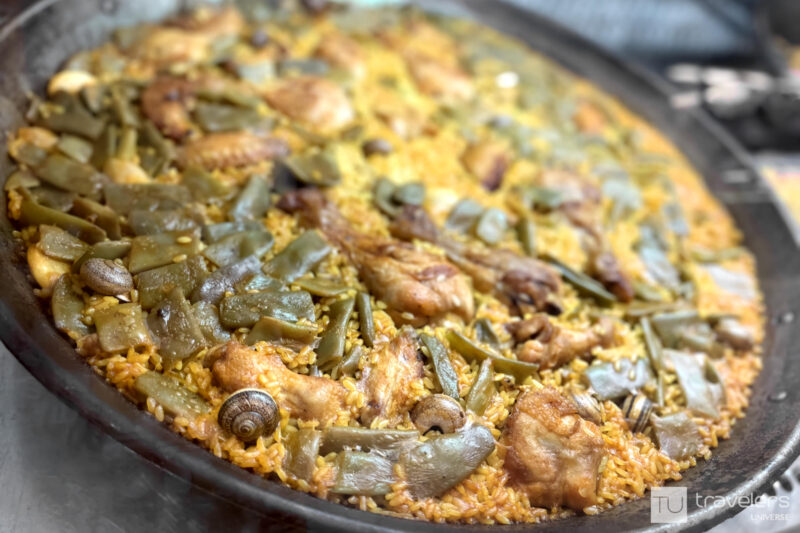
Paella is one of the most famous Spanish dishes and its origins can be traced back to the 18th century, in El Palmar, a small village south of Valencia . The first paellas were prepared using chicken, rabbit, snails, vegetables, and the local variety of short-grain rice. This recipe is known as paella Valenciana.
Cooking a beautiful golden paella is an art form that few chefs outside of Valencia have mastered to perfection. If you want to eat this traditional Spanish food, try to book a table at one of these paella restaurants in Valencia for an amazing experience. Some of them still cook their paellas on an open fire fuelled by orange branches.
If you’re a fan of seafood paella, you’ll also find dozens of rice dishes made with seafood in Valencia. Many of them are cooked in a shallow paella pan, but they aren’t usually called paella. The locals tend to use this word for the original recipe alone, all the other dishes being called “rice”.
2. Jamón – one of the most popular foods in Spain
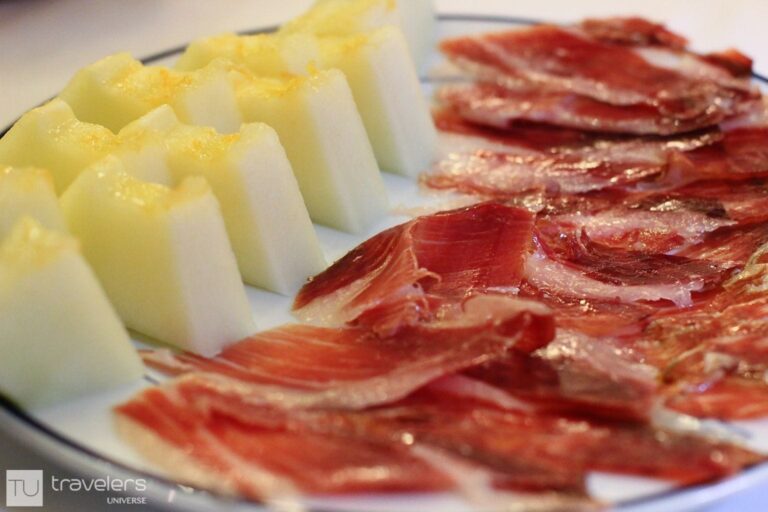
Jamón (dry-cured ham) is a staple of Spanish cuisine. It is served in thin slices (ideally carved by hand with a sharp knife) and consumed in small portions. Spaniards eat jamón on charcuterie boards, in bocadillo sandwiches, on top of pizza , and various other dishes. A surprising (yet delicious) appetizer is a plate called melón con jamón , which is basically sweet melon with dry-cured ham.
There are two types of jamón in Spain – jamón Serrano and jamón Iberico – each with its own classifications, depending on the diet of the pigs and the place of origin. Jamón Serrano is the most affordable and comes from white coat pigs. Jamón Iberico comes from black Iberian pigs and it’s leaner, has an intense flavor, and a dark red color.
Some of the best Spanish hams are jamón de Teruel, jamón de Jabugo and jamón Iberico de Bellota. The latest is the king of Spanish hams, it comes from free-range acorn-fed pigs and is cured for a minimum of 36 months. You can order these special hams in restaurants or buy them from fresh-produce markets, gourmet shops and specialist ham shops (jamonerias).
3. Spanish cheese – some of the best things to eat in Spain
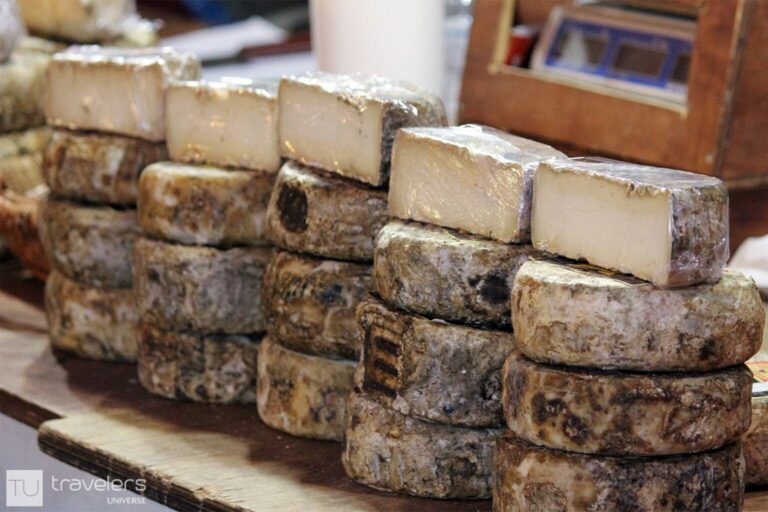
Spain produces more than 100 different cheese varieties, from fresh to cured and from fermented to smoky. Each Spanish region has its own cheese specialties, with Asturias being the largest cheesemaking region in Europe.
As a general rule of thumb, cow’s milk cheeses are typical of northern Spain, sheep’s milk cheeses are typical inland, and goat’s milk cheeses are more often found along the Mediterranean coast and on the islands.
Cheese is an important part of a typical Spanish diet. It can be either enjoyed as tapas, in bocadillos , or accompanied by wine, beer, or other Spanish drinks .
Two of the most popular cheese types in Spain are the Manchego cheese (sweet, nutty, with a semi-soft texture) and the Mahon cheese (fruity, matured in underground cellars for up to two years, typical of the Balearic Islands). If you like blue cheese, I dare you to try Cabrales, a cave-aged cheese with a sharp smell from northern Spain.
4. Bocadillos – Spanish baguette sandwiches
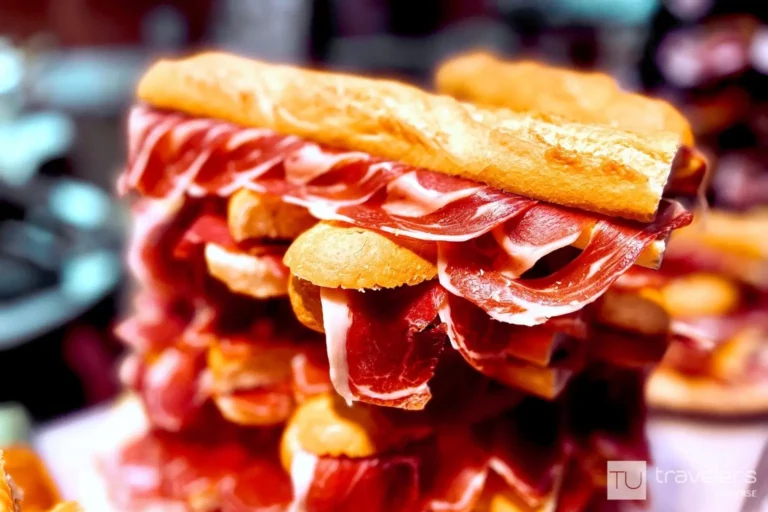
Bocadillo is the Spanish version of the ever-popular sandwich and a common snack food in Spain. Humble, versatile, and undeniably tasty, the main difference is that the bread used is a crusty baguette.
The most common bocadillos fillings include dry-cured ham, cheese, sausages, meat, tuna, and the famous Spanish potato omelet. On top of that, each region of Spain has its typical bocadillos, resulting in a wide variety of flavors.
For example, blanco y negro (made with white and blood sausages) is a popular food in Valencia and a typical Las Fallas food . While the crispy fried calamari bocadillo is a delicacy you cannot miss while in Madrid (see what else to do when visiting Madrid for 3 days ).
The Spanish don’t typically add lettuce, raw onions, mayonnaise, or pickles to bocadillos but grilled vegetables, caramelized onions, and tomato slices are somewhat common.
5. Pinchos – tapas from northern Spain
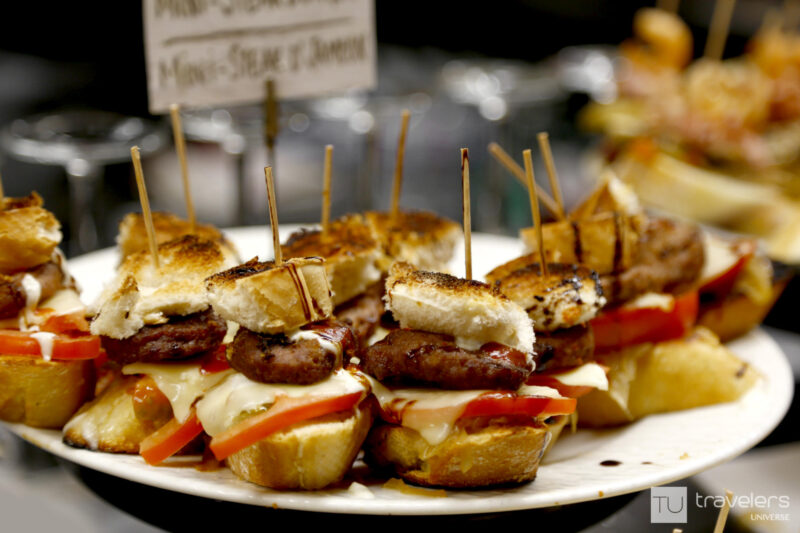
Pinchos (or pintxos ) are small appetizers typically served on top of bread and held together by a skewer or toothpick. The toppings can be anything from fish and seafood to meat, cheese, or vegetables. Pintxos are Basque Country’s answer to tapas so they are considered a traditional food from northern Spain, but they are popular all over the country.
Pinchos are similar to tapas in the sense that they are small bites that can be eaten as appetizers before dinner or even as dinner. They are typically kept on plates on bar counters so you can easily help yourself to as many as you want.
In some bars, each pincho has a slightly different type of toothpick, symbolizing a different price. At the end of the meal, the waiter counts all toothpicks on your plate and uses them to calculate the bill.
6. Tortilla de patatas – Spanish potato omelette
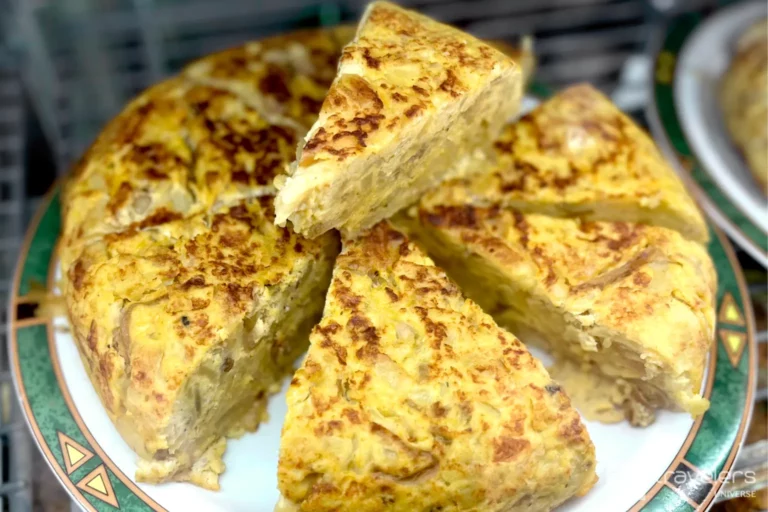
Tortilla de patatas (Spanish potato omelet) is a signature dish in Spanish cuisine. It can be eaten as a tapa, on top of pinchos, or as a bocadillos filling.
There are many tortilla variations throughout Spain — with chorizo, spinach, or other veggies — but the classic one remains the one made with nothing but eggs, potatoes, olive oil, salt, and sometimes onions. If you’re looking for delicious, filling, and typical food in Spain, look no further!
Tortilla de patatas was born in Extremadura (a region in western Spain) towards the end of the 18th century. Its popularity grew so much that today you can find this traditional Spanish dish in any bar in Spain.
Gourmet food lovers should try the deconstructed potato omelet created by Ferran Adrià a three-star Michelin chef, and owner of El Bulli restaurant in Barcelona .
7. Spanish olives – a must eat in Spain
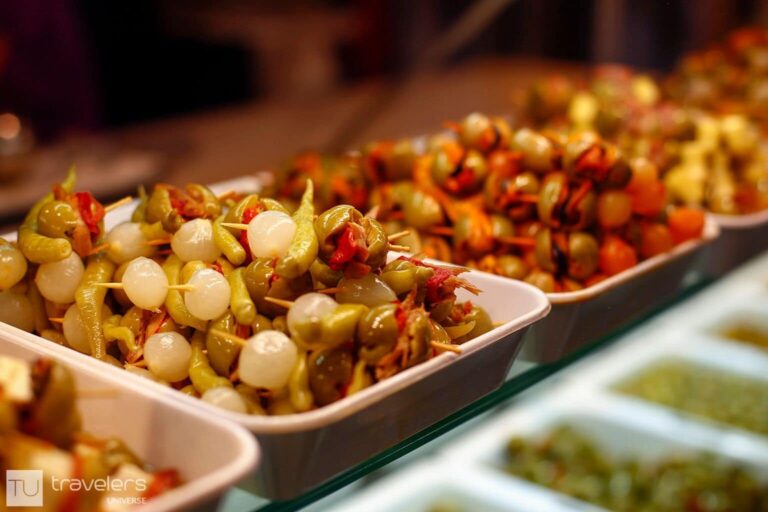
Olives are pretty much everywhere in Spain. Locals love them and chow down on them all day long, be them as simple snacks or appetizers, in salads, and on top of pintxos. Salty olives are also a great pairing option for a number of Spanish drinks , from beer to wine to vermouth.
The first olive trees were introduced in Spain over 3,000 years ago. Nowadays, you can find a wide variety of olives throughout the country, such as manzanilla , gordal , malagueña , and aragón .
Markets tend to be the best places for tasting a wide variety of olives, with bars being a second close. Gilda pintxos made with briny olives, a salt-cured anchovy, and some pickled green guindilla peppers are an iconic Basque skewer named after Rita Hayworth’s femme fatale character in the movie ‘Gilda’.
Fun fact: Spain is the world’s largest olive oil producer. Read more fun facts about food in Spain .
8. Chorizo and other Spanish sausages
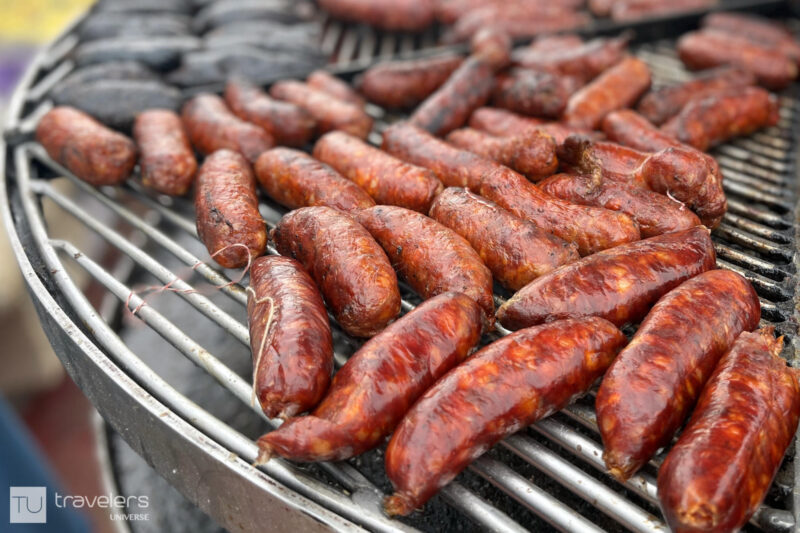
There are hundreds of sausage varieties in Spain. Collectively referred to as embutidos , sausages are a staple of Spanish cuisine and come in all shapes and sizes, plain or smoked. As a rule of thumb, the cured, lean meat ones are eaten as tapas or appetizers, and the ones with a higher fat content are grilled or used to flavor stews.
Many Spanish chorizos have a deep red color because they are seasoned with pimentón (Spanish smoked paprika). Salchichón and fuet (a thin dry-cured Catalan sausage) on the other hand are made with cracked pepper instead of paprika.
Some of the most popular Spanish sausages are chorizo de Pamplona (a beef and pork sausage with a homogeneous grainy appearance), morcilla de Burgos (a meatless blood sausage made with onions), and sobrasada (a cured, soft spread typical from the Balearic Islands).
When it comes to grilled and cooked sausages, longaniza (a thin sausage made with minced pork and spices), chistorra (a fast-cured, pork and beef sausage typical of northern Spain), and butifarra (a white sausage specialty from Catalonia) are a must eat in Spain.
9. Pescaíto frito – Spanish fried fish
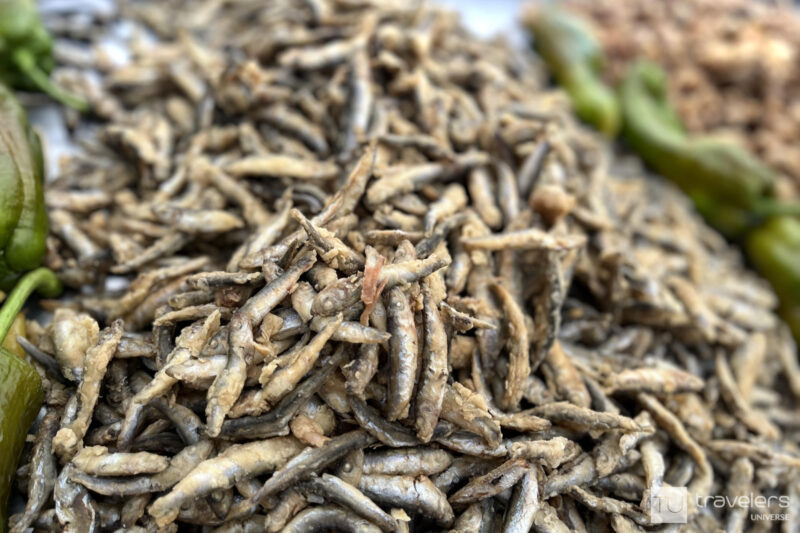
Be it calamari, squid, or anchovies, a piping hot plate of deep-fried fish is one of the most popular tapas in Spain.
They are coated in seasoned flour and fried in olive oil until crisp. This forms a crust that prevents the fish from getting greasy while preserving its great taste, aroma, and texture.
These delicacies can be sprinkled with salt or a squeeze of lemon and are great served with a cold Spanish beer or tinto de verano (a wine cocktail).
This is one of Spain’s gastronomic delights and leverages two basic local ingredients — incredibly fresh seafood and olive oil. You cannot miss them when trying traditional food in Spain!
Also read: 35 Fun Facts About Spain
10. Gazpacho & salmorejo – traditional Spanish cold soups
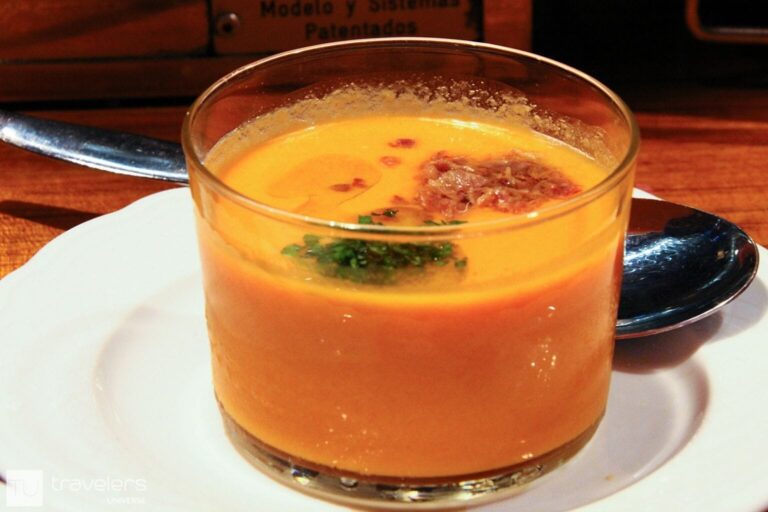
Unlike their Portuguese neighbors, Spaniards aren’t big fans of soups. Hence gazpacho and salmorejo are the exceptions that prove the rule.
These chilled tomato soups both originated in Andalucia during the 16th century when tomatoes and peppers, two of the fundamental ingredients of gazpacho, arrived from the Americas.
While the gazpacho has achieved worldwide fame, salmorejo is more of a local darling. Compared to gazpacho, salmorejo has a thicker consistency and is usually garnished with diced Serrano ham and hard-boiled eggs. Can you imagine anything more refreshing on a hot summer day?
11. Empanadas and empanadillas – Spanish baked snacks

Walk into any bakery in Spain and you’ll surely find empanadas and empanadillas. These stuffed pastries are originally from the Galicia region in northern Spain where they’ve been prepared since the VII century. They are a versatile type of baked snacks that can be enjoyed any time of the day both warm and cold.
The pastry dough used for empanadas and empanadillas is usually made with lard while the filling can be any number of things, from meat to fish to vegetables. The main difference between empanadas and empanadillas is that empanadas are large pies that need to be cut into slices, while empanadillas are small individual turnovers.
The most popular empanada in Spain is called empanada gallega (from Galicia) and has tuna as the main ingredient. In Valencia, empanadas are typically made with pisto (Spanish ratatouille). While in Castilla y León, empanadas are called hornazo and are made with chorizo, ham, and pork loin.
While all empanadas are savory snacks, empanadillas can be savory or sweet. The sweet empanadillas are traditionally filled with cabello de ángel (a confiture made from candied strands of figleaf gourd), dulce de membrillo (a sticky, thick jelly made from the quince fruit), or pumpkin paste.
12. Cochinillo asado – roast suckling pig
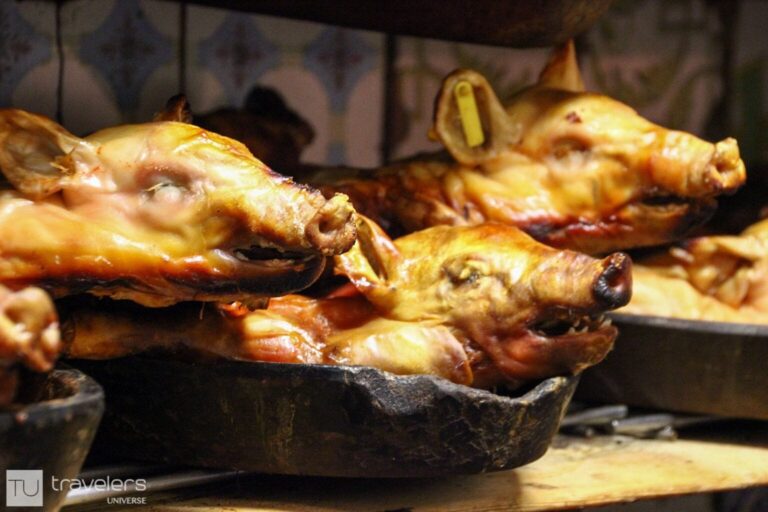
Roast suckling pig ( cochinillo asado ) is a local food in Spain traditional from the Castile region, in central Spain. It is a rare delicacy, for obvious reasons – a suckling pig is a piglet, barely a few weeks old, fed on its mother’s milk.
The meat of the suckling pig is almost white and very tender with a buttery texture, while the skin is crisp and sweet.
Roast suckling pig is usually prepared in an earthenware casserole dish in the oven. It’s a popular dish in Madrid and Segovia and the surrounding area. Roast suckling pig is best accompanied by a glass of wine.
13. Gazpacho manchego – Spanish game meat stew
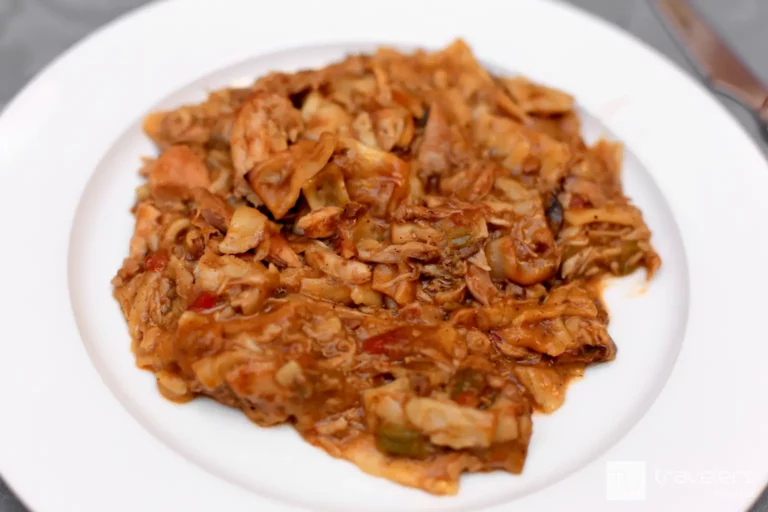
I’m sure you’ve heard of gazpacho andaluz (the famous Spanish tomato soup served cold). But have you ever heard of Gazpacho manchego?
Gazpacho manchego is a hearty game meat stew served hot and accompanied by chopped unleavened bread. It’s a traditional Spanish dish from the La Mancha region in central Spain and has little, if anything, in common with the Andalusian recipe.
Gazpacho manchego was created by the shepherds of La Mancha and was mentioned by Cervantes in Don Quixote. Originally, the unlevelled bread cake also served as the plate for the gazpacho manchego, but today the cake is more commonly incorporated into the stew.
14. Fabada asturiana – Spanish rich bean stew
Fabada asturiana is a traditional dish from northern Spain, more precisely and as its name suggests, from the region of Asturias. This rich stew is typically made with faba beans (large white beans), sausages such as chorizo and morcilla (black pudding), and bacon and cooked in an earthenware dish.
The result is a comforting and soul-warming stew ideal for the winter months when it is widely available on restaurant menus throughout Spain. And since it’s quite easy to prepare, fabada is also a delicacy savored by the spoonful in many Spanish households.
Fabada asturiana is to Asturias what paella is to Valencia: its most treasured dish. To underline its popularity even further, several supermarkets in Spain carry the canned version of this hearty meal. While in Asturias, a competition called ‘The Best Fabada of the World’ is held every year.
15. Pan con tomate – Spanish toast with tomatoes and olive oil
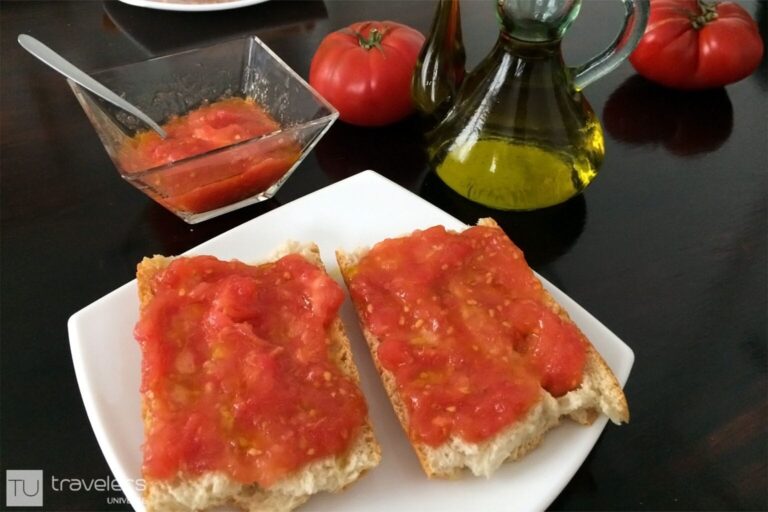
The tomato and olive oil toast is a simple and delicious way to start the day! Optionally, garlic can be rubbed on the bread and the toast can be topped with Serrano ham. Although the origins of this recipe are disputed (some believe it originated in Barcelona , others in Murcia), the tomato and olive oil toast is eaten in many parts of Spain. This is a Spanish breakfast stape but it is also served as an appetizer in restaurants. In Valencia , it is a very popular breakfast choice.
16. Patatas bravas – Spanish fried potatoes with sauces
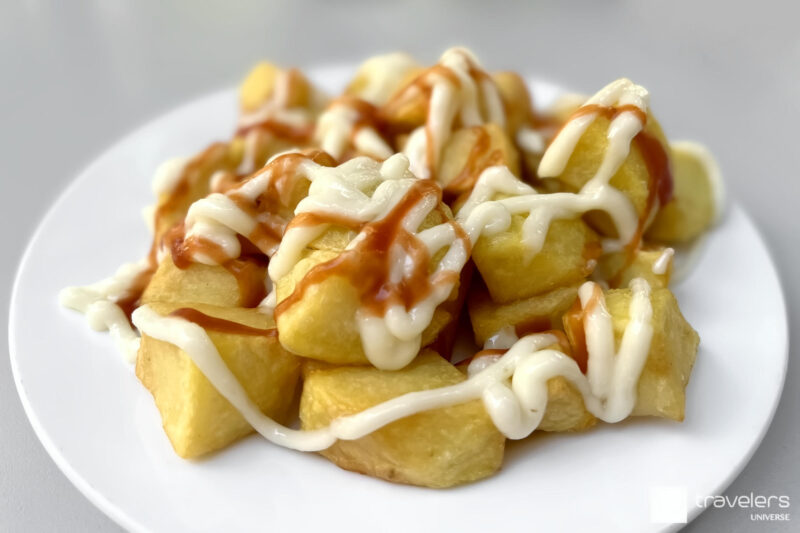
Patatas bravas is one of the most popular tapas you can order in bars around Spain. As is the case with so many other traditional recipes, the genius lies in the simplicity of the dish. In order to make patatas bravas, all you need to do is cut a few white potatoes into irregular cubes and deep fry them until golden. Then top them with spicy sauce and/or allioli (garlic and olive oil sauce). When done right, the result is nothing short of amazing. That being said, making perfect patatas bravas is an art that not every bar can handle gracefully.
17. Pimientos de Padrón – Spanish green peppers
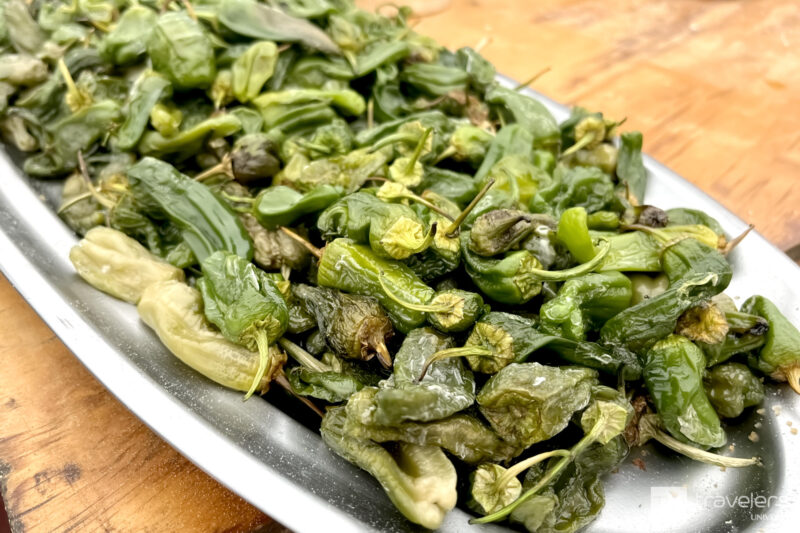
Padrón peppers are a variety of small green peppers, typical of the Galicia region in northeast Spain. Their peculiarity lies in the fact that while most of them are mild, occasionally you can come across one that is particularly hot. Padrón peppers are usually served as tapas or on top of pinchos, usually after frying them in olive oil until the skin starts to blister. A simple food even vegans can eat in Spain.
18. Pulpo a la Gallega – Spanish octopus dish
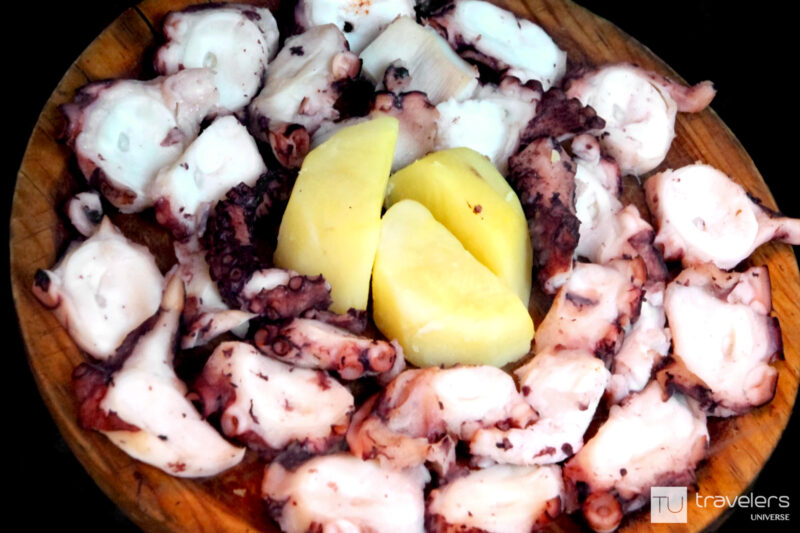
Pulpo a la Gallega is an octopus dish typical of northern Spain. The recipe calls for basic ingredients. Once the octopus is boiled and trimmed with scissors, it is sprinkled with salt, paprika, and olive oil. This traditional Spanish food is usually served on a wooden plate accompanied by a few slices of boiled potatoes.
19. Bacalao al pil pil – Spanish cod with pil pil sauce
Bacalao al pil pil is a dish of Basque origins perfect for fish lovers. It is made by cooking skin-on salt cod in garlic and chili pepper-infused olive oil and it is one of the most traditional cod recipes in Spanish cuisine.
Bacalao al pil pil receives its name from the golden silky sauce made by emulsifying olive oil with gelatine released from the cod. It is a very tasty traditional Spanish food celebrated throughout the country and enjoyed by locals and visitors alike.
Legend says this typical Spanish dish was invented during the Second Carlist War when a local merchant ordered 20 or 22 salted codfish but got 20,022 instead. As the siege of Bilbao started and he couldn’t sell the fish anymore, he began cooking them in olive oil and garlic, thus inventing the famous bacalao al pil pil recipe.
The pil pil sauce can be tricky, so finding a restaurant that prepares it to perfection can be a bit of a challenge, even in Spain. But your chances should considerably go up if you’re ordering it in the Basque Country.
20. Calçots with romesco sauce
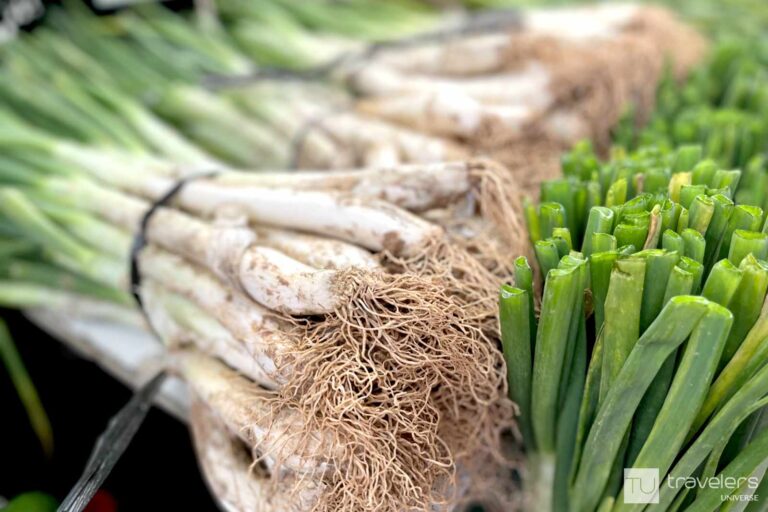
Calçots with romesco sauce is an appetizer typical of Catalonia. Calçots are a variety of spring onions with an extra-large white stalk, typically grilled over an open fire until charred and eaten dunked in romesco sauce — a rich sauce made with roasted tomatoes, garlic, sun-dried peppers, nuts, olive oil, and bread.
The calçots season begins in November and lasts until April. The consumption of calçots skyrockets at the beginning of the year and culminates on the last Sunday of January when the Festival of Calçotada is held in honor of this mild onion in the town of Valls (Tarragona).
Calçots with romesco sauce is one of the messiest foods in Spain. While you can find them on the menu of some restaurants in Barcelona, calçots are meant to be peeled with your bare hands and eaten outdoors as part of a social event.
21. Churros – popular Spanish fritters
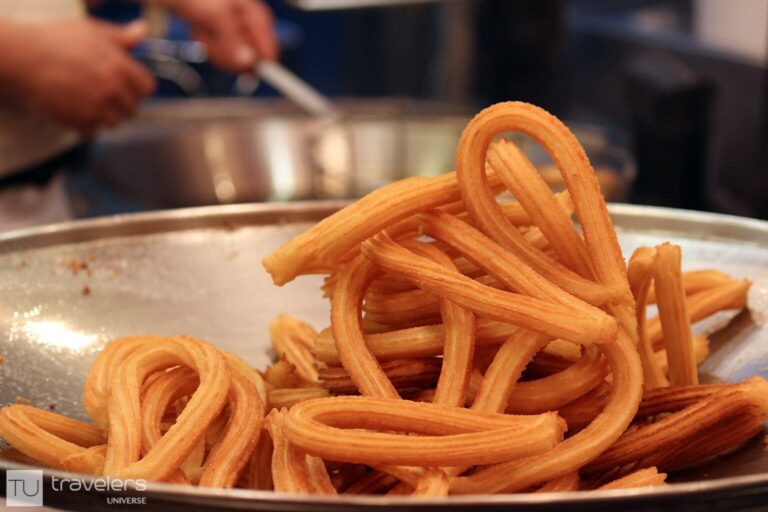
The origins of churros are not entirely clear, yet all evidence points out that modern-day churros were invented by Spanish shepherds some five hundred years ago. So if you have a sweet tooth, you have to add churros to your list of the best things to eat in Spain.
These delicious Spanish fritters have gained worldwide popularity, especially in Latin and North America. But even though you can find churro stands in all major cities these days, nothing compares to eating them dunked in authentic Spanish hot chocolate, which is the most common way of eating churros in Spain. A close second favorite is eating these fried-dough snacks sprinkled with sugar.
In Spain, churros are never eaten for dessert as they are considered a little too heavy to be enjoyed after a full meal. Instead, Spanish people eat churros for breakfast or as an afternoon snack.
Spanish cuisine is rich in fried delicacies. Besides thin crispy churros, in Spain, you’ll also find other fritters such as porras (a thicker, fluffier kind of churro) and buñuelos (a doughnut-like fritter from Valencia). Some churrerías in Spain also serve filled churros, but these are less common.
If you want to know more about these popular Spanish fritters, read these fun facts about churros .
What is the national dish of Spain?
Spain does not have an official “national dish”, since each Spanish region has its own typical dishes handed down through generations. While many non-Spaniards consider paella the national dish of Spain, Spaniards see it as a dish typical of the Valencia region and nothing more. However, there is one dish that is enjoyed all over Spain and that is tortilla de patatas. Therefore, tortilla de patatas is the unofficially national dish of Spain.
What is the most famous Spanish food?
Paella is one of the most globally recognized food items in Spanish cuisine. Churros, tortilla de patatas, gazpacho and jamón are equaly famous.
What is the most popular food in Spain?
Jamón is the most popular food in Spain and the first Spanish food Spaniards miss when traveling or moving abroad. Good Spanish jamón cannot be easily found abroad, nor can it be easily replaced with local hams as it often comes from Iberian pigs raised on a certain diet and is then cured following traditional techniques. Therefore, many Spaniards living abroad usually bring some ham with them every time they go back to Spain to visit their family and friends.
LIKE THIS POST ABOUT TYPICAL SPANISH FOOD? PIN IT!
From paella and tapas to churros, Spain has given the world many delicious dishes. If you’ve enjoyed reading about the best foods to eat in Spain , please consider sharing this article with your friends. Or bookmark it so you can come back to it next time you are looking for new traditional Spanish foods to try, or wondering what to eat in Spain on your next holiday in the sun.
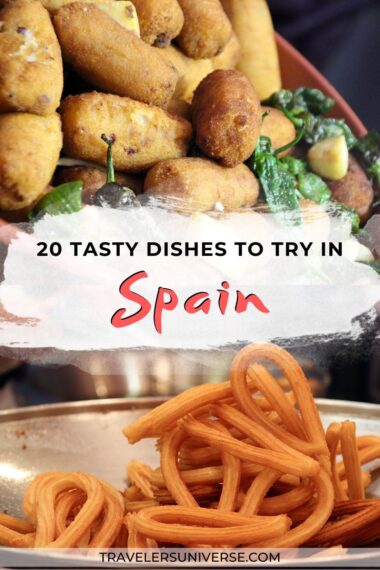
Plan Your Next Trip To Spain With Our Guides

19 Hidden Gems in Malaga, Spain (From A Local)
Discover the best hidden gems in Malaga, from cool hiking trails to fun day trips few visitors ever go on.

10 Best Breakfast and Brunch Places in Valencia
Discover where to have breakfast and brunch in Valencia, from eggs Benedict and bocadillos to the best cakes and coffee in town.

3 Days in Valencia: The Perfect Itinerary (+ Map)
Planning a 3 day trip to Valencia? Here’s one way you could be spending your time.

20 Hidden Gems in Barcelona, Spain (From A Local)
Discover the best hidden gems in Barcelona, from secret gardens and viewpoints to lesser known modernist buildings.

2 Weeks in Spain. The Perfect Train Itinerary for Culture Lovers
If you want to travel through Spain and experience this beautiful and diverse country, this 2 weeks cultural itinerary is the perfect introduction.
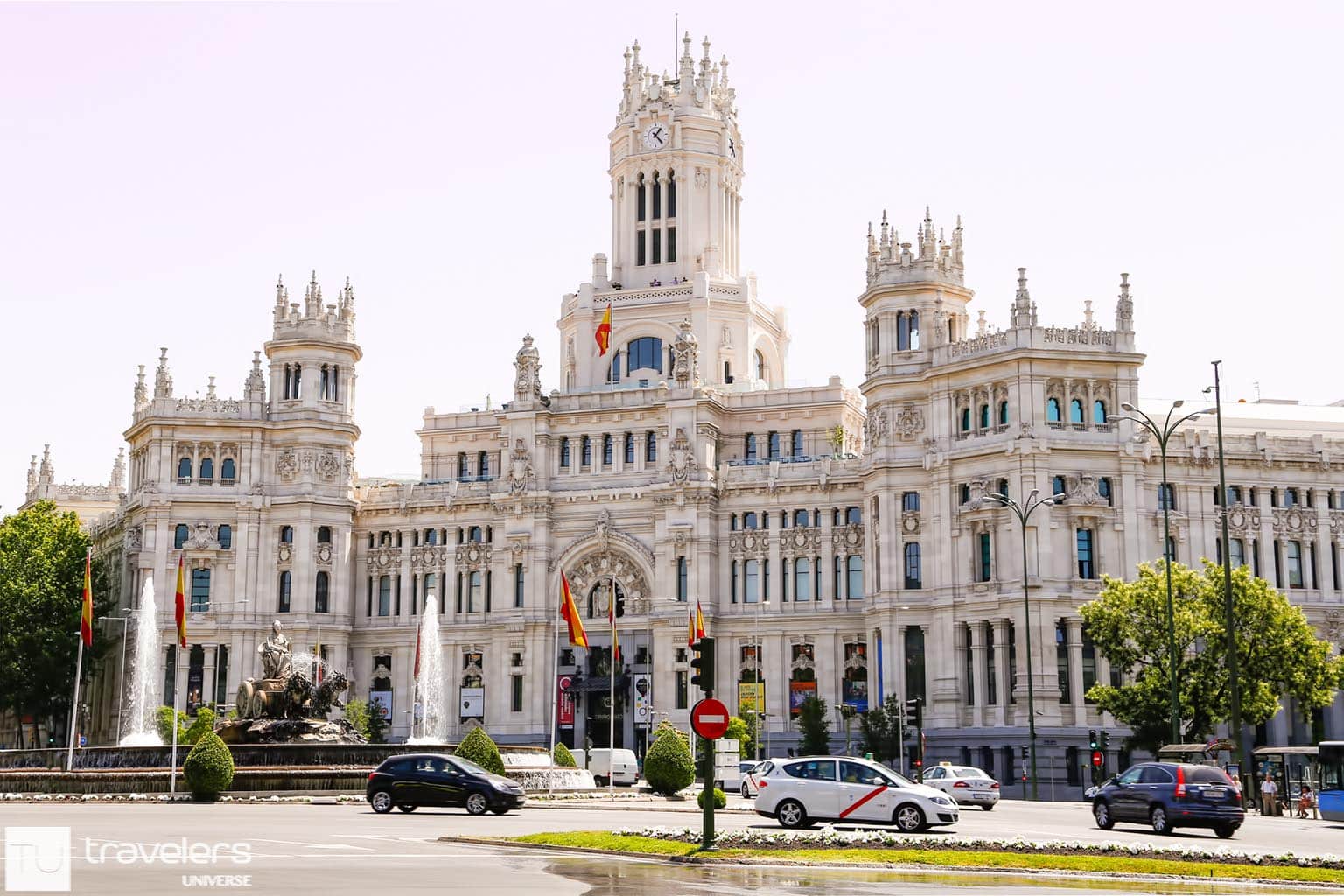
3 Days in Madrid: The Ultimate Madrid Itinerary (+ Map)
Plan your next trip to Madrid with this detailed city guide that covers what to eat, where to stay and the best attractions and things to do in Madrid in 3 days.
- Travel to Spain
What to Eat in Spain: 31 Tasty & Traditional Dishes

Win a FREE Trip to Spain!
Exciting Announcement! For the first time, we're thrilled to offer exclusive trips to the heart of Spain - an experience like no other. This isn't your typical tourist journey; it's a unique opportunity to immerse yourself in authentic Spanish culture, alongside real locals and our passionate team.
But there's more! Simply by requesting information about this amazing trip, you'll be entered into a special draw to win a Fully Paid Trip to Spain for Two. And that's not all - everyone who inquires will receive an exclusive bonus gift, valued at $500, available only now.
Click Here ↑ to Request Information & Enter the Draw!
One of the most challenging things about eating in Spain is that you can’t try everything, even if you wish. But hear me out before you start shaking!
Gastronomy is one of the most fantastic ways Spain expresses its identity.
And curiously, it is difficult to speak of the national cuisine of Spain as a whole. Instead, traditional food is made up of many regional cuisines that use an endless variety of quality products.
So, if you are still determining what the dishes in Spain have in store for you, or you are just looking for more flavors to taste outside of your usual meals, then get your taste buds ready!
Must read: I have created a guide for Eating Out in Spain that is also very helpful— Eating Out in Spain: Where to Eat & Best Food to Order
Well, from Tortilla de Patatas to something as exotic as Boquerones en Vinagre , read on to discover 31 Spain food favorites to try and taste while in Spain.
Table of Contents ▼ ▶
1. Tortilla de Patatas
The famous Tortilla de Patata is one of the most popular dishes in Spain, consumed in every home, and is the most requested tapa in bars and restaurants, no matter in which province or region you are.
Any time of the day becomes an excuse to enjoy this dish, and it is a must at any party or gathering with family and friends.
It has simple ingredients: eggs, potatoes, and salt . Although you can taste great tortillas stuffed with ham, truffle, cheese, and alioli. But the key to making the best one is using high-quality products, timing, heat, and technique.
Spanish people divide into two groups: those who say the tortilla does not include onions and those who are normal human beings (just kidding).
Tip: Rumor has it that the best tortilla in Madrid is in Casa Dani.
2. Paella Valenciana
Besides being one of the most emblematic dishes in Spain, the Paella is an authentic, traditional, and popular stew created by the Valencian farmers with the ingredients they had at hand ages ago.
With time and the experimentation of new flavors, this dish has been incorporating ingredients that enhance flavor and textures.
But, the ones that can not be missing are rabbit and chicken, flat green beans, garrofones (a legume similar to broad beans), ground paprika, saffron, squid, norway lobster, monkfish, shrimps, and mussels.
Everyone agrees that the best place to try the Paella Valenciana is, without a doubt, the region of Valencia!
However, this dish has risen to many variations of delicious typical rice dishes, which are preferred over Paella for many people, such as Arroz con Bogavante , Arroz Negro , and other classics we will see later.
3. Cocido Madrileño
The one and only comforting dish for Madrilenians during the colder months.
The Cocido Madrieño is a stew with chickpea or garbanzo as the main ingredient. As for the veggies, it has mainly potatoes, cabbage, and carrots; in some cases, green beans or green-leaved veggies are also added. Also, the meat is fundamentally pork belly (fresh or cured), chorizo, onion, morcilla, and dried and cured jamón serrano .
The dish is usually eaten in two or three courses. First, you eat the broth like soup as the first course. Then the rest of the tasty ingredients become the main course, often in two rounds. First, the chickpeas and vegetables, and then the meat.
You can eat it all together if you can! This meal is for champs, after eating this, you’ll definitely want to enjoy a Spanish siesta.
4. Pulpo a la Gallega
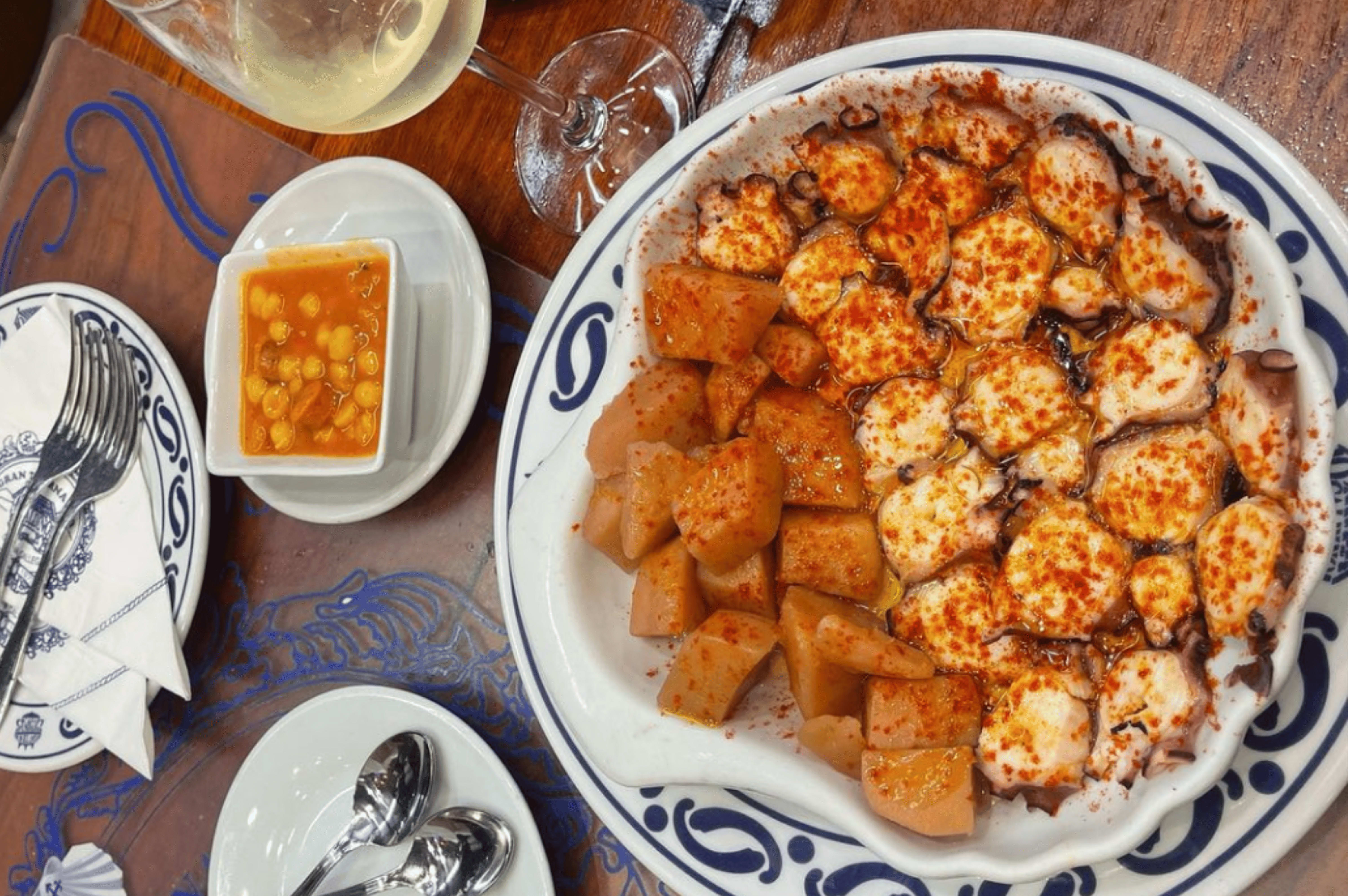
You should not miss this dish while in Spain. The famous Pulpo a la Gallega is full of flavor, life, and sea!
Curiously, back in time, the octopus was one of the few seafood products brought from Galicia to the north of León during “ Las Ferias de Ganado."
In Galicia, the produce was rehydrated with olive oil and seasoned with paprika for better preservation during the trip.
That is why the origin of this recipe resides in León, even in Extremadura, according to some. Still, it soon began to be served in Galicia as well.
With time, Galicia added a boiled potato as a garnish, differentiating it between the “ Pulpo a feira .”
This dish is found in many parts of Spain today due to its immense flavor. Definitely a must-try!
5. Gambas al Ajillo
“ Gambas ” or prawns, is the name given to crustaceans.
These are like shrimps, yes. But Spain only uses that term to refer specifically to the tiny ones.
This recipe was born when garlic was one of the most used ingredients for cooking. Inside the dish, you’ll find: prawns, garlic cloves, chili pepper, olive oil, salt, and chopped parsley.
This simple dish is consumed in practically all coastal and non-coastal bars in Spain. In short, in all of Spain.
Traditionally this dish is prepared directly in a clay or terracotta casserole, suitable for the oven. As is said that its material enhances the flavor!
6. Gazpacho y Salmorejo

Gazpacho is an ideall summer dish. It is a cold soup usually served as a first course.
It usually consists of tomato, bell pepper, cucumber, garlic, bread, salt, extra virgin olive oil, and vinegar.
Gazpacho and Salmorejo are often confused, but the main difference is that Salmorejo uses tomatoes as the main star while gazpacho adds others, such as cucumber and bell pepper, and water.
Both recipes are convenient because they are cheap, refreshing, and nutritious, so they have become a household staple.
7. Jamón Ibérico de bellota
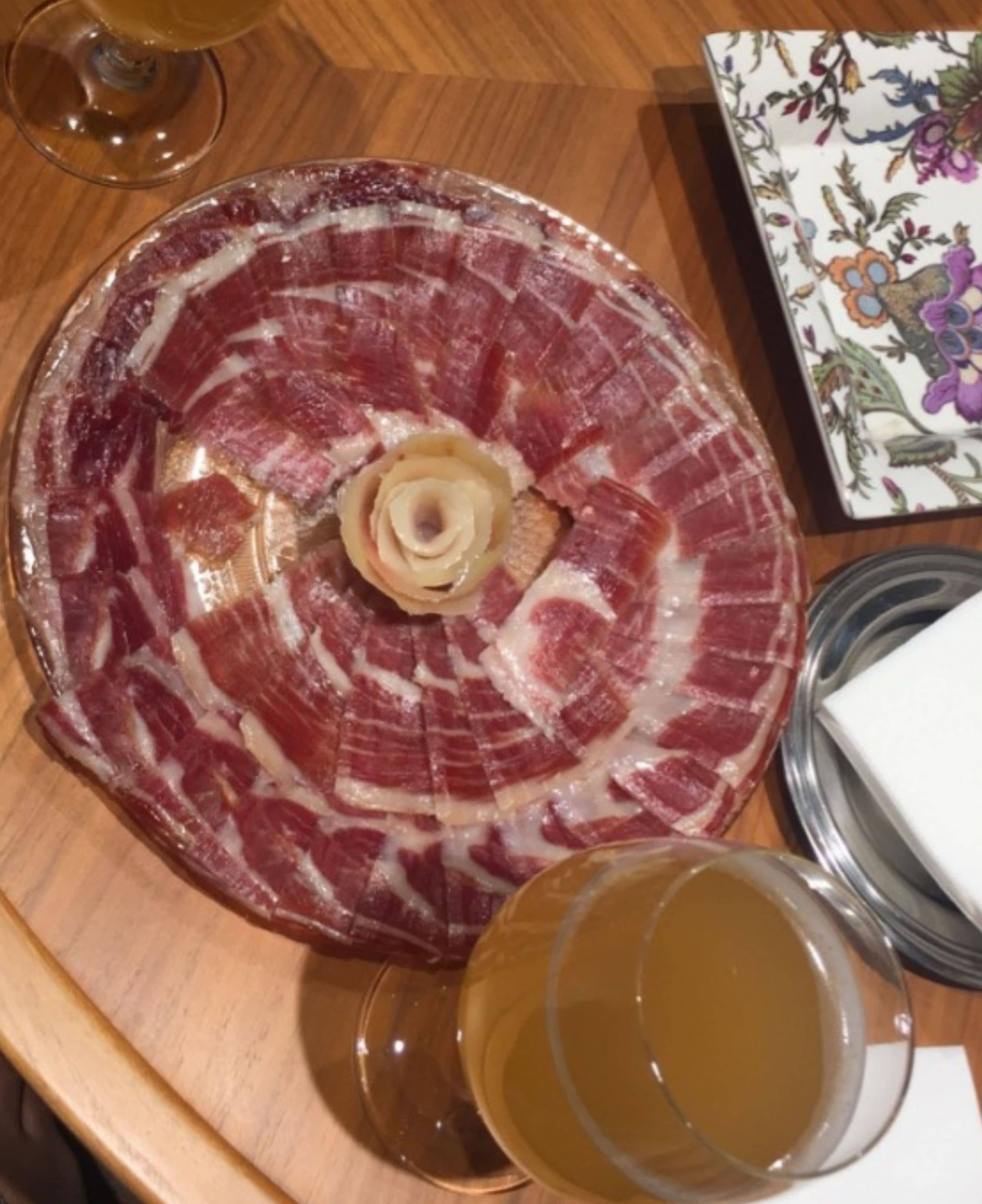
The “ Jamón Ibérico ” is one of the emblems of the Mediterranean diet.
Spaniards enjoy it at any time. It can be at mid-morning as tapas, a starter to a good meal, or an appetizer to open the mouth before dinner. You name it! The Iberian ham is the perfect pick-me-up snack!
You should know that there are differences between the quality of the ham you can find out there. The flavor, texture, and taste of this superfood depend on the origin and feeding of the animal, and finally, how the ham is cut influences the flavor.
While the famous “ Jamón Ibérico de Bellota ” comes from 100% Iberian pigs fed on acorns, so it is considered the best quality!
8. La Fabada Asturiana
It is the traditional dish of Asturias’ cuisine and one of the best known nationally. It is a bean stew with Asturian Faba beans (in Asturian called fabes ), sausages such as chorizo and Asturian morcilla, cured pork shoulder, and cured bacon.
The main ingredient, fabes beans, is a native legume, slightly larger than beans and much more buttery, which provides a tastier final texture. Also, they are not the same as Fava beans, which look more like edamame, but they are not.
And these beans are always accompanied by a compango , which is the name given to the set of meats added to the stew.
9. Patatas Bravas
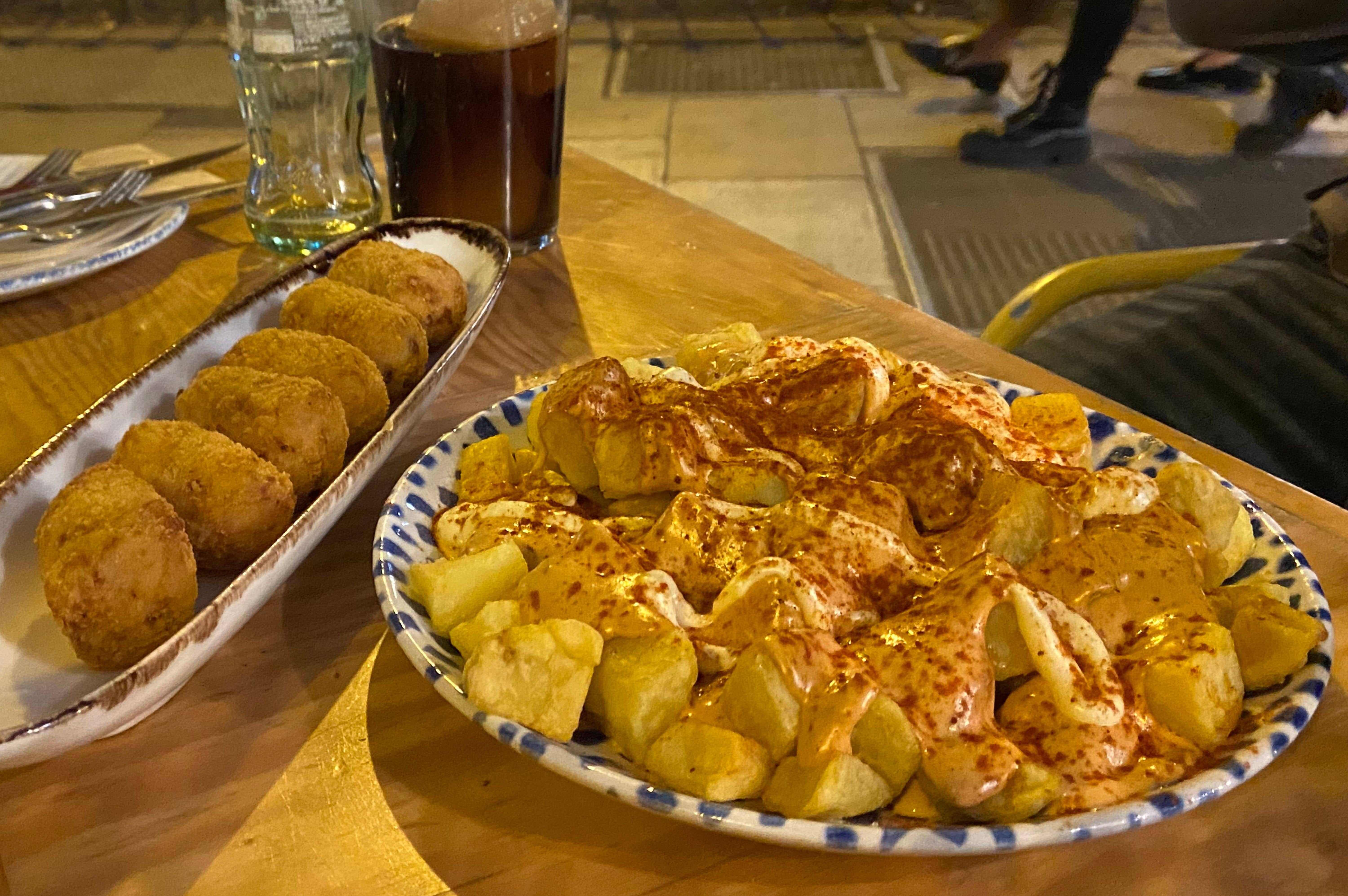
The delicious papas bravas , also known as patatas bravas or patatas a la brava , are a classic tapa that cannot be missed in Spanish bars.
They are called “ bravas ” (translated as brave) basically because of the spicy flavor of the sauce. Although they are not so spicy compared to other gastronomies like Mexican. So don’t be scared.
The exciting thing about this dish is that there are infinite variants and ways to prepare them, depending on the cook, which has become a matter of who prepares the best bravas .
The best is to pair them with alioli (A sauce made with crushed garlic and oil to which egg yolk is sometimes added). This combo is superior!
10. Callos a la Madrileña
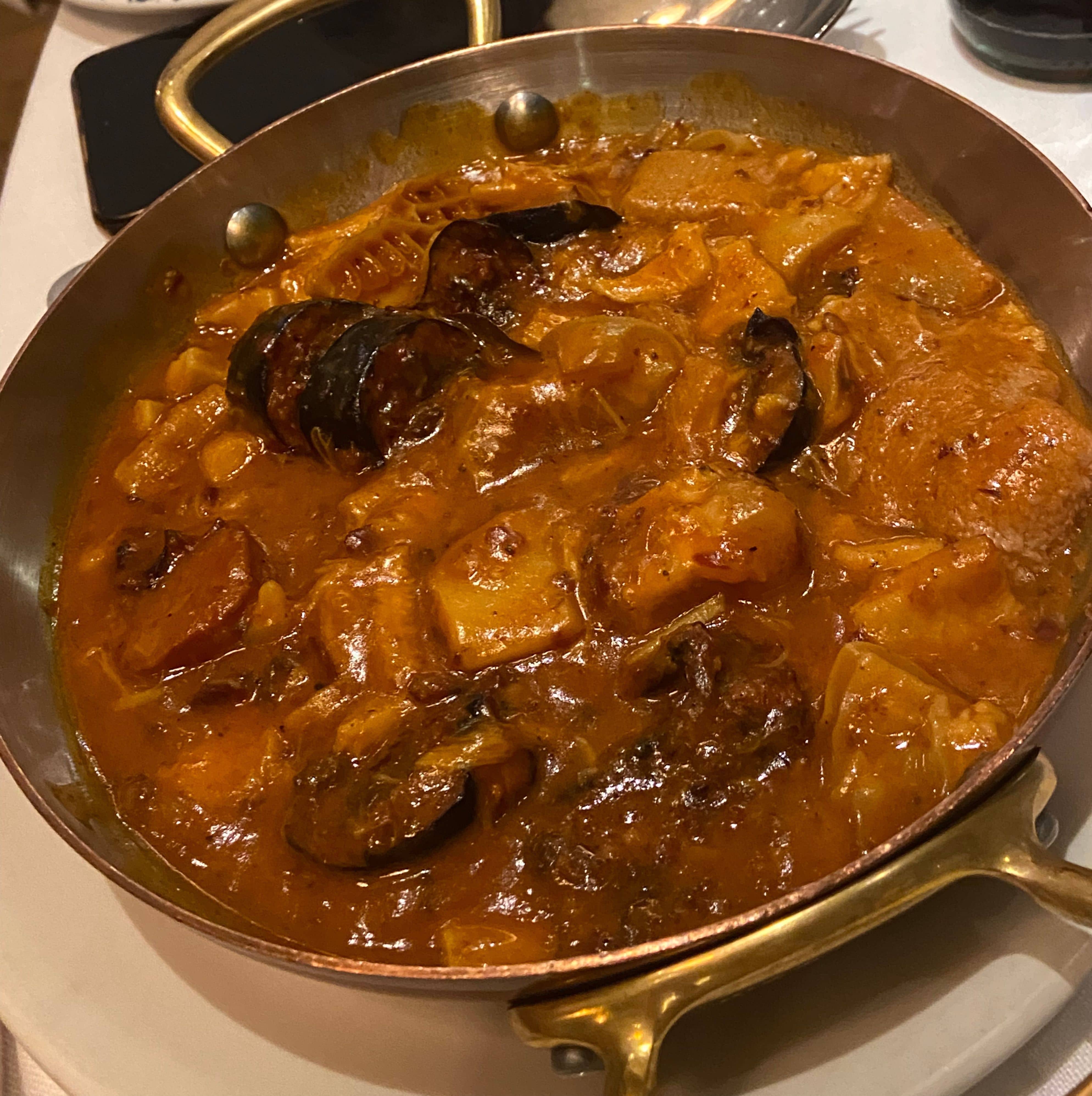
Callos a la Madrileña is one of Madrid’s most recognized and appreciated dishes.
The so-called Callos , or tripe, is the main ingredient of this traditional stew, usually eaten with bread to dip in the sauce. It contains beef tripe, Asturian chorizo, black pudding, dried chili pepper, pig’s trotter, bacon, tomato sauce, onion, carrot, etc.
And among the spices that make possible the explosive and powerful flavor of this dish are cayenne powder, ground bay leaf, sweet paprika, ground cumin, and ground black pepper.
Also, you should know that the Madrid version is far from the Galician one. In Galicia, tripe is usually served with chickpeas, while in Madrid, we don’t add them.
In addition to Galicia, you can find callos a la andaluza or callos a la asturiana . The same thing happens to any tripe recipe, a very typical ingredient.
11. Bocadillo de calamares
Besides being a squid sandwich, the famous “ bocadillo de calamares ” is part of a very characteristic custom in Spain, the sacred Spanish tapas, sharing a meal with friends or family on any terrace, and informal dinners. This dish is a must-try while in Spain.
They are also known as “ bocadillo de rabas, ” popular in northern Spain. You can easily find them in several bars and restaurants in Cantabria and the Basque Country, where the coasts provide fresh squid.
It is one of those plates that will never be missing on a typical taverna madrileña. Also, we could say that bocadillos are a Castillian “fast food,” As many modern kitchens have adopted this recipe and created their own.
For example, in Castellana in Madrid, there’s a place called Punk Bar, where they have a modern version of a bocadillo that is really worth trying!
12. Arroz con Bogavante
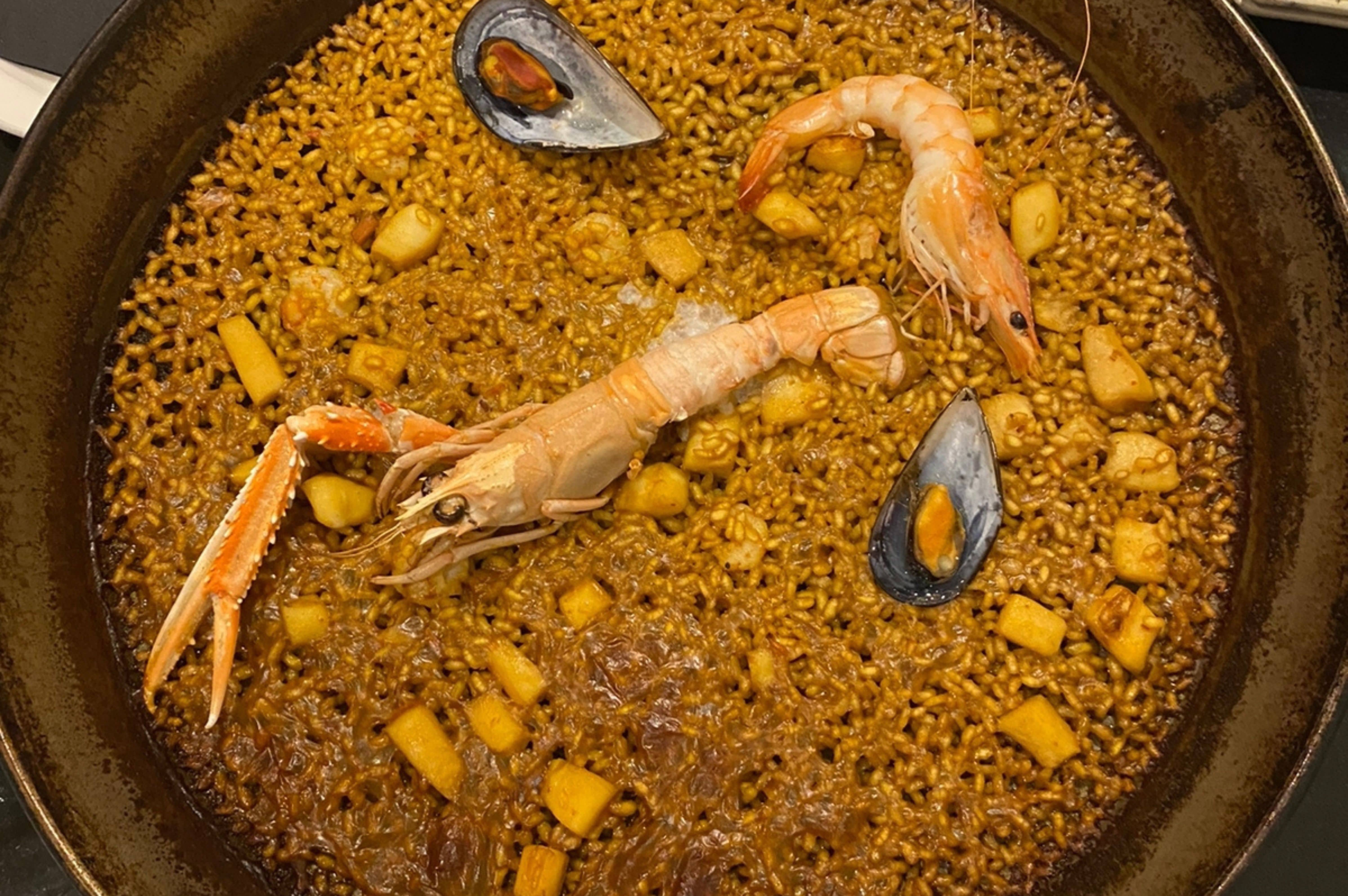
This is an incredible complete dish, very typical of the Spanish coastal towns. It is often confused with Paella because of how it is prepared and served in the same “ paellera ” or “ caserola ” and because it looks like it is the same. However, it is different from Paella Valenciana.
It has round rice, tomato, Italian green bell pepper, red bell pepper, fish broth or fumet, garlic clove, and fresh lobster.
It is usually served, like all rice dishes, freshly prepared. And this type of rice can be cooked dry or with broth, leading to an “ arroz meloso or caldoso ” with a creamier texture, like this variation:
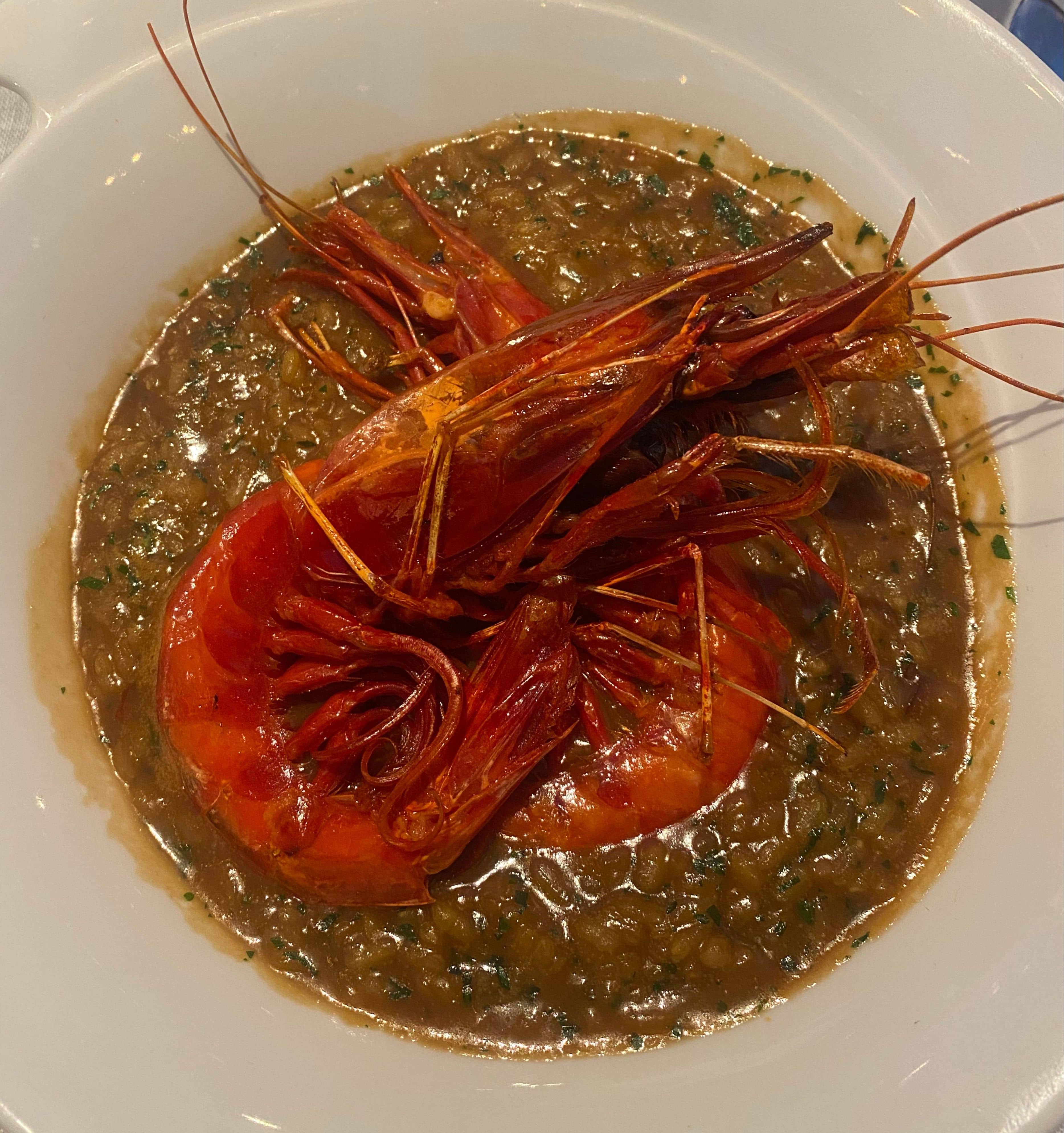
This tasty rice with lobster has fibrous meat with little fat and intense flavor. In Spanish gastronomy, eating lobster is typical in celebration meals, family gatherings, formal meals, and so on.
13. Croquetas
Croquettes are fried buns consisting of a thick binder and a filling. I’m sure you’ve heard of them before, as they are well-known internationally, but believe me, Spanish croquettes are out of this world.
They are served as a side dish, snack, or fast food worldwide.
The dough contains oil, milk, flour, garlic, onion, parsley, egg, and bread crumbs. While the filling can be whatever you want, but preferably usually, proteins such as chicken, ham, cod, and mushrooms.
A very curious fact is that croquette doughs were previously made from leftovers, usually chicken or ham, from previous days’ dishes.
In fact, serving stew on Wednesdays and Thursdays in many Spanish homes and restaurants was a tradition to save the leftovers for croquettes.
14. Cochinillo Asado
The roast suckling pig is one of the most typical dishes of Castilian cuisine, especially in the city of Segovia.
This dish’s hype lies in the roasted pig’s tenderness and demonstrating how delicate the meat is by cutting the pork with a plate instead of a knife.
The meat is juicy, super tender, and melts in the mouth with lots of flavors, while the skin is perfectly crispy!
The difference between suckling pigs and the pigs we are familiar with is that the piglets are much smaller than the typical outdoor roasts. They can be hard to find in the USA and are about one-third the size.
In Segovia, you can’t miss the famous cochinillo de Jose Maria. This traditional and long-standing restaurant is frequently awarded for its cochinillo asado, which they cut with a plate right before you!
15. Escalivada
This is a traditional dish from Catalonia, Valencia, Murcia, and Aragon of smoked, grilled vegetables, usually composed of peppers, eggplants, and other roasted vegetables.
Depending on taste, sometimes potatoes, artichokes, tomatoes, leeks (calçots), or garlic cloves are also blanched.
It is very famous for how easy, nutritious, and delicious this recipe is. Its versatility allows it to be a complete meal by pairing it with hard-boiled eggs, fish (such as anchovies, sardines, or salted cod) or eaten with sausages (such as chorizo criollo or chistorra).
16. Ensaladilla Rusa
The Russian salad is a mythical recipe in every bar and our grandmothers and mothers’ houses.
The recipe is originally from Russia, but Spain adopted it by giving it a unique touch!
Although it is a perfect side dish, the Ensaladilla Rusa is also eaten as a tapa, as a first course, for dinner, or as a sandwich. The ingredients are as follows: large potatoes, carrots, peas, tuna in vegetable oil, olives stuffed with anchovies or peppers, hard-boiled eggs, mayonnaise, and salt.
As you can see, it is a complete dish since it combines vegetables, fish, and eggs.
17. Pisto Manchego
This dish of chopped and fried vegetables is another classic in the Spanish recipe book and a must in traditional Spanish houses.
This is a “humble dish” initially prepared by the peasants of La Mancha with the products of the garden.
Among the main ingredients are onion, zucchini, green pepper, red pepper, tomatoes, olive oil, garlic cloves, and bay leaf. Although the ingredients can vary throughout the country, every house gives its personal touch and seasoning with the available ingredients.
Plus, adding a fried egg on top and crushing that yolk with a piece of freshly baked bread is something you MUST do to eat this dish as an authentic Spaniard!
18. Arroz negro
Another rice dish? Yes, keep ’em coming!
Rice is a very popular preparation in our country, so the famous Arroz Negro is an exceptional dish you should not miss in Spain, as it is one of the tourist’s favorites while they visit.
The most characteristic of this rice is precisely the black color of the rice and a flavor reminiscent of the sea thanks to the squid ink incorporated into the preparation of the fish broth that is added to the rice, which then dyes this rice.
The most important ingredients are bomba rice, fish broth or fumet, squid ink, cuttlefish, garlic cloves, tomato, saffron strands, extra virgin olive oil, paprika, and of course, a paellera !
It is eaten freshly prepared, and you must accompany it with a homemade alioli sauce to enhance the experience.
19. Pescaíto Frito
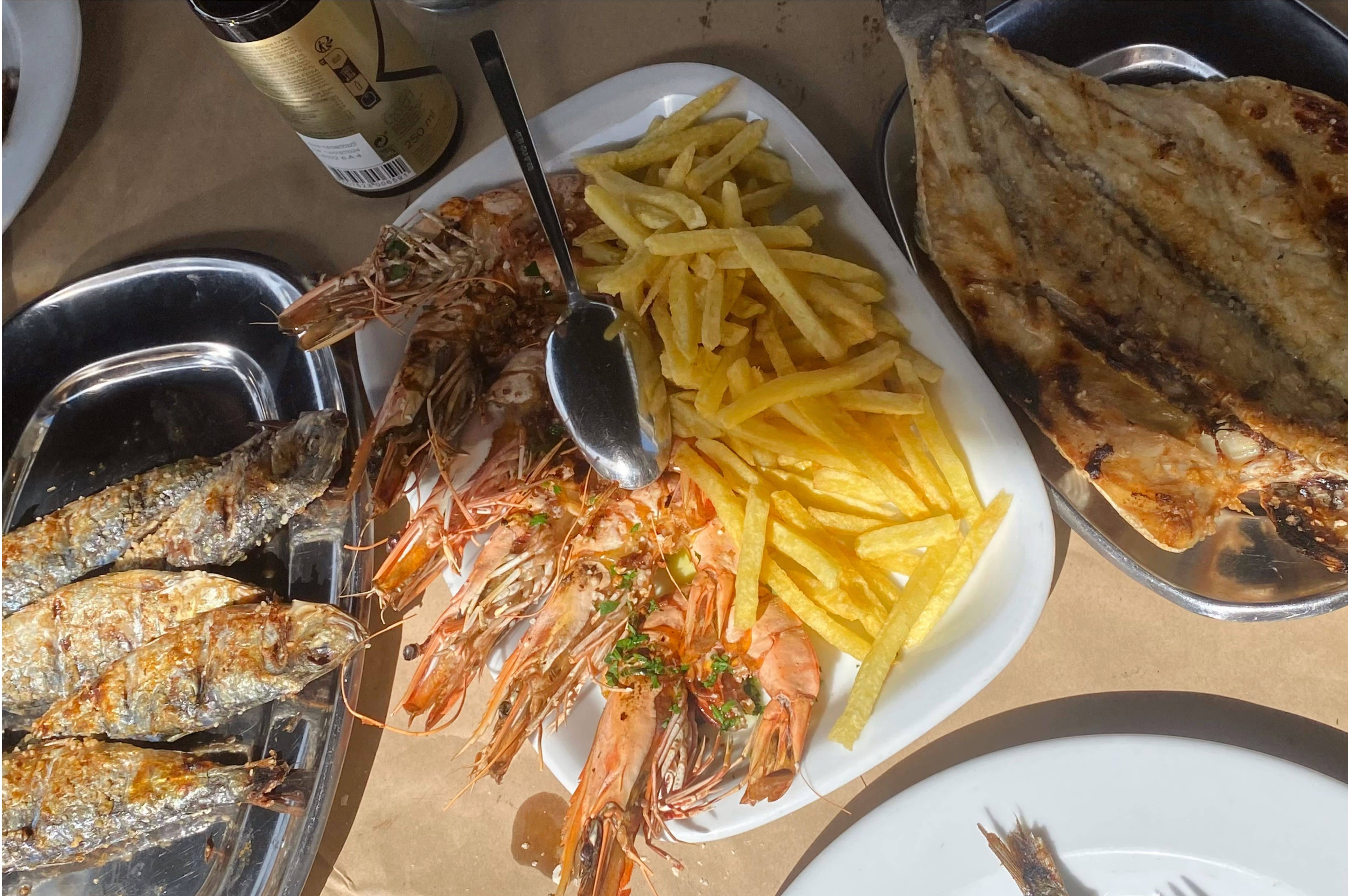
This is one of the most popular specialties in the Andalusia region in southern Spain.
It is a simple but delicious dish of crispy fresh fish dipped in a thin layer of flour and fried in oil until golden and crisp. Today it is a tapas option you should try if you are in the South, for example, in Cádiz, Málaga, and Huelva, where it is consumed the most.
They are called “pescaíto,” a diminutive of “ pescado ,” since this fish is smaller than a regular one. They have a unique flavor and provide a crispy texture on the outside and juicy inside.
The best ones are usually the “ choquitos ,” the “ calamaritos ,” the “ acedías ,” or the “ boquerones .”
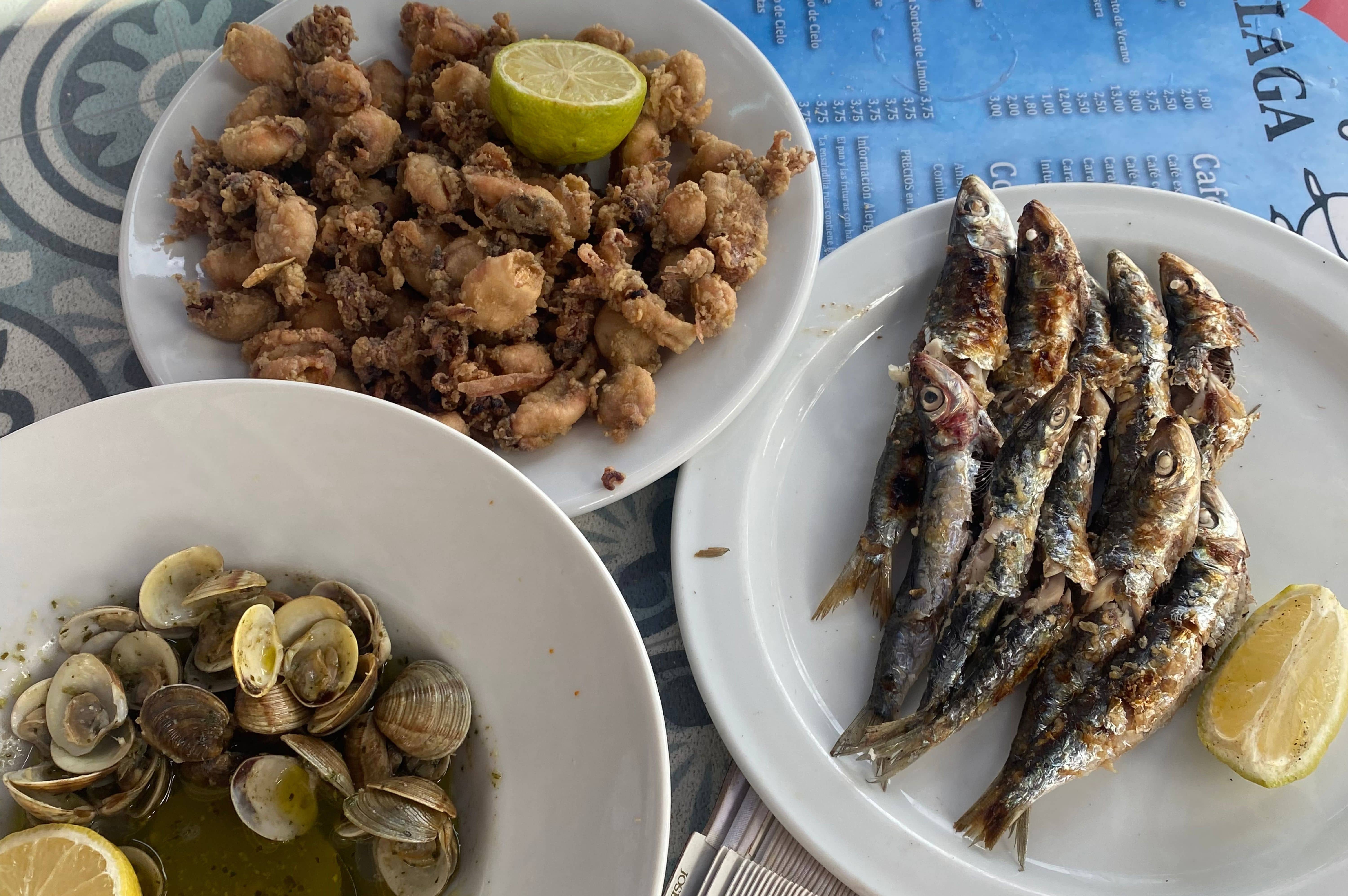
20. Migas Extremeñas
Migas is one of the most traditional dishes of the gastronomy of Extremadura and is super convenient for breakfast, in between meals, or as a side dish at lunch. This plate was traditionally prepared in rural areas as a main meal.
The famous migas are made with laminated or crumbed bread, sautéed with fat and meat from different animals in a simple refried sauce of garlic, tomato, pepper, and onion.
21. Chuletón Navarro
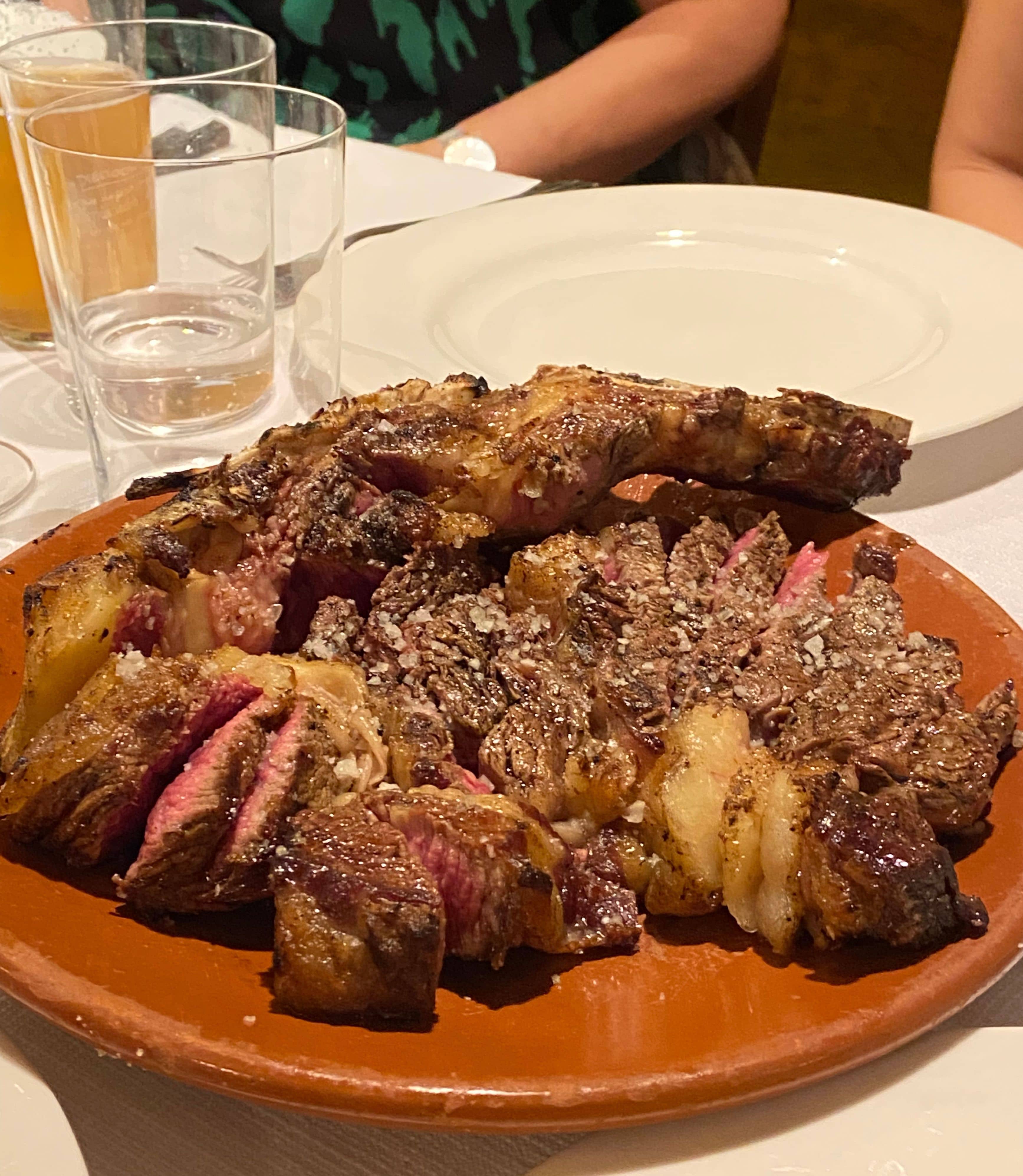
Please, do yourself a favor and try the famous Chuletón Navarro while in Northern Spain.
The T-bone steak is one of the excellent references of Navarre gastronomy.
This dish is very typical in the mountain area. They can be roasted with vine shoots which provides a particular taste.
I recommend accompanying it with some rich piquillo peppers that go with everything.
22. Lechazo o cordero lechal al horno
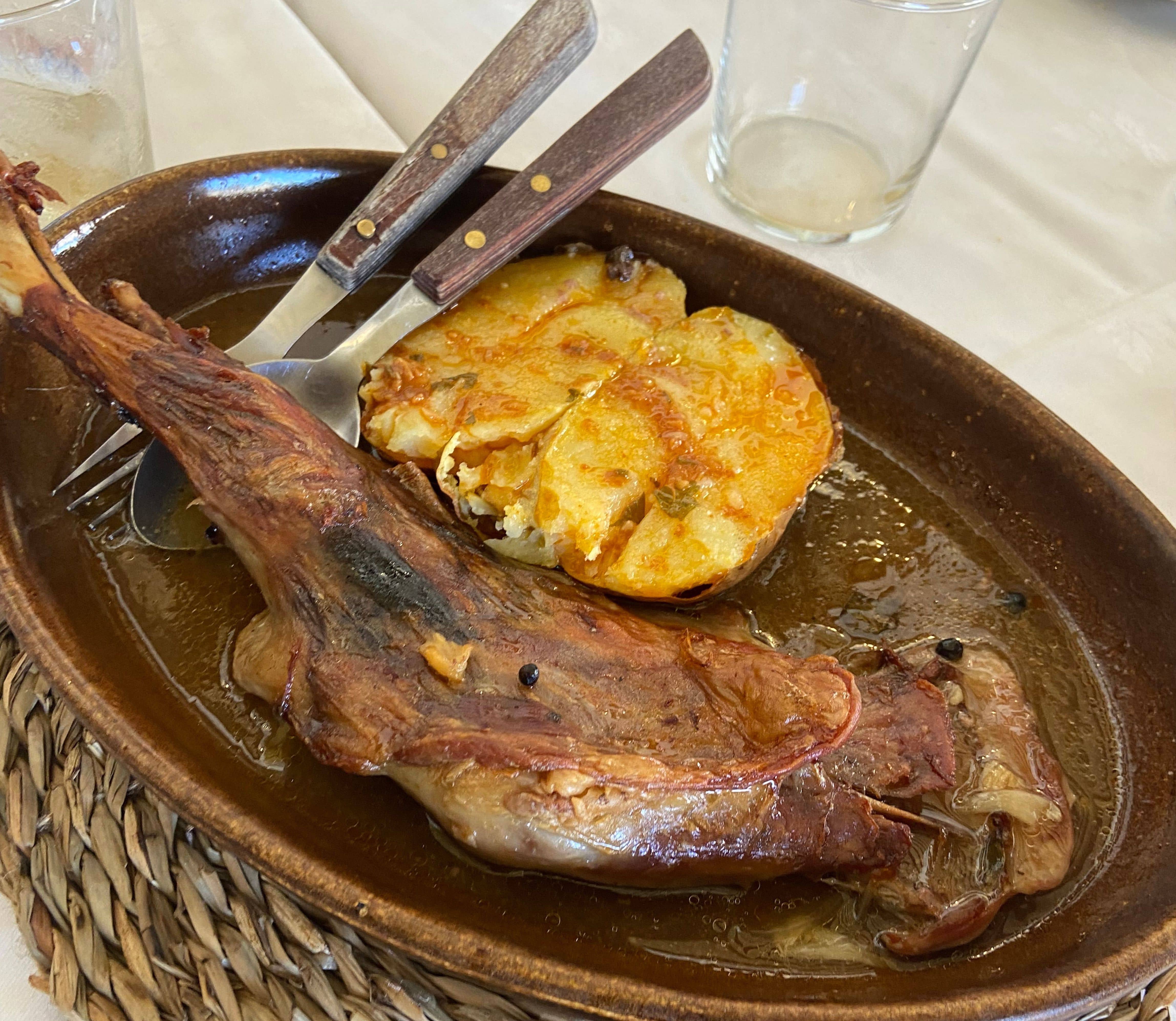
The “ Lechazo ” or “ Cordero lechal ” is prevalent in Spanish cuisine on special occasions and during traditional celebrations in Spain.
It consists of very tender meat with little intramuscular fat, incredible juiciness, and a very soft texture with a pearly white or pale pink color.
The roast lamb is a roasted variety of lamb not yet weaned. Traditionally it is made in a wood-fired oven, in clay pots, and served to diners hot, with crispy outer meat.
It is one of the most important dishes of the gastronomy of Castilla y León and in Asturias.
The suckling lamb is consumed mainly at Christmas gatherings. To see more typical dishes that adorn the tables during the dates, visit the following post:
13 Delicious Foods My Spanish Family Eats on New Year
23. Rabo de Toro
Rabo de Toro is a typical stew frequently cooked in various Andalusian cuisines, specifically in Córdoba.
This is a stew, ragout, or stew of meat cut into small pieces of cow or bull tail.
It is a very traditional dish to discover Andalusian gastronomy at its best.
24. Pintxos vascos
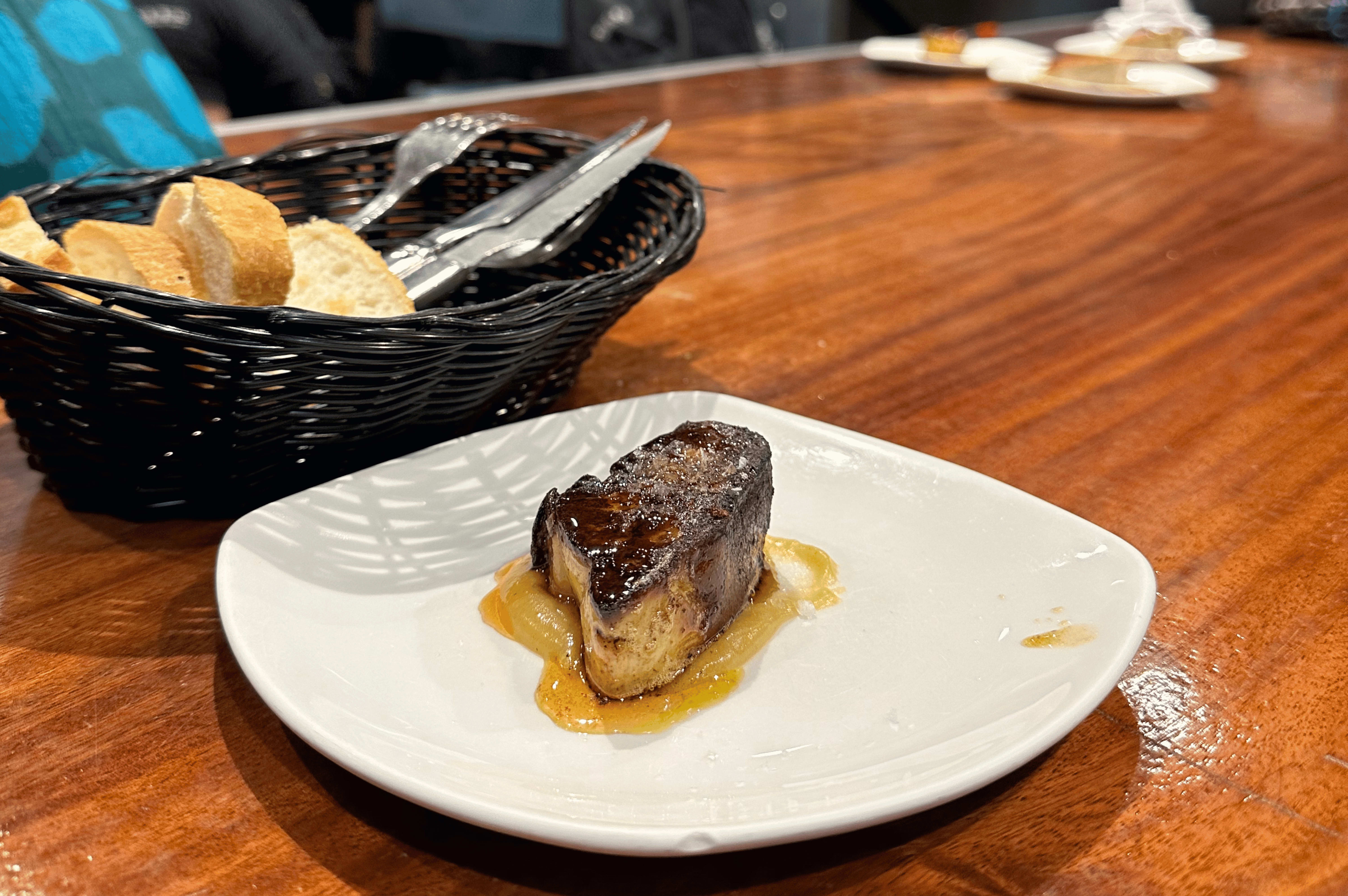
Pintxos are bite-sized appetizers served in bars and taverns throughout the Basque Country. They are the most representative of Basque cuisine and the center of the local gastronomic culture, mainly found in Bilbao and San Sebastián.
In short, “ Pintxos ” are small-sized pieces of heaven!
In Basque, they are called “ pintxos ” because the food was initially attached to the bread with a toothpick (although it is not mandatory).
Some features can serve as a guide to differentiate a pintxo from a tapa. For example, they tend to be smaller than traditional tapas. It usually is a bite, not to share; They have a better elaboration and assembly, whether cold or hot; He usually has a skewer (obviously); It usually goes on bread, although not always.
If you visit San Sebastián, try el “ pintxo de foie ” at La cuchara de san telmo, the “ pintxo de txuleta ” or “ pintxo de carrillera ” in Gandarias and the “ pintxo de erizo ” in Casa Vergara. They are absolutely fantastic!
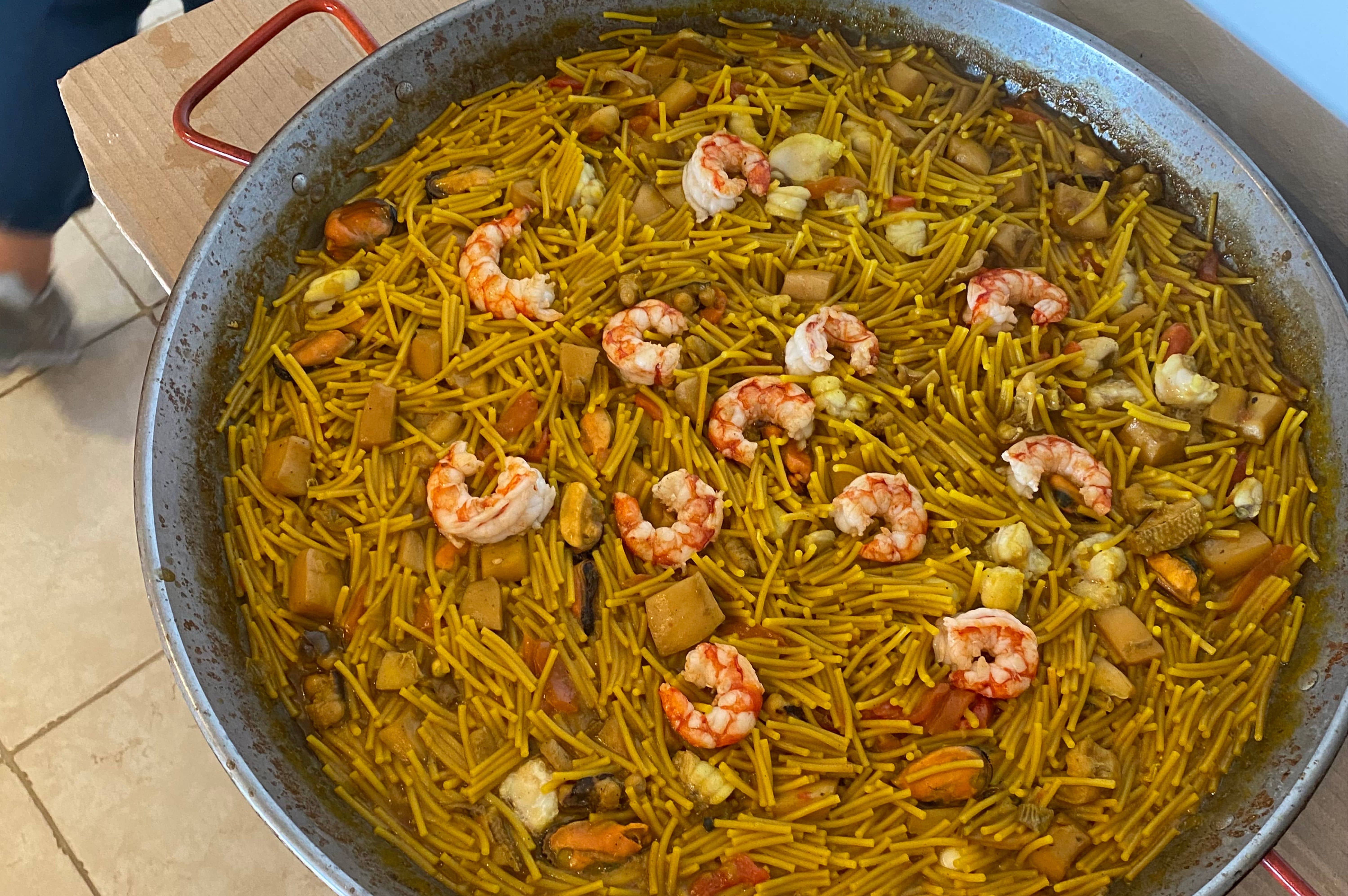
The fideuá is a seafood dish originally born in Gandía but has now spread to the entire Valencian Community.
It is similar to Paella , and even more so to arròs a banda, and is also cooked with a paellera.
Its main ingredients are pasta noodles (often hollow), fish (rockfish, monkfish, cuttlefish, squid), shellfish (squilla mantis, shrimp, crayfish), red pepper, green pepper squid, homemade fish broth, saffron or coloring that gives the deep flavor of the sea.
La fideuá and Paella’s main difference is that the first has noodles instead of rice.
26. Boquerones en vinagre
Boquerones en vinagre are a common appetizer or tapa found in Spain’s most traditional and typical bars and tavernas .
These are anchovies marinated in vinegar, resulting in a cold and acid marinade or “ escabeche. ”
At this point, there might be some confusion between anchoas , bocarte , and boquerones. But it’s the same fish. The difference is that the anchovies we usually know (often used as a pizza topping) are salty.
While the ones that are in vinegar or the fresh versions that are fried are called boquerones en vinagre or boquerones fritos.
Also, in the South, people use the term boquerones more. While anchoas and bocarte are synonyms that are used more in northern Spain.
27. Crema Catalana
Now let’s fish strong with the sweetest dishes in Spain.
The famous and delicious crema catalana is undoubtedly the most typical dessert of Catalan cuisine.
It is pastry cream with an egg yolk base covered in a crunchy layer of caramelized sugar. Some consider it an evolution of custard, while others compare it to the French crème brûlée. However, the Catalan cream is way on top of that league!
You will mostly see it in its classical version, accompanied by a small cookie cone that breaks the candy on top.
Also, Catalan cream is associated with Saint Joseph, served on the saint’s feast day. This explains why this desert is sometimes found in Catalonia as Sant Josep cream. To see related holidays, read this article:
28. Churros
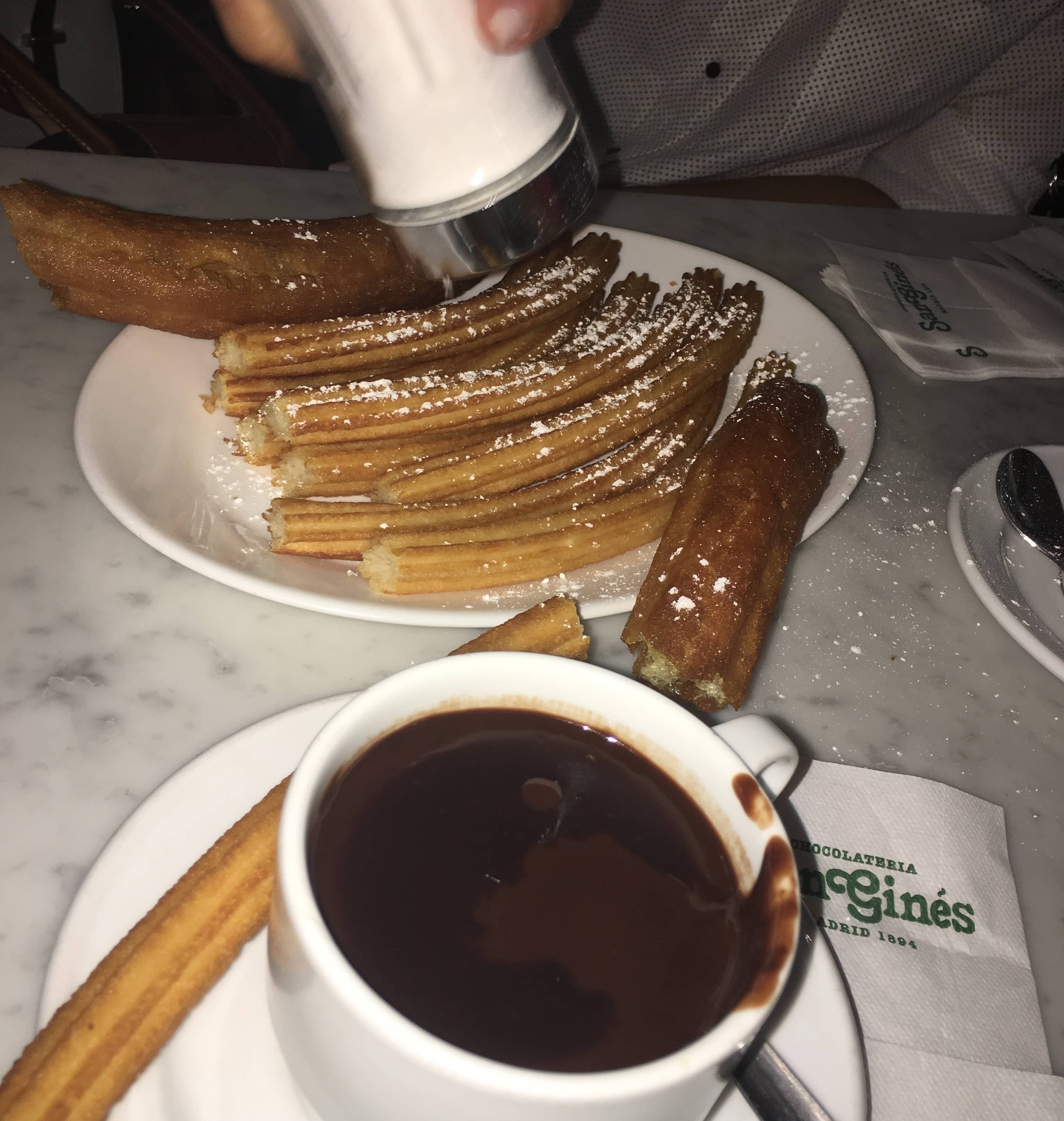
Simply iconic.
Chocolate with churros is a typical sweet dish of the gastronomy of Spain.
“C hurros ” is a dough made from wheat flour cooked in oil in the shape of a star and are served with all manner of fillings from chocolate to jelly, custard, and even Nutella if you want.
The main difference between Churros and Porras is in the dough. These two are like cousins, but the key is in the dough. Churros are made with boiling water so that the yeast burns. On the contrary, Porras require warm water, which gives them a more spongy texture.
This dish can be consumed for breakfast or as a snack and is usually taken more frequently during the cold winter. Also, one of Spain’s most important New Year’s Eve traditions is eating churros on January 1st! Read more:
29. Torrijas
Torrijas deserve a VIP spot in heaven.
The French toast is a sweet dessert of European origin but with a long tradition in Spain.
It consists of a slice of bread, other than fresh, soaked in milk or wine and, after being coated in egg, is fried in a pan with oil.
Then, it is sweetened with honey, molasses, or sugar and flavored with cinnamon. It’s similar to French toast but with a twist!
This dish is typical of Cuaresma and Holy Week mainly because, back in time, people needed to do something with leftover bread. Since meat could not be eaten, bread was less consumed since Spaniards always paired meals with a piece of bread.
30. Arroz con Leche
Rice pudding is a traditional dessert in Spain and many Latin American countries.
The essential ingredients of rice pudding are simple: rice, milk, and sugar.
Then, depending on taste, it can be flavored with cinnamon, orange or lemon peel, cardamom, or rosemary honey and made creamier with cream and sweeter with condensed milk.
In each Spanish region, this dessert is consumed with different ingredients, but all its versions are equally sweet and creamy. Worth a try!
Lastly, we have one of the most acclaimed desserts, which kings considered the most stylish way to end a good meal or table in the past.
The flan is a dessert made with custard, having whole eggs, milk, and sugar as the main ingredients, which are then refrigerated to obtain a creamy and gelatinous texture.
The key between an exquisite flan and a regular flan is in the preparation, as it is cooked in a bain-marie.
Some variants add fruit juices, compotes, melted chocolate, coffee, cream cheese, or yogurt from the basic recipe.
And, if you have a sweet tooth like I do, you can always add almonds, pistachios, or dulce de leche for a better taste!
We’ve covered a lot of ground by now. I hope this complete list has you ready and steady to get up, hit the streets, and discover the best Spanish gastronomy!
Please, feel free to comment below your top favorites while in Spain and those dishes you recommend first-timers to try trying, so we help our community out. :)
READ NEXT: The 21 Best Restaurants in Madrid: A Food Lover's Guide!
Rating: No ratings yet. Leave a comment!

You might also like...
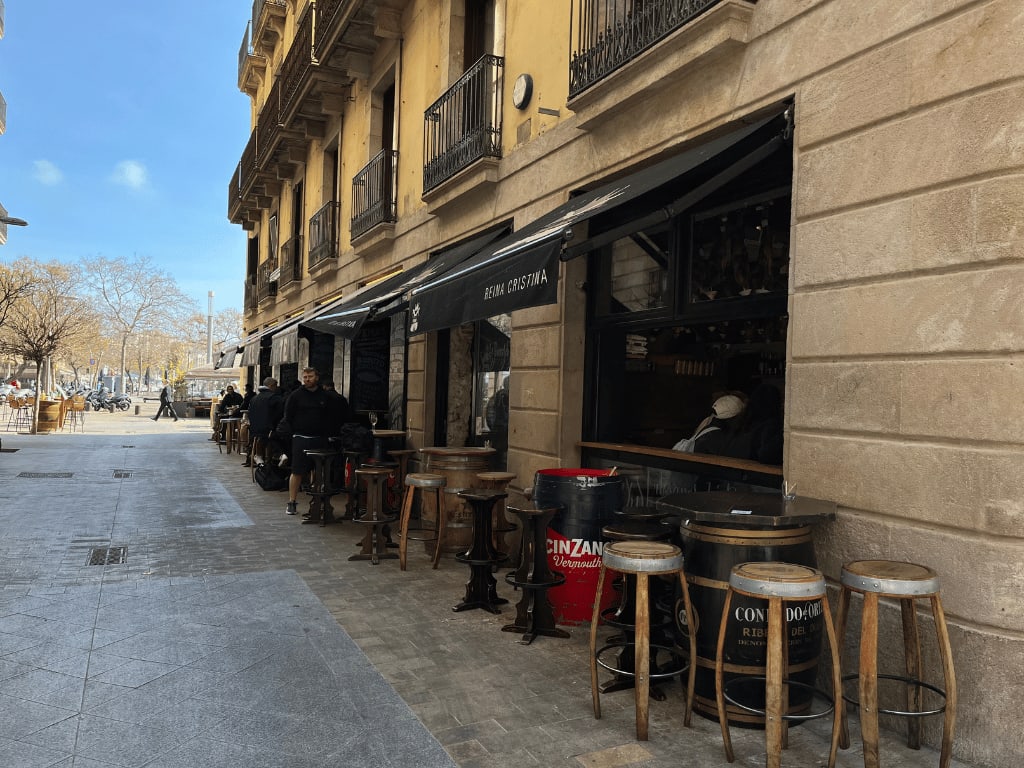
13 Best Restaurants in Barcelona: A Food Lover's Guide
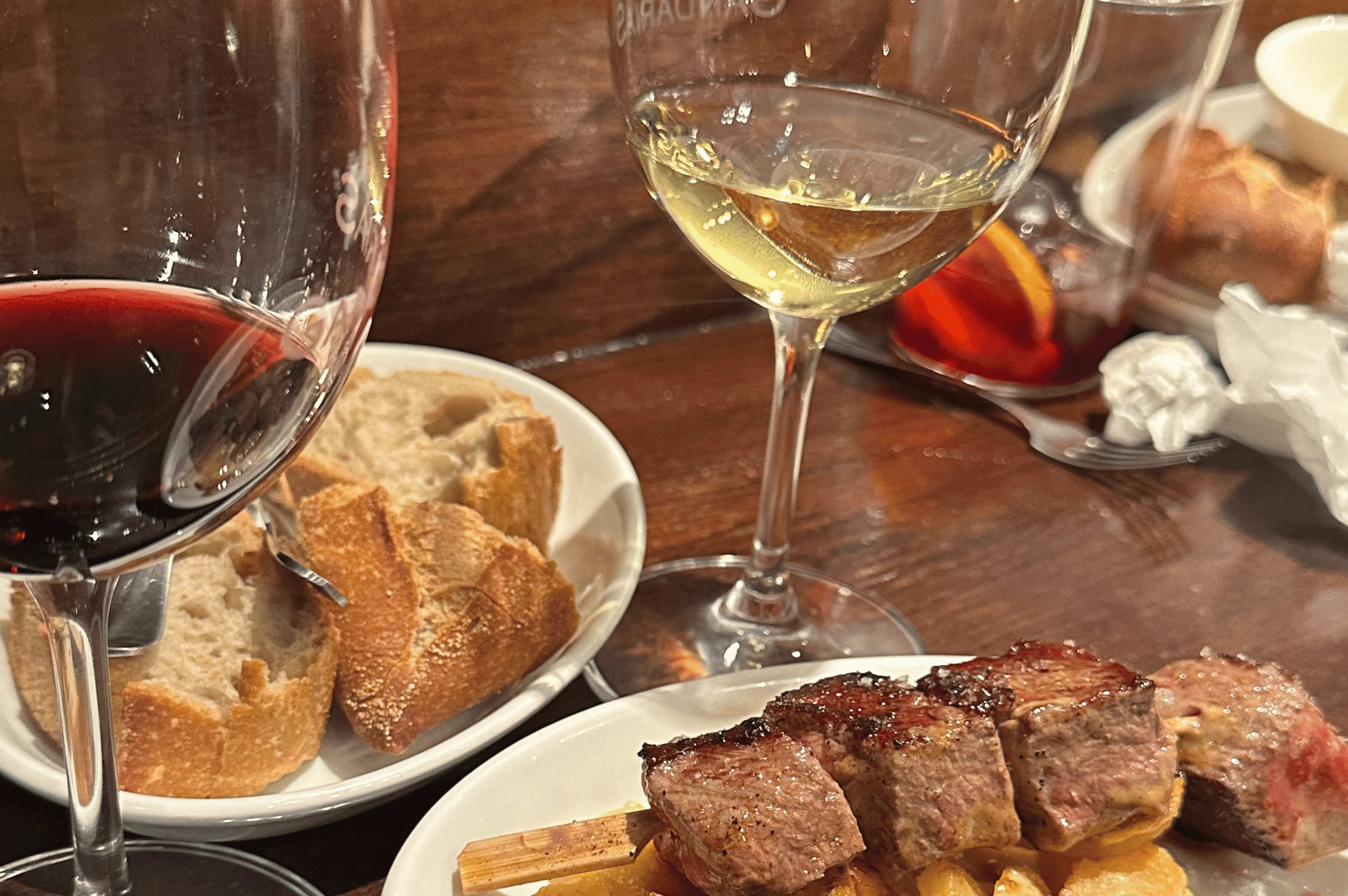
10 Best Tapas Bars in Seville for Local Bites & Drinks!
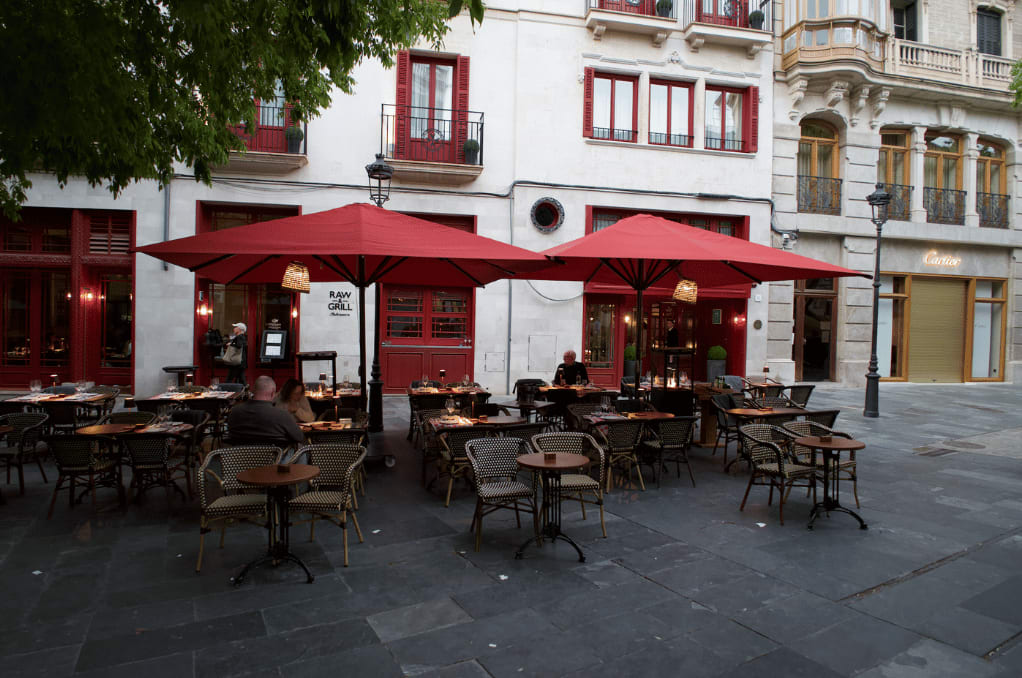
The 9 Best Restaurants in Mallorca: A Food Lover's Guide!
Email address (optional), star rating (optional).
Be the first to comment!

Millions of people como to Spain every month! But many never get to experience the SENSATIONAL SPAIN!!
We're both born and raised Spaniards and our goal is to give you all the resources to plan a perfect trip to Spain.
Take a look! 👇
FYI! Some affiliate links may be sprinkled throughout the post. We'll receive a small commission when you purchase from our links (at no extra cost to you), which will help us keep creating content.
Join the waitlist
I'm about to release my City Guides for Madrid, Barcelona, Sevilla and Mallorca.
They're going to have everything you need to plan the perfect trip. From hotels and transport, to restaurants, attractions, activities, & a lot (A LOT!) of tips & tricks.
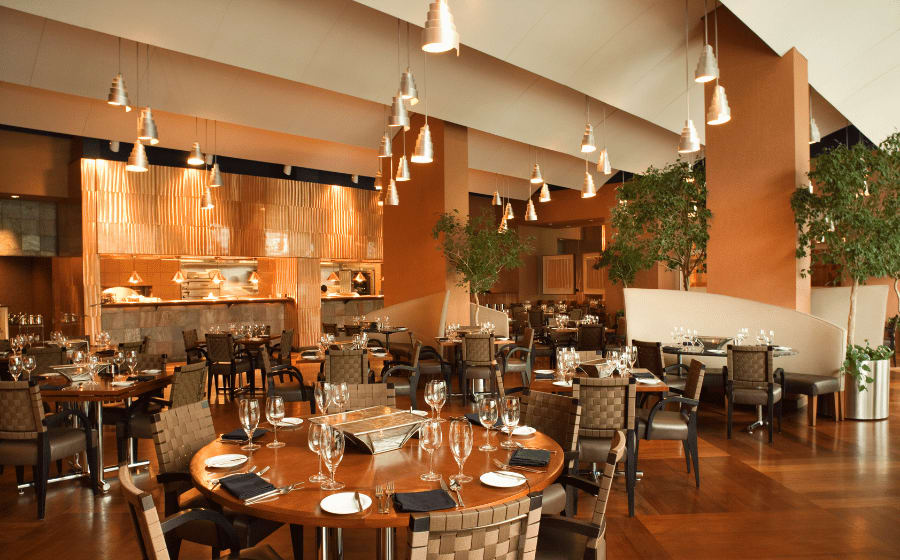
The 21 Best Restaurants in Madrid: A Food Lover's Guide!

What do Spanish People Think of Americans?

What Song Are You Listening To? MADRID

What is the Best Show to Learn Spanish?

Things People Should NEVER do Dating in Spain

Can Foreigners Adapt To The Spanish Lifestyle?

18 Best Food in Spain: A Foodie’s Guide to Spanish Cuisine
Spanish cuisine is all about making the most of the best local products, from delicious tapas to excellent seafood, from classic roasts to delectable desserts. Planning a trip there and want to know what to eat in Spain? This complete guide to the best food in Spain covers the staples I have tried in various cities.
Regarding culinary treats, a few countries boast the diversity, flavors, and history that Spanish cuisine offers. Like Georgian cuisine, traditional food in Spain is deeply rooted in its history, the influence of many cultures that once ruled this territory, or the Spanish empires dominating and discovering new worlds.

Olive oil is the prime ingredient of Spanish cuisine brought from the Roman Empire, while the exotic blend of spices, nuts, and fruits comes from the Moorish influence, forever changing the flavor profile of Spanish foods.
My adventures in the country brought me to explore the traditional Spanish food in Barcelona , Madrid, Alicante , and Bilbao, where I got to try some of the tastiest regional meals. Therefore, this best Spanish food list contains my personal favorites and must-tries on your next trip.
Updates from Red Fedora Diary
Monthly newsletter gem-packed with new & behind-the-scene stories, exclusive updates, and travel news.
You can unsubscribe anytime. For more details, review our Privacy Policy.
That’s Georgian for ‘Thank You’.
You’ll be getting emails from me shortly. And just in case, check the spam/junk folder too.
Understanding Spanish food culture
Before talking about the best foods in Spain to try, it is essential to understand Spanish food culture. They have slightly different rules and customs when it comes to food. Thus, when traveling across the country, it is important to know them.
Spanish meal times are entirely different from what you might be used to, making it essential to consider when planning your itineraries. Extremely touristy cities like Barcelona and Madrid might not adhere to these rules but if you go to less crowded and small towns you need to adjust your meal times.

Unlike many European countries, Spain food culture pays minor importance to breakfast ( desayuno ). Many Spaniards skip it, drink only coffee (sometimes café con leche , or coffee with milk), or eat something very simple and light like a toast or a croissant from around 10 am to noon.
This makes lunch ( el almuerzo or la comida ) the most significant meal of the day , which typically starts at 2 pm and includes several Spanish foods – a starter (soup or salad), a main dish (meat or fish), and a dessert. Traditionally, it’s a more substantial meal than dinner. Water, bread, and wine always accompany the lunch.
Spaniards love their leisurely lunches that also include a sobremesa. It literally means “over the table,” and refers to the conversations after a meal, another custom of Spaniards. So, instead of leaving after finishing the meal, they love staying at the table and engaging in conversations that may last for hours. Therefore, lunch can last anywhere from one to two hours.

Spain is famous for its tapas culture , so depending on where in Spain you are, some restaurants bring out tapas – appetizers to enjoy before your meal is served. It’s mostly shared with friends while socializing and enjoying each other’s company.
Siesta is not a myth in Spain . It exists everywhere, even in prominent and busy cities like Barcelona or Madrid. Siesta is a break time after the mid-day meal and commonly starts at 4 pm.
This is when shops, bars, and restaurants close for a few hours. Barcelona doesn’t adhere to this rule much (with only a handful of venues), but we’ve had some cases with restaurants in Madrid, Bilbao, and Alicante.
Because of this long break, Spaniards get off work late, making their dinner ( la cena ) time quite late, too – between 9 and 10 pm. Unlike lunch, dinner is much smaller and often consists of something lighter , such as a salad, a selection of tapas, or a sandwich.

Wine plays a big part in the food culture in Spain . Spaniards love sipping wine with their meals, no matter if it’s out in the restaurant or at home. Some restaurants even include a glass of wine in their lunch menus. Tinto de Verano is also a favorite choice for many.
Apart from wine, coffee is another essential beverage of food culture in Spain. Spaniards often drink several cups of coffee during the day, especially after a Spanish meal and a dessert. And if you want to know more about Spain, here’s a long list of interesting facts about Spain .
18 best food in Spain to try on your trip
Tapas is a general term for a snack or an appetizer in Spanish cuisine and comes in dozens of variations, sizes, and forms. It can be combined to create a full meal, served cold or hot. Some of the best Spanish dishes also have smaller tapa versions too, making it the most versatile.

In some of the best restaurants in Spain, Tapas evolved into significantly refined traditional Spanish dishes.
Because of its size and form, Tapas is also one of the best street foods in Spain. In market halls all over Barcelona, Madrid, and Bilbao, for instance, you’ll find them wrapped in paper cones for easy transportation, making it one of the easy Spanish dishes to enjoy on the go. Here is a good list of the best tapas restaurants in Barcelona .
And if you ever miss tapas when back home, check out these tapas recipes from Spain that are easy to make.
Paella is the most famous food in Spain, with many variations depending on which city you eat it in. For many, it is associated with the country’s national dish, but Spaniards think of it as a regional – Valencian meal where it comes from.

Authentic paella uses rabbit or chicken in the recipe, but chefs in many Spanish cities also throw in seafood and other ingredients. This traditional rice dish gets its yellow/orange color from saffron and also uses a variation of local beans cooked on an open fire in chicken broth and olive oil.
I have only tried seafood paella in Alicante, with prawns, chicken, and mussels. But if you are traveling to Barcelona, here are some of the best paella restaurants to try in the city.
Patatas bravas
This tasty side dish or snack is one of my favorite famous Spanish food. It is simple yet quite delicious, with fried cubed potatoes with a spicy sauce whipped with ketchup and mayonnaise topped with smoked paprika.
Patatas Bravas is generally consumed as tapas and served in bars and restaurants throughout Spain.

Jamón is a cured ham that is an integral part of Spanish cuisine. Legs of ham are salted and hung up to dry to keep them through the winter months.
It is the staple of any Spanish table. The Jamón Serrano is the most common ham from white pigs. Jamon Iberico is the more expensive one from black pigs.
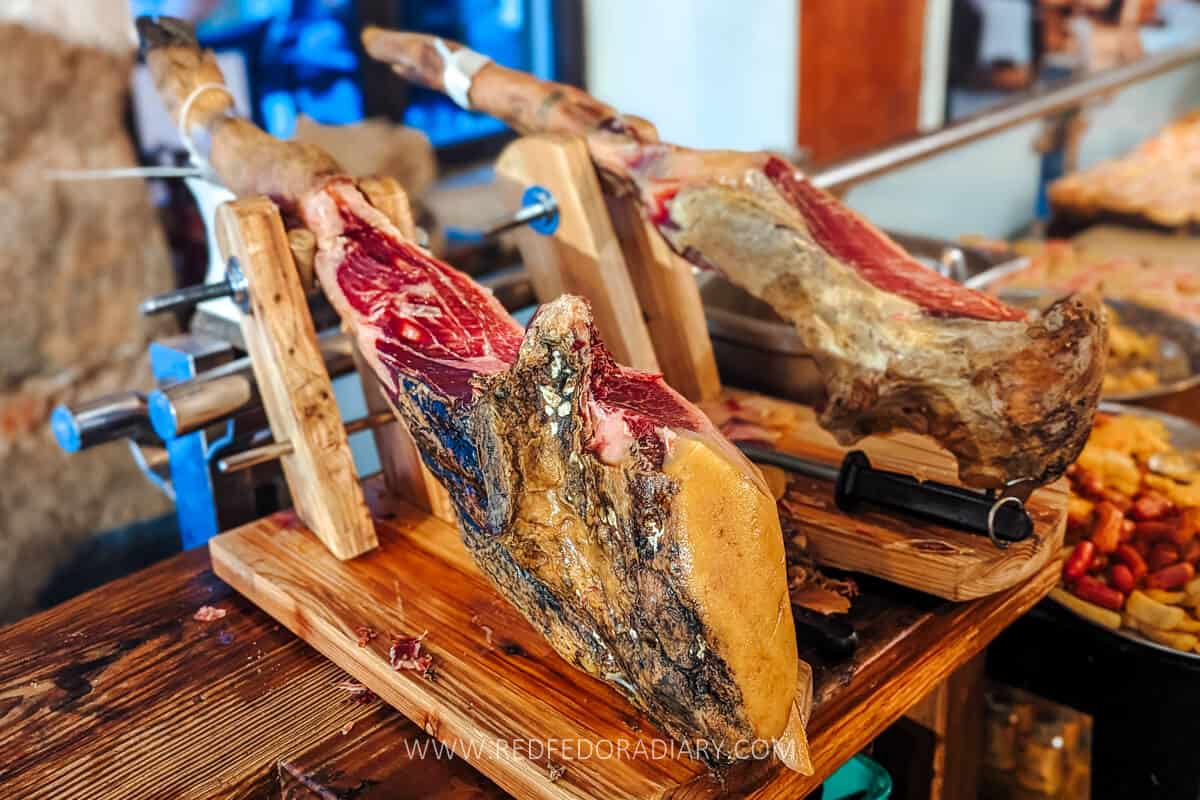
The best way to enjoy Jamon is in extremely thin slices either on its own, with bread, or used in sandwiches and toasts. Some bars in Madrid also serve jamon tapas with drinks as an appetizer, making it the best food in Spain for any occasion. Some bring out a small plate of jamon, cheese, and other meat slices.
Tortilla Española
This best food in Spain is mainly known as a Spanish omelet but uses diced potatoes as its main ingredient along with eggs. There are dozens of variations of Tortilla made with peppers, onions, and chorizo, to name just a few – however, the classic one calls for potatoes and eggs only.

Sometimes used as a tapas treat or break-time snack, Tortilla can be eaten as a main dish. One restaurant in Madrid specializes in the highest and biggest Tortilla I’ve seen.
Churro is one of the famous Spanish foods and a popular snack when craving something sweet. Made from dough cut into sausage shapes, deep fried in oil, and then sprinkled in sugar.
You can find Churros anywhere in Spain, but Chocolatería San Ginés restaurant in Madrid is one of the oldest that specializes in this sweet treat.
Croquetas are small balls of various fillings mixed with bechamel sauce, breaded, deep fried, and served with a sauce, making it a light snack and perfect as tapas. The filling varies, including jamon, chicken, blood sausage, or salt cod.
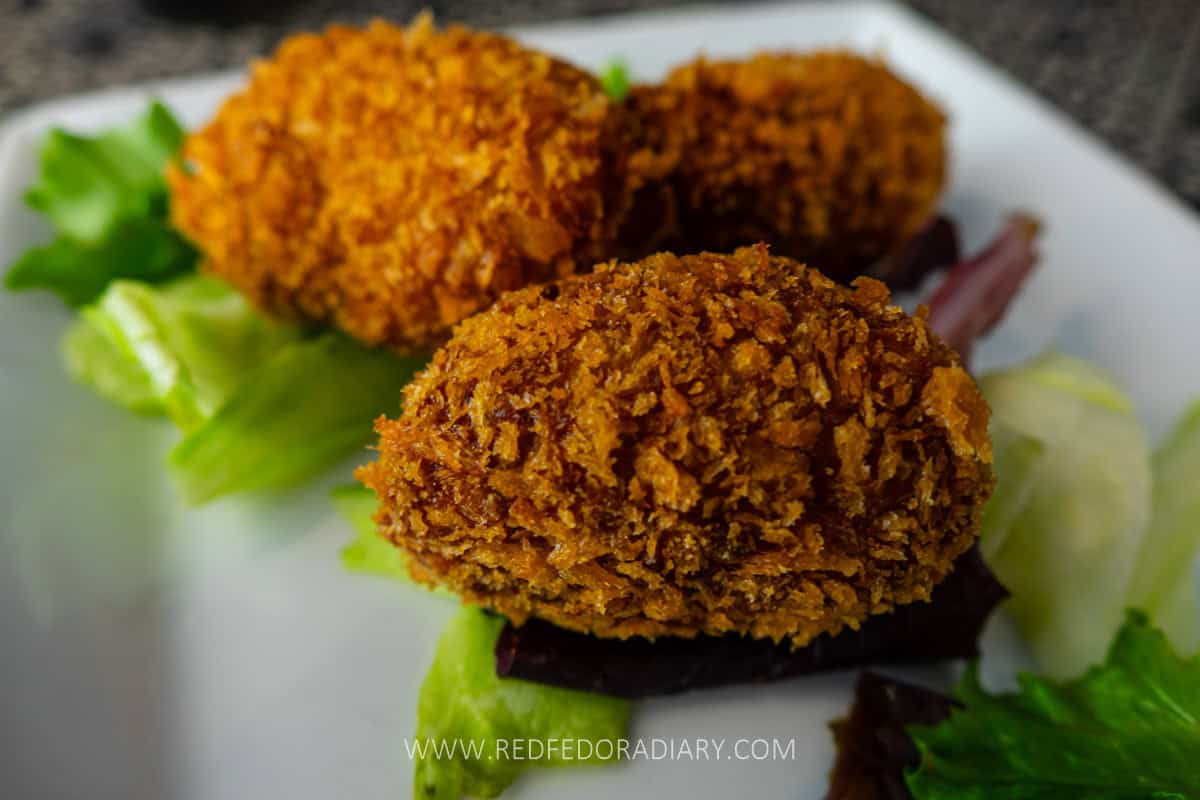
Gambas al ajillo
If you love seafood, particularly shrimp, you’ll love this one too. One of the crowd favorite and the best food in Spain that anyone should try is the Gambas al ajillo, or shrimp in garlic sauce.

The dish is mainly known in central and southern Spain, Madrid and Alicante being one of them. This simple yet flavorful and delicious meal is made from peeled shrimp, tons of garlic, and olive oil.
Typically cooked in a casserole and served in the same pot. It gets cold quickly, so you need to be fast to eat. It perfectly pairs with Spanish wine or beer.
Pan con tomate
The traditional Spanish food enjoyed for breakfast is the simple toast with tomato puree. Locals consume it on its own as a snack or a tapa with any meal.

This simple but delicious food is primarily popular in Catalan cuisine, but you can also find it in the rest of Spain. I tried it first in one of the restaurants in Barcelona and then in Toledo during a day trip from Madrid.
The preparation might differ depending on the region. Some may or may not toast the bread with tomato rubbed over or use a tomato puree. Nevertheless, it’s pretty tasty and perfectly goes with orange juice or coffee in the morning.
The word ‘bocadillo’ or ‘bocata’ is a general term for a sandwich generally made from a local baguette or similar bread and has all sorts of fillings inside.

Bocadillo is also one of the best street foods in Spain for many locals and foreigners. This humble food has evolved and become a staple among famous Spanish dishes. It is sold everywhere, from tapas bars to cafes and even jamon shops.
Spaniards love seafood and incorporate it into their daily diet. Ostra, in Spanish, is consumed here raw, like in many countries, with a small squirt of lemon juice. I haven’t seen many oyster bars across the country, but if you are in Bilbao, Basque Country, stop by El Puertito.

Oreja de Cerdo is another staple of the Spanish food menu, normally eaten as a tapas . It is commonly fried or grilled and served as a snack, but it is also boiled in several variations of stews.

The ear is chopped into cubes or strips, resulting in a crunchy and crispy appetizer that perfectly accompanies Spanish beer or any other beverage.
Bull’s tail
One of the delicacies in Spain I tried was the Rabo De Toro, which quickly became the best food in Spain for me. I first tried in Barcelona and later in Madrid. Both were absolutely delicious, but I’ve noticed slight regional differences.

This slow-cooked stew is commonly made of oxtail and is full of flavor, where meat is exceptionally tender and melts in your mouth at every bite. It has no specific taste; if no one tells you, you won’t even notice what you are eating.
Unlike Meskhetian cuisine in Georgia , snails are another popular Spanish food across the country that comes in two types – caracoles (small) and cabrillas (big).

Caracoles a la Andaluza, originally from the Andalusia region , is made from a mixture of tiny snails and a flavorful sauce of tomatoes, parsley, garlic, and sausage.
I’ve tried the Andalusian snails in Madrid, but Catalonia has its own version you should be able to find in Barcelona.
Roasted suckling pig
Cochinillo asado, in Spanish, is the best food in Spain for you to try. A traditional meal of the Castille region, the suckling pig is especially famous in Segovia.
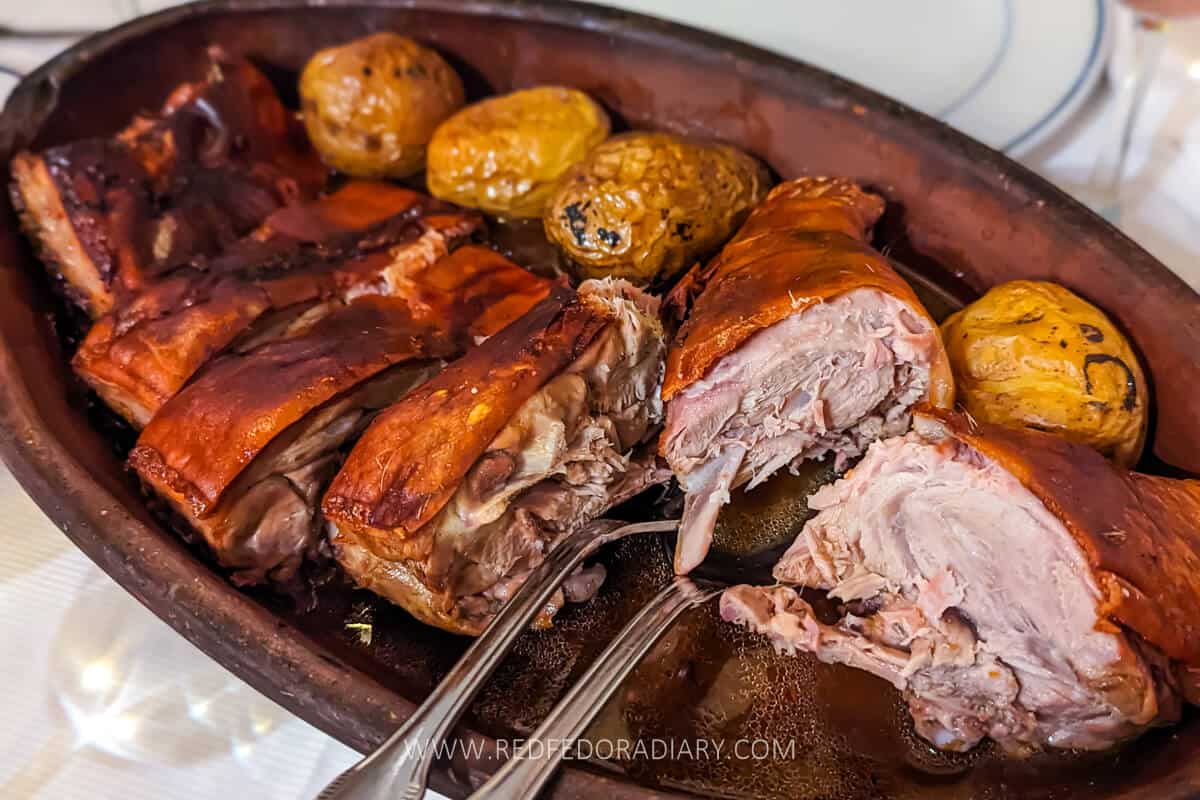
I’ve had it in Madrid’s famous restaurant Botin, which is one of the best places to eat in Spain as the world’s oldest restaurant. When cooked properly, the meat is super tender and practically falls apart, resulting in juicy meat with tender, crispy skin and a skinny layer of fat. It was top-notch and delicious at Botin.
Lamb intestines
For those who love trying everything, Zarajos should be on your list. From the city of Cuenca, this offal-based meal is one of the strangest foods from Spain I’ve tried.
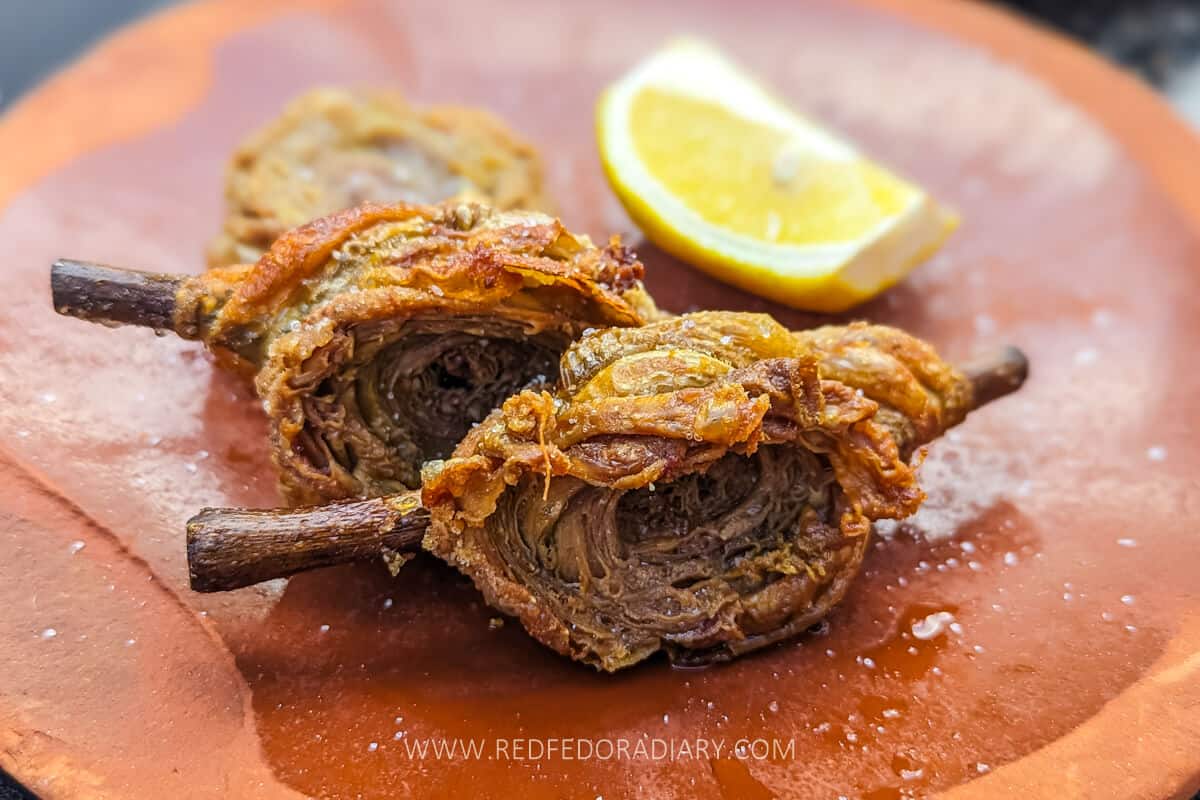
I won’t lie; it was not my favorite, and I prefer the Turkish Kokorec sandwich (also made from lamb intestines), but it got points among a few of our group members, so I decided to include it here.
It is made from the suckling lamb intestines marinated in its natural juice. When ready to prepare, it is wrapped around vine branch skewers to form a thick ball-like shape and deep fried in olive oil until golden.
Squid, or Calamar in Spanish, is another popular seafood that makes its way to many lists of Spanish foods. They are commonly cut into rings, breaded, and deep-fried to serve with lemon juice as tapa or a go-to Spanish street food at various markets.

If you are in Madrid, try the famous calamari sandwich ( bocadillo de calamares ) right off the main square at La Campana. Despite its prime location, the prices are pretty low.
Basque cheesecake
I am sorry, New York Cheesecake lovers, but you haven’t tried Basque cheesecake, also known as San Sebastian Cheesecake. Don’t get me wrong, I was a die-heart NY cheesecake lover, but this one converted me.

Hailing from the resort town of San Sebastian, north of Basque Country, a bit over an hour’s drive from Bilbao, this cheesecake type has become extremely popular outside of Spain.
The super tender, creamy, and crustless cheesecake is the love at first bite! After trying one piece, you would return for more, or maybe even a whole pan!
More Spain travel guides:
My favorite travel resources.
✈ Book affordable flights on WayAway , a platform that shows the best flight deals, tours, and hotels. With a WayAway Plus membership, you can earn cashback . Get 10% off with code: RFD10
🚫 Get compensation for up to 700$ with Airhelp if your flight was canceled or delayed within the last 3 years.
🚗 Rent a car with DiscoverCars , a trusted international car rental website.
💻 Get a VPN from Surfshark to protect your devices from hackers when using public Wi-Fi when traveling.
📱 Install the Airalo app , which provides local eSIMs for a more affordable internet connection when traveling. Get 3 USD with code: BAIA2592 .
💸 Use Wise to withdraw money in local currency without hidden fees and avoid high exchange rates. On top of that, you might get a Visa or Mastercard debit card .
🏨 Find budget-friendly deals on all sorts of accommodation types on Booking.com .
❣ Pre-book a private car transfer with Welcome Pickups to your hotel.
🩺 Buy the most flexible and budget-friendly travel insurance, SafetyWing , covering COVID with add-ons for adventure sports and electronics theft.
☀ Book in advance some of the best city walks, cultural experiences, and day tours to maximize your stay and experience here.
Spread the word!
Leave a Reply Cancel reply
Your email address will not be published. Required fields are marked *
This site uses Akismet to reduce spam. Learn how your comment data is processed .

Welcome to Spain
Tradition, good food y otras cositas más.
There is an expression that well sums up the Spanish way: salir de tapas. In the local culture, it means gathering friends to go from restaurant to restaurant, snacking and having good drinks. In the end, this is the tradition that best defines the country’s DNA. To understand Spain beyond the guidebooks, you have to allow yourself different experiences and try a little bit of everything. There is no point in visiting the cosmopolitan Madrid and Barcelona and leaving aside the spirituality of Santiago de Compostela. Just as it is worthless to dance flamenco in Andalusia without at least stepping on the dance floors of Ibiza’s ballads. Only those who are not afraid to take risks and immerse themselves in the unique traditions of each region can fully take advantage of what Spain has to offer.
Discover Spain
Food & travel guides, taste spain, book food experiences.
Private or Shared
Idiazabal cheese farm visit with tasting
San Sebastián, Spain
Cider house visit with tasting and traditional lunch
La rioja winery with tasting and traditional lunch, txakoli winery with tasting in getaria and zarautz, food and travel, all about spain, beautiful relais & châteaux hotels in spain to explore local cuisine, the greatest wine hotels and resorts throughout spain, where to stay in valencia: best areas and hotels to stay, spanish cuisine, flavors and traditions, food & drinks, a journey through 20 traditional foods of spain, best destinations if you love to pair wine with travel.
What to eat in Spain? 20 traditional Spanish foods to try
Spanish cuisine is one of the most famous in the world. Who does not know paella, jamón iberico and sangria…? Its cuisine is rich, varied, colorful, and with high-quality, aromatic ingredients. It is one of the best countries to enjoy food and try new things.
We’ve compiled a list of what to eat in Spain to guide you on this journey to discover Spanish food. Plus, a few more tips on Spanish cuisine, its key ingredients, and where to find the best food.
This article will examine the typical Spanish food dishes, the ingredients, and the various associated traditions. And, of course, tips on where to eat each dish!
Page Contents
What should you know about Spanish food?
Various cultures and civilizations have influenced Spanish gastronomy. Moors and Jews had a significant impact on cuisine and culture, they introduced ingredients such as rice, almonds, some vegetables and fruit, and spices such as saffron, cumin, nutmeg, and many more.
Later, the discovery of the Americas also brought new ingredients, such as potatoes, tomatoes, cocoa, peppers, chiles, and corn. This revolutionized Spanish and world cuisine! Can you imagine European food without potatoes or tomatoes? And without chocolate…?
Spain stands out for its quality olive oil, being also the world’s largest exporter of olive oil. It uses olive oil in almost everything, even to spread the bread. Olive oil is also used for frying instead of sunflower oil. In addition to olive oil, wine, tomatoes, and Iberian jamón are also loved and are authentic national monuments.
Spain follows a Mediterranean diet, using many fruits, vegetables, fish, and fresh, seasonal ingredients. Plus, each province has its specialties. It’s a big country, and although some ingredients are common throughout the country, certain foods and ingredients are only found in specific regions.
Thus, and as in many other aspects of Spanish culture, food is mainly regional! Some dishes have transcended their original regions and become staples everywhere (even outside of Spain), but the vast majority are still regional or local.
And above all, Spaniards love food. Eating is a celebration, an act of sharing that takes a long time and is not meant to be rushed.

Tips for finding the best Spanish food
It’s not hard to find good food in Spain – the country is teeming with delicious food. But each region has its specialty, and certain ingredients and dishes really should be eaten in their place of origin, as they are much better there or are absent anywhere else. Keep this in mind when choosing what to eat in Spain.
Spaniards eat late – lunch starts at 1 p.m., and many restaurants do not serve food before that time, apart from tapas. And the lunch hour is long, it can extend until 3 pm. Due to the intense heat in Spain, there is a siesta time, from 1 pm to 4 pm; it is time for rest and lunch. That’s why many stores and businesses only open after that time.
Dinner is also late, many restaurants only serve from 9 p.m. On the other hand, the summer nights are typically warm and pleasant, which makes you want to stay up late enjoying the excellent atmosphere.
If you want to save on food, pay attention to the day’s menu. Many restaurants serve lunch menus during the week. This includes the first course and the second. Sometimes, the first course is a kind of appetizer, but many times, it’s more like a complete meal, so it turns out to be a generous food offer. However, sharing the menu of the day is usually not allowed.
The last tip is valid for any country in the world: choose to eat where the locals eat and avoid the tourist places. A restaurant with plenty of locals is always a good start. Finally, Google Maps reviews and scores are also a good guide to deciding if a restaurant is good.

Breakfast in Spain
Bread with tomato (pan con tomate).
Pan con tomate or tostada con tomate is the most typical breakfast in Spain. Accompanied by a café con leche (coffee with milk), it’s an ideal start to a day.
It is a typical dish from Catalonia, but you can find it all over Spain. And despite being more of a summer dish, as it is the tomato season, you can find it all year round.
The dish consists of a slice of toasted bread spread with tomato, good-quality olive oil, and a little salt. It’s amazing how such simple ingredients can make such a divine dish. So, now you know breakfast has to be toasted with tomato and olive oil when you’re in Spain.

Chocolate with churros
Chocolate con churros is another typical Spanish breakfast. The crunchiness of the churro and dipping it in a slightly bitter hot chocolate is excellent. The Spanish are culinary geniuses.
Churros are made with choux pastry and fried in hot oil. They are crunchy and a little hollow inside. Plus, they are served with dense hot chocolate, into which the churro is dipped. Churros can be sprinkled with powdered sugar.
Chocolate con churros are mainly eaten for breakfast, but they can also be eaten at lunchtime or even as a dessert. In fact, they can be eaten whenever you want. Several cafes serve churros with chocolate, but some churrerias specialize in this delicacy.

Best Tapas and Pintxos in Spain
Tapas are small food portions accompanying a glass of wine or beer. There is a wide variety of tapas; they can be eaten at any time of the day and are served in bars or restaurants.
Tapas are more than just food, they are culture and a way to socialize. In Spain, they say “ir de tapa,” which means going for tapas, having a drink in different bars, and being with friends.
Each region has its tapas and rules. In Andalusia, bars offer a free tapa with the drink. In the Basque Country, all tapas are priced the same, and they are also called Pintxos.
Pintxo or pinchos are Basque versions of tapas. They are small portions of food served with bread and a toothpick or skewer. In fact, pincho means skewer in Spanish. San Sebastian is the capital of pinxtos, there is so much variety, and the creativity is phenomenal.
Trying different tapas and pinchos in Spain is one of the most fun and tasty things to experience. The only problem is figuring out the tapas rules of each city. But it’s part of the adventure.
Below, we describe the most typical tapas, but there is a wide variety of them. There is no shortage of creativity in typical Spanish food.

Pimiento de Padrón
Pimientos de Padrón are small green peppers, native to Padrón in Galicia. Like all peppers, these peppers were brought from Mexico and adapted to the Galician climate.
They are one of the most popular tapas in Spain. They are fried with a bit of olive oil and seasoned with coarse salt. They are served hot on a plate, and you eat everything but the stem. Simple but delicious.
Most of them are not spicy, but they could be spicy; however, the probability is low. There is an expression in Galicia that loosely translates to: “Eat the pimientos de Padrón: some are hot and others not.”
The Padrón pepper, despite being native to Galicia, is found in practically all bars and restaurants in Spain. They are adored by many. In addition, it is also an ingredient that is easy to find in supermarkets both in Spain and Portugal , being very easy to make.

Patata brava
Patatas bravas are the most typical tapas in bars in Spain. It consists of diced potatoes fried in olive oil and covered in a spicy sauce (salsa brava). The sauce is made with hot and sweet peppers.
Potatoes are golden, crispy, and served hot. They are good with everything. They can be slapped or accompanied by some protein. And although they come from Madrid, you can find them all over Spain in any restaurant or bar.

Patatas Alioli
Patatas Alioli are another classic tapa. Made with diced potatoes, boiled in water, and then covered with aioli sauce (garlic mayonnaise). The alioli sauce is made with eggs and garlic emulsified with oil, getting the consistency of mayonnaise.
This tapa can be served hot or cold and is eaten with a toothpick. This dish has variations with fried rather than boiled potatoes, also served with Alioli sauce.
You will find patatas alioli in all restaurants and bars in Spain.
Huevos rotos
Huevos rotos in the past were synonymous with fried eggs. But nowadays, huevos rotos are associated with cook Lucio Blázquez’s recipe, which consists of fried eggs on top of fried potatoes with ham, bacon, or chorizo. The eggs are over easy fried, and when serving, they are mixed with the potatoes, covered by the delicious yolk.
It’s a delicious recipe; anyone who likes eggs will love this tapa. You can find huevos rotos in almost every restaurant and bar in Spain. There are a thousand and one versions of this recipe, some more creative than others.

Croquetas is a very famous tapa in Spain. Despite having its origins in France , it is worshiped in Spain. The croquetas are formed with a dough made with béchamel sauce and a filling of your choice – usually ham, chicken, mushrooms, or prawns. This dough is wrapped in flour, egg, and breadcrumbs. And at the end, they are fried in hot oil.
They are crispy on the outside and creamy on the inside. There are many different versions of croquettes in Europe, such as Dutch, Italian, and Belgian – they are stuffed with other ingredients. Furthermore, Spanish croquettes are very different from those of Portugal and Brazil. They are stuffed with meat and do not have bechamel sauce, they are drier.
You can find croquetas all over Spain, in any restaurant or bar. They are one of the most typical tapas or starters.
Jamón is ham made from the whole leg of the pig, cured with salt, and sometimes smoked. Healing time ranges from 8 to 36 months. In Spain, Jamón is a religion – it is the most important ingredient. There are hundreds of specialty stores.
In Spain, there are two types of jamon – the jamón ibérico, which uses the Iberian pig known as black pig, and the jamón serrano, which uses white pork. Each type of jamón has different ones with a protected designation of origin.
Within the Iberian jamón, there are different categories depending on the origin and diet of the pig. You can understand which category you are in by determining the color of the packaging label (white, green, red, and black).
Note that jamón ibérico is not exclusive to Spain; the black or Iberico pig is native to Alentejo (Portugal) and the central and southern zones of the Iberian Peninsula.
That said, eating jamón is almost mandatory in Spain . It is usually served as a tapa and can be eaten at any time of the day. It is also very good in a sandwich.

Patata tortilla
Tortilla de patata is one of the most iconic dishes in Spain and is enjoyed all over the country. It is a traditional dish made with eggs, potatoes, and onions. It’s like an omelet with potatoes.
To cook this dish, you must fry the potatoes in olive oil, then add the potatoes to the scrambled eggs in a pan and cook until the eggs are done. It is a delicious and moist dish.
There are variations of the tortilla, in which chorizo, peppers, or tuna are added. The tortilla is eaten as a snack, it can be eaten inside bread or on its own as a light meal.
You can find this dish in all restaurants served as a tapa; it is also eaten for breakfast.

Galician Empanada
Empanada is a traditional Spanish dish from Galicia. It is made with a thin dough of flour, butter, and water filled with different ingredients, such as tuna, minced pork, shellfish, or vegetables.
It has a rectangular or round shape and has been popular in Galicia since the 7th century. There are also versions of empanadas made with corn dough instead of wheat. It’s a great light meal to eat on the go or at a picnic. It’s not really a tapa, but it can be served as such.
The empanada is more common in Galicia and difficult to find in other parts of Spain.

Soups – Spanish foods
Gazpacho andaluz.
Gazpacho is a traditional Andalusian cold soup. It’s fresh and has a beautiful tomato flavor.
Gazpacho is made with ripe tomatoes, cucumbers, peppers, stale bread, oil, vinegar, and water. All ingredients are crushed raw and then filtered. It can be accompanied by bread.
It is a refreshing and delicious dish ideal for the summer. It is best to have this dish in Andalusia, but it can be found in some other regions and restaurants.
Salmorejo Cordobes
Salmorejo is a traditional cold soup from Cordoba in Andalusia. It is very similar to gazpacho but with small differences. It is also made with ripe tomatoes, breadcrumbs, garlic, oil, and vinegar. But it is denser than gazpacho and has the consistency of puree. And it doesn’t take cucumber and pepper.
The soup is sprinkled with pieces of ham and boiled egg. It’s really good; we even like it better than gazpacho, but the flavors are similar. This a Cordoba dish, and it is the best place to eat it.

Caldo Galician
Caldo Galego is a traditional hot soup from Galicia. It is a soup made with potatoes, kale, turnip greens, white beans, lard, chorizo and other smoked products. Basically, it’s a soup with everything.
It’s ideal for northern Spain’s cold and rainy winter days – it’s very comforting and satisfying. The recipe varies from house to house, is not strict, and may include other ingredients. It’s similar to the soups grandma makes in northern Portugal.
You can find this soup in several restaurants in Galicia, and of course, if you knock on the door of a Spanish grandmother, I bet you have this soup.

Meat Dishes – Best Spanish dishes
Fabada asturiana.
Fabada is a typical dish from Asturias in Northern Spain. It is a dish made with a large white bean called fabada, not to be confused with fava beans.
The beans must be soaked the day before and then cooked for a few hours. When the beans are cooked, add the smoked beans and sausages such as bacon, chorizo, black pudding, and pig’s ear, among others. It is seasoned with paprika, saffron, and olive oil.
It is a dish made slowly and tastes even better the next day. Experts say that it should be accompanied by cider, an alcoholic drink made from apples (more about it below in the drinks section).
Many restaurants serve this delicious delicacy in Asturia. Outside Asturias, it will be more challenging to find it, which is why you’ll probably need to go to Asturias to try the Fabada.

Paella Valenciana is a typical dish of the Valencian Community, specifically Albufera de Valencia. It is perhaps the most famous dish in Spain and the hallmark of its cuisine.
It is a dish made with rice and other ingredients in a shallow, long frying pan with a handle on each side. The name of the frying pan is paella, hence the dish’s name.
Traditional Valencian paella has rice, chicken, rabbit, green beans, white beans, tomatoes, saffron, olive oil, rosemary, and salt. Some recipes even call for snails. Valencian paella does not contain fish or seafood, as many believe, only meat.
Besides the traditional paella, there are variations of this paella, such as the marine paella that uses fish and shellfish and the mixed paella that uses meat and seafood. Traditional Valencian paella is usually made over an open flame and follows strict cooking steps.
To eat traditional Valencian paella, you really should go to the Valencian Community. Regarding the other types of paellas, you can find them all over Spain.

Roasted cochinillo
Cochinillo asado is a roast suckling pig and is a specialty of the Castilla region of Spain, with the cochinillo de Segovia being particularly famous.
Traditionally, suckling pig is roasted in a slow oven. The piglet, weighing between 4.5 kg and 6.5 kg, is placed in an earthenware pot with a bit of water. When cooked, it is placed on a grill to brown the skin. The suckling pig turns golden brown with crispy skin.
As in Portugal and the suckling pig from Bairrada, making this dish involves both technique and art. That’s why it has to be eaten in a specialist restaurant. We advise you to try this delicious Spanish specialty in Segovia, as the city is well-known for it.
Madrileño stew or Madrileño cocido
Cocido is a traditional dish from Madrid. It consists of a chickpea stew with various vegetables, such as cabbage, carrots, turnips, green beans, potatoes, chard, and various types of pork, poultry, beef, and sausages.
It was a dish usually eaten by the poorest and of Jewish origin. Nowadays, it is appreciated by everyone. It is mainly eaten in winter. It is a comfort food and family gatherings since every family has a way of doing it.
Some also use the broth from the stew and make a soup, adding rice or pasta, and a little pennyroyal and saffron.
This dish must be eaten in Madrid. In restaurants, it is very common to be served as the dish of the day on Wednesdays.
Rabo de Toro is a typical dish from Córdoba. It is made with the tail of a bull, ox, or cow, which is slowly stewed.
There are several ways to cook this ingredient, and each restaurant has its own recipe. It can be served with rice stewed with fried potatoes. Don’t be scared, it’s really good.
This dish has to be eaten in Córdoba or Andalusia – try the different recipes that use bull’s tail. You won’t regret it.

Fish and Seafood Dishes – What to eat in Spain
Galician pulp.
If you’ve never tried Pulpo à Galega, drop everything, get in a car, and head to Galicia right now. All octopus lovers will notice the Spanish make the best octopus ever.
Pulpo à Galega or pulpo à feira is a super simple recipe, not at all pretentious – it only uses octopus cooked with salt, paprika, and olive oil. It is cut into 1 cm slices, served on a wooden plate, placed on toothpicks, and eaten as a snack.
It is called pulpo à feira because it is typically sold at fairs, pilgrimages, and festivals. In these fairs, it’s like street food; several stalls cook octopus, have some tables in front, and then you can eat some of the best octopus you’ll ever try. It is one of the best experiences to have in Spain.
An exclusive festival that celebrates this delicacy, the Fiesta del Pulpo de O Carballiño, takes place every year and elects the best pulpeiro in Galicia.

Squids à la Romana
Apart from Paella, Calamares à la Romana is perhaps the most popular dish in Spain as practically every foreigner who goes to Spain eats Calamares. Calamares a la Romana are strips or rings of squid coated in flour (sometimes also egg) fried in hot oil and served with slices of lemon.
They can be eaten as a tapa, but they are often a main meal accompanied by french fries. Calamares are also called calamares à la Andaluza; you can find them all over Spain.

Fideuà is an original dish from Gandia in the Valencian Community. It is a dish very similar to paella, it is made in the same frying pan as paella – the paellera. It also contains saffron, but it is made with fideos – a thin vermicelli-like pasta.
Furthermore, it is only made from fish and shellfish, and paella is made with various ingredients. The fideuà takes different types of fish, prawns, and squid. It’s very good. The thin pasta goes well with fish and shellfish.
Although this dish can be eaten all over Spain, we recommend that you eat it in its place of origin, Valencia. Besides, they have good fish and seafood.
Gambas al Ajillo
Gambas al Ajillo is one of the most appreciated dishes by Spaniards and basically everyone else too. It’s a simple dish that only uses peeled prawns, garlic, and olive oil.
It is made with prawns sautéed in garlic in olive oil, you can add paprika or chili and serve. Accompanied by bread, dipping in the sauce is addictive. As simple as that.
Despite being a dish originally from Madrid, you can find it all over Spain, and it is a frequent tapa.
Galician seafood
If you like seafood, Galicia is the place to go, they specialize in seafood, one of the best seafood in the world.
The ideal area to eat shellfish is the Rías Baixas that make up the Rías de Vigo, Pontevedra, Arousa, and Muros-Noia. There are several seafood restaurants with many options and fresh seafood from the area. Bear in mind that the best time for seafood is in October, but they are available all year round.
In O Grove, several cruises allow you to visit the mussel farms and serve mussels and other seafood on the boat. It’s quite an exciting experience, particularly for foody nerds (like us).
A Mariscada Gallega can include clams, mussels, oysters, crabs, crayfish, scallops, prawns, barnacles, and even lobsters. It depends on your taste and budget.

Best Desserts in Spain
Turrón de alicante.
Turrón de Alicante is a very famous Spanish sweet, at least in Portugal, and it is delicious. It is made with honey, egg whites, and roasted almonds. Almonds are the main ingredient as the turrons have to be at least 46% almond.
Turrón de Alicante is a sweet with the Protected Designation of Origin of Alicante. And in Spain, this sweet is traditional, especially at Christmas. It is sold in bars like chocolate, and it keeps for a long time. So they are also one of the best souvenirs to buy in Spain.
It is crunchy and creamy simultaneously, melts in your mouth, and tastes so good due to the roasted sweet almonds. Despite being from the Alicante region, you can find them all over Spain, in souvenir shops or even supermarkets.
It’s a good memory of Spain. There are also many variations of this sweet, harder, softer, with more or less almonds and even with other ingredients.
Torta de Santiago
Pie de Santiago (Torta de Santiago) is a traditional cake from Galicia, specifically Santiago de Compostela, and one of the city’s symbols.
Traditionally, it is a cake made with almonds – it has to contain at least 33% – sugar, eggs, cinnamon and lemon zest. It is a round pie that, after cooking, is sprinkled with sugar and powder, leaving the shape of the cross of the order of Santiago in the center.
It is a delicious, moist, spongy, and slightly grainy cake with an intense almond flavor. It is ideal for those who are gluten and lactose-intolerant. However, there is a variation of this pie that has a shortcrust pastry base.
The best place to buy this delicacy is in Santiago de Compostela, but you can find it all over Galicia. It is especially typical in July and August, as the day of the Apostle of Santiago is celebrated on the 25th of July.
Crema Catalana
Crema Catalana is a traditional dessert from Catalonia. It’s the Spanish version of France’s crème brûle or Portugal’s “leite-creme”.
It is made with egg yolk, milk, sugar, wheat or corn flour, cinnamon sticks, and lemon zest. In the end, it is sprinkled with sugar and burned, getting a crispy crust. The creamy egg contrasts with the crunchy burnt sugar, making it a mouthful of flavor and textures.
You can find this dessert in almost every restaurant in Spain, especially in Catalonia. It is traditional to eat on San José Day, March 19th.
Arroz con Lecha (Rice with milk)
Arroz con leche is a typical Asturian dessert. It is very similar to Portuguese rice pudding; what varies are the flavorings used. It is made with rice, milk, sugar, lemon, or orange peel and flavored with spices such as anise, nutmeg, cardamom, and ginger.
This recipe varies a lot. Each house/restaurant has its version. We had it in a restaurant in Asturias that served one with an intense Anis flavor, and it was very good. But it depends a lot on the restaurant chef’s recipe. There are versions where, in the end, it is sprinkled with sugar and burned – similar to Crema Catalana mentioned above.
You can find this dessert in restaurants all over Spain, especially in Asturias.

Polvorones are traditional Spanish cookies eaten especially at Christmas. They are biscuits made with toasted flour, lard, powdered sugar, toasted and sliced almonds.
They are delicious biscuits, very brittle but crumbling into powder. The word itself in polvorones means powder. They melt in the mouth; anyone who likes almonds will love this sweet.
In addition to being good, they are very beautiful, wrapped in tracing paper, and look like sweets. You can find them all over Spain, especially in Natal and Andalusia. Another nice souvenir to take with you.
Spain’s famous drinks
Sangria is Spain’s most famous drink, or at least the most popular. It is a drink made with red wine, pieces of fruit, and sugar. It can be carbonated, but not always. It is typical of Portugal and Spain and is found everywhere, especially in summer.
There are variations of sangria, it can also be made with white wine, cider, or sparkling wines. You can add spices like cinnamon sticks and fresh herbs like mint. You can use various fruits, such as apples, pears, peaches, bananas…
It is refreshing, tastes like summer, and is ideal to have it on a terrace and share it with good company.

Sidra is a traditional alcoholic drink from Asturias and the Basque Country. It is made with fermented apple or pear juice. It is a non-carbonated natural drink with an alcohol content of between 4 and 6 percent by volume.
The cider is sold in cider shops that, in addition to being a bar, are also restaurants. The cider is served in a large glass. The waiter holds the bottle above his head and drops the cider into the faraway glass. This causes a little foam from the carbonation, it’s called scanning.
The cup should not be filled too much at a time. Nowadays, some devices are placed on top of the bottles, causing this scanning effect.
Going to a sidreria in Asturias is an experience in itself, which is why we highly recommend it.

Pin it for later

- cover photo of lunamarina via Depositphotos
Sharing is caring!
- Skip to primary navigation
- Skip to main content
- Skip to primary sidebar
- Skip to footer
TravelAwaits
Our mission is to serve the 50+ traveler who's ready to cross a few items off their bucket list.
11 Must-Try Foods When Visiting Spain — And Where Tapas Falls On The List

- Activities and Interests
- Destinations
- Food and Drink
One of the best reasons I travel to Spain, other than the exquisite scenic beauty and magnificent architecture, is the food. My palate waters for the freshly caught seafood, acorn-fed ham, sun-kissed produce, and bountiful vineyard harvests. The Mediterranean flavors are lively and layered without being overly spicy, a hallmark of the country’s rich gastronomic heritage.
I’ve been fortunate to eat and drink my way through numerous cities and towns in Spain as a personal traveler and once on a media trip. Here’s my list, in no particular order, of must-try foods for both newcomers and repeat travelers.
Pro Tip: Keep in mind that Spain is a large, diverse country, so you’ll find regional specialties and exceptions. Some of my recommendations may not be available everywhere, but I’ve tried to hit the highlights.

1. Tapas And Pintxos
First, a few words about Spain’s iconic tapas and its culinary cousin, pintxos (sometimes spelled and always pronounced as “pinchos”). These are not the names of specific dishes, but rather, categories of edibles. Tapas and pintxos rate #1 on my list of favorites.
Tapas are small servings of a single food item, perhaps a dish of olives or a plate of cheese or meat. They are considered ideal for snacking along with a beverage. If you order several, you can make a hearty meal. You can also order larger servings to share with a group. Several of my must-try foods in this article are typically listed on tapas menus.
Origin stories vary for the tapa, which translates to “lid,” but the most common is that bartenders and wait staffers of yore started it by covering a patron’s glass with a complimentary slab of bread. (Some claim it was to keep the flies out.) The custom expanded over the years into heartier dishes. I recently spotted a tavern in Málaga’s city center with a sandwich board sign advertising five assorted tapas for 18 euros.
Pintxos, which are wildly popular in the Basque region, are finger foods that can be consumed in just a few bites. You’ll find little sandwiches, skewers, tartlets, and spreads of meat or cheese on a baguette slice. They are often speared with a toothpick. I had a pintxo craving during a recent stay in Málaga on the Costa del Sol, so I dropped into La Taberna del Pintxo . The cold pintxos are self-served, so I fixed myself a plate that included curried chicken salad and a crab tartlet. Paired with a chilled glass of white wine, it was the perfect end to a long day of sightseeing!

2. Jamón Ibérico (“Iberian Ham”)
One of Spain’s longest-held culinary traditions is cured ham, a savory reddish-pink meat marbled with silky white fat. As a tapa, it is presented in paper-thin slices artfully arranged on a plate. In many restaurants, bars, and specialty shops, you are likely to see one or more pork legs, with hooves intact, held in a vice. You can watch expert carvers with serious knives prepare each plate with precision.
Jamón Ibérico is widely considered the most prestigious of cured hams. It’s a tightly controlled designation awarded on such restrictions as geographic location, breed of pig, and its diet. The highest designation, “Jamón Ibérico de Bellota,” means the animals were acorn-fed for added flavor.

3. Paella Valenciana
Contrary to popular belief that paella is the signature dish of Spain, you won’t find it in every region of the country. When you do, chances are, it’s not authentic paella. For the real dead, you must go to Valencia, where it was created.
The Valencian version, like at Restaurante Palace Fesol — which has been making it for over a century — combines chicken, rabbit, snails, and tomatoes. Saffron provides the golden color and distinctive taste. Paella is cooked in a shallow pan over a fire, a method that forms a crusty bottom layer. It’s called socarrat and it’s delicious.
Fun Fact: September 20 is World Paella Day.

4. Fish And Seafood
With more than 3,000 miles of coastline, Spain is rich in culinary treasures from the sea. Atun , or “tuna,” is one of the most versatile. It is found as a salad garnish, tartare, main course, and in stews, to name a few uses. Prawns, scallops, clams, and mussels dominate many menus, while platters of fried anchovies and calamari are tapas staples.
On the sandy beaches of Costa del Sol, espetos are skewers of sardines or other fish that are grilled over wood-burning fires. Drizzle them with olive oil and lemon juice.

5. Ajo Blanco (“Almond Gazpacho Soup”)
Typical of southern Spain, ajo blanco is a chilled, creamy white soup. The main ingredients are crushed almonds (preferably Marcona), garlic, and olive oil. Some recipes include bread for thickening or sherry vinegar for a bit of tang. Garnishes may include grapes or other fruity bits and a drizzle of olive oil.
6. Gazpacho
Typical of Andalusia but widely available, especially in summer, gazpacho is a smooth cold soup brimming with garden goodness. The most essential ingredients are tomatoes and olive oil, but some recipes call for cucumbers or peppers. Garnishes may include diced onions and tomatoes, micro-greens, or croutons.

7. Ensaladilla Rusa (“Russian Potato Salad”)
Most everywhere in the country, you’ll find Russian potato salad. In some circles, it will be called “Spanish potato salad.” Ensaladilla translates to “little salad” and you’ll find it everywhere, from casual sidewalk cafés to upscale white-tablecloth restaurants.
Basically, it is an ultra-creamy concoction of diced boiled potatoes, peas, carrots, tuna, and mayonnaise. Other ingredients that may be added are red peppers, pimentos, olives, and egg. Higher-end establishments often elevate the dish even further. At Kaleido Málaga Port overlooking the harbor , my Russian salad was topped with prawns, micro-greens, and dollops of black caviar.
Fun Fact: In Russia, the same concoction is called an Olivier salad after the chef who is said to have invented it.

8. Croquetas (“Croquettes”)
A mainstay on tapas menus, croquetas are deep-fried nuggets with a creamy bechamel filling. The most traditional variation contains bits of cured ham, but others are made with mushrooms, spinach, cheese, fish, or chicken. Croquetas come in different shapes and occasional garnishes. Some are round like donut holes and others are tubular like a cocktail weenie. Just pop one in your mouth and you’ll be reaching for more.
9. Patatas (“Potatoes”)
Spain has so many delicious variations of potatoes, they are impossible for me to resist. Patatas bravas , or “brave potatoes,” are a tapas classic. Potatoes are cubed and fried in olive oil and accompanied by a zesty red sauce. Patatas alioli are the same but served with a white garlic sauce. Patatas fritas , or “fried potatoes,” are the Spanish equivalent of French fries, only better.
Another great take, tortilla de patatas , also known as a Spanish or potato omelet, is similar to a quiche. Made with eggs and diced potatoes, and sometimes onions, it’s both a breakfast dish and a tapa.

10. Churros
Churros are a yummy fried-dough finger food perfect for breakfast or between-meal snacking. Shaped into rods or loops with a ribbed exterior, they are crisp on the outside and soft on the inside. Spanish churros are unadorned, unlike Mexican versions that come dredged in sugar and cinnamon. Dust yours with sugar, if you like. Better yet, order churros con chocolate and you’ll get a cup of warm, thick chocolate for dunking.
11. House Wine
One of the largest and most prestigious wine-producing countries in the world, Spain is well-known for robust reds from La Rioja, fortified sherries from Andalusia, and sparkling cava from Catalonia. But here’s the thing to remember: In mainstream Spanish culture, wine is a normal part of everyday life and dining, rather than a celebratory indulgence like it might be elsewhere. Every bar and restaurant carries its own vino de casa (“house wine”), which is sure to be good because they sell a lot of it. House wine is also inexpensive. A glass is likely to cost you less than a Coca-Cola. Make mine a vino blanco , please!
Related Reading:
- 5 Incredible Hidden Gems To Explore In Spain
- 5 Unique Small Towns To Visit On Spain’s Gorgeous Costa Blanca
- 9 Amazing Experiences In Coastal San Sebastian, Spain

Pamela McKuen is a baby boomer who travels with style. She’s a Chicago-based freelance journalist who specializes in travel, home, and fashion. Favorite experiences include swimming with whale sharks in Cancun, fishing for piranha in the Amazon River, and viewing the annual sandhill crane migration in Nebraska. Pamela is also a member of both SATW and Midwest Travel Journalists Association (MTJA). You can read more from Pamela on her blog, All The Write Places .
Drinking in Spain
Best Time to Visit
Weather & Climate
Top Destinations
Getting Around Spain
One-Week Itinerary
Top Things to Do
Top Attractions in Each City
Best Beaches
Events and Festivals
UNESCO World Heritage Sites
Food to Try
10 Foods You Have to Try in Spain
If, when you hear “Spanish food,” you immediately picture paella and sangria, you wouldn’t be the only one. But there’s so much more to it than both of the above (neither of which locals actually eat or drink frequently, to be honest).
From the hearty meat-based fare of the inland regions to the light and fresh seafood on the coast, Spain’s culinary landscape is rich and diverse. But one thing’s for sure: no matter where you find yourself in the country, you’re sure to find excellent food.
Need help narrowing it down? Here are 10 typical foods from all over Spain that you won’t want to miss.
Cocido Madrileño
Madrid’s namesake stew is not for the faint of heart. This multi-course meal extravaganza consists of a light noodle soup to start things off, then escalates into a feast fit for a king complete with chickpeas, vegetables, and a whole lot of pork. By the time you devour it all, you’ll be more than ready to take part in another vital part of Spanish culture: the siesta.
Try it at : La Bola is a family-run gem in the heart of Madrid that hasn’t changed its cocido recipe—or the traditional way of preparing it—since 1870.
Everyone has heard of gazpacho, but few outside of Spain are familiar with its heartier cousin. Salmorejo is a chilled, tomato-based purée hailing from Córdoba in southern Spain, and its thicker texture (thanks to the addition of bread) makes it an arguably better choice for a meal than the more famous gazpacho.
Try it at : Locals love the salmorejo at Gran Bar in Córdoba, where you can enjoy it out on a lively terrace. Not too far away, La Salmoreteca at gastro-market Mercado Victoria puts creative spins on the classic (avocado salmorejo, anyone?).
Rice (But Not Necessarily Paella!)
There’s so much more to Spanish rice dishes than just paella. The fertile Mediterranean-facing lands on the eastern coast of the country are prime for growing rice, and there’s no shortage of ways in which it can be used. From the brothy, almost soup-like arroz caldoso to the black rice which gets its unique color from cuttlefish or squid ink, there’s always a new and surprising rice dish to try.
Try it at : Valencia’s Casa Carmela has won the hearts of locals and visitors alike for their iconic rice dishes—including what many consider to be one of the best authentic paellas in Spain.
You’ve heard of tapas—now meet the Basque version. Pintxos are small bites that pack a big punch and can be anything from succulent pork cheek to freshly fished gourmet anchovies. Every tavern in the Basque Country has its own specialty pintxo, so join the locals in a bar hop to try the best of the best.
Try them at : Gandarias in San Sebastian is a fabulous traditional Basque bar and restaurant whose homemade pintxos come together with top-quality ingredients. For something more on the modern side, A Fuego Negro is the best experimental pintxos bar in town.
Patatas Bravas
Crispy fried potatoes, garlicky aioli, and a spicy sauce for an exciting kick—what’s not to love? Patatas bravas are a tapas bar staple throughout Spain, offering a spice factor that’s lacking in many other Spanish dishes.
Try them at : Barcelona’s Bodega La Palma serves up the best bravas in town, with an excellent selection of local wines to boot.
Tortilla de Patatas
Spain doesn’t have an official national dish, but if it did, it would be the humble potato omelet, or tortilla de patatas . Don’t let the name fool you—this particular tortilla has nothing to do with Mexican food. Instead, it’s a simple staple of Spanish cuisine consisting of eggs, potatoes, sometimes onion, and extra virgin olive oil.
Try it at : Casa Dani in Madrid is famous for its excellent tortilla, which was named Spain’s best in 2019.
Pescaíto Frito
Despite its inland location, Seville is home to some of the best fried fish ( pescaíto frito , in the local dialect) in Spain. Brought to Seville’s freidurías fresh from the coast every day and fried to crispy perfection, it pairs perfectly with a dry sherry such as manzanilla or fine.
Try it at : Freiduía La Isla fries up Seville’s best pescaíto frito . Try the cazón en adobo , which is marinated in a delectable mixture of spices before frying.
Keeping with the seafood theme (because let’s face it: Spain has a lot of it), pulpo , or octopus, is a staple in Spain’s northwesternmost region of Galicia. There are dozens of ways to prepare it, but the most classic form is pulpo a feira —or pulpo a la gallega , “Galician-style octopus,” as it’s known in other parts of Spain—where the octopus is boiled and topped with olive oil and spicy paprika.
Try it at : Pulpería Catro Ruas in Lugo does great octopus dishes in a rustic setting. For something a bit more upscale, head to Mesón de Alberto .
Cochinillo Asado
Central Spain’s meaty dishes contrast dramatically with the lighter seafood options in coastal areas. In the sprawling region of Castilla y León, it’s all about cochinillo asado , or roast suckling pig. With crispy skin and unbelievably tender meat, this traditional dish is perfectly filling and cozy.
Try it at : Restaurante José María in Segovia is considered to be the home of Spain’s best cochinillo asado . Can’t make it out there? Madrid’s Botin (also the oldest restaurant in the world!) does a fantastic version as well.
Churros and Chocolate
We had to round out this list with an option for something sweet, but beware: churros and chocolate are not a dessert food in Spain! (And if you do see them on the dessert menu, run.) Instead, you’ll find locals enjoying them as a sweet breakfast, or during the mid-afternoon snack time known as merienda .
Try them at : Madrid’s Chocolat and Seville’s Bar El Comercio both make their churros and chocolate from scratch (which unfortunately is less common than you’d think!). The care that goes into the process is evident in each soul-warming bite.
The Very Best of Spain's Cities, Regions, Food, and Drinks
Your Trip to Madrid: The Complete Guide
Top 10 Spanish Dishes to Try While In Spain
The Best Time to Visit Spain
Plan the Perfect Trip to Spain
Top 15 Restaurants in Madrid
What You Should Eat in Spain: City by City
10 Foods You Have to Try in Barcelona
Top 10 Myths & Misconceptions About Spain
Spain's Best Tapas Cities
The 20 Best Things to Do in Spain
Cancun's Best Restaurants
The 15 Best Bars in Madrid
18 Top Things to Do in Madrid, Spain
When and What to Eat and Drink in Spain
The 10 Best Destinations in the Spanish Countryside

Popular Spanish Food: 59 Traditional Spanish Foods To Adore Spanish Cuisine
By: Author Milijana
Posted on Published: August 19, 2021 - Last updated: April 27, 2024
Categories SPAIN , FOOD TRAVEL
Sharing is caring!
Curious about what to eat in Spain? Are you interested in the food culture in Spain, Spain’s national dishes, and the most popular food in Spain? I have traveled extensively throughout Spain. And here is my ultimate list of the most popular Spanish foods and the must-try authentic Spanish food!
FOOD TO EAT IN SPAIN: TRADITIONAL FOODS IN SPAIN I ATE

Spanish cuisine: Spanish national food – Traditional Spanish food
Discovering new tastes and eating local food is an important part of my traveling experience. Experiencing culture through local foods and tastes means getting better insights into societies, customs, and traditions and a better understanding of local people. Thus, traveling to Spain means for me exclusively eating traditional Spanish food. A part of its amazing history and culture, Spain is famous as one of the world’s best food and wine destinations . I traveled to Spain a lot and I always look forward to returning to Spain. Besides visiting Spanish classic destinations such as Madrid and Barcelona, I traveled and ate in beautiful Andalusia in southern Spain , Catalonia, the Basque Country, Asturias, Cantabria, Castile-León, Galicia, etc. To brag a bit, I hiked over 1000 miles of Camino de Santiago ( Camino del Norte , Via de la Plata , Camino Finisterre ) across Spain. Traveling to Spain means getting familiar with the food culture of Spain: eating traditional Spanish food, sampling traditional dishes from Spain, and drinking typical Spanish drinks. Tasting local food in Spain and trying regional Spanish cuisines are the top things to do in Spain for me. I believe trying authentic Spanish food and drinks from Spain needs to be on any Spanish bucket list!
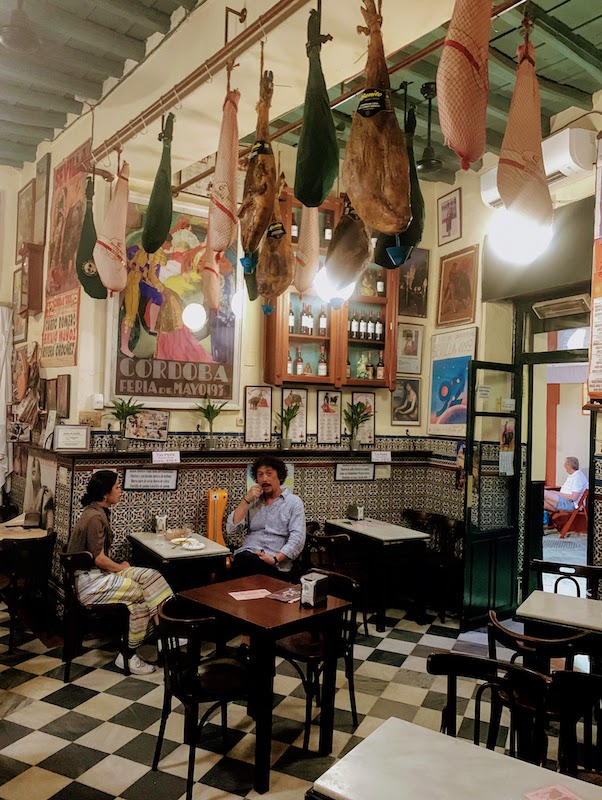
THIS POST MAY CONTAIN COMPENSATED LINKS. PLEASE READ MY DISCLAIMER FOR MORE INFO.
Traditional Spanish food
1. Paella – The most famous Spanish rice dish from Valencia
2. gazpacho – the most famous spanish tomato soup from andalusia, 3. salmorejo – the famous spanish tomato purée from cordoba, andalusia, 4. tortilla espanola – the famous spanish omelette and a national dish of spain, 5. rabo de toro – the famous spanish bull tail stew from cordoba, 6. patatas bravas – the spanish spicy potato dish, 7. puplo a la gallega – the famous spanish boiled octopus dish from galicia, 8. zamburinas a la gallega – these famous galician scallops from northern spain, 9. el arroz negro – the popular spanish black risotto from valencia and catalonia, 10. garbanzos con espinacas – the traditional spanish spinach dish with chickpeas from seville, 11. gambas al ajillo – popular spanish garlic prawns from andalusia, 12. bacalao al pil pil – the famous fried codfish from the basque country, 13. conchilo asado – the famous spanish roast suckling pig dish from castile, 14. pisto – a famous vegetable spanish stew, 15. gambas a la plancha – grilled spanish prawns.
- 16. Almejas a la gaditana – Clams in sherry sauce from Andalusia
17. Almejas en sansa verde – Spanish clams in green sauce from the Basque Country
- 18. Bacalao ajoarriero – Spicy codfish from northern Spain
19. Boquerones fritos – The classic Spanish fried anchovies
20. croquetas – the popular spanish croquettes, 21. pan con tomate – the popular spanish bread with tomatoes, 22. bocadillos – the popular spanish baguette sandwiches, 23. montaditos – the popular finger sandwiches from spain, 24. pinxtos – the popular tapas from the basque country, 25. membrilo con queso – the traditional spanish quince jam with cheese.
- 26. Pimientos de padron – The popular Spanish Padron peppers
27. Mejillones rellenos – The popular Spanish-style stuffed mussels
- 28. Empanadas – The famous Spanish pastries
- 29. Picos – The popular Spanish breadsticks
30. Caracoles – The popular Spanish snail tapas dish
31. calcots – grilled calcot onions from catalonia, 32. percebes – the goose barnacles from galicia and asturias, 33. jamon iberico – the iberian ham, 34. erizo de mar marisco – sea urchins are a popular delicacy in spain.
- 35. Txipirones en su tinta – The Basque baby squids in their ink sauce
36. Angulas – Spanish baby eel
37. alcachofas al ajillo, 38. chorizo – the traditional spanish sausage and the most popular meat food in spain, 39. queso manchego – the most famous manchego cheese from spain, 40. pascualino queso – the popular pascualino cheese from spain, 41. churros con chocolate – the popular spanish pastry with chocolate, 42. crema catalana – the famous spanish caramel custard from catalonia, 43. arroz con leche – the popular spanish rice pudding.
- 44. Tortas de aceite – The traditional Spanish olive oil biscuits
45. Turron – The popular Spanish nougat candy
46. magdalenas – the popular spanish muffins, 47. tarta de santiago – the famous spanish almond cake is among the most famous spanish foods.
- 48. Basque cheesecake – The famous cake from the Basque country
49. Rosquillas de Semana Santa – The Spanish Easter donuts
50. torrijas – the popular spanish-style french toasts, 51. cuajada – the popular spanish milk curd from northern spain, 52. sangria – the famous spanish red wine cocktail, 53. tinto de verano – the popular spanish wine-based drink, 54. rioja wine – the most famous spanish wine, 55. cava wine – the popular spanish sparkling wine from catalonia, 56. sherry – the famous spanish dessert wine from andalusia, 55. sidra – the spanish cider from northern spain, 58. cerveza – the spanish beer.
- 59. Zumo de naranja – The Spanish fresh-squeezed orange juice
THE 10 MOST POPULAR SPANISH FOOD
Popular spanish food restaurants in spain, spanish food gift baskets, spanish food cookbooks to read, basic vocabulary for eating in spain, popular spanish food on instagram, what is the national dish of spain, what food is spain known for, what food is popular in spain, where does paella come from, what is the most famous food in spain, what are the most popular spanish dishes, what is traditional spanish food, what do people in spain eat, what food is spain famous for, what do spanish people eat, what are traditional spanish foods, what is spain’s most famous dish, what is spanish food, what is typical spanish food, popular food in spain: 59 most famous spanish foods in spain.
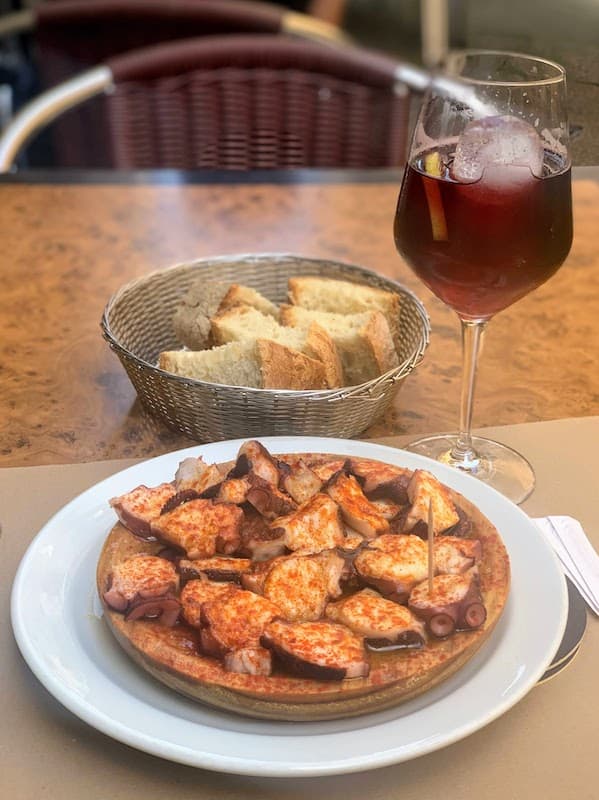
Food of Spain – traditional Spanish foods & famous foods in Spain
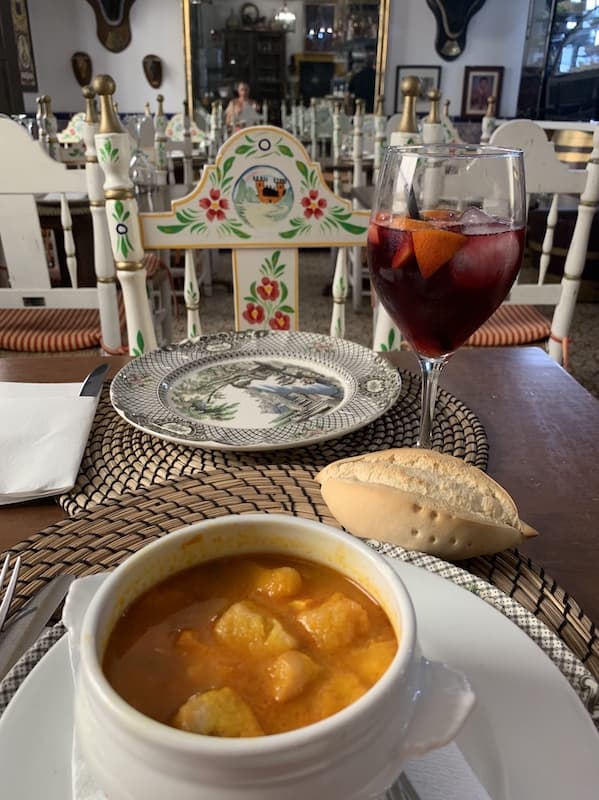
Cultural food from Spain – Traditional dishes in Spain and famous Spanish dishes:
Popular traditional Spanish dishes
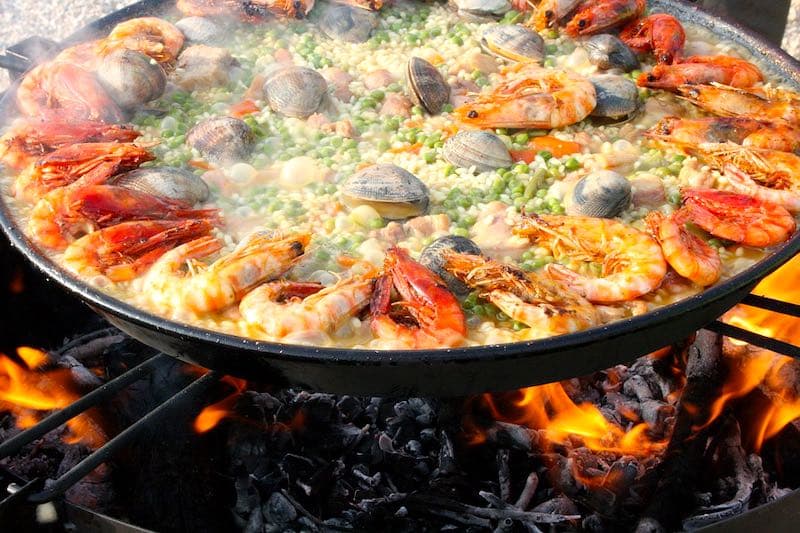
Paella is considered to be a national dish of Spain. If someone asks you to name the top 3 Spanish dishes, yummy Spanish paella will likely be your first thought.
This widely worshiped Spanish rice dish is Spain’s all-time most famous dish. This iconic Spanish food originates from the region of Valencia. But today paella is eaten all over Spain (more in southern Spain than in northern Spain though). Spaniards savor different types of paella: meat paella (with chicken, rabbit, duck), seafood paella (clams, mussels, prawns, calamari, scampi, fish), vegetable paella (vegan paella) or mixed paella (meat, seafood, and vegetables). Spanish paella is traditionally flavored with Spanish saffron and rosemary. Although there are various paella types, authentic Valencian paella is mixed meats paella (rabbit, chicken, sausage, and snails). Authentic paella is one of the most delicious Espana dishes! Paella de Marisco , the seafood paella, is the most famous Spanish paella in the world. It is so easy to get addicted to paella, Spain’s most famous dish for a good reason! Btw, you might like to know that paella in the Valencian language means pan. Beautiful Valencia is among the most beautiful cities in Spain and among the best destinations for foodies in Spain (think of the famous juicy Valencian oranges, besides delicious paella).
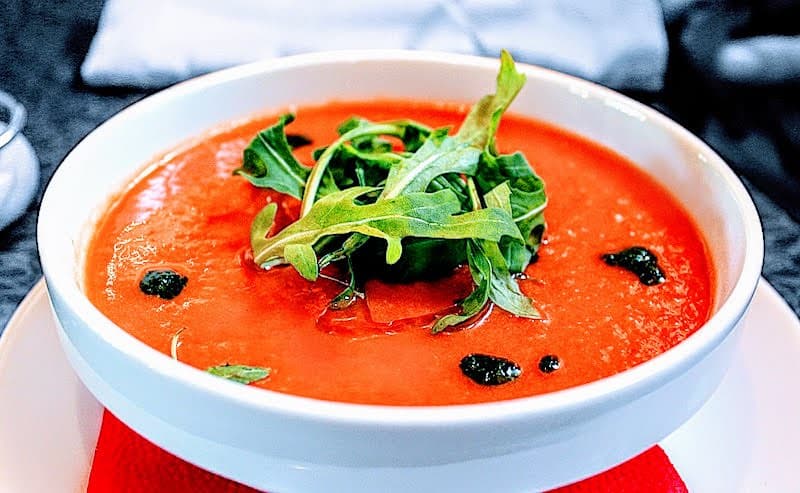
Gazpacho is Spain’s most famous Spanish soup and national dish. It is a tomato soup, smooth in texture. It tastes sweet and refreshing.
This widely popular Spanish soup is prepared with tomatoes, olive oil, bell peppers, cucumbers, garlic, authentic Andalusian Sherry vinegar, and bread. Contrary to common beliefs, gazpacho is drunk from a bowl and not eaten by a spoon! And, it is drunk cold (not warm)! Gazpacho is a top refreshing soup for hot summer days! After all, Gazpacho hails from sunny Andalusia in southern Spain. Gazpacho is a must-try dish in Andalusia!
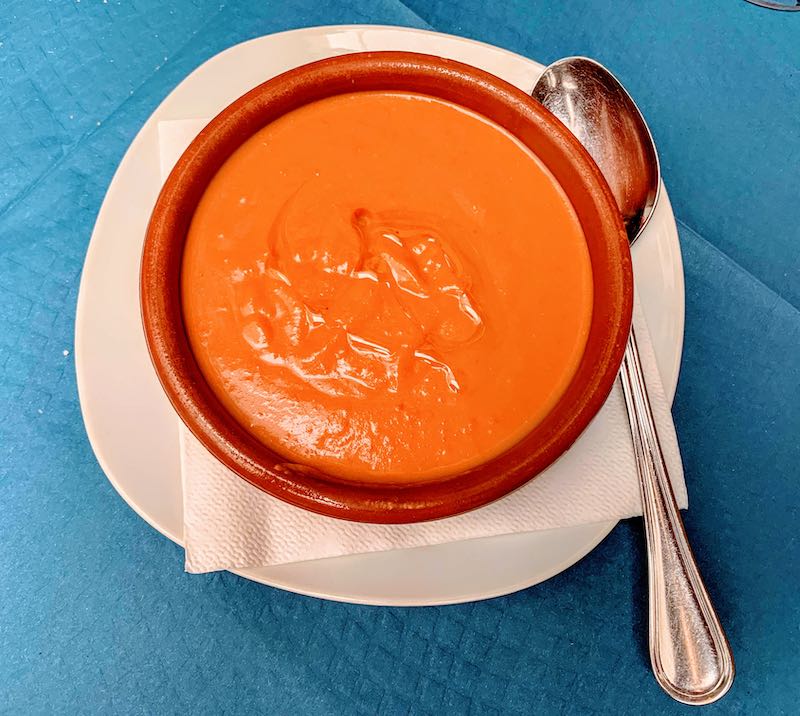
Spanish salmorejo is another popular Spanish dish. Salmorejo is a version of gazpacho originally coming from Cordoba, Spain. I had my first salmorejo in Cordoba. Salmorejo Cordobese is made of pureed tomatoes, bread, garlic, and vinegar. It is served with chopped egg or ham on top.
But, you can order salmorejo without topping ham if you are vegetarian. I prefer salmorejo to gazpacho . In my opinion, salmorejo is one of the best Spanish food dishes. If you are taking a trip to Seville and want to learn how to prepare authentic Andalucian salmorejo , this Spanish cooking class is for you.
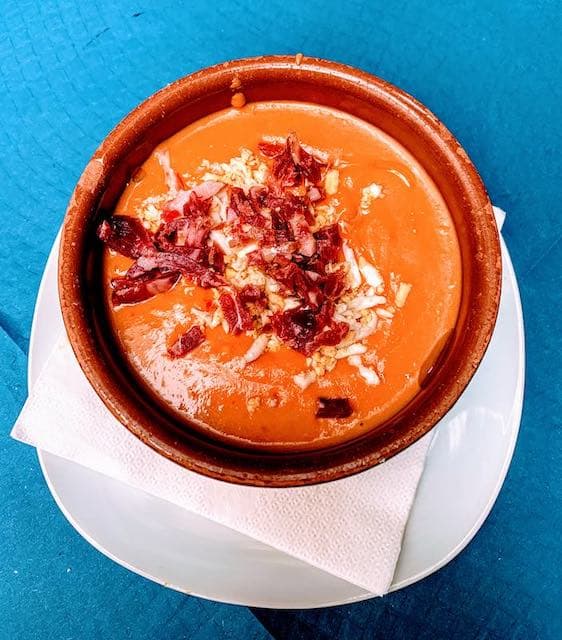
Spanish tortilla , also called Spanish omelet , is the most common food in Spain and one of the most popular foods in Spain too. Moreover, tortilla de patatas is another national dish of Spain and a typical food of Spain. It could be said that tortilla espanola is Spain’s favorite food. Spanish tortilla espanola is a simple tapas dish made of slow-cooked caramelized onions and potatoes in olive oil and eggs. This famous dish from Spain looks more like a quiche than an omelet. Tortilla Espanola is served sliced or squeezed between bread into a sandwich (called bocadillo in Spanish). Tortilla Espanola is a classic Spanish breakfast dish. It was my standard Spanish breakfast while hiking Camino del Norte, Camino Via de la Plata, Camino Sanabres, and Camino Finisterre in Spain.
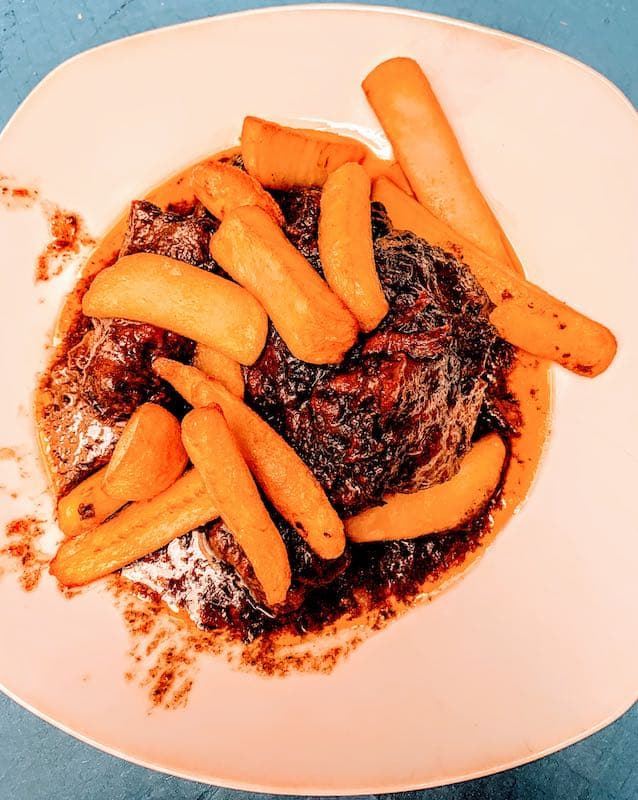
Spanish rabo de toro dish takes a special place among delicacies in Spain and top Spanish food in Spain in traditional Spanish cuisine. Rabo de toro is a famous Spanish bull’s tail stew . Rabo de toro is made by slowly cooking oxtail flavored with red wine, garlic, and thyme at low temperatures. It is an authentic Spanish dish. This typical Spanish dish comes from the town of Cordoba. But today the bull’s tail is one of the most popular Spanish dishes, widely prepared in Spanish homes. Once a working-class meal in Spain, the rabo de toro dish has become a leading delicacy of Spanish gastronomy and one of the top Spanish dishes. To make it short, rabo de toro belongs to the list of famous dishes from Spain you need to taste on your trip to Spain!
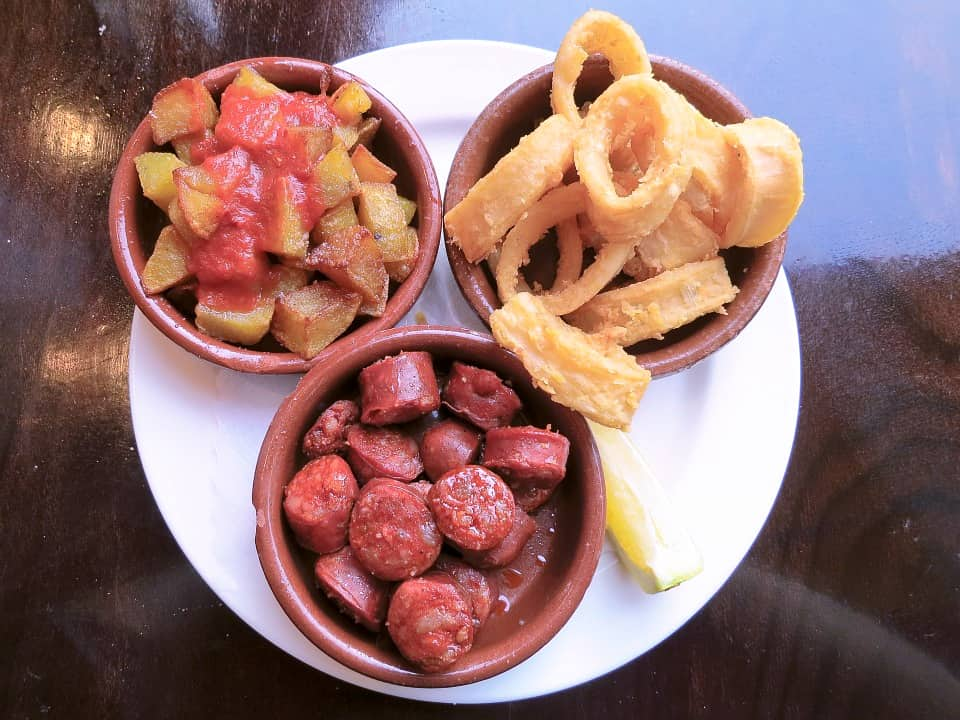
Spanish spicy potatoes are a popular Spanish food as well. Patatas bravas translates to spicy potatoes. Spicy patatas bravas is one of the most popular tapas dishes in Spain . The piquant bravas sauce is made with sweet and hot pimentón paprika. But, Spanish potatoes are moderately spicy (not as spicy as you would expect them to be)! Nevertheless, patatas bravas is one of the most famous Spanish dishes.

Interested in some more traditional Spanish food? ! Let me introduce pullpo a la gallega , one of the most famous Spanish dishes. Galician-style octopus is one of the most delicious Spanish food dishes and the most typical Spanish dishes from the Galicia region in Spain. I explored Galicia on my Camino de Santiago hike. Pullpo a la gallega is a boiled octopus, soaked in paprika, salt, and olive oil. This tender and mouthwatering popular Spanish tapa dish is traditionally served on a wooden platter. Today this famous Spanish octopus dish is one of the most famous Hispanic dishes ever. Pulpo alla Gallega is one my favorite Spanish dishes, that I regularly enjoyed on my Camino de Santigo hike in Galicia. It is one of the Spanish delicacies you need to try! Yummy! Ah, talking about delicious Spanish food makes me crave some tasty bites of pullpo a la gallega !!
Are you planning a trip to Spain last minute? Are you interested in sampling traditional Spanish food in Spain? If you are traveling to Spain last minute, I prepared for you a summary of the best food and drinks tours in Spain! BEST FOOD TOURS IN BARCELONA: Barcelona: Paella Cooking Experience & Boqueria Market Tour (the most popular foodie tour in Barcelona) Barcelona: Tapas and Wine Small-Group Walking Tour (a top-seller foodie tour in Barcelona) Barcelona: Flamenco Show at Tablao Flamenco Cordobes (the most popular tour in Barcelona with optional dinner and drinks) BEST FOOD TOURS IN MADRID: Madrid: Wine and Tapas Walking Tour (the most popular food tour in Madrid) Madrid: The Original Tapas Crawl (a top-seller food tour in Madrid) Madrid Region Wineries: Guided Tour and Tastings (the most popular day trip from Madrid for wine lovers) Check out: Best food tours in Madrid BEST FOOD TOURS IN MALAGA: Málaga: Evening Wine and Tapas Tour (the most popular food tour in Malaga) Malaga: Tapas and Wine Tour with Flamenco Show (a top-seller tour in Malaga with food and drinks) BEST FOOD TOURS IN SEVILLE: Seville: Tapas Crawl (the most popular food tour in Seville) Seville: Flamenco Show in Triana ( a top-seller tour in Seville with food and drinks)
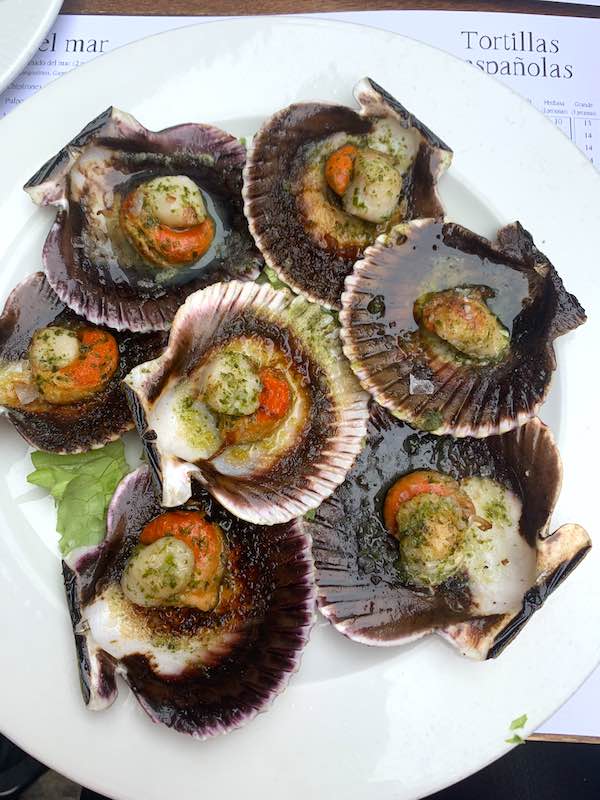
Spanish scallops come from the region of Galicia in northwest Spain. Galician octopus and Galician scallops are some of my favorite food in Spain. Scallops in Spanish are called vieiras . But there are two types of scallops in Spain: vieiras (sea scallops) and zamburiñas (variegated scallops). The shell of the scallop is the symbol of St James, the patron of Spain. Cathedral in Santiago de Compostela in Galicia holds the remains of Saint James the Great, the apostle of Jesus Christ. Therefore, the shell of the scallop is also the symbol of the famous Christian pilgrimage route of Camino de Santiago . Zamburinas a la gallega are my must-have dish in Santiago de Compostela in Galicia! Santiago de Compostela is one of the best cities in Spain worth visiting.
I walked several Caminos in Spain: Camino del Norte , Via de la Plata , and Camino de Santiago a Finisterre . As a part of Camino de Santiago Via de la Plata, I walked Camino Sanabres too. Check out my guides if you are interested in walking Camino de Santiago: Camino de Santiago guide How long is Camino de Santiago 12 Most Popular Camino de Santiago routes Camino del Norte guide Camino de Santiago Via de la Plata Camino de Santiago Sanabres Camino de Santiago packing list Camino de Santiago a Finisterre
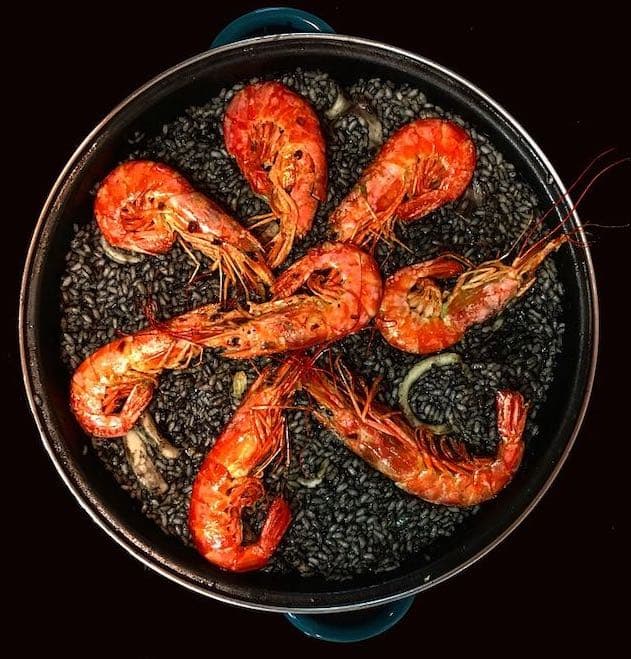
Italy has ‘ risotto al nero di seppia ‘. Montenegro and my homeland Croatia have ‘ crni rižoto od sipe ‘. And Spain has ‘ el arroz negro ‘. In each case, it is a rice dish prepared of white rice with black squid ink, squid or cuttlefish, olive oil, and seafood broth. In Spain ‘ el arroz negro ‘ is sometimes called ‘ black paella ‘, although it is a risotto, not paella. Spanish black risotto originates from Valencia and Catalonia. Therefore, when in Barcelona or Valencia, don’t forget to try ‘ el arroz negro ‘.
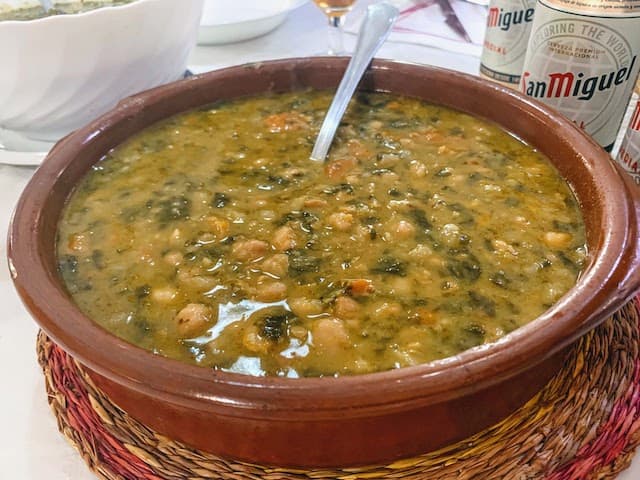
Spanish-style spinach with chickpeas , garbanzos con espinacas in Spanish, is a simple vegetarian Spanish dish. Even more, garbanzos con espinacas is a healthy and vegan Spanish tapa. This simple dish is made with spinach, chickpeas, olive oil, salt, pepper, and garlic and spiced with cumin, ground coriander, and paprika. Breadcrumbs are often added to it. This traditional Spanish tapa comes, guess from where – Andalusia (again, of course!). Seville is the hometown of garbanzos con espinacos and I tried it there for the first time. Moors prepared this first garbanzos con espinacas in medieval Seville. Chickpeas are traditionally used in Arab cuisines a lot. Moors started making the first garbanzos con espinacas in Seville and Andalusia. But, the medieval Sephardic Jews started preparing it as a kosher dish, while medieval Spanish Christians started preparing it as a quintessential meatless dish during Lent. If you are in Seville and looking for some Spanish vegetarian food, go for garbanzos con espinacas – a typical Spanish tapa from Seville.
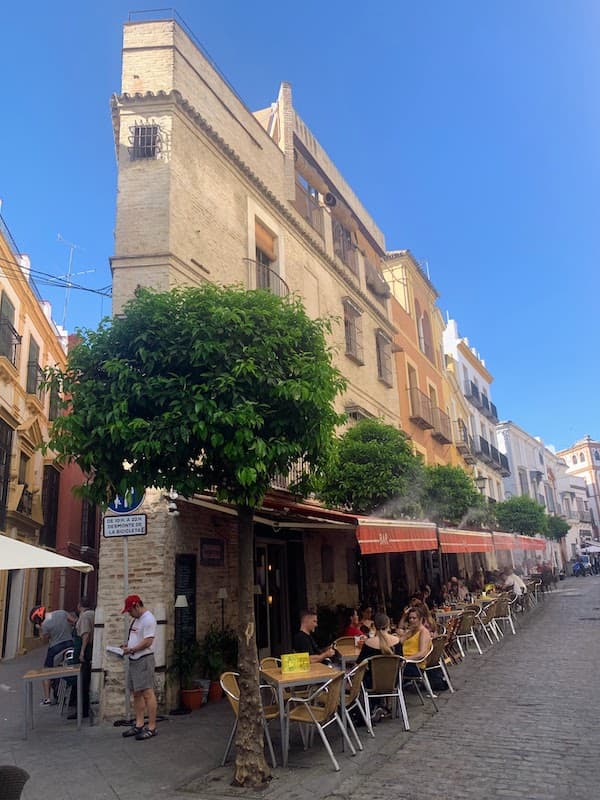
Gambas are prawns in Spanish and ajillo is garlic in Spanish. When you cook Spanish prawns with roasted garlic, olive oil, and small chili in a small clay pot you get a Spanish dish called gambas al ajillo . Spanish garlic prawns are popular Spanish tapas. Garlic prawns are one of those typical dishes in Spain that originally came from Andalusia. But nowadays you can find them in every tapas bar in Spain. If you are a seafood lover like me and up for some good Spanish food, you can’t get wrong with gambas al ajillo! If you are taking a vacation in Malaga , on this evening tapas and wine tour in Malaga you can sample fabulous traditional Spanish tapas with the finest Andalusian wines. RELATED READ: Best Things to Do in Malaga
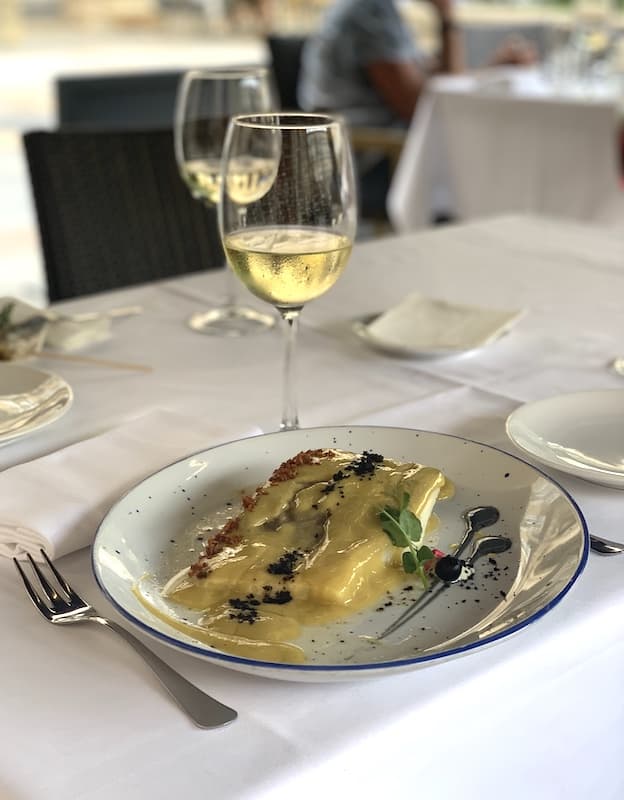
Flavorsome Basque food is highly appreciated around the globe. I Iconic Bacalao Al Pil Pil is the most famous Basque dish and one of the most popular seafood dishes in Spain. The secret of making delicious Bacalao Al Pil-Pil lies in the emulsification of the pil pil sauce . Emulsification of salt cod, olive oil, and garlic happens by simply simmering the pot with the ingredients. It sounds like a simple cooking procedure, but only Basque people know how to do it properly to get one of the all-time best Spanish dishes. If you are planning a trip to the Basque Country, divine Bacalao Al Pil-Pil needs to be on your list of must-try traditional Basque dishes! I had Bacalao Al Pil Pil in Bilbao in the Basque Country and fell in love with it at the first bite! RELATED READ: Seafood in Spain
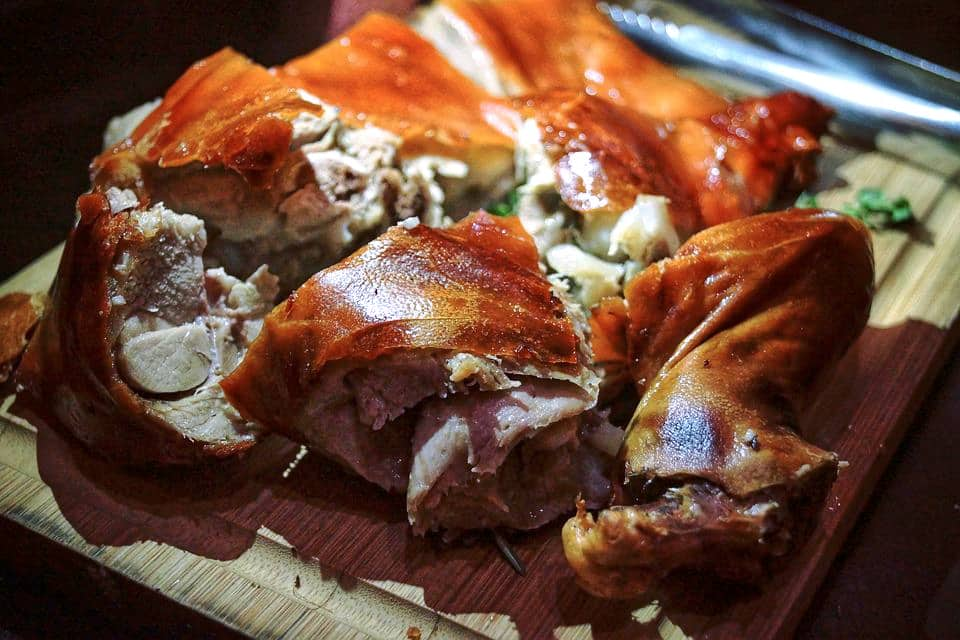
Conchillo Asado is one of the most famous Spanish dishes. This Spanish dish became famous thanks to Ernest Hemingway who mentioned Conchillo Asado in his ‘Th e Sun Also Rises ’ novel. The celebrated author was a regular guest of Sobrino de Botin restaurant in Madrid where he enjoyed this traditional Spanish dish. Sobrino de Botin is known as the oldest restaurant in the world. Roast suckling pig is a traditional Spanish dish from Castille. But, Segovia and Madrid are the most popular places to try C onchillo Asado in Spain. Cochinillo segoviano al horno is the most famous dish from Segovia. But when in Madrid, head to Sobrino de Botin and order Conchillo Asado in Ernest Hemingway’s style. Castillan-style Conchillo Asado is a specialty of the house!
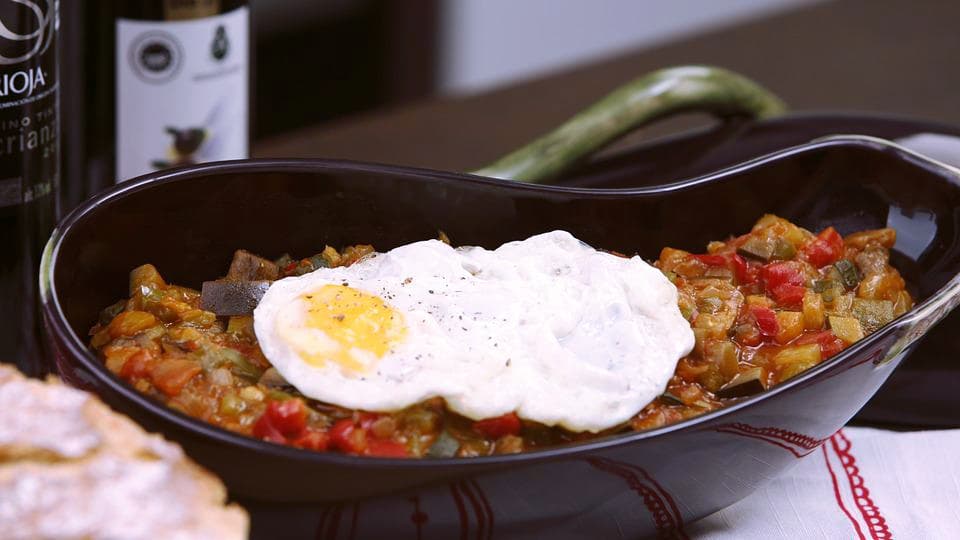
Pisto is a traditional Spanish dish made with vegetables. Spanish pisto is a vegetarian Spanish dish. Common ingredients of typical Spanish pisto are chopped and finely diced zucchini, eggplants, tomatoes, onions, and red and green peppers. Spanish pisto is traditionally served with Manchego cheese and egg on top.
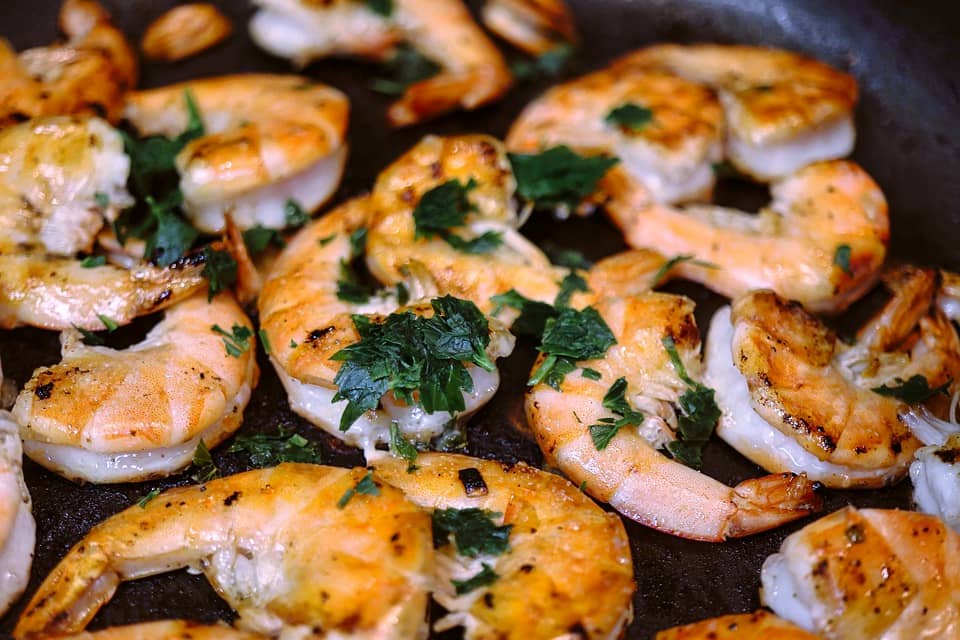
Grilled prawns in Spain are traditionally seasoned with olive oil, and sometimes even white wine. Gambas a la plancha are served with aioli sauce (a famous Spanish sauce made of olive oil and emulsified smashed garlic), juice lemon, and sometimes even mayonnaise. Grilled prawns are a popular hot tapas dish, traditionally served for Christmas in Spain.
16. Almejas a la gaditana – Cl ams in sherry s auce from And alusi a
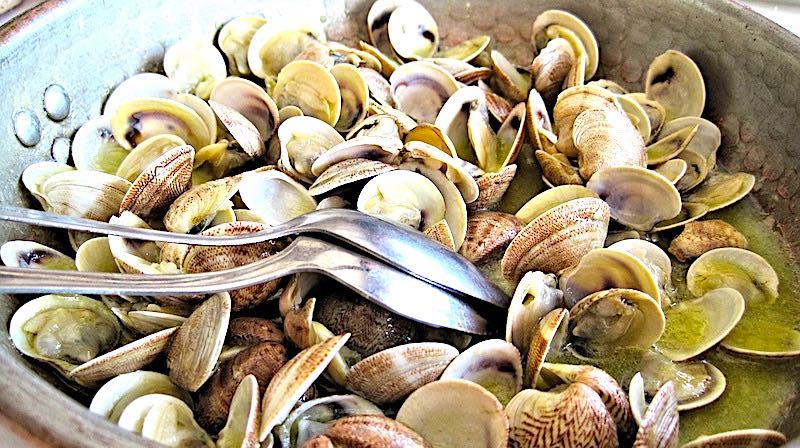
Clams are a popular food in Spain. And Almejas a la Gaditana is a famous seafood dish from Andalusia. This traditional Spanish dish is made with clams cooked in a broth, made of olive oil, finely chopped garlic, chopped parsley, a little bit of salt and pepper, and sweet Sherry wine from Andalusia. If you are traveling to southern Spain , cl a ms in sherry s a uce belong to the best Spain dishes.
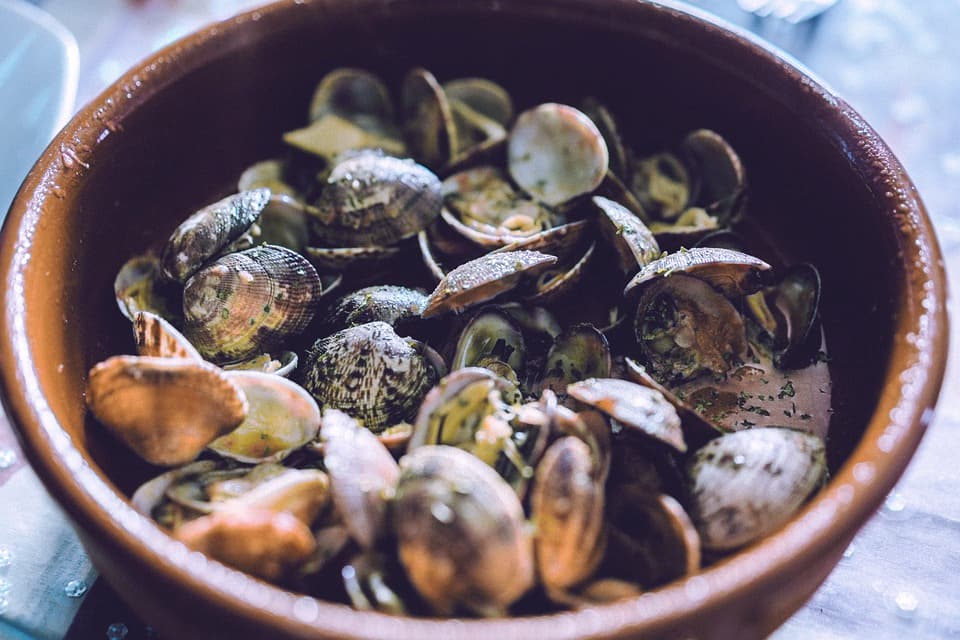
Clams in a green sauce, or almejas en salsa verde , is a popular dish hailing from the Basque Country in northern Spain. The salsa verde (green sauce) is made with plenty of parsley, olive oil, white wine, a pinch of salt, and a small tablespoon of fleur (to thicken the sauce). Fresh and cleaned clams are cooked in the green sauce for about 5 minutes. And, that’s it! Remember, order almejas a la gaditana when you travel to southern spain. But, order almejas en salsa verde when you travel to northern Spain!
18. Bacalao ajoarriero – Spicy codfish from northern Sp ain
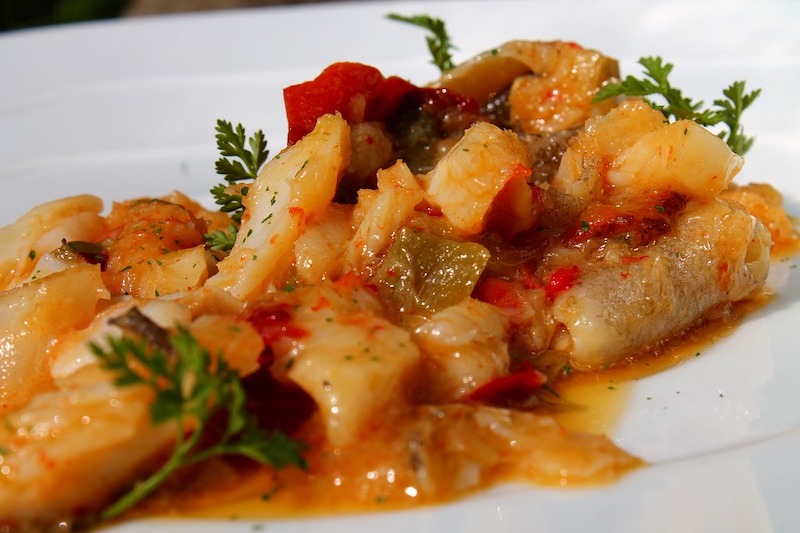
Dishes made with codfish are among the most popular fish dishes in traditional Spanish cuisine, especially in the cuisines of northern Spain. Bacalao Ajoarriero is a popular Spanish codfish stew from the Navarre region and the Basque country in northern Spain. This famous Spanish dish is also c alled ‘ Bacalao de Pamplona ’ in Pamplona.
Bacalao de Pamplon a was the favorite Spanish dish of Ernest Hemingway while he lived in Pamplona.
Bacalao Ajoarriero is a simple traditional Spanish dish. It is made from cod chunks cooked with olive oil, grated tomatoes, potatoes, chopped pepper, chopped onion, and lots of – lots of minced garlic cloves and smoked Pimentón de la Vera paprika. If you like codfish and want to try one of the most famous Spanish dishes in Sp ain, try Bacalao de Pamplona in Pamplona.
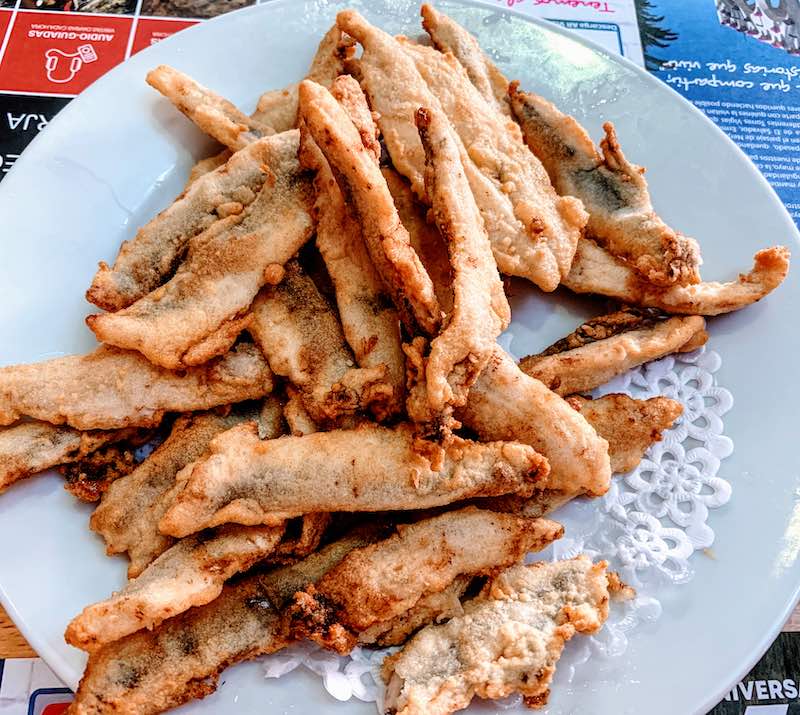
Spanish fried anchovies are on the menu of all tapas bars in Spain. Boquerones fritos are one of the most popular foods in Spain. Best fried anchovies you can find in chirinquitos (Spanish beachfront bars). If you are in Barcelona, on Costa Brava or Costa de Sol , look for a chirinquito ! And don’t think twice about ordering boquerones fritos. This typical Spanish food will make you ask for more!
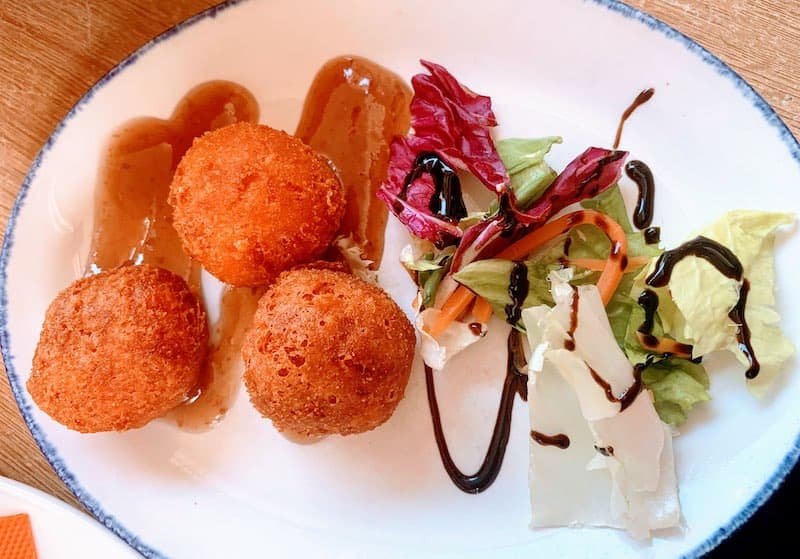
When we talk about tapas food in Spain and common foods in Spain, Spanish croquettes are on the list, for sure. Spanish croquettes are fried breadcrumbs and food leftovers tied with potatoes and bechamel sauce. Croquettes in Spain are made with jamon (cured ham), bacalao (codfish), queso (creamy cheese), morcilla (local black sausage ), or queso de Cabrales ( Spanish blue chees e). Crispy Spanish croquettes are typical Spanish tapas food .
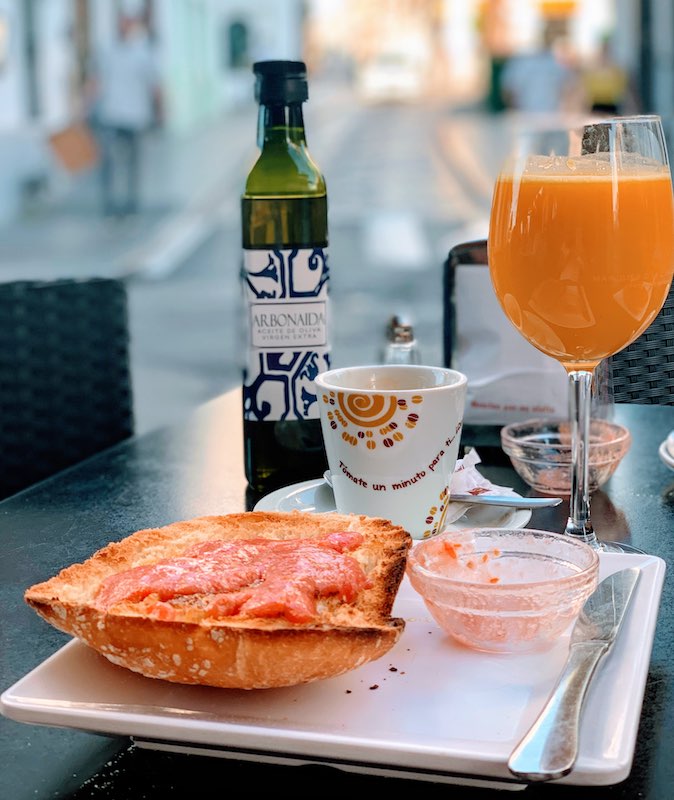
Spanish bread with tomatoes might sound like a simple dish, but it is one of the most famous dishes in Spain and exceptionally toothsome! Pan con Tomate is toasted bread with fresh grated tomatoes sprinkled with salt and olive oil. This quick and easy Spanish tapa is eaten for breakfast but as an appetizer at night. Pan con tomate with cafe cortado and freshly squeezed orange juice was my typical Spanish breakfast while hiking Camino de Santiago across Spain. Pan con tomate is also called pan tumaca (in Catalonia, Aragon, and the Balearic islands). Remember, pan con tomate might be common Spanish food and seem like a humble dish, but trust me, it is not humble in taste. Quite the opposite, it is divine! A top Spanish food, again! Crispy pan con tomate goes on the list of the tastiest Spaniard food.
Traditional Spanish snacks
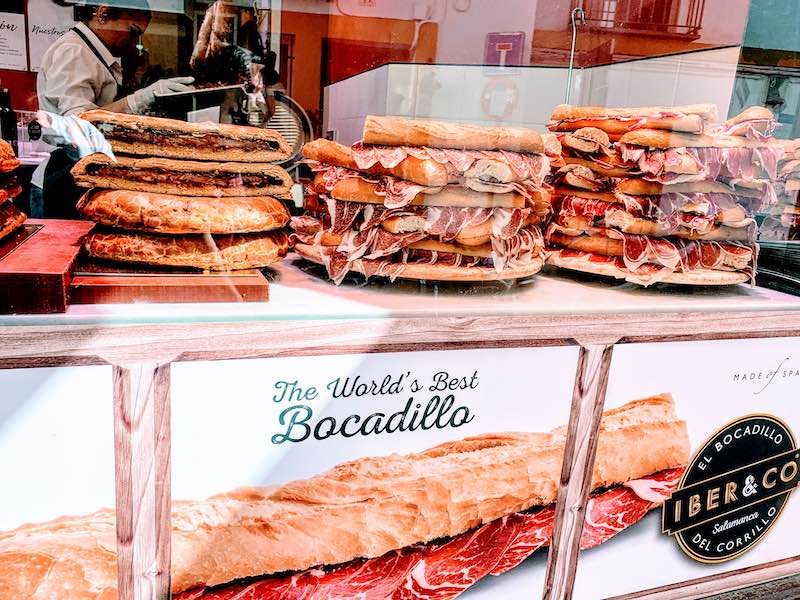
Bocadillo is a traditional Spanish sandwich made with baguette-like bread. These high-in-demand Spanish sandwiches are the most common Spanish food eaten everywhere in Spain: from Spanish taverns, tapas bars, cafeterias, and restaurants to Spanish homes. This famous Spanish snack comes in many forms. Various types of bocadillos sandwiches are popular traditional Spanish food. The most popular types of bocadillos are omelet bocadillos , cold meat bocadillos , vegetarian bocadillos , egg bocadilllos , fish bocadillos , cheese bocadillos , and even sweet bocadillos . For sure, these popular Spanish snacks are some of the top favorite Spanish food!
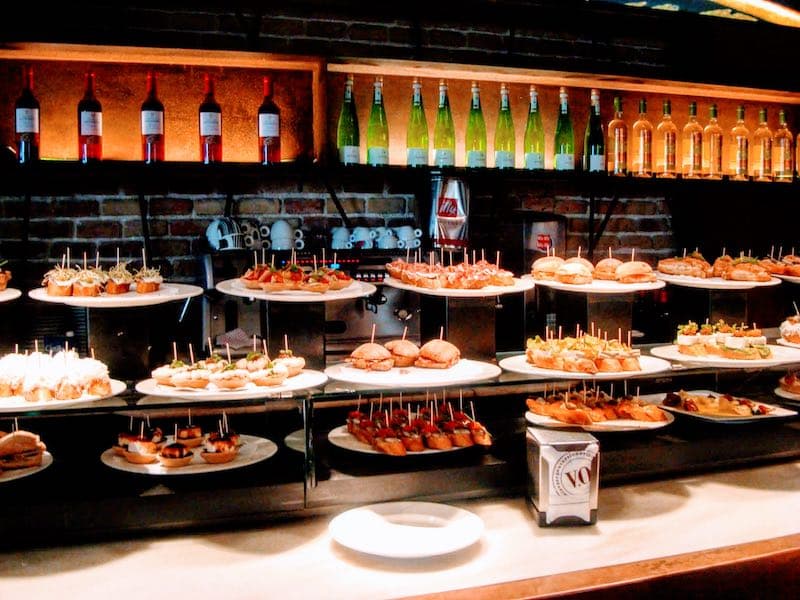
Spain is not in love with only big sandwiches – bocadillos , but with tiny Spanish sandwiches – montaditos as well. Montaditos are popular Spanish foods eaten in every corner of Spain. You know the expression: ‘good things come in small packag es ‘. Well, try this Spanish finger food!
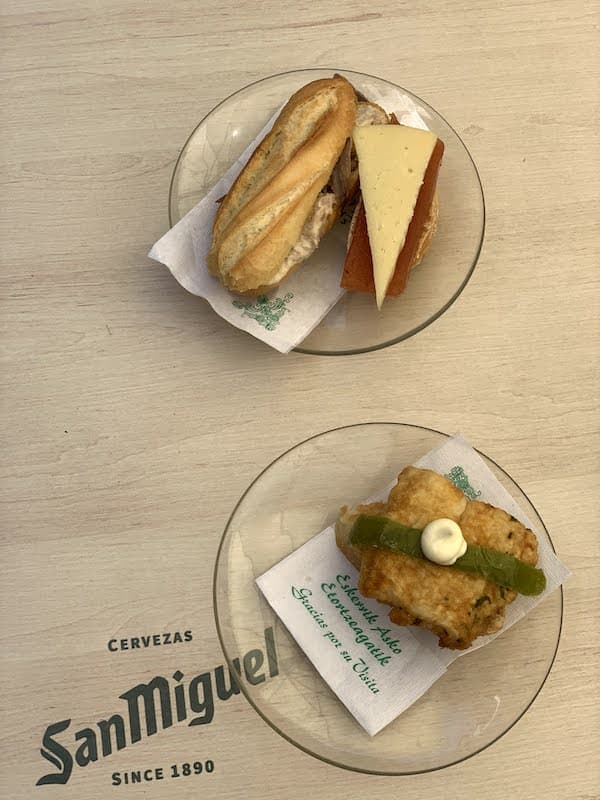
Pintxos also spelled pinchos , are traditional Spanish food from the Basque country. Pintxos are small plates of food traditionally served in the Basque country. Pintxos are famous Basque appetizers. Pi ntxos are made of bread slices with meats, cheese (most notably, Idiazábal cheese), cod, squid, octopus, anchovies, olives, and pickled peppers ..and served with a skewer or toothpick. The word ‘pintxo’ means ‘spike’ in the Basque language. Pintxos are traditionally enjoyed with Txakoli wine, (a Basque dry and slightly sparkling wine). Late Anthony Bourdain raved in his ‘Parts Unknown’ about wild mushrooms with egg yolk pintxos in Ganbara restaurant/bar in San Sebastian. Btw, do you know that San Sebastian is the food capital of Spain? San Sebastian is the top destination in Spain for foodies ! Anyway, it could be said that delicious pintxos are ‘the next level tapas’. Pintxos are a Basque food artwork. Tasty pintxos are some of the best foods in Spain! Remember, order tapas in Spain. But, when you travel to the Basque Country in the north of Spain, order pintxos.
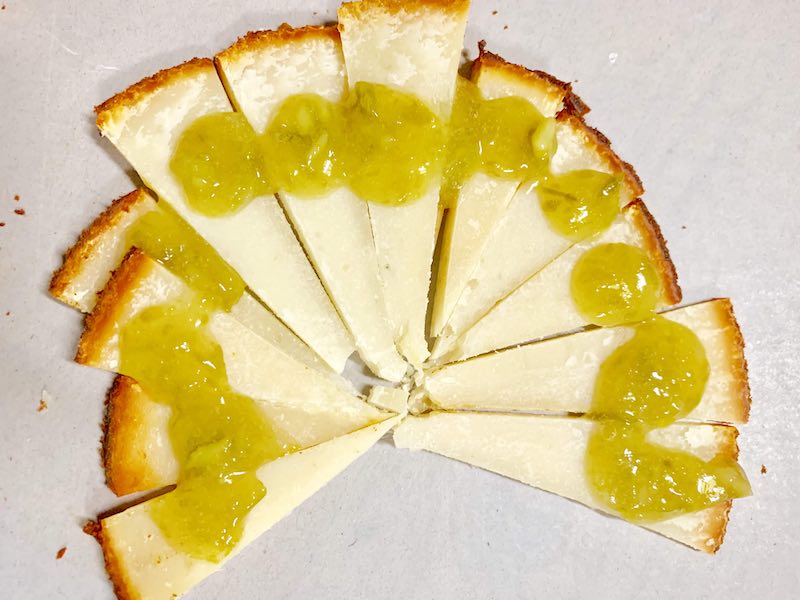
As I said, Spanish Manchego cheese is traditionally served with quince jam ( membrillo ). Queso Manchego con membrillo is a classic Spanish tapa. The blend of sweet quince and slightly salty but nutty Manchego cheese is to die for. Let me add here, I would go back to Spain at this moment just to get some divine slices of Manchego con membrillo !
26. Pimientos de padron – The popul a r Spanish Padron peppers
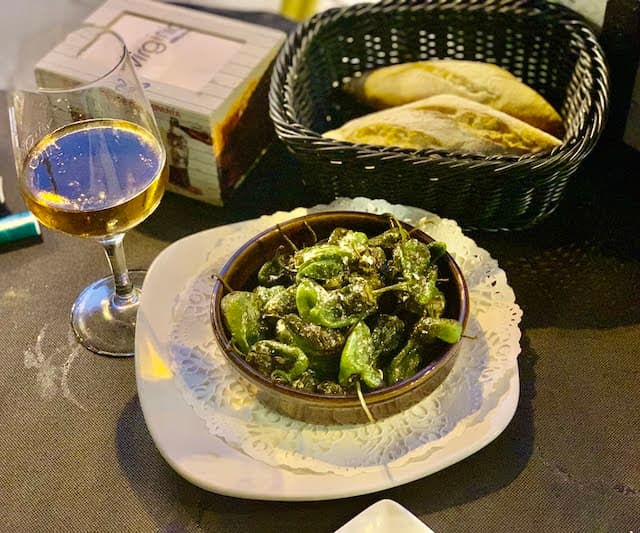
Tiny blistered green peppers from the municipality of Padrón in Galicia are some of the most popular Spanish tapas. Fried Padrón peppers are typically mild in taste, but be aware as there’s always the possibility of encountering a spicy pepper! Tasty Padrón peppers are sprinkled with coarse salt and served hot!
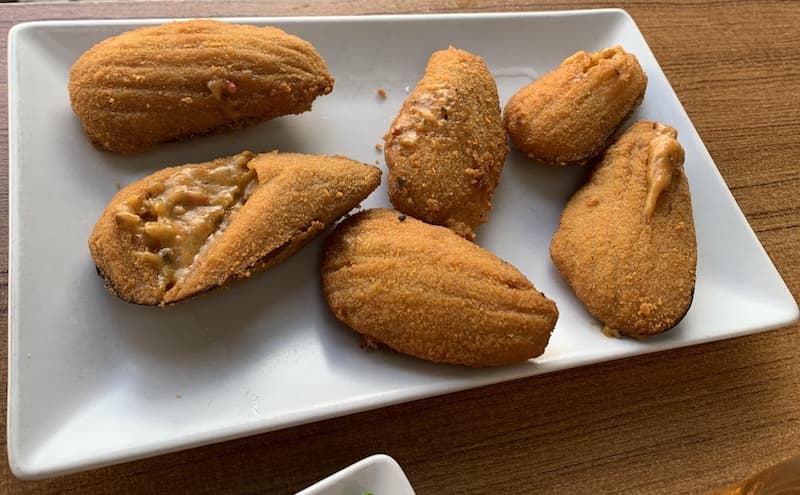
Interested in some more different foods in Spain? What about Spanish tigres? Mejillones rellenos , also called tigres, are famous Spanish tapa from Galicia and the Basque country. Tigres are spicy stuffed mussels and a must-try dish in northern Spain. To make a long story short, this yummy Spanish tapa dish is prepared with steamed whole mussels that are left in the shells, covered with bechamel sauce (made with dry white wine, and a pinch of spicy peppers), and all together fried with dry breadcrumbs. In my opinion, tigres mussels belong to the list of the very best tapas in Spain !
28. Empanadas – The famous Sp anish p astries
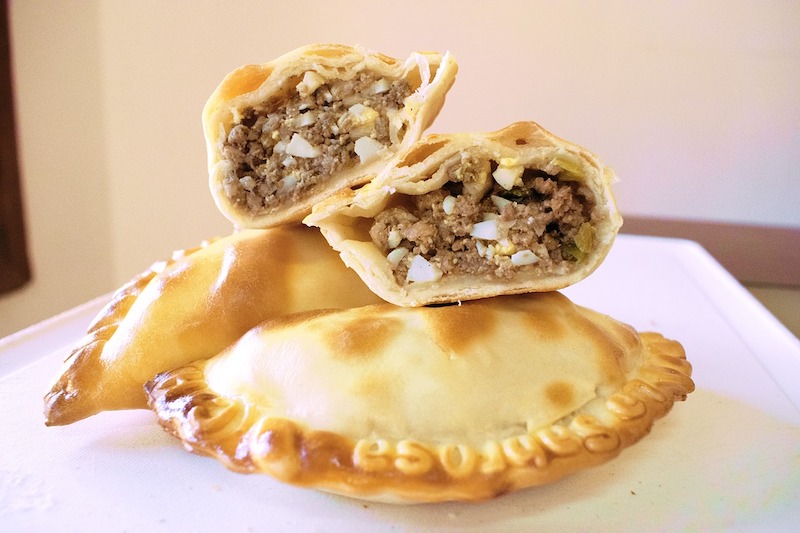
Empanada is a f amous Sp anish dish. Spanish empanada is a baked or fried p astry that comes with various fillings. The filling can be s avory or sweet. Thus, there are savory emp an ad as and sweet em p an ad as . Savory empanadas are typically filled with meat, cheese, vegetables, and sometimes even fish. Sweet empanadas are typically filled with fruits, usually plums, and apples. Sweet and savory empanadas are some of the most popular authentic dishes from Spain. Empanadas originate from the region of Galicia in northwest Spain. However, you can find empanadas in the cuisines of Latin America, the Philippines, and southern Europe. Empanadas are some of the most popular dishes from Spanish-speaking countries.
2 9. Picos – The popular Spanish breadsticks
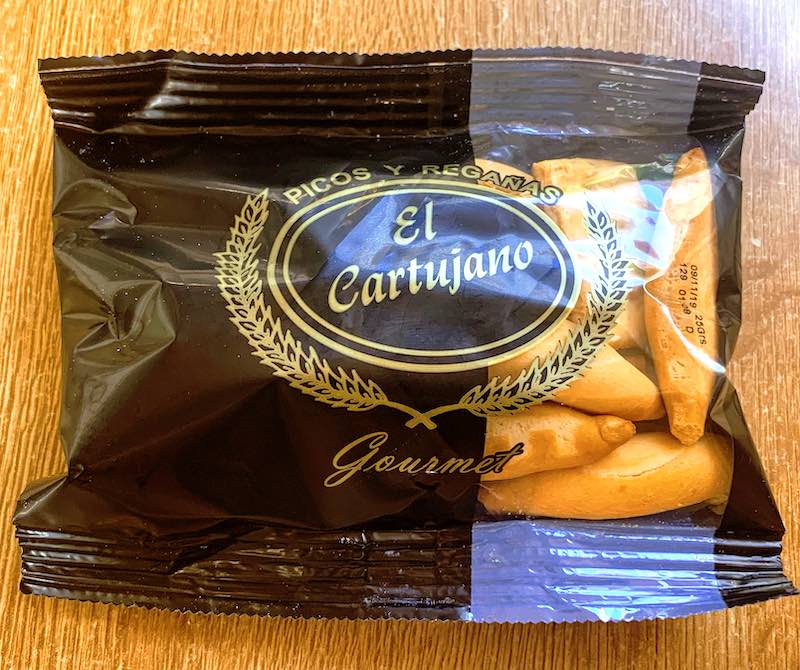
Breadsticks called picos are popular Spanish snacks served typically with soups and salads in Spain. Thus, when you order gazpacho or salmorejo , expect to get picos with them too. But, equally important, these crunchy snacks are simply enjoyed with a bowl of olives and a glass of wine in bars and restaurants across Spain.
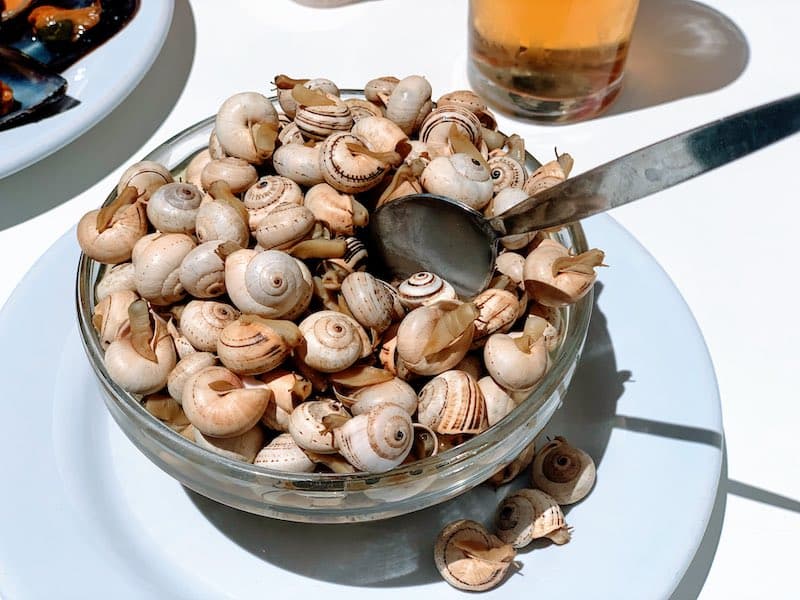
If you seek to taste something beyond classic Spanish dishes and somewhat bizarre but delicious and unique Spanish foods, you should try Spanish caracoles (snails) . Snail tapas might look and sound odd, but you might be surprised to find out that snails in Spain are Spanish traditional food, common Spanish tapas, and even more favorite spring tapas in Spain. Like it or not, caracoles are a cultural food in Spain. If you are traveling to Spain in the season of snail tapas (in May and June) and want to try one of the unique dishes from Spain, make sure to check out this exceptional Spanish tapa dish. Read more about my experience of eating snails in Spain: Eating Snail Tapas in Spain
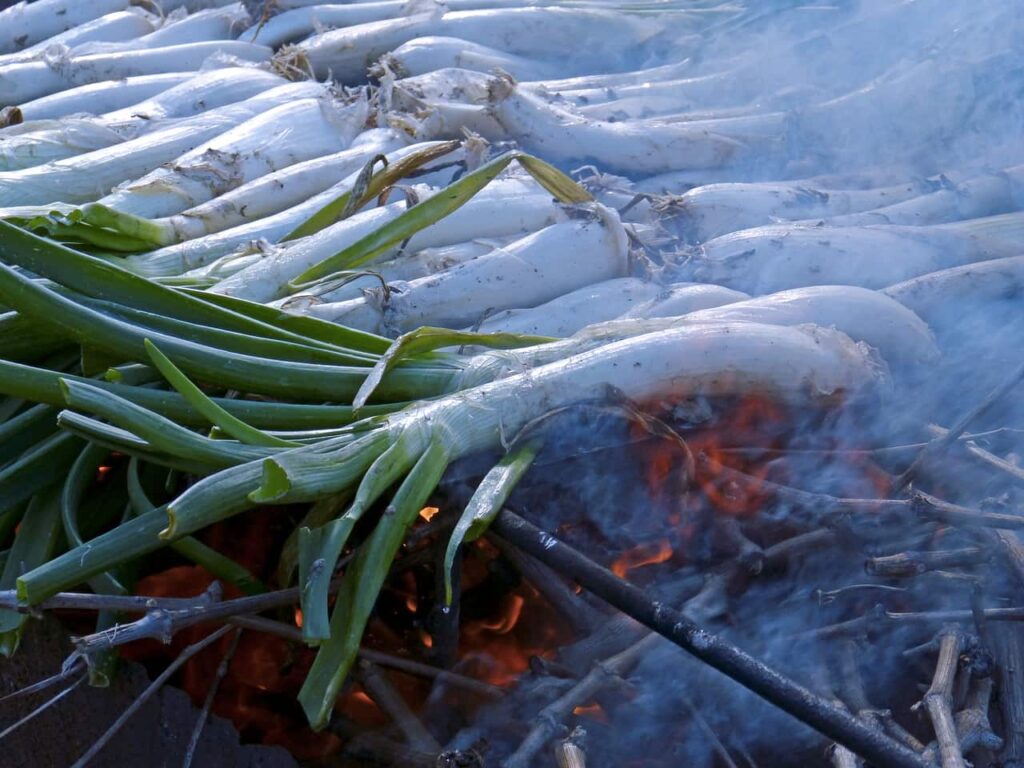
Calcots are unique calcot onions from Catalonia. Calcots have a Protected Geographical Indication. Grilled calcots are a popular Spanish dish from Catalonia. Grilled calcots over an open fire are tender and soft from the inside. They are typically eaten with romesco sauce (made with olive oil, vinegar, garlic, tomatoes, dried peppers, nuts, and bread), or calçots sauce (made with oil, garlic, tomato, almonds, ñora, and escalibada).
Calcots are typical spring food in Catalonia. So, if you travel to Barcelona in spring, don’t forget to try calcots! Calcots are some of the best traditional foods in Barcelona !
Famous Spanish delicacy
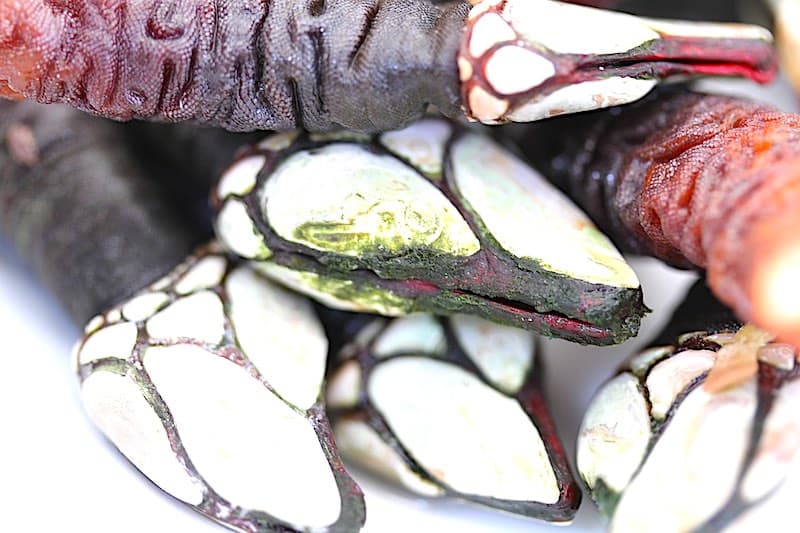
Are you interested in some more weird food from Spain? Try Spanish percebes! Percebes , or goose barnacles, are some of the most expensive food in Spain. The price of goose barnacles in Spain goes up to 200 EURO per kilo. And during the holidays even more! Twist the tube of boiled percebes off, slip the flesh down, and eat them. This weird and luxurious Spanish tapa tastes like something between clams and lobster. Goose barnacles are a delicacy from Galicia, Asturias, and the Basque Country. Goose barnacles are called lamperna in the Basque country.
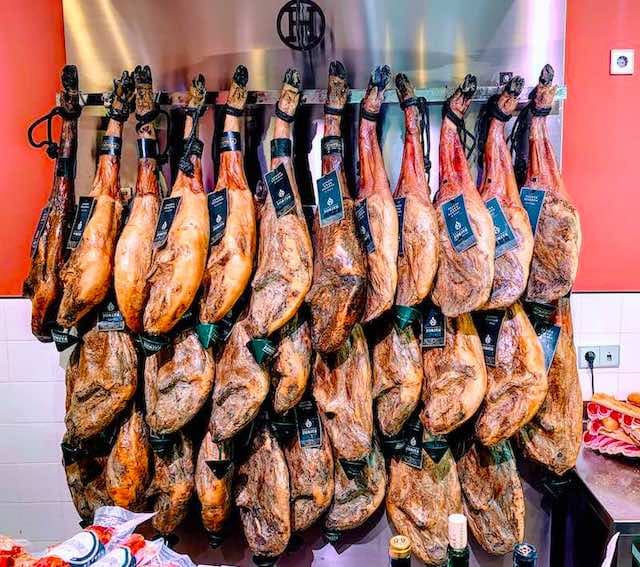
Iberian ham , jamon iberico in Spanish, is traditional Spanish food. Jamon Iberico is one of the most typical foods in Spain and one of the most expensive tapas in Spain . Ruby red salted and air-dried Spanish cured ham hangs in almost every bar and restaurant in Spain. Jamon Iberico arguably stands as a trademark of Spain. Unnecessary to say, that Iberian ham is one of the most popular Spanish foods, if not the most popular food in Spain.
Jamon Iberico is also known as pata negra in Spain. If you are looking for ‘food made in Spain’ or native Spanish food, Spanish jamon iberico needs to be on your bucket list of authentic Spanish food. There are two types of cured Spanish ham: jamon serrano and jamon iberico. Jamon iberico de bellota is top-quality ham (the finest ham in Spain), while jamon serrano is of less quality and cheaper Spanish ham.
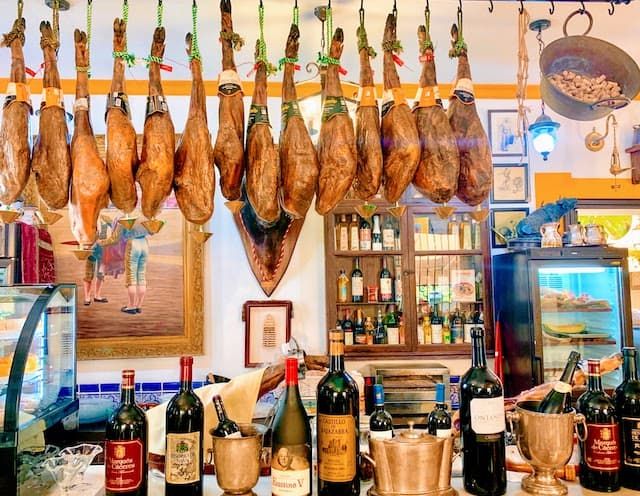
Sea urchins are often called ‘truffles of the sea’. Seafood lovers claim sea urchins to be the ultimate delicacy. Sea urchins are salty but foamy in texture and go well with sparkling white wine. Spaniards love sea urchins too. Erzo de Mar Marisco is a popular tapa dish in Spain. Sea urchins are found on the Galician and Catalonian coasts in Spain. I tasted Spanish sea urchins at the famous Mercado de San Miguel in Madrid. Madrid’s Mercado de San Miguel is known for its fabulous selection of Spanish food. Check it out when in Madrid!
35. T xipirones en su tinta – The Basque baby squids in their ink sauce
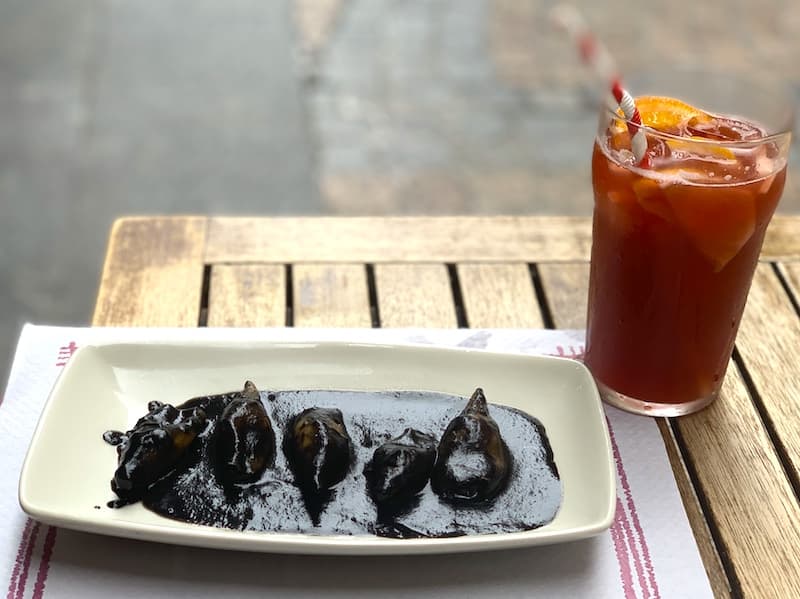
Basque Country in northern Spain is known for fabulous pintxos and delicious seafood dishes. Squid in ink , or txipirones en su tinta in the Basque language, is one of the most famous Basque dishes. The black sauce is made with squid ink and sweet onions. This popular Basque dish is one of the all-time best Spanish dishes.

Angulas are baby eels and a famous Spanish delicacy. Angulas are most associated with Basque gastronomy since they are traditionally eaten in the Basque Country. They are called the caviar of Northern Spain. These pale and tiny eels’ offspring are among the most expensive food in Spain. A kilo of baby eels often reaches the price of 1,000 euros. You can savor baby eels in Spain in different dishes, from Angulas a la bilbaína (Angulas a la Bilbao) to simple pinchos with angulas (like in the photo below).
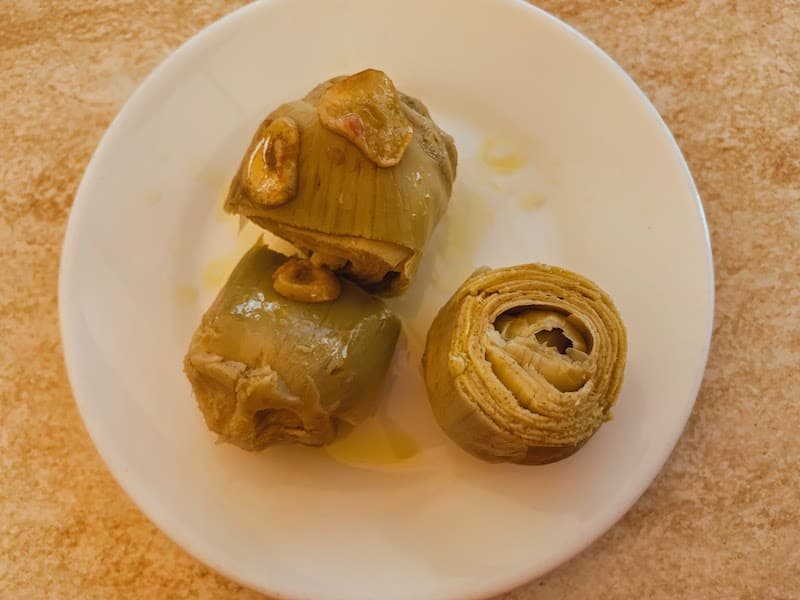
Artichokes are a delicacy food in many Mediterranean countries, like Italy, France, and Croatia. Articles are a springtime delicacy food in Spain, too.
Garlic Artichokes, or Alcachofas al Ajillo in Spanish, is a favorite spring tapa dish in Spain. It is a simple Spanish tapa dish. Boiled artichokes are drained and sauteed in olive oil with garlic. Spanish garlic artichokes dish pooves that perfection lies in simplicity. I ate alcachofas al ajillo in Cordoba is southern Spain. So, if you are traveling to southern Spain in spring, don’t miss out on trying this authentic Spanish delicacy!
Common Spanish food
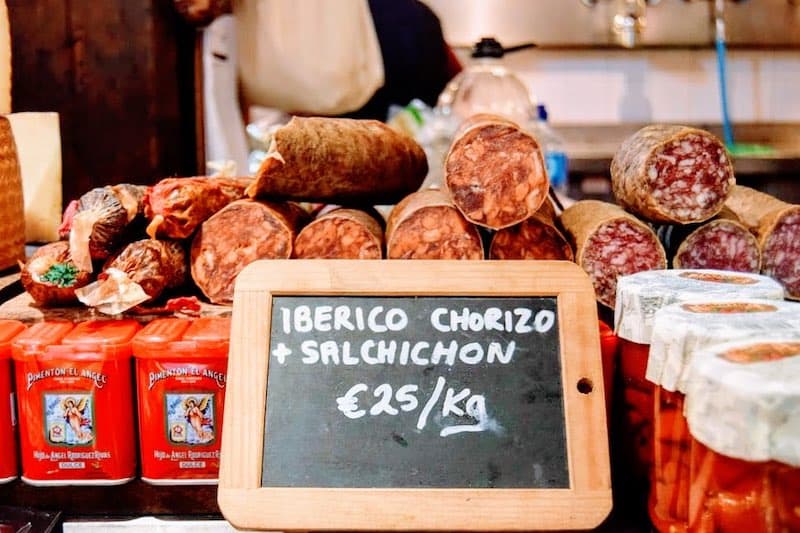
The list of Spanish food from Spain wouldn’t be complete without Iberico chorizo .
Chorizo, aka sausag e, is a typical Spanish food. Spanish pork sausage with sweet and spicy paprika flavor is called chorizo . To be more precise, this fresh or cured Spanish sausage is made of chopped pork marinated in pimentón (Spanish smoked paprika), herbs, spices, and white wine. Spanish chorizo is one of the common foods in Spain. It is eaten solely along with bread or as an ingredient in many popular Spanish dishes. Yes, chorizo comes in many common Spanish dishes. Spanish pork sausage is a kind of food that blends well with almost everything. Spanish chorizo is one of those Spanish cultural foods that come in different variations: sweet, spicy, smoked, unsmoked, fresh, and dry-cured. After all, chorizo is one of the traditional foods from Spain you need to try while in Spain.
Popular Spanish cheese
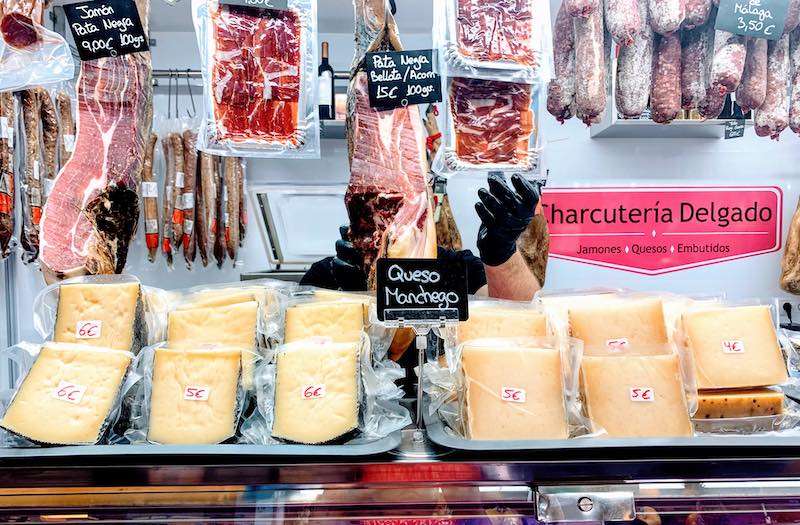
When we talk about famous Spain food, then cheese from Spain needs to be mentioned too. Authentic Spanish cheese is some of the yummiest traditional Spanish food. Queso Manchego is an authentic Spanish cheese made of milk of the Manchega sheep from the La Mancha region in central Spain. Needless to say, Manchego cheese is the most popular Spanish cheese and should be on any Spanish food list. This semi-hard cheese is characterized by sweet caramel and a nutty flavor. Spanish Manchego goes well with toasted almonds, honey, and fruits. But most commonly Manchego in Spain is served with membrillo (quince jam). If you are after amazing food products from Spain and some of the best and most famous food in Spain, you need to try queso Manchego!
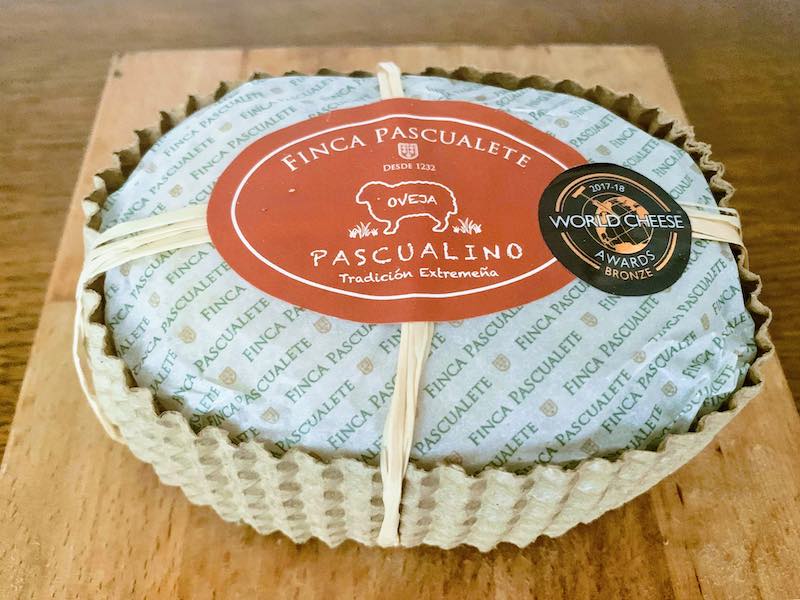
Manchego cheese is the most famous Spanish cheese. But Spain produces many types of first-class cheese. Here I am listing one of them – Pascualino cheese , as I would love you to try it in Spain. As you can see in the photo it won some world awards. Pascualino queso is a raw sheep cheese, oval in form, and smooth in taste with vanilla, caramel, toffee, and violet flavors. I bought Pasqualino cheese as a souvenir from Spain and a gift to my family. They loved it!
Popular Spanish desserts
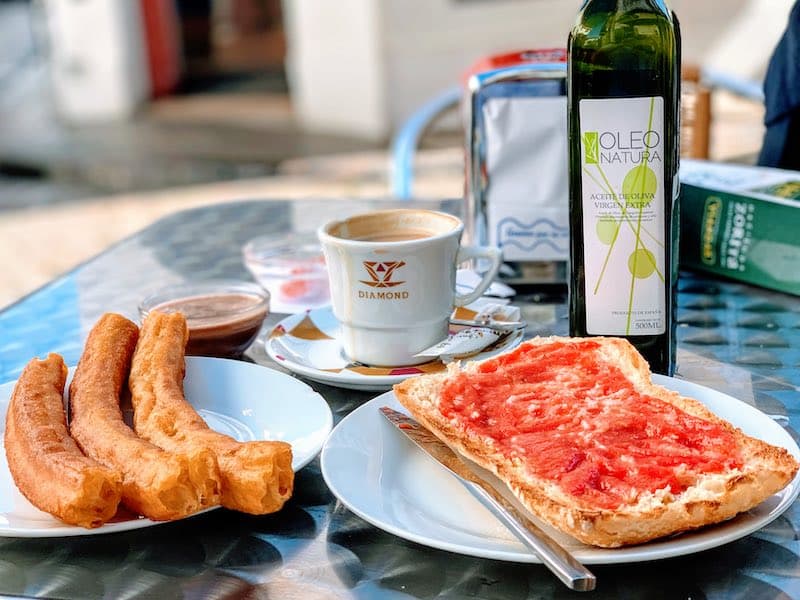
When talking about traditional food from Spain and popular food in Spain, on the list should be popular desserts in Spain too. So, let’s talk about authentic Spanish desserts. Churros with chocolate is undeniably a Spanish favorite dessert. Spaniards eat their beloved churros daily while sipping coffee for breakfast. Typical Spanish breakfast includes dipping churros in dark chocolate. Churros con chocolate are some of the best Spanish food you need to try in Spain! Coffee and some sweets for breakfast? I am in. And what about you? RELATED READ: Traditional Spanish breakfasts

France has creme brulee , and Spain has c rema catalana. Spanish custard with a caramel topping is one of the most popular Spanish desserts. This creamy Spanish dessert is made only of milk and eggs, and with just a little bit of cornstarch to thicken the texture. Authentic Crema Catalana is flavored with lemon peels and cinnamon sticks. A perfect fit for a king! RELATED READ: Traditional Spanish desserts
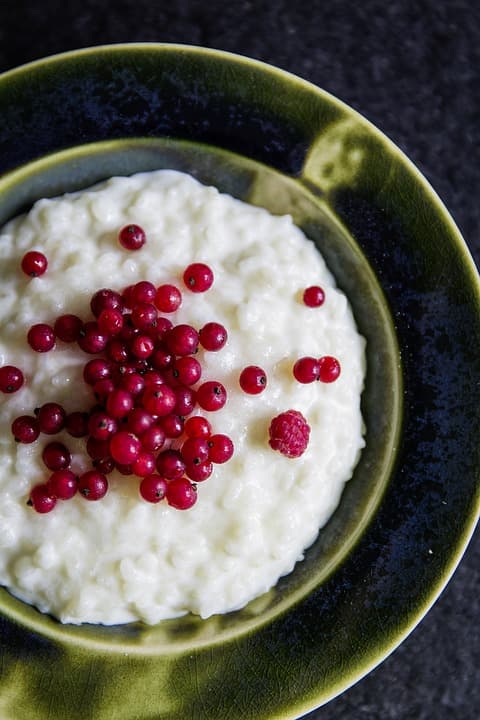
Rice pudding is a popular dessert in many countries, including Spain. Rice pudding in Spain is called Arroz con Leche . There’s no need to explain why rice pudding is so popular. Let me just say that creamy rice blends perfectly with sweet and warm cinnamon and refreshing lemon. So, if you like rice, cinnamon, and lemon, Arroz con Leche is the go-to Spanish dessert!
44 . Tortas de aceite – The traditional Spanish olive oil biscuits
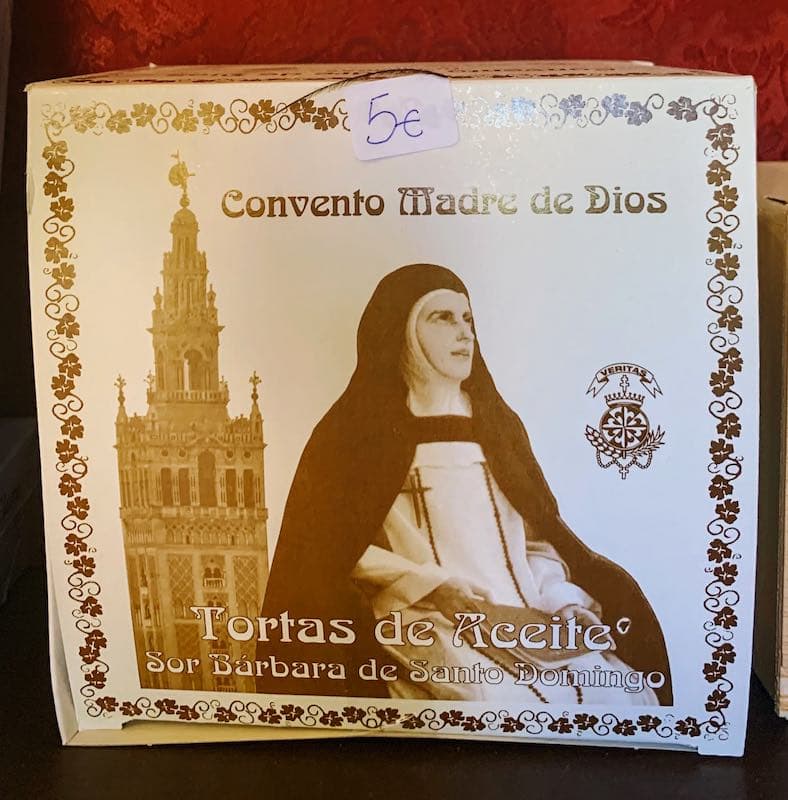
Spanish olive oil tortas are famous Spanish biscuits. Tortas de aceite of wheat flour, white egg, sugar, and olive oil with anis, sesame seeds, and almonds. Although these crispy sweet wafers originate from southern Spain , today tortas de aceite are enjoyed all over Spain.
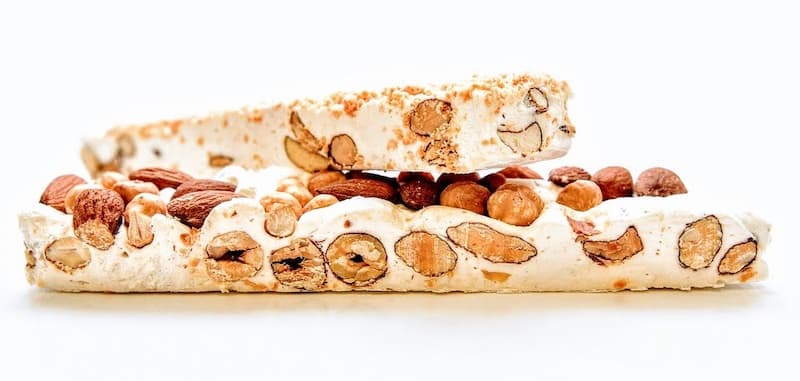
Turron is the most famous Spanish sweet. Spanish turron is a nougat candy made of sugar, eggs, honey, and roasted nuts, most commonly almonds but sometimes pistachios too. There are two main types of turron: turron de Alicante (or turron duro ) and turron de Jijona (or turron blando ). Turron de Alicant e is hard and brittle, while turron de Jijona is soft and chewy. Just to mention, Spain is the biggest exporter of turron in the World, although ‘torrone’ (as it is called in Italy) is popular foods in Italy too. Don’t forget to try turron while in Spain!

Magdalenas are traditional Spanish muffins. Spanish magdalenas are simple muffins but more fluffy and more lemony than muffins you can find in other countries. Spaniards traditionally use a lot of lemon for flavoring cakes and biscuits. So, Spanish muffins come with a generous amount of lemon flavoring. Magdalenas are some of the most popular Spanish cakes. Lemony magdalenas are sold in bars across Spain and are typically enjoyed with coffee for breakfast in Spain.
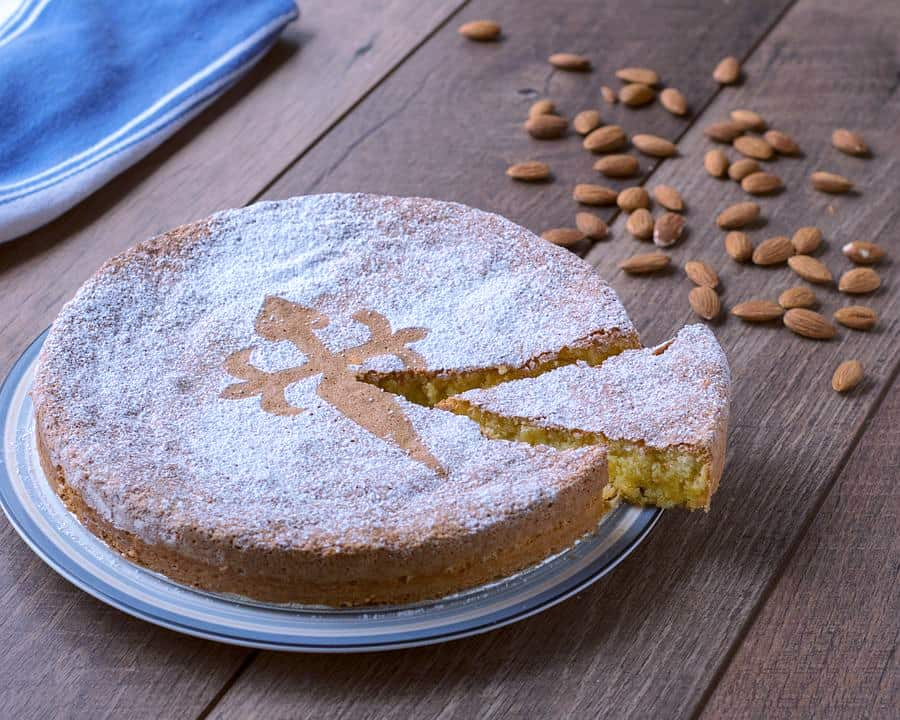
Tarta de almendras , or Tarta de Santiago , is the most popular Spanish almond cake. Tarta de Santiago means Cake of St. James . It’s made of almonds and decorated with the St. James cross. The cake is a signature dessert of Santiago de Compostela. The cake was created in medieval times and it’s related to the famous pilgrimage route of Camino de Santiago (St James Way) . Today this fantastic almond cake can be found not only in Santiago de Compostela and Galicia but throughout Spain.
48. Basque cheesecake – The famous cake from the B asque country
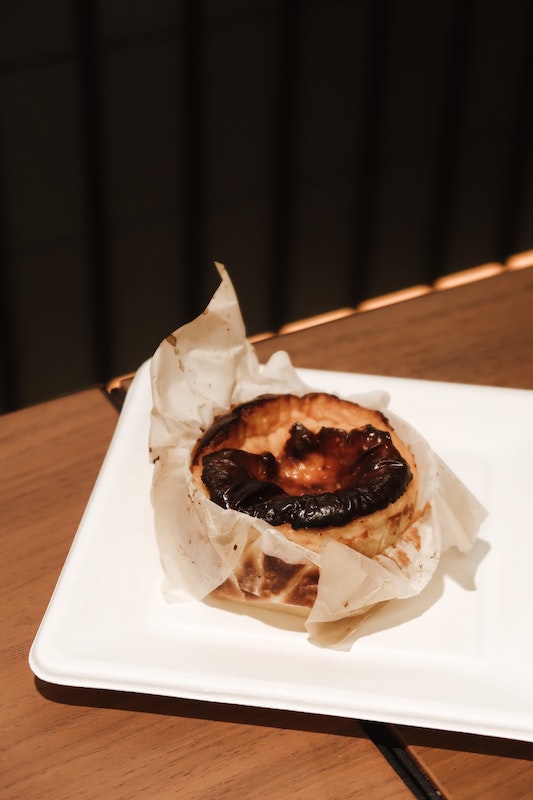
Burnt Basque cheesecake is one of the most famous cakes from the Basque Country. The Basque burnt cheesecake comes with a sweet and creamy interior and caramelized and somewhat bitter exterior. The Basque cheesecake was invented in the famous La Viña restaurant in San Sebastian in 1990. The cake is typically prepared 3 days before serving and is always served at room temperature. Basque burnt cheesecake is one of the most delicious cakes from Sp ain and a must-try on the trip to San Sebastian.

Easter in Spain is one of the most important historical, cultural, social, and religious events. Holy Week is uniquely celebrated in Spain. Semana Santa in Spain is one of the most spectacular fiestas in Spain. Marvelous religious processions go through the main streets of Spanish cities, towns, and villages. Fluffy Spanish rosquillas are traditional Spanish Easter donuts. They are made with fresh Spanish orange juice and aromatic Spanish lemon rid. If you are visiting Spain during Semana Santa, rosquillas are a must-try!
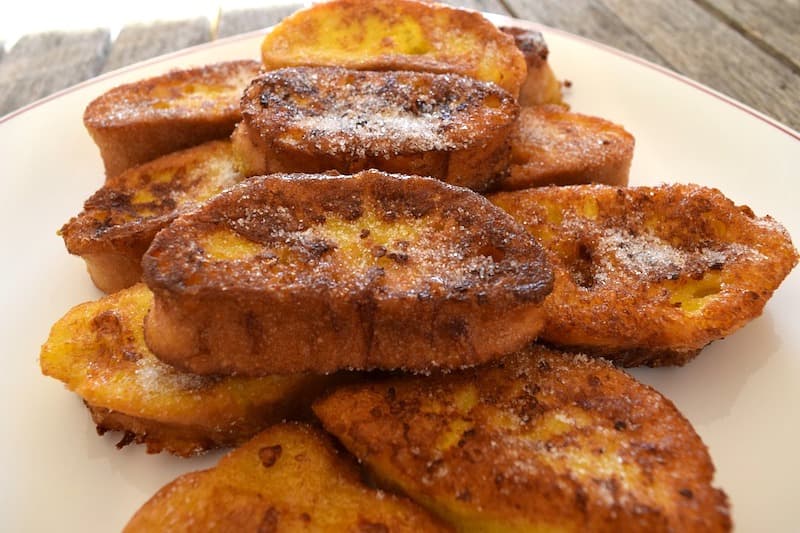
The list of traditional Spanish dishes would not be complete without mentioning traditional Spanish bread pudding. Sweet torrijas are Spanish-style French toast. This sweet Spanish dish is prepared by frying previously soaked bread slices in milk and wine with spices (cinnamon, lemon rid, or cloves). The most typical spice used for torrijas is cinnamon though. Torrijas are traditionally eaten in Spain during Lent (40 days before Easter) and especially during Holy Week (called Semana Santa in Spanish). But nowadays aromatic torrijas are some of the most popular breakfast foods in Spain.
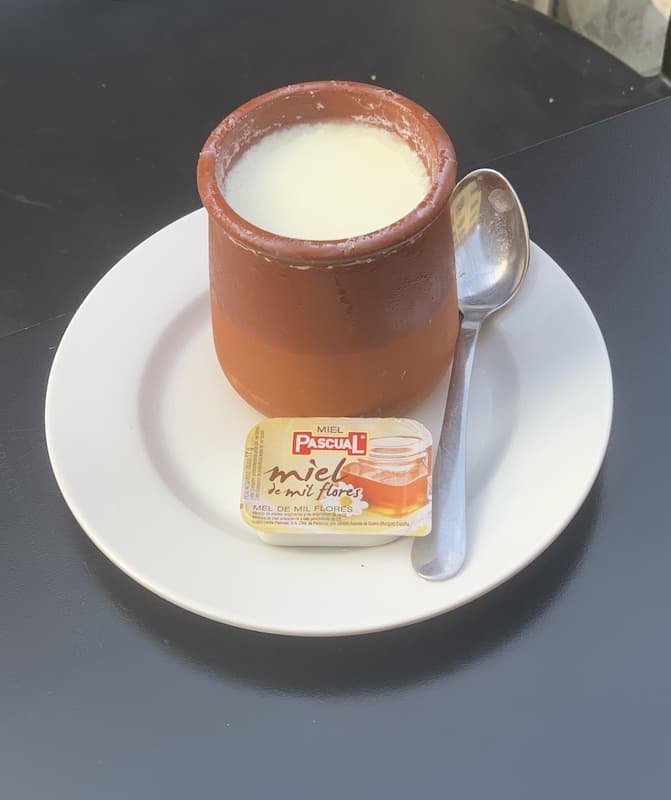
Milk curd is called cuajada in Spain. Spanish cuajada is one of the must-try traditional Spanish desserts . It is one of my favorite authentic foods from Spain. This cheese product is traditionally made from sheep’s milk. But, modern cuajada sold in Spanish shops is made from cow’s milk. Light and mild-in-taste cujada is usually eaten with honey and walnuts in Spain. Cuajada is especially appreciated in northern Spain. Cuajada is also called mamia in the Basque country. The first time I tried mamia aka cujada was in the Basque country during my Camino del Norte hike .
Popular Spanish drinks
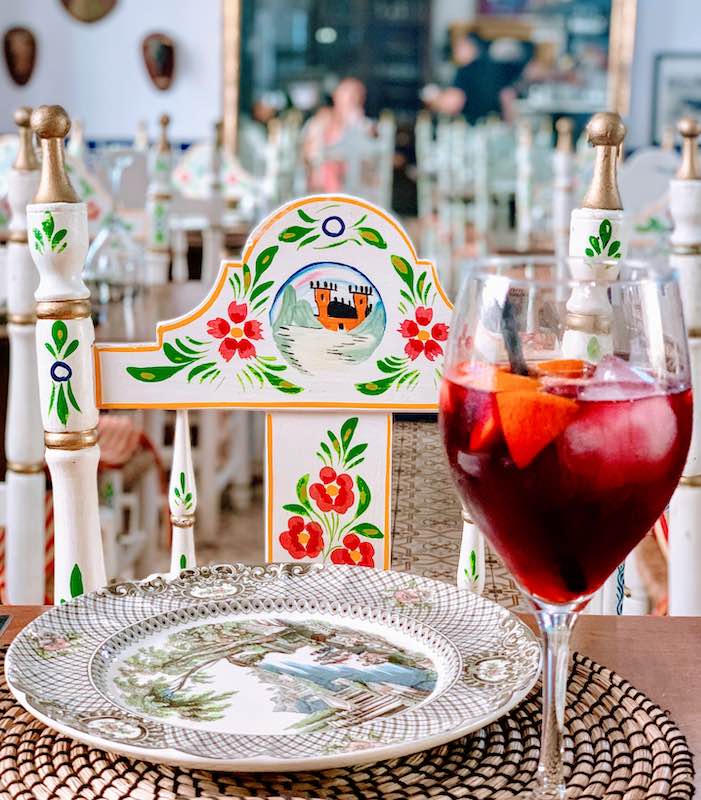
Popular Spanish cuisine consists of popular Spain food and popular Spain drinks . Thus, it’s time to talk about authentic Spanish drinks. I believe Spanish Sangria doesn’t need any special introduction. Sangria is probably the all-time most famous Spanish drink . Red wine with sweet chopped fruit with orange juice or brandy makes a divine mix. Sweet Sangria is the finest example of authentic cultural foods in Spain you need to try. A vacation in Spain without Sangria is not a vacation in Spain at all. Amen!
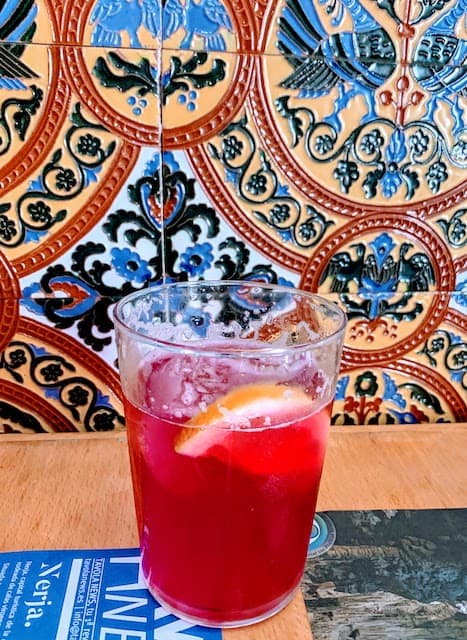
Tinto de Verano is another classic Spanish drink from my collection of the most famous Spanish foods and drinks. When you mix red wine with lemon soda you get one of the most refreshing drinks you will ever taste. Tinto de Verano is popularly known as ‘ Spanish summer wine ‘. The name says it all. Spain + summer + wine = ♥
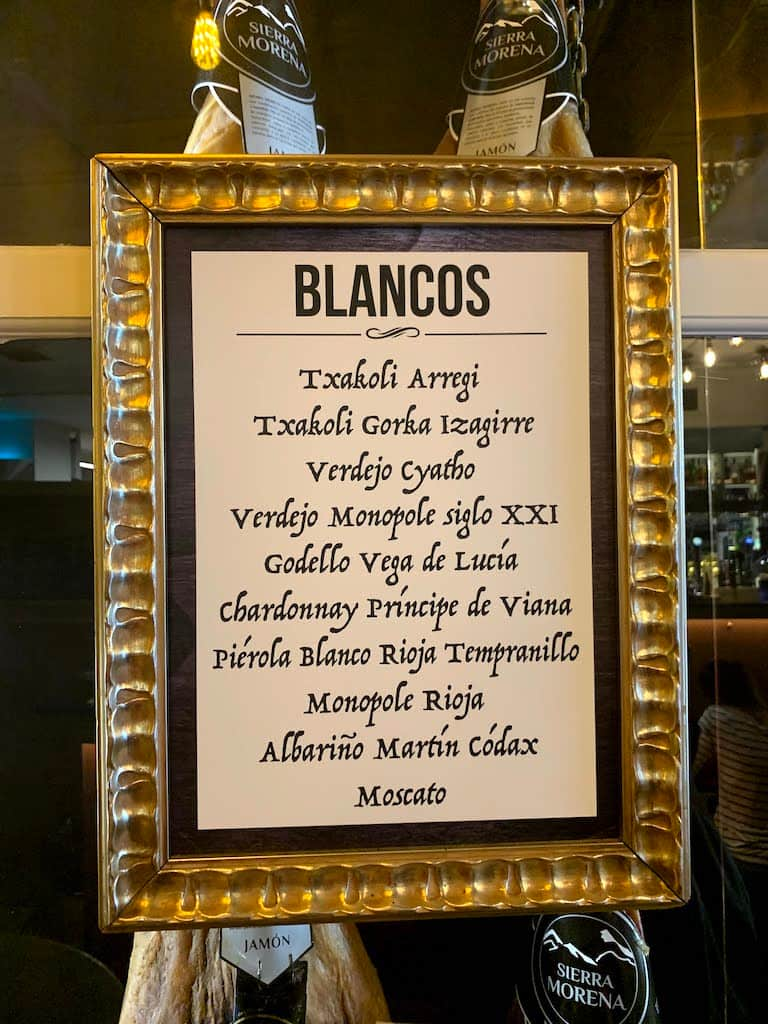
As you might know, wine is considered food in wine regions of the Old World. Many Europeans considered wine to be food. Wine is a common part of a typical meal in many countries in Europe. One of those countries is Spain. So, when talking about traditional Spanish food and traditional Spanish meals, it is impossible not to mention Spanish wine. And the best Spanish wine is Rioja wine. La Rioja is a region between the Basque Country, Navarre, and Castile-León in northern Spain. It is the most famous wine-making Spanish region. The region has over 16,000 vineyards and over 600 wineries (out of which about 200 wineries are open for wine tasting). Rioja wines are red (tinto), white (blanco), and pink (rosado). However, red Rioja wine is rated as the finest Rioja wine and one of the best wines in the world. So, go to Rioja to taste the best wine in Spain.

Talking about foods and wines from Spain cava wine can’t be missed out on. This authentic Spanish sparkling wine is similar to French Champagne. Cava wines originate from the Catalonia region in Spain. But, these days famous ‘ Spanish champagne ‘ is produced also in Aragon, La Rioja, Basque Country, Castile and Leon, Extremadura, Valencia, and Navarre. Cava wines come as blanc or rose . They best go with Manchego cheese, Spanish seafood , egg dishes, and fruit-based desserts.
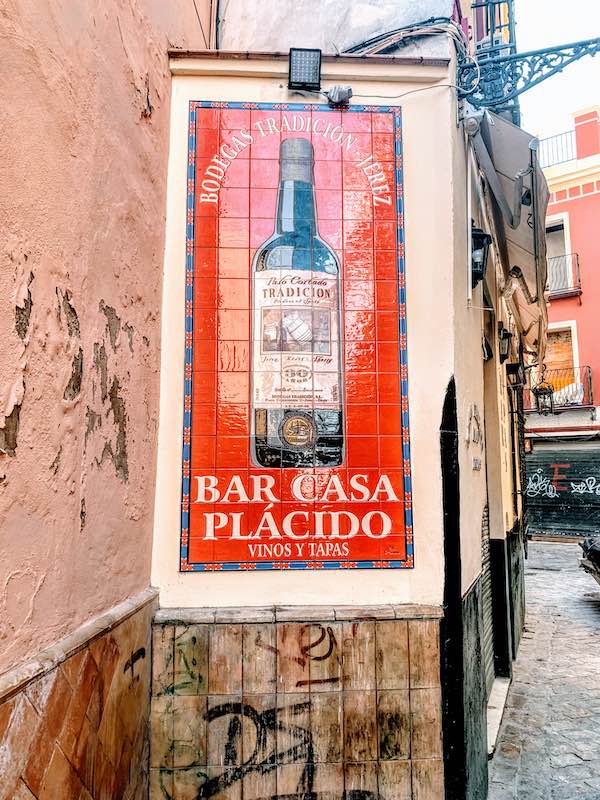
Sherry is an authentic Spanish wine. Sherry originates from the town of Jerez in Andalucia. The name Sherry is an anglicized version of Jerez. Authentic sherry wine is a sweet dessert wine made of white grapes. Sherry wine varies from driest Sherry Fino and light Sherry Manzilla , rich in flavor Sherry Manzilla Posada , medium sweetened Sherry Amontillado , darker in color Sherry Oloroso and Palo Cortado , to sweet black Jerez Dulce . Sweet Sherry makes sweet memories of Spain, for sure! If you happen to be in Seville and have limited time, on this Cadiz and Jerez sherry tasting day trip from Seville you will savor the first quality sherry.
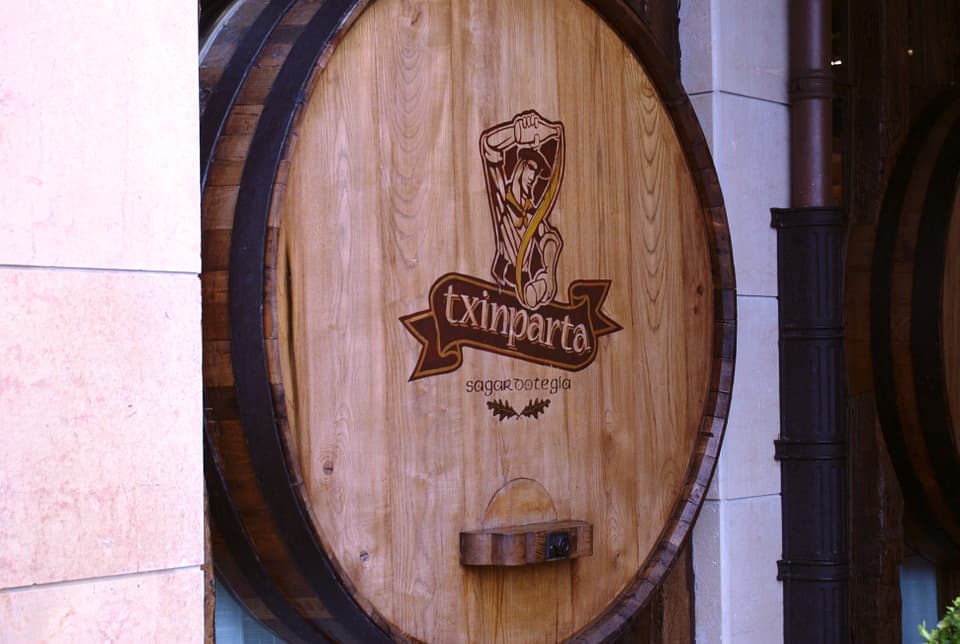
Southern Spain has sweet Sherry wine, but northern Spain has cider. Natural cider is made from fermented apples, has a low percentage of alcohol (around 5%), and is still. Cider has been produced in Asturias and the Basque Country in northern Spain for centuries. Asturias produces about 45 million liters of cider a year. The Basque Country produces about 13 million liters of cider a year. Cider is called sidra in Asturias, and sagrado in the Basque Country. Cider is enjoyed in traditional cider houses, called sidrerias in Asturias and sagardotegi in the Basque Country. Touring cider houses in Asturias and the Basque Country is one of the best experiences in Spain . Head to Asturias and the Basque Country and get cider poured from a barrel straight to your glass!
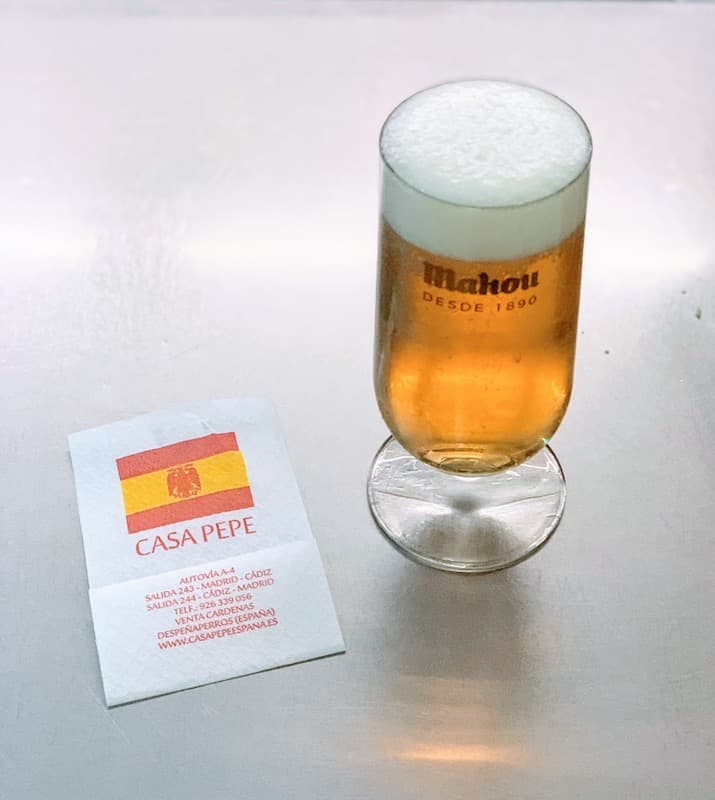
Is it possible to talk about Spain’s cuisine and not mention Spain’s Cerveza?! If you prefer beer to wine, cold Spanish beer goes well with Spanish tapas as well. And Spain doesn’t lack good beers. That being so, Spaniards are one of the biggest beer-drinking nations in the World. There are many good-quality Spanish beers to choose from. The most popular Spanish beers are Estrella Galicia (from Coruna), Alhambra (from Granada), Mahou (from Madrid), San Miguel (from Madrid), C ruz Campo (from Madrid), and Ambar (from Zaragoza).
59. Zumo de naranj a – The Sp anish fresh-squeezed orange juice
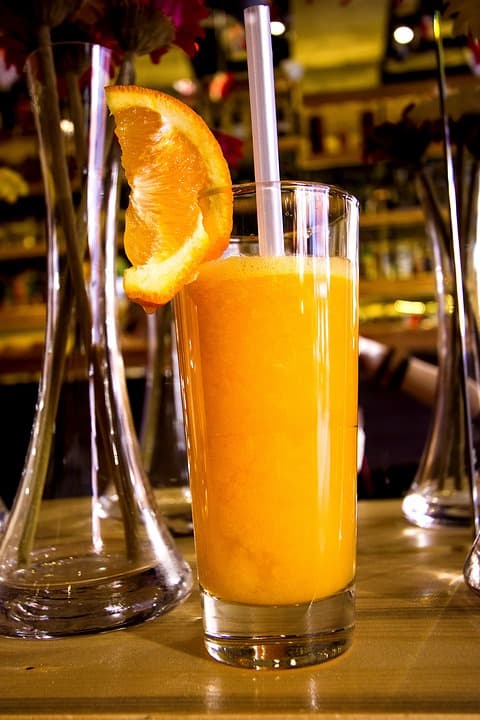
Sunny Valencia in Sp ain is one of the top-producing regions of the finest oranges in the world. Sweet Valencian oranges belong to the list of the best Spanish foods. But Spanish zumo de n ar anj a is one of the most popular drinks in Spain. Fresh-squeezed orange juice is a serious de al in Sp ain. It’s a crucial part of traditional Spanish breakf ast . A day in Spain always starts with a healthy glass of vitamin C.
Fresh-squeezed juice from Valencian or anges is made in Spanish homes and Spanish bars and restaurants. Pretty much every café in Spain has a machine that squeezes oranges and makes the sweet juice just in front of you.
Spanish cuisine is probably best known for its world-famous Spanish tapas (cold or hot Spanish appetizers or snacks) including world-famous national foods of Spain like iconic jamon iberico , legendary paella, and glorified gazpacho. But actually, there’s an impressive number of gastronomic delicacies in Spain and only a comprehensive culinary encyclopedia would do full justice to Spanish cuisine. However, my Spain food list covered authentic Spanish food, typical food from Spain, traditional food in Spain, famous foods in Spain, famous Spanish tapas dishes , best Spanish dishes, typical dishes of Spain, the most popular dishes of Spain, and popular Spanish drinks .
I hope the above list of Spanish food and authentic Spanish dishes I have compiled on my trips to Spain helps you to taste the authentic flavors of Spain. My Spanish food list covered popular food in Spain, ethnic Spanish food, authentic Spanish food, Spanish typical food, Spanish famous food , traditional Spanish dishes, and authentic dishes from Spain . My Spanish food list came with pictures of Spanish food and Spanish food names in Spanish! ¡ Feliz viaje ! ¡Provecho y salud!
In addition, I have prepared a short list of the 10 most famous Spanish foods for all of you who are interested in only the 10 most popular foods from Spain. 10 MOST FAMOUS SPANISH FOOD 1. Iberian ham – Iberian ham is the best Spanish meat. Iberian ham is the finest cured Spanish ham and a national food of Spain 2. Paella – Paella is a top Spanish dish. Paella is the most famous Spanish rice dish hailing from Valencia and a national dish of Spain 3. Gazpacho – Gazpacho is the best Spanish soup. Gazpacho is the most famous Spanish tomato soup from Andalucia and a national dish of Spain 4. Tortilla Espanola – Tortilla Espanola is a top Spanish dish. Tortilla Espanola is the famous Spanish egg and potato omelet and a national dish of Spain 5. Pulpo a la Gallega – Pulpo a la Gallega is the best seafood dish. Pulpo a la Gallega is the most famous Spanish octopus dish from Galicia. 6. Tapas – Tapas are the top Spanish appetizers. Tapas are the famous Spanish appetizers and snacks (finger food and small plate dishes). 7. Pinchos – Pinchos are the best appetizers from northern Spain. Pinchos are the famous Spanish appetizers from the Basque Country. 8. Manchego – Manchegos chees is the best Spanish cheese. Manchego cheese is the most famous Spanish cheese. 9. Pan con tomate (Pa amb tomàquet) – Pan con tomate is the best Spanish breakfast dish. Pan con tomate is the most famous Spanish breakfast food. 10. Crema Catalana -Crema Catalana is the best Spanish dessert. Cream Catalana is the most famous Spanish custard cake.
MOST POPULAR SPANISH FOOD RESTAURANTS IN BARCELONA
La Gastronómica Platillos – address: Carrer de Calabria, 118, 08015 Barcelona Spain Bodega Biarritz 1881 Tapas bar – address: Carrer Nou de Sant Francesc, 7, 08002 Barcelona Spain Diegos Bar Restaurant – address: Avinguda Meridiana 127 Local 1 Entre C// Arago Y C// Valencia, 08026 Barcelona Spain
MOST POPULAR SPANISH FOOD IN MADRID
Los Montes de Galicia – address: Calle Azcona 46, 28028 Madrid Spain Entre Santos Madrid – address: Calle San Bartolomè 4, 28004 Madrid Spain
MOST POPULAR SPANISH FOOD IN SEVILLE
Restaurante & tapas El Sella – address: Calle Pureza 4 Triana Comida para llevar, 41010 Seville Spain La Comilona – address: Calle de Luis Arenas Ladislao s/n Benito Mas y Prat, 41005 Seville Spain Abaceria del Postigo – address: Calle de Tomas de Ibarra 4, 41001 Seville Spain
RELATED READ: Spain Travel A Week in Spain 10 Best Places to Visit in Southern Spain Andalucia Road Trip Itinerary Tips for Visiting Alhambra Traditional Spanish desserts Foodie Spain: Best Destinations in Spain for Foodies Breakfasts in Spain Seafood in Spain Eating snails in Spain
Spanish Fiesta Premier Gourmet Gift Basket: Gourmet Cheese Assortment, Ham, Spanish Chorizo, Spanish Olives, Gourmet Chocolates, and Spain’s Finest Delicacies

A Little Bit of Spain in Gift Box: Fine Cheeses, Meats, Spanish Delicacies, and Sweets

Tapas (Revised): The Little Dishes of Spain: A Cookbook 1,000 Spanish Recipes Clarita’s Cocina: Great Traditional Recipes from a Spanish Kitchen Catalan Food: Culture and Flavors from the Mediterranean: A Cookbook Basque Country: A Culinary Journey Through a Food Lover’s Paradise
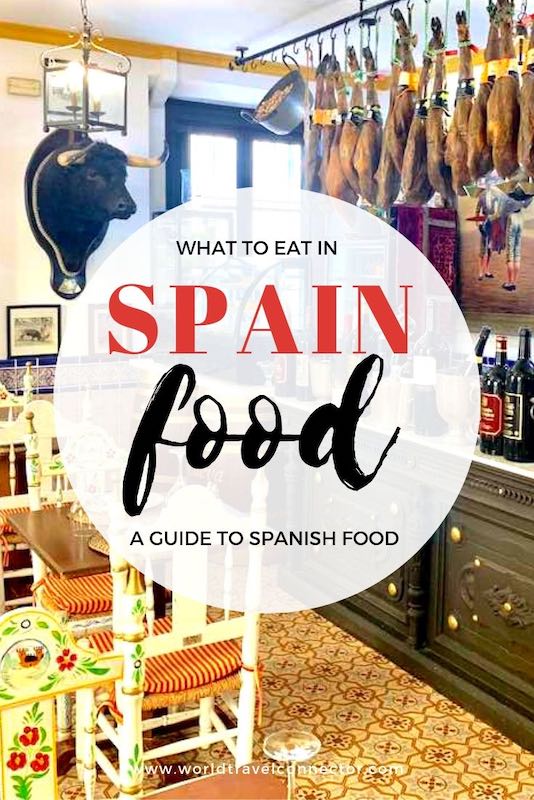
Some basic Spanish vocabulary to help you to navigate easier through Spanish gastronomy and Spain foods:
Drink in Spanish is la bebida .
Food in Spanish is la comida .
Snack in Spanish is el tentempie , or la merineda.
Breakfast in Spanish is called desayuno . Typical Spanish breakfast consists of coffee and pastry.
Lunch in Spanish is called comida . Spanish comida comes between 2 pm and 4 pm. Typical Spanish lunch consists of soup and salad as the first course, meat or fish as the second course, and pastry, cake or fruit as dessert.
Dinner in Spanish is called cena . In Spain dinner comes from 9 pm until 11 pm. Spanish dinner is much lighter than lunch. Typical Spanish dinner consists of selections of salads, sandwiches or tapas.
Appetizers in Spanish are called los aperitivos . The most popular appetizers in Spain are various kinds of tapas snacks.
To end, don’t forget to check out popular Spanish food on Instagram (the #spanishfood hashtag) for some Instagram food inspiration.
I have just checked out some hashtags about popular food in Spain. Solely the paella hashtag (#paella) has more than two million and two thousand posts on Instagram and the sangria Instagram hashtag (#sangria) leads with two million and nine thousand Instagram posts.
But if you play and mix some Instagram hashtags and Instagram captions related to Spain and Spanish food aka Espana food, the number of Instagram posts about popular food in Spain goes enormously up.
Well. Spain, Spanish vacation, and Spanish food are definitely inseparable. And with a good reason. There’s no good vacation without good food. And, Spain and food from Spain beat many ethnic cuisines in the World.
PS: I hope you liked my introductory guide to Spanish food with Spanish food pictures and Spanish food names!
- Food Travels
- Vietnam Food
- Israel Food
- Britain Food
- Italy Drinks
YOU MIGHT ALSO ENJOY
- Traditional Italian Food
- Traditional Vietnamese Food
- Traditional British Food
- Traditional Egyptian Food
- Popular Israeli Food
Paella (Spanish rice dish) is widely accepted as the national dish of Spain. But gazpacho (Spanish cold tomato soup) and tortilla de patatas or Tortilla Espanola (Spanish omelet) are also considered among Spaniards national dishes of Spain.
Spain is best known for jamon iberico , paella , gazpacho , tortilla espanola , pan con tomate , pullpo a la gallega , bocadillos , montaditos , rabo de torro , Iberico chorizo , salmorejo , montaditos , churros .
Popular food in Spain is Spanish ham ( jamon iberico ), Spanish rice dish ( paella ), Spanish tomato soup ( gazpacho ), Spanish omelette ( tortilla Espanola ), Spanish sandwiches ( bocadillos ), Spanish finger food sandwiches ( montaditos ), Galician octopus ( pullpo a la gallega ), Spanish sausage ( Iberico chorizo ), Spanish garlic prawns ( gambas al ajillo ), Spanish spinach with chickpeas ( garbanzos con espinacas ), Spanish cooked oxtail ( rabo de torro ), Spanish fried anchovies ( boquerones fritos ), Spanish croquettes ( croquetas ), Spanish cooked snails ( caracoles ), Spanish snails in tomato sauce ( cabrillas en tomate ), Spanish fried fish ( pescaito frito ), Spanish Manchego cheese ( queso Manchego ), Spanish fried-dough pastry ( churros ), Spanish custard (c rema Catalana ), and Spanish nougat candy ( turron ).
Paella originates from the Spanish region of Valencia but it is eaten all over Spain and it is considered a national dish of Spain.
The most famous food in Spain is paella (Spanish rice dish), tortilla Espanola (Spanish omelette), jamon iberico (Spanish ham), gazpacho (Spanish tomato soup), Iberico chorizo (Spanish sausage)…
The most popular S panish dishes are paella (Spanish rice dish), tortilla Espanola (Spanish omelet), gazpacho (Spanish tomato soup), pullpo a la gallega (Galician-style octopus), ambas al ajillo (Spanish garlic prawns), garbanzos con espinacas (Spanish-style spinach with chickpeas)…
Traditional Spanish food is jamon iberico (Spanish ham), tortilla Espanola (Spanish omelette), paella (Spanish rice dish), chorizo iberico (Spanish sausage), gazpacho (Spanish tomato soup), rabo de torro (Spanish cooked oxtail), Crema Catalana (Spanish custard), turron (Spanish nougat candy) …
Spanish people use lots of olive oil, wheat, vegetables, meats (chicken, pork, veal, and lamb), fish and seafood (especially in coastal Spain), and herbs (parsley, oregano, thyme, and rosemary) in their diet. Tortilla Espanola (Spanish omelet), jamon iberico (Spanish ham), chorizo iberico (Spanish sausage), paella (Spanish rice dish), and croquetas (Spanish croquettes) are some of the most common food in Spain.
Spain is famous for paella (f a mous Spanish rice dish), gazpacho (f a mous Spanish tomato soup), pullpo a la gallega (f amous Galician-style octopus dish), jamon iberico (f amous Spanish ham), queso Manchego (f amous Manchego cheese), zamburiñas a la gallega (famous Galician-style scallops), pimientos de padron (famous Spanish Padron peppers), Bacalao Al Pil-Pil (famous Basque cod dish), membrillo con queso (famous Spanish tapa of cheese with quince jam)…
Traditional Spanish cuisine belongs to Mediterranean cuisine which is made up of three essential foods: olive (most importantly, for olive oil), wheat (for bread making), and grape (for winemaking). As such, Spanish cuisine is rich in olive oil, wheat, and other grains, vegetables, and fruits, but low in dairy and meat. Besides that, traditional Spanish dishes use lots of herbs like parsley, oregano, thyme, and rosemary. The most popular traditional Spanish dishes are paella (Spanish rice dish), tortilla Espanola (Spanish omelet), jamon Iberico (Spanish ham), gazpacho (Spanish tomato soup), etc.
The most popular 10 traditional Spanish dishes are paella, gazpacho, Spanish tortilla, salmorejo, pimientos de padron, patatas bravas, pulpo alla galega, bacalao al pil pil, zamburinas alla gallega, conchilo asado, along with famous Spanish drinks like sangria and tinto de verano.
Paella is unquestionably most Spain’s famous dish. It is a signature dish of Spain and the most associated dish with the country.
Spanish food is a cultural food of Spain. Traditional Spanish food includes regional dishes, typical herbs, common vegetables, common fruits, common meats, popular cheese, and dairy products produced in the territory of Spain. The common Spanish food includes Spanish popular dishes like paella and tortilla Espanola, popular Spanish cheeses like Manchego and Cabrales, common Spanish vegetables like peppers and tomatoes, typical Spanish herbs like parsley and garlic, and common Spanish meats like Jamon Iberico and chorizo.
Typical Spanish food includes typical Spanish dishes (like Tortilla Espanola, patatas bravas, paella, and pan con tomate), typical Spanish meats like Jamon Iberico, chorizo and morcilla, typical Spanish cheese like Manchego, typical Spanish fruits like oranges and apples, and typical Spanish vegetables like potatoes, and peppers.
- Recent Posts
- 21 Amazing Things to Do in Vicenza Italy - April 27, 2024
- Top 15 Best Things to Do in Rome, Italy - March 4, 2024
- 2 days in Rome itinerary: Top Things to Do in Rome in 2 Days - February 23, 2024
Enjoy Morocco tours
Tuesday 7th of March 2023
The food in Spain is very tasty, it's also cheap. I really like the typical dishes and the people are very friendly. The experience was really good. I'll come back one day.
Random girl
Monday 26th of April 2021
hello yes this was very informational. I am doing a school report on spain and this helped very much. Thank you for posting.-6th grader
Wednesday 24th of March 2021
Traveling to Spain in 2022 with my 16 year old granddaughter. Thanks for providing this information on our “must experience” food and drink adventure. So excited to share this with her.
Sunday 15th of November 2020
Hoping travel to Alicante,Spain, next year in the spring Looking forward trying there cuisine.
Sunday 14th of February 2021
Awesome! I also loved Spanish cuisine, I have been there in 2019.
Sunday 19th of April 2020
I so love Spanish Cuisine. The food in our country has so many similarities. In fact, I cooked some of these dishes at home :)
- Tripadvisor

Looking for a genuine food & wine trip? Welcome to A Taste of Spain

Your Local Culinary Travel Experts in Spain
We specialize in organizing private culinary tours and activities across Spain for foodie travelers and food professionals willing to experience the authentic taste of Spain.
A Taste of Spain is a boutique travel agency run by a team of Spaniards with extensive experience in promoting the gastronomy and gourmet foods from Spain. We love sharing our knowledge, contacts and passion for the culinary culture of our country, providing a personalized service to grant that each client enjoys the true flavors of Spain at his own pace.
What they Say
You have made Spain our new favorite place to visit! In our nearly two decades of international travel, your responses have been the best ever experienced. Your knowledge, informed advice, pleasant attitude, and finally, your patience with me, are world class!
As the owners of a family-operated bakery/restaurant, we value any opportunity to travel & experience other cultures & cuisines. With A Taste of Spain helping to coordinate the onsite logistics, we feel confident that our trips to Spain will not only meet, but exceed our expectations.
You taught me the true meaning of jamón. Thank you!
I think about my experiences in Spain every day. I am truly grateful for your hospitality and willingness to share “your” Spain with me
Our most sincere appreciation for your significant contribution to the experience of our students during their didactic voyages in Spain, that represents a fundamental passage in the educational development of each and every one of them.
Thanks for an exciting, fun filled, informative and interesting Taste of Spain, I thoroughly enjoyed myself. I’ll be happy to pass on any information to anybody who asks what to do in Spain.
A Taste of Spain brings visitors to learn about the farm-to-table, free-range, organic eating that’s been the norm here for centuries.
A Taste of Spain is a partnership of food “heavyweights”. They know the landscapes, the farmers and producers, the chefs, and the way people live and enjoy their food in Spain. And, above all, they enjoy working together to share their love of Spain with others.
A most memorable experience! words cannot express my thanks to you for making it all come together so gracefully
We were able to experience unique places, food and people that a regular tourist does not have access to. That is why I chose A Taste of Spain again!
Trip of a Lifetime! A Taste of Spain has made many contacts in the industry over the years and we were the beneficiaries, being treated royally everywhere we went
Great Culinary Experiences, Best Food Holidays Ever…
Travel to the land of famous Ibérico ham
Visit amazing food markets in Catalonia
Taste the season’s first Olive Oils in Andalusia
Cook at a Gastronomic Society in San Sebastian
Savor the best ever Seafood in Galicia
Enjoy Tapas and Pintxos like the locals do
Learn about Spain’s greatest wines like Rioja
Join a food trip through Madrid, La Rioja, the Basque Country and Barcelona
…keep browsing for inspiration, or contact us to design your custom itinerary
Featured tours.
- The Ultimate Foodie Tour of Spain
- Flavors of Andalusia
- Basque Country for Foodies
- Catalan Cuisine
- Manchego Cheese, Wine & Saffron
Galicia, Seafood & Wine Heaven
- Olive Oil at its Best
- Ibérico Ham, from Farm to Fork
Tours & Activities by Region
Select your destination For other regions please contact us
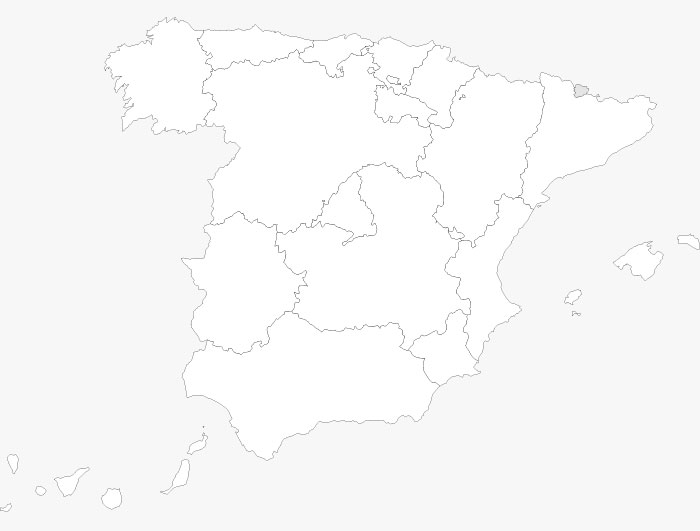
- Madrid & La Mancha

Please fill in the form below or e-mail us at [email protected] We will get back to you as soon as possible.
Featured in

- Share on Facebook
- Share on Twitter
- Share on WhatsApp
- Share on Pinterest
- Share on LinkedIn
- Share by Mail
- Galicia, Seafood & Wine
- All Tours & Activities
- Cooking Classes
- Tapas Tours
- Tastings & Workshops
- All Activities by Destination
- Andalusia – Seville, Malaga, Granada
- Catalonia – Barcelona
- Balearic Islands – Mallorca
- Basque Country & La Rioja – San Sebastian, Bilbao
- Galicia – Santiago
- Privacy & Cookie Policy
- Terms & Conditions
Even if you don’t find exactly what you’re after, we like to be challenged!
Privacy Overview

Spanish Food – 15 Traditional dishes to eat in Spain
By: Author Swedish Nomad
Posted on Last updated: March 29, 2019
Categories Food , Spain
Home / Europe / Spain / Spanish Food – 15 Traditional dishes to eat in Spain

Want to know more about Spanish food and cuisine? I’ve been traveling a lot in Spain, and for some period of time, I have also lived there for nearly 2 years in total.
I love Spanish food, and here is a list of 15 traditional dishes that you should eat in Spain!
Further down in the article, you also read more about the Spanish cuisine, and see what Spaniards eat for Breakfast and Christmas as well as some local beverages and pastries that you should try!
Eating tapas is common, and instead of having 1 large meal, you get to enjoy several dishes in smaller portions which is often shared between family and friends.
1. Tortilla Española
When we say tortilla in Sweden, we usually talk about thin bread made from flour. In Spain however, a tortilla is basically a Spanish omelette made of eggs and potatoes.
And it is delicious with countless varieties according to the traditional family and regional recipes. You can eat it for breakfast, lunch or even for dinner.

Photo: Shutterstock
2. Gambas al ajillo
When it comes to Spanish food, Gambas al ajillo might just be my #1 favorite dish. It’s an appetizer and tapas dish with garlic shrimps that have been fried with olive oil in a special clay pot.
You will find this dish in many restaurants across the country, and it’s a favorite among the locals as well.

3. Albondigas
Swedish meatballs are famous worldwide, but Spain has their own version of meatballs, known in Spanish as Albondigas. They are usually served in a bowl with a spicy tomato sauce.

4. Pulpo a la Gallega
Another famous tapas dish that you should try. Even if you dislike octopus or find it scary to eat, I encourage you to taste Pulpo a la Gallega while you travel to Spain.
If you don’t like it, then it’s safe to say that you aren’t a fan of octopus. It’s a traditional Galician dish.

5. Jamón Serrano and Iberico
Both Jamón Serrano and Jamón Iberico are Spanish specialties that shouldn’t be missed if you eat meat. You will find these types of cured ham almost everywhere and there are various standards and pricing according to quality and age.
The cured ham is commonly served on a platter, but you can also try to eat it together with melon.

6. Gazpacho
A very traditional Spanish dish that has been eaten for a long time. Its origins are disputed as well as the “original” ingredients, but basically, it’s a cold tomato soup with mixed raw vegetables.

7. Rabo de toro
Spanish oxtail stew is another traditional dish in Spain known for its rich taste and juicy meat.

8. Mallorquin Tumbet
When it comes to Spanish vegetarian food, Tumbet is one of the most delicious dishes. It’s a traditional dish from the Spanish island of Mallorca, which is why it’s known as Mallorquin Tumbet.
It consists of layers of sliced aubergines, potatoes and red bell peppers which has been fried in olive oil. It’s available in almost every local restaurant in Mallorca.

9. Pollo al ajillo
Garlic chicken wings is another popular tapas dish.

10. Empanada
During the colonization, the Spanish conquistadors introduced empanadas in America. And while it is regarded as a Spanish food, it might have Arabian origins and was perhaps created during the Arab rule in Spain.
Nonetheless, Empanadas can be found everywhere in Spain and they are delicious. It’s a baked pastry that has been stuffed with various fillings such as minced meat and cheese.

11. Bacalao
Cod is a popular type of fish in Spanish cuisine, known locally as Bacalao. It can be prepared in many ways but is generally salted cod which can be either grilled, fried or even put inside croquettes.
It’s very common in northern Spain.

12. Pimientos de Padron
Remember that I told you that Gambas al ajillo was my #1 favorite when it comes to Spanish food? In reality, I have a hard time deciding if I love Pimientos de Padron more or if the first place is shared between these two dishes.
Anyway, these Padron peppers is another specialty from Spain which you can find almost everywhere in the country. They are usually served on a plate after having been fried in olive oil and salted.

13. Patatas bravas
If you like spicy food, I highly recommend trying Patatas bravas, which is another typical tapas dish in Spain.

14. Croquetas
Croquetas is also a typical tapas dish which is commonly found in the majority of Spanish restaurants. The fillings can vary, but it’s essentially a breaded fried food.

Last but not least, we have Paella, which is perhaps the most famous Spanish food in the world. Most people have probably heard about this famous dish with saffron and seafood.
While many think of Paella as the national dish in Spain, it’s more of a regional dish from Valencia, which is the home of the Paella. But, of course, due to its popularity, it can be found almost all over the country and the islands.
Many also have their own version of Paella, including traditional family recipes.

More about Spanish food
These 15 Traditional dishes from Spain are of course just a handful of what you can enjoy while visiting. But I think that all of these Spanish dishes are those that shouldn’t be missed, and I feel that they are some of the best foods that Spain has to offer.
Each region has its own specialties and that’s one of the things that makes it so interesting to explore the Spanish food culture. There are endless variations and delicious dishes to eat!
Other Spanish produce that you should try
- Manchego cheese
- Olive oil and olives
- Mojo sauce (if you visit Canary islands)

What do Spanish people eat for breakfast?
Breakfast is known as “El Desayuno” in Spanish, and below you can see some of the most common breakfast foods in Spain.
- Toast with tomato, olive oil, and cured ham
- Pincho de tortilla
Churros dipped in hot chocolate is a popular breakfast on Sundays.

Spanish desserts
- Crema Catalana (Spanish version of Creme Brule)
- Turrón

Spanish Food on Christmas
What do Spaniards eat for Christmas? Many families have their own traditions, but some of the most popular types of Spanish food served on Christmas include the following dishes:
- Entremeses (Charcuterie plate)
- Cochinillo Asado (Roast suckling pig)
- Roscón de Reyes (Christmas bread)

The Spanish Cuisine
Spanish cuisine is highly regional as every region in the country have its own food traditions, but there are many traditional Spanish dishes that are more or less the same as today.
Many ingredients that are used in today’s dishes were not yet used before the discovery of America, such as tomatoes. This radically enhanced the Spanish cuisine and since then Spanish food culture has influenced many countries and food cultures worldwide.
One thing that is similar all across the country is the way of eating small dishes, which is shared among family and friends. This is known as tapas, and while every region has its own tapas dishes, they are all eating tapas.

What is your favorite Spanish food? Leave a comment below!
Anita Boström Lindberg
Saturday 30th of March 2019
I like your ideas about Swedish and Spanish food! I have lived in Sweden for 50 years and in Spain the last 20 years. My favorite plate in Sweden is Reindeermeat (Renskav) and in Spain Gambas pil pil and a tasteful Paella! Have a good life and enjoy your life! ??
Ukraine war latest updates: Sky News reports from town under attack - as 'fierce fighting' rages in Kharkiv
Fighting is ongoing in Kharkiv, Ukraine's governor for the region has said - as Russia claims it has taken control of multiple villages. It follows a surprise offensive by Putin's military on Friday morning.
Saturday 11 May 2024 14:05, UK

- Civilians being evacuated in Vovchansk, in Kharkiv, after Friday morning's surprise attack by Putin's military
- Sky's Deborah Haynes reports from town 'under attack'
- Analysis: Russia's attack in Kharkiv region not a complete surprise - but the force of it is
- Russia says it downed Ukrainian rockets and drones overnight
- Ed Conway : Russian oil still seeping into UK - the reasons why sanctions are not working
- Live reporting by Jake Levison
Russia says its troops have taken five villages and the Kharkiv region's governor says they are trying to take more as fierce fighting continues.
But Nazar Voloshyn, a spokesperson for Ukraine's military in the east, insists Moscow's troops are being contained in those villages.
"The enemy is contained in the grey zone, and it is not expanding," he said in a Ukrainian television interview, according to the Kyiv Independent.
The so-called "grey zone" refers to the villages of Borysivka, Ohirtseve, Pylna and Strilecha, all of which are directly on the border with Russia's Belgorod region.
Russian officials said they had also captured another village, Pletenivka.
As we reported earlier, Kharkiv's governor says fighting is ongoing in all the villages Russia has already claimed to have taken.
More now from Kharkiv's governor, who says 2,500 people have now been evacuated from the danger zone in Kharkiv, up from 1,775 this morning.
Oleh Syniehubov says regional authorities are continuing to get civilians out of the areas where fighting continues.
And while Russia's defence ministry said earlier its forces had taken five border villages in the Kharkiv region, Mr Syniehubov says clashes are still ongoing in all five of the villages.
"As of now the enemy keeps pressing in the north of our region. Our forces have repelled nine attacks," he said in his media briefing.
Top Ukrainian officials have repeatedly said they do not believe Russia has the capacity to launch a successful operation to capture the city of Kharkiv, home to 1.3 million people.
But analysts have suggested Mr Putin's end goal may not be to capture the entire city, but rather to better protect the Russian border and to spread Ukraine's military more thinly.
Our security and defence editor Deborah Haynes is reporting to us from a residential area that was just hit by a Russian strike in Vovchansk.
She's standing by a block that's in flames and says local residents she's spoken to are scared the fire will spread to other residential blocks too.
One of the residents of the destroyed block, who had suffered injuries to her leg as a result of the explosion, spoke to Haynes.
"She doesn't know what to do - she's very confused," Haynes says. "This is a scene of chaos and terror."
She says the rest of the town is also "pretty much destroyed", adding explosions can still be heard nearby.
Haynes adds the town is still very much "under attack".
The Russian military is continuing its attacks in Kharkiv, the region's governor says.
Oleh Syniehubov said President Putin's troops were still trying to advance further after reportedly taking up to 1km yesterday.
The fierce fighting is raging across three villages near the Ukrainian border, he added.
His comments came shortly after Russia's defence ministry claimed its forces had taken five border villages in the Kharkiv region.
Ukraine is yet to directly comment on Russia's claims.
The UK's Ministry of Defence has highlighted reports suggesting a Russian fighter aircraft accidentally dropped a bomb on a civilian area in Belgorod.
The intelligence update relates to an incident on 4 May - not on the overnight drone strike in Belgorod we reported earlier.
Here's what the ministry said:
"It has been reported that a Russian fighter aircraft accidentally released a FAB-500 munition on a civilian area in Belgorod, Russia on 04 May 2024.
"The Belgorod Regional Governor Vyacheslav Gladkov confirmed the explosion and damage on Razdobarkina street, Belgorod without identifying the cause.
"30 houses and 10 cars were damaged, with five individuals requiring hospital care, illustrating the destructive power of the munition.
"This is not an isolated incident. On 18 February a FAB-250 was reportedly released on Soloti in the Belgorod area which led to the evacuation of 150 residents.
"Media outlets suggest that such discharges are fairly common with 20 lost munitions accidentally dropped in the Belgorod region alone between March to April 2024.
"These instances indicate Russia's continued inability to successfully employ their munitions on intended targets. Such errors have destructive and lethal consequences for the Russian population."
Russia's defence ministry says its forces have taken five border villages in Ukraine's Kharkiv region since its surprise attack began yesterday.
The ministry says Russian forces have taken the villages of Pletenivka, Ohirtseve, Borysivka, Pylna and Strilechna, all of which are directly on the border with Russia's Belgorod region.
In a briefing, it also said Russian troops have taken the village of Keramik in the eastern Donetsk region, where Moscow has made slow but steady advances in recent months.
Ukraine officials have not yet commented on the Russian defence ministry's claims.
Our military analyst Sean Bell has been looking at Russia's brutal offensive in Kharkiv, which has led to mass evacuations.
It's been described as a surprise attack - but Bell says Ukraine has been warning over a potential attack by Russia in the region for several months.
"So it wasn't a complete surprise," he says. "But this attack by Russia wasn't just a minor thing - it was a coordinated attack.
"They were using air power, so glide bombs, artillery shells, multi-launch rocket systems and infantry."
He says the attack was clearly designed to "probe Ukrainian defences" and Russia has now made advances, with between 30,000 and 50,000 troops in the area.
Why has Russia opened up a second front in the war?
While Bell says it's a question only President Putin could answer for certain, he believes there are two likely reasons for Russia's latest attack.
First, the Russian border town of Belgorod is a logistics hub for Russian military activity, and is regularly targeted by artillery from Ukrainian territory.
As you'll see from our previous post, Russia said Ukraine targeted Belgorod just last night, killing one man and injuring another in a drone attack.
President Putin has long promised to create a buffer zone to push Ukrainian forces out of artillery range, which would limit the attacks on this frontier town, Bell says.
Secondly, although most analysts believe Russia would struggle to seize Kharkiv, the attack does force Ukraine to spread its limited resources across a broader front, leaving it more vulnerable to further attacks, he adds.
Earlier this morning we told you Russia said it downed 21 Ukrainian rockets and 16 drones overnight across its Belgorod, Kursk and Volgograd regions.
The governor of Russia's Belgorod region now says one man was killed and another injured after a Ukrainian drone hit a parked truck on the border village of Novostroyevka-Pervaya.
The Belgorod region borders Ukraine's Kharkiv region and has come under regular attack since the war began.
Kharkiv's regional governor has provided an update on Telegram this morning, where he's outlined how many civilians have fled their homes since Russia's attack yesterday.
Ukraine's second-largest city has seen a total of 1,775 people evacuate, Oleg Sinegubov said.
1,048 of those were from the Chuhuiv district, where Vovchansk is located. As we said earlier, Vovchansk has a population of around 3,000.
He said another 440 people were evacuated from the Kharkiv district, which encircles the city of Kharkiv, and 12 from Bohodukhiv district, located northwest of Kharkiv.
He added another 275 people were evacuated by volunteers across the region.
By Deborah Haynes , security and defence editor
Smoke hung in the air on the road into the border town of Vovchansk in northeastern Ukraine after a surprise Russian offensive.
Woodland that frames the route had caught fire amid the heavy bombardments.
Sky News followed a rescue team as they raced into Vovchansk in a white van to help evacuate residents amid fears of a wider assault by Moscow.
The streets in the part of the town we entered were largely deserted.
We pulled into a residential road of bungalows.
Part the way down there was a group of five elderly residents, gathered around a bench. They did not appear to be in a hurry to flee, despite the danger and warnings from the authorities for the town's around 3,000 residents to leave.
Read more here ...
Be the first to get Breaking News
Install the Sky News app for free


IMAGES
VIDEO
COMMENTS
Top resources to travel Spain ⚘ Avoid tourist traps and get the customizable " Spain Like a Local " itinerary for less than 10€. - Get it here. Book cheap flights to Spain with Skyscanner . Book tours in Spain with Viator Find the best hotels in Spain with Trivago Rent a car with the best discounts with DiscoverCars ☘ Get the best discounted outdoor gear (outlet) with REI.com
Its cold deep waters produce outstanding seafood, especially fish. For many travelers to Spain especially Americans, eating anchovies isn't common. But if you go to Spain, you must try them. Anchovies and boquerones are some of the most popular foods in Spain to eat. Visit any tapas bar in Spain and you'll find them.
For those traveling to Spain, understanding the cuisine, food culture, and following a few key Spain food travel tips makes it actually quite simple to enjoy the miraculous food and stay healthy. Popular types of food and drink. Spain's national dish is seafood paella, a healthy option that is available at most eateries across the country.
Spanish albondigas are typically made from pork or beef and served in a tomato sauce, either as tapas or as the main course. 19. Croqueta. The croqueta is one of the most popular tapas dishes in Spanish cuisine. It refers to a Spanish croquette typically made with a thick bechamel sauce that's breaded and deep-fried.
Espinacas Con Garbanzos. This is a perfect comfort food. Espinacas con garbanzos is made by first frying garlic and bread which become the base of the dish. Then the spinach is added and cooked with an assortment of spices such as cumin, pimenton etc. Right at the end, chickpeas are added to top off the dish.
1. Paella Valenciana. Paella is perhaps the most famous Spanish dish of all, and certainly one of the most abused. Authentic paella originates from the region around Valencia, and comes in two ...
Menu items to seek out in traditional settings include verduras a la plancha (grilled vegetables); garbanzos con espinacas (chickpeas and spinach); and potato dishes, such as patatas bravas (potato chunks bathed in a slightly spicy tomato sauce) and tortilla de patatas (egg, potato and onion omelette).
11. Pulpo a La Gallega. Pulpo La Gallega. Pulpo a la Gallega, or Galician-style octopus, is a mouthwatering Spanish dish known for its simple yet delightful flavours. Originating from the Galicia region in northwestern Spain, this dish features tender octopus slices seasoned with paprika, olive oil, and coarse salt.
Pisto is a comforting vegetable stew from La Mancha, a region in central Spain. Often likened to ratatouille, Pisto combines tomatoes, peppers, zucchini, onions, eggplant, and garlic, all simmered together in olive oil. This dish beautifully showcases Spain's abundant produce and can be enjoyed as a main course or a side dish.
Tortilla. Tortilla, or Spanish omelette, is one of the simplest and most authentic Spanish foods. It's similar to a regular omelette made with eggs, except it also has potato and extra virgin olive oil. A plain tortilla is delicious, but you may also like to add chorizo, cherry tomatoes, peppers or other vegetables.
2. Try 'gastroarcheology' in Cordoba. During Spain's Islamic rule, Cordoba was one of the country's most ethnically diverse settlements, a city where Muslims, Jews and Christians lived ...
The locals tend to use this word for the original recipe alone, all the other dishes being called "rice". 2. Jamón - one of the most popular foods in Spain. Thinly sliced ham and sweet melon — a common food pairing in Spain. Jamón (dry-cured ham) is a staple of Spanish cuisine.
Paella. First thing's first: when in Spain, paella is an absolute must. As the most famous rice dish in the country, paella is a traditional meal that's meant to be shared among friends and family members. As it originated in Valencia, you can't miss a huge helping of it if you're passing through the city.
28. Churros. Simply iconic. Chocolate with churros is a typical sweet dish of the gastronomy of Spain. "C hurros " is a dough made from wheat flour cooked in oil in the shape of a star and are served with all manner of fillings from chocolate to jelly, custard, and even Nutella if you want.
Tortilla Española. This best food in Spain is mainly known as a Spanish omelet but uses diced potatoes as its main ingredient along with eggs. There are dozens of variations of Tortilla made with peppers, onions, and chorizo, to name just a few - however, the classic one calls for potatoes and eggs only.
There is an expression that well sums up the Spanish way: salir de tapas. In the local culture, it means gathering friends to go from restaurant to restaurant, snacking and having good drinks. In the end, this is the tradition that best defines the country's DNA. To understand Spain beyond the guidebooks, you have to allow yourself different ...
Chocolate with churros. Chocolate con churros is another typical Spanish breakfast. The crunchiness of the churro and dipping it in a slightly bitter hot chocolate is excellent. The Spanish are culinary geniuses. Churros are made with choux pastry and fried in hot oil. They are crunchy and a little hollow inside.
Typical of southern Spain, ajo blanco is a chilled, creamy white soup. The main ingredients are crushed almonds (preferably Marcona), garlic, and olive oil. Some recipes include bread for thickening or sherry vinegar for a bit of tang. Garnishes may include grapes or other fruity bits and a drizzle of olive oil. 6.
Instead, it's a simple staple of Spanish cuisine consisting of eggs, potatoes, sometimes onion, and extra virgin olive oil. Try it at: Casa Dani in Madrid is famous for its excellent tortilla, which was named Spain's best in 2019. 07 of 10.
The common Spanish food includes Spanish popular dishes like paella and tortilla Espanola, popular Spanish cheeses like Manchego and Cabrales, common Spanish vegetables like peppers and tomatoes, typical Spanish herbs like parsley and garlic, and common Spanish meats like Jamon Iberico and chorizo.
Read Spanish Sabores for the best traditional Spanish recipes, essential Spain travel tips, and food guides to Spain and beyond!
Since 1999. We specialize in organizing private culinary tours and activities across Spain for foodie travelers and food professionals willing to experience the authentic taste of Spain. A Taste of Spain is a boutique travel agency run by a team of Spaniards with extensive experience in promoting the gastronomy and gourmet foods from Spain. We ...
Spanish oxtail stew is another traditional dish in Spain known for its rich taste and juicy meat. 8. Mallorquin Tumbet. When it comes to Spanish vegetarian food, Tumbet is one of the most delicious dishes. It's a traditional dish from the Spanish island of Mallorca, which is why it's known as Mallorquin Tumbet.
672 likes, 11 comments - spainexplore on May 7, 2024: "Embrace the Spanish summer breeze on your skin! ️ Double-tap if you're captivated by Spain's summer serenity! ...". Spain 🇪🇸 España Travel | Hotels | Food | Tips | Embrace the Spanish summer breeze on your skin! 🌬️🌞 Double-tap if you're captivated by Spain's summer ...
Russia has launched an attack in Kharkiv away from recent battlegrounds, Ukraine has said - as Volodymyr Zelenskyy insists his forces were "prepared" for the assault. Two civilians have been ...